- 1.1 Central Rome
- 1.2 Outskirts
- 2.1 History
- 2.2 Climate
- 2.3 Background reading
- 2.4 Tourist information
- 3.1.1 About Ciampino airport
- 3.2 By train
- 3.5.1 Ferry services
- 4.2 By taxi
- 4.3 On foot
- 4.4.1 Journey planner
- 4.4.4 Metro
- 4.5 By commuter rail
- 4.6 By moped
- 4.7 By bicycle
- 4.8 By Segway Pt
- 5.1 Roma Pass
- 5.2 Ancient Rome
- 5.3 Catholic Rome
- 5.4 The Seven Hills of Rome
- 5.5 Museums
- 5.6 Just walking around
- 5.7 The Piazzas
- 5.8 Overlooked Places
- 5.9 Viewpoints
- 5.10 Rome for kids
- 10.1 Factory outlets
- 11.2 Ice cream
- 11.3 Vegetarians
- 11.4 Kosher dining
- 11.5 Pricing
- 12.1 Coffee
- 12.2 Wine and water
- 12.3 Before dinner
- 12.4 Clubbing & Night Life
- 12.5 Gay travellers
- 13.1 Camping
- 16.1 Pickpocketing
- 16.2 Tourist scams
- 16.3 Emergencies
- 17.1 Embassies
- 17.2 Consulates
- 18.1 By air
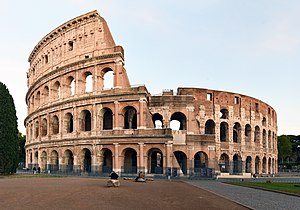
Rome ( Italian and Latin: Roma ), the 'Eternal City', is the capital and largest city of Italy and of the Lazio region. It's the famed city of the Roman Empire , the Seven Hills, La Dolce Vita , the Vatican City and Three Coins in the Fountain . Rome, as a millennia-long centre of power, culture and religion, was the centre of one of the greatest civilisations ever, and has exerted a huge influence over the world in its circa 2500 years of existence.
The historic centre of the city is a UNESCO World Heritage Site . With wonderful palaces, thousand-year-old churches and basilicas, grand romantic ruins, opulent monuments, ornate statues and graceful fountains, Rome has an immensely rich historical heritage and cosmopolitan atmosphere, making it one of Europe's and the world's most visited, famous, influential and beautiful capitals. Today, Rome has a growing nightlife scene and is also seen as a shopping heaven, being regarded as one of the fashion capitals of the world; some of Italy's oldest jewellery and clothing establishments were founded in the city. With so many sights and things to do, Rome can truly be classified a "global city".

Districts [ edit ]
Central rome [ edit ].
Rome can be divided into several districts. The so-called historical centre ( centro storico ) is quite small, being only around 4% of the city's area. This mainly consists of the area inside the Aurelian walls, and is protected by UNESCO. Districts are explained below:

Outskirts [ edit ]
Understand [ edit ].
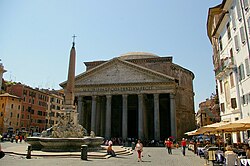
Situated on the River Tiber, between the Apennine Mountains and the Tyrrhenian Sea, the "Eternal City" was once the administrative centre of the mighty Roman Empire, governing a vast region that stretched all the way from Britain to Mesopotamia. Today it remains the seat of the Italian government and home to numerous ministerial offices. Rome has 2.7 million inhabitants while the metropolitan area is home to around 4.5 million.
Architecturally and culturally, Rome has some contrasts - you have areas with pompously huge majestic palaces, avenues and basilicas, which are then surrounded by tiny alleyways, little churches and old houses. The centre of Rome is mainly ancient, and modern buildings are usually concentrated in the suburbs, unlike Milan (where new and old architecture is combined both in the centre and the outskirts). You may also find yourself walking from a grand palace and tree-lined elegant boulevard, into a small and cramped Medieval-like street.
The abbreviation "S.P.Q.R" is ubiquitous in Rome, short for the old democratic motto "Senatus Populusque Romanus" (Latin), i.e. "The Roman Senate and People".
For two weeks in August, many of Rome's inhabitants shut up shop (literally) and go on their own vacations; many stores, restaurants and other amenities will be closed during this time. The temperature in the city centre at this time of year is not particularly pleasant. If you do travel to Rome at this time, be prepared to see Chiuso per ferie (Closed for holidays) signs on many establishments. Even in these weeks the city is very beautiful and if you are looking for a less overcrowded vacation in Rome, this is not a bad time. You will always be able to find somewhere to eat.
History [ edit ]
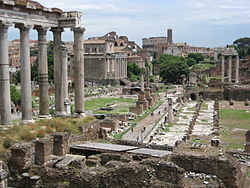
Rome's history spans over two and half thousand years, which have seen its transformation from a small Latin village to the centre of a vast empire, through the founding of Catholicism, and into the capital of today's Italy. Rome's history is long and complex. What follows is merely a quick summary.
Rome is traditionally thought to have been founded by the mythical twins Romulus and Remus, who were abandoned as infants in the Tiber River and raised by a mother wolf before being found by a shepherd who raised them as his own sons. Rome was founded as a small village sometime in the 8th century BC surrounding the Palatine Hill, including the area where the Roman Forum is found. Due to the village's position at a ford on the Tiber River, Rome became a crossroads of traffic and trade.
The settlement developed into the capital of the Roman Kingdom, led by a series of Etruscan kings, before becoming the seat of the Roman Republic at around 500 BC, and then the centre of the Roman Empire from 27 BC on. For almost a thousand years, Rome was the largest, wealthiest, most powerful city in the Western World, with dominance over most of Europe and the Mediterranean Sea. Even after the fall of the Roman Empire in the 5th century AD, Rome maintained considerable importance and wealth.
Beginning with the reign of Constantine I, the Bishop of Rome (later known as the Pope) gained political and religious importance, establishing Rome as the centre of the Catholic Church. During the Early Middle Ages, the city declined in population but gained a new importance as the capital of the newly formed Papal States. Throughout the Middle Ages, Rome was a major pilgrimage site and the focus of struggles between the Holy Roman Empire and the Papacy.

With the Italian Renaissance fully under way in the 15th century, Rome changed dramatically. Extravagant churches, bridges, and public spaces, including a new Saint Peter's Basilica and the Sistine Chapel, were constructed by the Papacy so that Rome would equal the grandeur of other Italian cities of the period. As the Grand Tour became customary for young European gentlemen in the 17th century, Rome became an important tourist destination, and remains as such until today.
In the 19th century, Rome again became the focus of a power struggle with the rise of the Kingdom of Italy, which wished to see a reunification of Italy. The Papal States remained in control of Rome under French protection, but with the outbreak of the Franco-Prussian War of 1870, French troops were forced to abandon Rome, leaving it clear for the Kingdom of Italy to capture. Rome became the capital of Italy, and has remained such ever since.
Rome today is a contemporary metropolis that reflects the many periods of its long history - Ancient times, Middle Ages, the Renaissance and the Modern Era. With the rise of Italian Fascism following World War I, Rome's population grew. This trend was stopped by World War II, which dealt relatively minor damage to Rome. With the dismantlement of the monarchy and the creation of the Italian Republic following WWII, Rome again began to grow in population and became a modern city. The city stands today as the capital of Italy and one of the world's major tourist destinations.
Climate [ edit ]
Rome has a Mediterranean climate, with hot summers and mild winters. The winter months usually present pleasant daytime temperatures and the weather is variable. Nights can be chilly, but the temperature rarely drops to actual cold levels. Snow is rare, and only occurs every few decades or so. Summer presents a pronounced aridity in which hot, sunny conditions prevail. The heat obstacles certain sightseeing activities which involve too much walking during the day, but early mornings and late nights can be wonderful. Autumn and spring are characterised by very pleasant weather accompanied by mild to warm temperatures.
Background reading [ edit ]
At last count there were close to 1700 novels set in Rome in days gone by. Most easily available in bookshops are those by Lindsey Davis and Steven Saylor. Both are good storytellers and excellent at portraying life in Ancient Rome. Particularly interesting if you are visiting Rome may be Saylor's Roma: The Novel of Ancient Rome , which traces the first thousand years or so of Rome's history by following the fictional fortunes of two families. Each chapter begins with a map showing the state of Rome's development at the time of the chapter.
The classic work on Ancient Rome remains Edward Gibbon's History of the Decline and Fall of the Roman Empire . This was written in 1782 but is still being reprinted. A marvelous book that covers Rome's fortunes from Romulus and Remus to the 1970s is Rome: The Biography of a City by Christopher Hibbert (Penguin). An excellent guide book, too, although perhaps a bit too heavy to carry around. Rome by Robert Hughes (Orion Books) concentrates on the city's art history and provides fascinating insights into the things you will see while walking around. SPQR , written by Cambridge University professor and British TV personality Mary Beard, and published in 2015, offers a detailed analysis of Rome's first 1000 years and attempts to answer why Rome expanded from a small village on the Tiber to the centre of a major empire.
English-language bookshops in Rome are:
- The Lion Bookshop, Via dei Greci, 36, close to Piazza di Spagna . Lots of books and a small cafe.
- Anglo-American Bookstore, Via delle Vite, 102, also close to Piazza di Spagna. A large store, with specialist sections. Strong on non-fiction.
- The Almost Corner Bookshop, Via del Moro 45, Trastevere . Small but very well-stocked store on the other side of the river.
Some Italian bookstores also have English-language sections. Try the large selection of English books (but also French, Spanish and more) at Feltrinelli International in via Vittorio Emanuele Orlando - or the smaller selection at its store in Largo Argentina .
Tourist information [ edit ]
- Rome Tourism
Get in [ edit ]
By plane [ edit ].
Rome ( ROM IATA ) has two main international airports:
If the flight connections to Rome don't suit you, you can check flights to other airports around like Naples , Perugia , Pescara , Florence , Bologna , Pisa or Milan . From there you can take a (high speed) train or intercity bus to Rome.
About Ciampino airport [ edit ]
Cash machines are available only in the departures area. This is a relatively small airport and it closes overnight. You will be locked out of the airport until it opens again for the first check-in around 04:30 or 05:00. Flying into Ciampino try to sit on the right of the plane, which will fly just to the east of the centre of the city. Reaching Rome you first see the River Tiber and then the Olympic Stadium, Castel Sant' Angelo, St Peter's and the Vatican and the Colosseum. Before touchdown you fly parallel with the old Appian Way, the tree-lined road on a slight incline about 1 km (0.62 mi) to the right of the flightpath.
There are a few direct coach services from Ciampino, all of which go to the Termini in downtown Rome:
- SITBusShuttle runs a line that costs €4 one-way to the centre (€6 one-way from the centre) or €8 with return (approx. 40 min, with about 25 services a day).
- Terravision . This is a dedicated airport-city transfer only for the major low cost airlines. The price is €6 (from the airport to Rome Termini)/ €6 (from Rome Termini to Ciampino Airport) one-way or €11 return when booked online (approx. 40 min, with a service every 30 min). Passengers on the return trip from Termini are advised to board the bus 3 hours before their flight's departure time. It is not necessary to print out the tickets (mobile tickets are accepted). (updated Oct 2018)
- RomeAirportBus [dead link] (by Schiaffini) offers buses from the airport to Termini (at Via Giovanni Giolitti) in the city centre. Ticket prices depend on the direction of travel. Tickets from the airport to the city cost €5.90 single and €9.90 return. Tickets from the city to the airport cost €6.90 single and €9.90 return. Never expects to get these 10 cents back.
- COTRAL's [dead link] direct line costs €5 one-way (approx. 40 min), but has far fewer departures than Terravision. This bus may be useful if you arrive at a time when the Metro is closed.
There are two indirect public transport services from Ciampino airport involving a local ATRAL bus, plus a metro or train. These local ATRAL buses operate roughly every hour or 30 minutes during the Italian work day (8-12 and 16-20), and you should count on at least 45 minutes travel time for either route. Timetable booklets are available in some information booths and on the ATRAL website. Bus tickets cost €1.20 and can be bought from the driver:
- You can take the local ATRAL bus [dead link] from the stop located outside the terminal building to the metro station 41.84265 12.58608 3 Anagnina A . A metro ticket to central Rome costs another €1.50. The metro can get very crowded. The bus takes about 20min and the metro another 30min to the main train station (Termini) in Rome. Going towards the airport, the bus departs from platform 1.
- There is also a local ATRAL bus [dead link] to Ciampino local train station; from there, there are infrequent trains to Rome Termini station (ticket: €2).
The cheapest way from the airport is to take ATAC urban bus line 720 to 41.82707 12.48129 4 Laurentina B , or Line 520 to 41.84931 12.57435 5 Cinecittà A . Since all these routes are operated by ATAC, you only need one ticket which costs €1.50 and is valid for 100 min. You cannot buy tickets on the bus, but there are ATAC vending machines shortly before you leave the airport.
A shared airport shuttle can be hired for around €15 per person to take you from Ciampino airport. However, since the shuttle is shared, it may take longer to reach your destination if other customers are dropped off before you are.
At Ciampino there is supposed to be an organised taxi queue but the drivers will often negotiate among themselves if you are going somewhere the cab at the front doesn't want to go to. There are reports that late at night licensed cab drivers in the rank at Ciampino are asking €100 to take you into town, so try to avoid late flights or take the bus that connects with the flight. The fixed price to the city centre (within the Aurelian Walls) is €30 and includes luggage and up to four people. If you have to take a cab just pay the legal fare at your destination. If you have no stomach for the resulting argument then you can phone a cab from one of the numbers listed under Get Around .
Rental cars are available from all major companies. Providers can be reached easily in the arrivals halls.
Another option, is to book a licensed limousine or minicab in advance online. For example, a sedan, usually a Mercedes E-class, from Fiumicino Airport to Rome Centre and hotels can be booked for €45 or a minivan for €55. The same prices also apply from Ciampino Airport. From Fiumicino Airport to Civitavecchia Port the fare is €100.
By train [ edit ]
Rome's main railway station is 41.901 12.502 6 Termini Station A B which is locked between 00:30 and 04:30. Most long-distance trains passing through Rome between these times will stop at Tiburtina station instead. See also "By boat" below.
Other main stations include Ostiense, Trastevere, Tuscolana, Tiburtina.
When traveling between major cities or to/from another country, trains will be designed for passengers and luggage. Most others (e.g., between nearby towns and cities) are often designed to serve commuters.
- For enroute stations, they stop for only 1–2 minutes.
- Most cars have a middle platform close to the station's boarding level, but with a significant gap. Seating areas may be at levels different from the middle platform, with narrow/clumsy steps for moving large luggage and little space to store them. Large pieces must often be left on the middle platform, with someone to guard them.
By car [ edit ]
Driving to Rome is quite easy; as they say, all roads lead to Rome. The city is ringed by a motorway, the Grande Raccordo Anulare or GRA. If you are going to the very centre of the city any road leading off the GRA will get you there. If you are going anywhere else, however, a GPS or a good map is essential. Signs on the GRA indicate the name of the road leading to the centre (e.g. Via Appia Nuova, Via Aurelia, Via Tiburtina) but this is useful only for Romans who know where these roads pass.
By bus [ edit ]
FlixBus offers many daily connections to Rome. The bus station is located next to the Tiburtina railway station. The fares are very often cheaper than train tickets, and there are direct overnight connections to and from cities in France, Switzerland and Germany.
By boat [ edit ]
Most cruise ships dock in Civitavecchia , to afford their passengers opportunity to visit the area and/or Rome. Many ships arrange shuttle buses to and from the pedestrian port entrance. From there you can walk 10–15 minutes along the shore to the Civitavecchia train station. Purchase of a B.I.R.G. round trip train ticket for Rome costs €9 (as of Fall 2009), and also entitles you to unlimited use of Rome's Metro/underground and city bus lines. Trains for commuters leave every hour or so, more often during rush hours, and take about 80 minutes. You can get off near St. Peters (Trastevere station), or continue to the Termini station right downtown, where countless buses and the Metro await. If you're carrying luggage, see "About luggage" in "By train" above.
At some ten times the cost, cruise ships often offer bus transport to Rome as well, taking 2 hours or so to reach some location downtown depending on traffic.
It is now possible for modest- to large-sized yachts to dock in the new Porto di Roma, Ostia marina, located 20 km from Rome and linked by train and metro. Their stations are not within practical walking distance of the marina or riverside boat facilities.
Ferry services [ edit ]
In Civitavecchia:
- Grimaldi Lines . * Dangerous link * Provides ferry service to/from Barcelona , Tunis , Toulon (France), Porto-Vecchio ( Corsica ).
- Moby . Provides service to/from Olbia , Sardinia .
Get around [ edit ]

In a nutshell: Don't do it. Well, some people actually enjoy it as a master class in defensive driving. Roman traffic is chaotic (and has been since the first century BC), but it is possible to drive there. However, the roads are not logical, the signs are few and the condition of the roads gets worse daily. It will take a few weeks to understand where to drive, to get where you want to go. When driving in Rome it is important to accept that Italians drive in a very pragmatic way. Taking turns and letting people go in front of you is rare, but pedestrians are usually grudgingly yielded to. Motorbikes and scooters are driven fearlessly, darting in and out of traffic and splitting lanes. There is little patience so if the light is green when you go into the intersection and you are too slow they will let you know. A green light turning to amber is a reason to accelerate, not brake, in part because the lights usually stay amber for several seconds. If you brake immediately when the light changes you are likely to get rear-ended. Parking is so scarce, that in some areas you may have to leave your car kilometers away from your destination. Rome is plagued with people who demand money to direct you to a space, even on the rare occasions when there are many places available, however the locals can make anywhere a parking space by flashing their hazard-lights, even if it looks like they are getting away with it, do not try this. While in Rome, it is far better to travel by bus or metro, or ( in extremis ) take a taxi.
In the centre, many areas are limited to drivers with special electronic passes. If you go into these areas (which are camera controlled and marked with the sign ZTL ) you will end up with a large fine, particularly if your car has Italian plates.
By taxi [ edit ]
Taxis are the most expensive way to get around Rome, but when weighed against convenience and speed, they are often worth it. Roman taxis run on meters, and you should always make sure the driver starts the meter. Taxis will typically pick you up only at a taxi stand, which you will find at all but the smallest piazzas, as well as at the main train station or when called by phone. Flagging down a taxi is possible but quite rare as the taxi drivers prefer to use the stands. When you get in the cab, there will be a fixed starting charge, which will be more for late nights, Sundays and holidays. Supplements will be requested for bags that the driver has to handle, typically €1 per bag. So, if you have a limited amount of luggage that wouldn't need to go in the trunk, you may decline when the driver offers to put your bags in the trunk. Drivers may not use the shortest route, so try to follow the route with a map and discuss if you feel you're being tricked.
When you phone for a taxi, the cab's meter starts running when it is summoned, not when it arrives to pick you up, so by the time a cab arrives at your location, there may already be a substantial amount on the meter. A major problem is that taxi drivers often leave the previous fare running on the meter. So you may find the cab arriving with €15 or even more on the meter. If you are not in a hurry you should tell him (there are very few female cab drivers in Rome) to get lost, but if you are desperate to get to the airport it's a different matter. You can get a taxi pretty easily at any piazza though, so calling ahead is really not required. A trip completely across the city (within the walls) will cost about €11 if starting at a cab rank, a little more if there is heavy traffic at night or on a Sunday. Taxi drivers can often try to trick customers by switching a €50 note for a €10 note during payment, leading you to believe that you handed them only €10 when you have already given them €50. The main taxi companies may be called at 060609 , 063570 , 065551 , 064994 , 066645 and 0688177 .
Taxi-hailing apps like "Free Now" and "itTaxi" are convenient, allow payment by credit card in the app, and reduce your risk of being scammed. Uber Black is available, providing high-end vehicles that cost more per trip than taxis. Uber now has a partnership with local taxi companies so you can get and pay for a standard taxi through the Uber app.
On foot [ edit ]

Once you're in the centre, you are best off on foot. What could be more romantic than strolling through Rome on foot holding hands? That is hard to beat!
Crossing a street in Rome can be a bit challenging. There are crosswalks, but they are rarely located at signalled intersections. Traffic can be intimidating, but if you are at a crosswalk just start walking and cars will let you cross the street. While crossing watch out for the thousands of mopeds. As in many European cities, even if the cars and trucks are stationary due to a jam or for another legal reason, mopeds and bikes will be trying to squeeze through the gaps and may be ignoring the reason why everyone else has stopped. This means that even if the traffic seems stationary you need to pause and look around into the gaps.
Old Rome has some cobble-stoned streets that may not be stroller-friendly. Wear comfortable shoes for walking.
By public transport (ATAC) [ edit ]
ATAC operates the public transport network. There are three ways of buying public transport tickets in Rome: Tap&Go with a contactless credit/debit card or traditional paper tickets. Paper tickets offer the most variety but the other options are more convenient for visitors.
You can board any bus, Metro or tram by tapping a contactless credit/debit card, including through Apple Pay/Google Pay. You are charged €1.50 per journey, capped at a maximum of €7 per day. A journey is valid for 100 minutes and may involve transfers to other bus, Metro or tram lines.
Paper tickets must be bought (from a 'Tabacchi' - look for the big 'T' sign, or from a kiosk selling newspapers) before you board the bus, Metro, or tram. Metro stations have automated ticket kiosks, and major Metro stations have clerked ticket windows. Some of the trams have single ticket machines as well. Tickets for regular ATAC buses, the Metro, and trams are the same fares and are compatible with each other. Ticket options are as follows (Oct 2019):
- Integrated Single Ticket ('Biglietto Integrato a Tempo' or BIT) - €1.50 - (A journey is valid for 100 minutes and may involve transfers to other bus, Metro or tram lines).
- 24 hours Ticket ('Biglietto 24 ore') - €7 (Valid for 24 hours).
- 48 hours Ticket ('Biglietto 48 ore') - €12.50 (Valid for 48 hours).
- 72 hours Ticket ('Biglietto 72 ore') - €18 (Valid for 72 hours).
- Integrated Weekly Ticket ('Carta Integrata Settimanale') - €24 (Valid for 7 days).
- Monthly Pass ('Abbonamento Mensile') - €35.
- Annual Pass ('Abbonamento Annuale') - €250.
When you board the bus, Metro or tram you have to validate the ticket ('convalidare') in the little yellow machine. The last four types of ticket on the list above must be validated the first time you use them only. On the whole, the integrated passes are not economical. Unless you take many rides spread all over the day, the single ticket ride option is preferable. Calculating if a pass is worth it is easy since a single ticket ride costs €1.50. For example, for a daily ticket (€7) to be worth it, you would have to make 5 or more trips at intervals greater than 100 minutes apart on a single day. Many visitors just walk through the city in one direction and take a single ride back.
ATAC polices the buses, Metro, and trams for people riding without tickets. Inspectors can be rare on some buses, although they tend to increase their presence in the summer. Inspectors are present on the Metro as well, and you should keep your validated ticket throughout your journey as proof-of-payment. If you don't have sufficient money on you to pay the fine, they will actually escort you to an ATM to pay the fee. If you don't have an ATM card to withdraw money, you will be asked to pay by mail, and the fee goes up to €140. Inspectors can also fine you for getting in and out of the wrong door, even if the bus is empty! The entrances are the front and rear doors and the exit in the middle. Many Romans ignore this distinction.
The Roma Pass includes full access to the public transport system. There is also an alternative pass called OMNIA Vatican and Rome which includes the services provided by Roma Pass. Read the See section for details.
Journey planner [ edit ]
You can find real-time information about bus waiting times, as well as a journey planner, at Muoversi a Roma or its lighter version [dead link] (perhaps an older one). Transit maps and directions area also available on Apple Maps (requires an internet connection), and Google Maps (can be downloaded for offline use).
Bus [ edit ]
Roman buses are reliable but crowded. They are the best way to get around the city (except walking). Free maps of the bus system are available. Others can be purchased (€3.5 at Termini). Signs at the bus stop list the stops for each route. Ask for assistance. In Rome, there is always somebody nearby who speaks English.
Some bus lines have arrivals every ten minutes or so. Less popular routes may arrive every half hour or less. If heading outside the centre beware that bus schedules can be seriously disrupted by heavy traffic. Quite often trips just get cancelled.
Do not rely on counting the number of stops to the destination. The signs on the stops mention only the major streets where the bus stops, but there may be 3 or 5 stops for each one. Instead, ask the driver or consult with your GPS.
Useful bus lines are:
- 23 San Paolo - Ostiense - Piazza Risorgimento (St. Peter and Vatican Museums).
- 40 Stazione Termini - St. Peter. The 40 arches from the Termini station through the historic centre and then up to the Castel Sant'Angelo, near the Vatican. It is considered an express route, so its stops are spaced about 800 m (1/2 mile) apart; but it is also very frequent, very convenient for most places that the Metro does not go to, and very fast, especially compared to other routes.
- 64 Stazione Termini - Corso Vittorio Emanuele II - St. Peter. The 64 also goes from Termini to the Vatican. It is a favourite with pickpockets.
- 75 Stazione Termini - Forum Romanum - Colosseum - Testaccio - Trastevere.
- 81 San Giovanni in Laterano - Colosseum - Piazza Venezia - Piazza Risorgimento (St. Peter and Vatican Museums).
- 115 Largo Fiorentini (near Vittorio Emanuele bridge) - Gianicolo - Trastevere.
- 116 Via Veneto - Campo de Fiori - Piazza Navona - Terminal Gianicolo (St. Peter).
- 117 San Giovanni in Laterano - Colosseum - Piazza di Spagna - Piazza del Popolo.
The 116 and 117 are little electric buses which wind through the Centro Storico; 117 does not work on holidays.
- Night buses could be useful due to the closing of the Metro stations at 23:30 and the stopping of regular lines of buses and trams at midnight. During the summer (until 23 September) and on Fridays and Saturdays, the frequency of the rides is halved, which can vary among 10, 15, 30 and 35 minutes depending on the line. In any case they are much more punctual than during the day, as traffic is much less jammed. This makes the drivers drive at high speeds, allowing passengers to experience a strange mixture of adrenaline and (the city's) classical views. Hubs of the night buses are Termini and Piazza Venezia. All the bus lines have the prefix "N"; N1 and N2 routes are similar to metro line A and B respectively, N28 for line C.
Tram [ edit ]
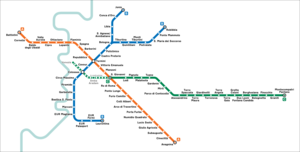
The Tram routes mostly skirt the historic centre, but there are stops convenient for the Vatican, the Colosseum, and the Trastevere area. The number 8 does run into the centre to Largo Argentina, not far from the Pantheon, and terminate at Piazza Venezia. If you want to catch a soccer game at one of the stadiums in the north of the city, catch the tram (2) just north of the Piazza del Popolo. Number 19 links the Vatican with Villa Borghese.
Metro [ edit ]
There are two lines that cross at Termini station: line A runs northwest past the Vatican and southeast, and line B runs southwest past the Colosseum and northeast in one direction, but also splits at the "Bologna" station to go due north until Jonio. Line C runs from San Giovanni station to the eastern suburbs.
All lines open at 05:30 and stop running at 23:30, except Fridays and Saturdays, when the last trains leave from the stations at 01:30. The Metro is the most punctual form of public transportation in Rome, but it can get extremely crowded during rush hour. See safety warning in the Stay Safe section .
By commuter rail [ edit ]
There is a network of suburban rail lines that mostly connect to smaller towns and conurbations of Rome. Tourists are unlikely to use these, except when arriving from Fiumicino, but they can be very convenient if you fancy a day-trip out of Rome (see Go next ).
By moped [ edit ]
There is the possibility to hire motor bikes or scooters. Many Romans prefer this way of transportation, even in winter you can see them driving scooters equipped with raincoats, blankets, and rain boots. Motorbikes are not particularly safe in Rome and most accidents seem to involve one (or two!). Nevertheless, Roman traffic is chaotic and a scooter provides excellent mobility within the city. Scooter rental costs between €30 and €70 per day depending on scooter size and rental company. The traffic can be intimidating and the experience exciting but a bit insane.
Some of the main rental shops:
- Scoot A Long noleggio scooter , via Cavour 302 , ☏ +39 06 6780206 .
- Centro Moto Coloseo , strada statale Quattro, 46 , ☏ +39 06 70451069 .
- Eco Move Rent , Via Varese 48/50 , ☏ +39 06 44704518 .
- Rent & Rent , v. Capo d'Africa 33 , ☏ +39 06 7002915 .
- Biga Bike Rent & Tours , Via Pellegrino Matteucci 136 (Ostiense Station) , ☏ +39 06 5741053 . Open 09:00-19:00 non-stop every day, vehicle delivery/pickup (scooter & bicycle), guided tours, for info and bookings +39 3428711336.
- Dolce Vespa , Via Adriano Balbi 14 , ☏ +39 3476317932 , [email protected] .
- Riderly , 1 Via di San Calisto . Only offer scooter hire. They include most of the gear you need: helmet, gloves, phone holder.
By bicycle [ edit ]
There is the possibility to hire any kind of bike in Rome: from tandem, road bikes, children bikes to trekking bikes. Some shops are even specialised only on high quality ones while street stands will hire you cheaper and heavy ones. Bicycling alone can be stressful because of the traffic. The best way is to discover first how to move around and avoid traffic and stress with a guide thanks to one of the tours offered by almost all rental shops. There are different itineraries offered from the basic city centre, panoramic Rome tour to the Ancient Parks (from €29 for 4h). The experience is well worth it and you would reduce also your impact on the city environment and on the traffic.
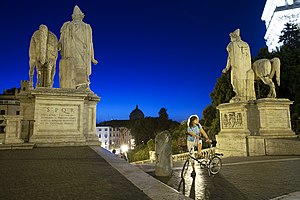
Even moderately experienced cyclists, however, may find that cycling through Rome's streets offers an unparalleled way to learn the city intimately and get around very cheaply and efficiently. While the Roman traffic is certainly chaotic to someone from a country with more regimented and enforced rules of the road, Roman drivers are, generally speaking, used to seeing bicycles, as well as scooters and motorcycles, and one may move throughout the city relatively easily. If you are in a car's way, they will generally let you know with a quick beep of the horn and wait for you to move.
A particularly spectacular, and relaxing, cycle trip is to pedal out along la Via Appia Antica , the original Appian Way that linked much of Italy to Rome. Some of the original cobblestones, now worn by over 2 millennia of traffic, are still in place. With exceptionally light traffic in most sections, you can casually meander your bike over kilometres of incredible scenery and pass ancient relics and active archaeological sites throughout the journey. ( Rome/South )
Some of the many rental shops:
- Punto Informativo , Via Appia Antica 58/60 , ☏ +39 06 5126314 . M-Sa 09:30-13:30 and 14:00-17:30 (16:30 in wintertime), Su and holidays 09:30-17:30 non stop (16:30 wintertime) . Price: €3/hour and €10/day .
- Comitato per la Caffarella (Largo Tacchi Venturi) , ☏ +39 06 789279 . Su 10:00-18:00 . Price: €3/hour and €10/day .
- Catacombe di San Sebastiano , ☏ +39 06 7850350 . Every day except Sundays . Price: €3/hour and €10/day .
- TopBike Rental & Tours , Via Labicana 49 , ☏ +39 06 4882893 , [email protected] . Daily 09:30-19:00 . ( updated Jan 2017 )
- Bici & Baci , Via del Viminale, 5 ( Termini Station ), ☏ +39 06 4828443 .
- Roma Starbike , Via Capo d’Africa, 29 D Roma , ☏ +39 06 4543 0118 , [email protected] . Daily 9:00-20:00 (19:00 in wintertime) . ( updated Dec 2019 )
- Roma Rent Bike , Via di San Paolo alla Regola 33 ( Campo de Fiori ), ☏ +39 06 88922365 . ( updated Aug 2017 )
- Collalti , Via del Pellegrino, 82 ( Campo de’ Fiori ), ☏ +39 06 68801084 .
- Romarent , Vicolo dei Bovari, 7/a ( Campo de’ Fiori ), ☏ +39 06 6896555 .
- Bikeaway , Via Monte del Gallo, 25 A ( Stazione FS S. Pietro ), ☏ +39 06 45495816 .
By Segway Pt [ edit ]
It is now possible to rent a Segway in Rome. It is a fast and convenient way to get around in the city centre. In Rome, a person on a Segway is considered a pedestrian, not a motorist, so Segways are only allowed on the sidewalks, not in the streets with vehicles. Segway rental costs between €25 and €50 per hour, or between €70 and €100 for an accompanied tour of 2–4 hours.
- Rome on Segway, via Labicana 94, tel: 06 97602723, 39 3486121355
- Rex-Tours and Rent, Via dei Balestrari 33, tel: 06 87690040
- Ecogo Segway, Piazzale Ammiraglio Bergamini 10, tel: 39 3409345441
Moreover, it is possible to book online several Segway Tour in Rome, focused on certain attractions or itineraries. Some of the main rental websites are:
- Rome by Segway [dead link]
- Italy by Segway
See [ edit ]
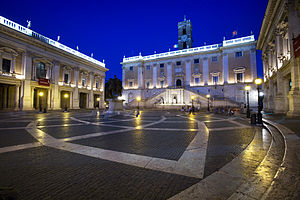
Italians are very fond of their landmarks; in order to make them accessible to everyone one week a year there is no charge for admittance to all publicly owned landmarks and historical sites. This week, known as " La settimana dei beni culturali ", typically occurs in mid-May and for those 7 to 10 days every landmark, archaeological site and museum belonging to government agencies (including the Quirinale presidential palace and gardens, the Colosseum and all of the ancient Forum) is accessible and free of charge.
Government-owned museums and historical sites have free admission on the first Sunday of every month.

Roma Pass [ edit ]
If you'll be staying in Rome for at least 3 days, consider purchasing the Roma Pass . It is valid for 3 days and costs €52 (Feb 2023). It entitles holders to free admission to the first two museums and/or archaeological sites visited, full access to the public transport system, and discounts for the other museums, tourist sites, exhibitions, music events, theatrical and dance performances. This pass gets you in to the Colosseum (Colosseo), Palatine Hill (Palatino Hill), the Baths of Caracalla (Terme di Caracalla), and the catacombs as well as the Terme di Diocleziano, Palazza Massimo alle Terme, Crypta Balbi, Palazzo Altemps, Villa dei Quintili, and the Tomb of Cecilia Metella.
A Roma Pass 48-hours is also offered for €32 (Feb 2023) and is valid for 2 days. For this pass only the first museum and/or archaeological sites visited is free.
Check the expiration date at the back of the Roma Pass card. If the card's validity has expired it does not work in the metro's ticket gate. Be sure to buy the passes at official tourist offices. There are also small booths on the streets that sell tickets, but they could charge you a higher price.
Another advantage of the Roma Pass is that you can often skip the waiting queues if it's one of your first two free entrances. This way you can avoid, for example, a 1+ hour waiting time at the Colosseum.
There's an alternative pass called OMNIA Vatican and Rome [dead link] that includes the services provided by Roma Pass, free entry to Vatican Museums and Sistine Chapel, fast track entry to St Peter's Basilica and hop-on-hop-off bus tour for 3 days. It costs €113 for 3 days
Ancient Rome [ edit ]
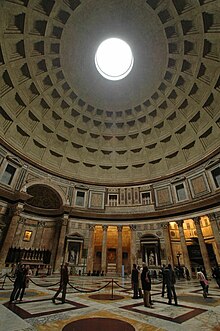
The main area for exploring the ruins of ancient Rome is in Rome/Colosseo either side of Via dei Fori Imperiali, which connects the Colosseum and Piazza Venezia. Constructed between 1931 and 1933, at the time of Mussolini, this road destroyed a large area of Renaissance and medieval buildings constructed on top of ruins of the ancient forums and ended forever plans for an archaeological park stretching all the way to the Appian Way. Heading towards the Colosseum from Piazza Venezia, you see the Roman Forum on your right and Trajan's Forum and Market on the left. To the right of the Colosseum is the Arch of Constantine and the beginning of the Palatine Hill, which will eventually lead you to ruins of the Flavian Palace and a view of the Circus Maximus (see Rome/Aventino-Testaccio ). To the left, after the Colosseum is a wide, tree-lined path that climbs through the Colle Oppio park. Underneath this park is the Golden House of Nero (Domus Aurea), an enormous and spectacular underground complex restored and then closed again due to damage caused by heavy rain. Further to the left on the Esquiline Hill are ruins of Trajan's baths.
In Old Rome you must see the Pantheon, which is amazingly well preserved considering it dates back to 125 AD. There is a hole constructed in the ceiling so it is an interesting experience to be there when it is raining. If you are heading to the Pantheon from Piazza Venezia you first reach Largo di Torre Argentina on your left. Until 1926 this was covered in narrow streets and small houses, which were razed to the ground when ruins of Roman temples were discovered. Moving along Corso Vittorio Emmanuelle and crossing the Tiber river into the Vatican area you see the imposing Castel Sant' Angelo, built as a Mausoleum for the Emperor Hadrian. This is connected by a covered fortified corridor to the Vatican and served as a refuge for Popes in times of trouble.
South of the Colosseum are the Baths of Caracalla ( Aventino-Testaccio ). You can then head South-East on the old Appian Way, passing through a stretch of very well-preserved city wall. For the adventurous, continuing along the Appian Way ( Rome/South ) will bring you to a whole host of Roman ruins, including the Circus of Maxentius, the tomb of Cecilia Metella, the Villa dei Quintili and, nearby, several long stretches of Roman aqueduct.
Returning to the Modern Centre , the Baths of Diocletian are opposite the entrance to the main railway station, Termini. The National Museum of Rome stands in the South-West corner of the Baths complex and has an enormous collection of Roman sculptures and other artefacts. But this is just one of numerous museums devoted to ancient Rome, including those of the Capitoline Hill. It is really amazing how much there is.
Catholic Rome [ edit ]

There are more than 900 churches in Rome; probably one third would be well worth a visit!
In Catholic tradition, St. Peter is said to have founded the church in Rome together with St. Paul. The first churches of Rome originated in places where early Christians met, usually in the homes of private citizens. By the IVth Century, however, there were already four major churches, or basilicas. Rome had 28 cardinals who took it in turns to give mass once a week in one of the basilicas. In one form or another the four basilicas are with us today and constitute the major churches of Rome. They are St Peter's , St Paul's Outside the Walls , Santa Maria Maggiore and San Giovanni . All pilgrims to Rome are expected to visit these four basilicas, together with San Lorenzo fuori le mura , Santa Croce in Gerusalemme , and the Sanctuary of Divino Amore . The latter was inserted as one of the seven at the time of the Great Jubilee in 2000, replacing San Sebastiano outside the walls .
Take a look inside a few churches. You'll find the richness and range of decor astonishing, from fine classical art to tacky electric candles. Starting with several good examples of early Christian churches, including San Clemente and Santa Costanza , there are churches built over a period of 1700 years or so, including modern churches constructed to serve Rome's new suburbs.
Some churches in Rome deny admission to people who are dressed inappropriately. You will find "fashion police" at the most visited churches. ("Knees and shoulders" are the main problem - especially female ones.) Bare shoulders, short skirts, and shorts are officially not allowed, but long shorts and skirts reaching just above the knee should generally be no problem. However, it's always safer to wear longer pants or skirts that go below the knee; St. Peter's in particular is known for rejecting tourists for uncovered knees, shoulders, midriffs, etc. (You also generally won't be told until right before you enter the church, so you will have made the trek to the Vatican and stood in a long security line for nothing.) The stricter churches usually have vendors just outside selling inexpensive scarves and sometimes plastic pants. But relatively few churches enforce dress codes and you can wander into most wearing shorts, sleeveless shirts, or pretty much anything without problems. It is, however, good to keep one's dress tasteful, as these are still churches and houses of prayer for many people. (Older Romans might comment on your attire and perhaps harass you if it is particularly revealing.)
The Seven Hills of Rome [ edit ]
To the modern visitor, the Seven Hills of Rome can be rather difficult to identify. In the first place generations of buildings constructed on top of each other and the construction of tall buildings in the valleys have tended to make the hills less pronounced than they originally were. Secondly, there are clearly more than seven hills. In Roman days many of these were outside the city boundaries.
The seven hills were first occupied by small settlements and not recognised as a city for some time. Rome came into being as these settlements acted together to drain the marshy valleys between them and turn them into markets and fora. The Roman Forum used to be a swamp.
The Palatine Hill looms over Circus Maximus and is accessed near the Colosseum . Legend has it that this was occupied by Romulus when he fell out with his brother, Remus, who occupied the Aventine Hill on the other side of the Circus. Also clearly recognisable as hills are the Caelian , to the southeast of Circus Maximus and the Capitoline , which overlooks the Forum and now hosts the Municipality of Rome. East and northeast of the Roman Forum are the Esquiline , Viminal, and Quirinal hills . These are less easy to distinguish as separate hills these days and from a distance look like one.
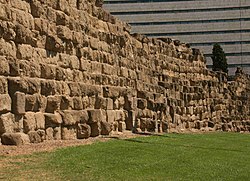
The red line on the map indicates the Servian Wall, its construction is credited to the Roman King Servius Tullius in the Sixth Century BC, but archaeological evidence places its construction during the Fourth Century BC. Small bits of this wall can still be seen, particularly close to Termini railway station and on the Aventine hill . As Rome expanded new walls were required to protect the larger area. These were built in the Third Century AD by the Emperor Aurelian. Lengthy sections of this wall remain all around the outskirts of Rome's centre. Much is in very good condition.
Among other hills of Rome, not included in the seven, are that overlooking the Vatican ; the Janiculum overlooking Trastevere , which provides excellent views of Rome; the Pincio on the edge of the Borghese Gardens , which gives good views of the Vatican, and the Monte Mario to the north.
Museums [ edit ]
If you are in Rome for the Arts there are several world-class museums in the city. The natural starting point is a visit to the area of Villa Borghese in Rome/North Center , where there is a cluster of art museums in and around the Borghese Gardens. Galleria Borghese houses a previously private art collection of the Borghese family, Museo Nazionale di Villa Giulia is home of the world's largest Etruscan art collection, and Galleria Nazionale d'Arte Moderna houses many Italian masterpieces as well as a few pieces by artists such as Cézanne, Degas, Monet and Van Gogh.
The Capitoline Museums in the Colosseo district opens their doors to the city's most important collection of antique Roman and Greek art and sculptures. Visit the Galleria d'Arte Antica , housed in the Barberini palace in the Modern centre , for Italian Renaissance and Baroque art.
A visit to Rome is not complete without a trip to the Vatican Museum . You need to go to the museum if you want to see the Sistine Chapel, but there is an enormous collection. You cannot miss part of this, such as tapestries, maps and the rooms painted by Rafael, as they are en route to the Sistine Chapel, but there is much, much more to explore, including a stunning Egyptian collection, and the Pinacoteca, which includes a Portrait of St. Jerome by Leonardo da Vinci and paintings by Giotto, Perugino, Raphael, Veronese, Caravaggio, and others.
Rome's National Museum at the Baths of Diocletian in the Modern Centre has a vast archaeological collection as does the national museum at Palazzo Altemps , close to Piazza Navona . Further afield, the Museo di Civilta Romana (Museum of Rome's Civilization), in EUR is most famous for an enormous model of Imperial Rome, but also has an extensive display of plaster casts, models and reconstructions of statues and Roman stonework.
If you have plenty of time there is absolutely no shortage of other museums covering a wide variety of interests. Examples include the Museum of the Walls (see Rome/South ), the Musical Instrument Museum and a museum devoted to the liberation of Rome from German occupation in the Second World War ( Rome/Esquilino-San Giovanni ).
Check museum opening hours before heading there. Government museums are invariably closed on Mondays, so that is a good day for other activities. The Rome municipality itself operates some 17 museums and attractions. Info at Musei In Comune Roma [dead link] . These are free to European Union citizens under 18 and over 65. Websites for other museums are listed on the relevant District pages.
Just walking around [ edit ]

Much of the attraction of Rome is in just wandering around the old city. You can quickly escape from the major tourist routes and feel as if you are in a small medieval village, not a capital city. If you can do so while watching for uneven cobblestones, keep looking upwards. There are some amazing roof gardens and all sorts of sculptures, paintings and religious icons attached to exterior walls. Look through 2nd and 3rd floor windows to see some oak-beamed ceilings in the old houses. Look through the archway entrances of larger Palazzos to see incredible courtyards, complete with sculptures, fountains and gardens. Take a stroll in the area between Piazza Navona and the Tiber river in Old Rome where artisans continue to ply their trade from small shops. Also in Old Rome , take a 1 km (0.62 mi) stroll down Via Giulia , which is lined with many old palaces. Film enthusiasts will want to visit Via Veneto (Via Vittorio Veneto) in the Modern Centre , scene for much of Fellini's La Dolce Vita .
The Piazzas [ edit ]
The narrow streets frequently broaden out into small or large squares (piazzas), which usually have one or more churches and a fountain or two. Apart from Piazza Navona and Piazza della Rotonda (in front of the Pantheon), take in the nearby Piazza della Minerva , with its unique elephant statue by Bernini and Piazza Colonna with the column of Marcus Aurelius and Palazzo Chigi, meeting place of the Italian Government. On the other side of Corso Vittorio Emanuele are Piazza Farnese with the Palazzo of the same name (now the French Embassy) and two interesting fountains and the flower sellers at Campo dei Fiori , scene of Rome's executions in the old days. All of these squares are a short distance from each other in Old Rome . The enormous Piazza del Popolo in the North Centre , which provided an imposing entrance to the city when it represented the northern boundary of Rome, is well worth a visit. A short walk back towards the centre brings you to Piazza di Spagna at the foot of the Spanish Steps. Yet another fascinating fountain here. The area was much used as backdrop for the 1953 film Roman Holiday with Audrey Hepburn and Gregory Peck.
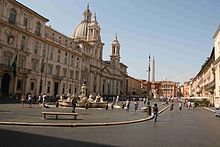
On the other side of the river is, of course, the magnificent square of St Peter's at the Vatican . Further south, in Trastevere is Piazza Santa Maria in Trastevere , a great place to watch the world go by, either from one of the restaurants or bars that line two sides of the square or, if that is too expensive, from the steps of the central fountain. The square attracts many street entertainers.
Moving back to the Modern Centre you have to see the Trevi Fountain , surely a part of everyone's Roman holiday. Visitors are always amazed that such a big and famous fountain is tucked away in a small piazza in the middle of side streets. Take extra-special care of your possessions here. Further up the Via del Tritone you will come to Piazza Barberini , now full of traffic but the lovely Bernini fountain is not to be missed.
Overlooked Places [ edit ]
EUR provides a selection of Fascist Architecture, including the Palazzo della Civiltà Italiana , often referred to "the Square Colosseum." It was designed to honour the historic Colosseum. This would be an interesting place to visit after seeing the Colosseum to compare their differences and similarities.
Viewpoints [ edit ]
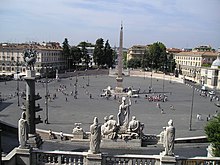
With no tall buildings in Rome, views of the city come from climbing the many hills, either the original seven hills of Rome or others that surround them. The two most popular views of Rome are from the Janiculum hill overlooking Trastevere and the Pincio at the edge of the Borghese Gardens . The former, best reached by car, has sweeping views of the centre of Rome, as long as the authorities remember to prune the trees on the hillside in front of the viewpoint. Cross over the piazza for an excellent view of the dome of St Peter's . The Vatican is the main sight from the Pincio (metro Line A, Piazza del Popolo, and then a good climb). Less popular, but just as nice, is the orange grove at Parco Savello on the Aventine Hill . Even less popular among tourists, as it is better accessed by car or moped, it the small square in front of the Zodiaco Restaurant in Monte Mario, a very popular spot for young Roman couples.
Rome for kids [ edit ]
If you are planning some serious sightseeing then leave the kids with their grandparents! They don't take kindly to being dragged from ruin to ruin and church to church. A common sight in Rome is miserable looking kids traipsing after their parents. Also, push chairs/buggies are difficult to use because of the cobbled streets. If you are a family, do not try to do too much. It will be a big strain on kids and in the end everyone will be tired.
Apart from the major attractions Rome has relatively little to entertain kids. If you noticed a big Ferris wheel on your way in from Fiumicino Airport, think again. Lunapark at EUR was closed down in 2008. A few of the other ways to bribe your kids, however, are:
- Children's Museum . Via Flaminia 82. Just north of Piazza del Popolo. Controlled entrance at 10.00, 12,00, 15.00 and 17.00 for visits lasting 1 hour 45 minutes. Closed Mondays and for much of August. Best to check the web site for up-to-date info and to book in advance. Hands-on science, mainly for pre-teens, housed in a former tram-car depot.
- Bioparco . The renamed Rome Zoo. On the edge of the Borghese Gardens ( North Centre ).
- The Time Elevator . Via dei Santi Apostoli, 20 on a side street between Piazza Venezia and the Trevi Fountain. Daily 10.30 to 19.30. "Five-dimensional" shows on the Origins of Life and on the History of Rome, plus "The House of Horrors". Not for the faint-hearted: your seats move all over the place. Kids love it.
- Rome's Wax Museum . 67 Piazza di Santi Apostoli, next to Piazza Venezia. Few good reports about this museum. Comments invited.
- Planetarium . This also has an excellent astronomy museum and is conveniently next to the Museum of Rome's Civilization ( EUR ).
- The Vatican is, by and large, not a great idea for kids although they often enjoy the Sistine Chapel and are impressed by the beauty and the fact that it was all done in just four years. However, the Sistine Chapel is very crowded and getting there through the corridors of the Vatican Museum is even worse. It is easy for families to get separated so determine a meeting point. The best part of St. Peter's Basilica is that kids can go to the top of the dome. It is 500 steps but you can take the elevator up to the third floor. From there there are another 323 exhausting steps. So it is fun for older kids who can both climb up all the stairs and walk down as there is a huge line for the elevator ( Vatican ).
- Zoomarine [dead link] . Dolphins, sea lions, exotic birds, splashy rides and swimming pools, some 20 km (12 mi) south of Rome near Pomezia. A good day out, but is this really why you came to Rome? Free transport from EUR and Pomezia railway station. Check web site for details.
Do [ edit ]
- Take in a show. There are lots of theatres, but you will need to know Italian to enjoy them. The main concert venue is the Auditorium in Viale Pietro de Coubertin to the north of Rome . The Auditorium at Parco della Musica is a large complex composed of three separate halls whose shapes are inspired by musical instruments. These are positioned around an open-air amphitheatre, that is used nearly every night in the summer for concerts. The Parco della Musica hosts a constant stream of classical, popular, and jazz music, featuring national as well as international musicians and groups. Really big names perform outdoors in the summer; usually in either the Olympic Stadium or in Stadio Flaminio, which is next door to the Parco della Musica. In winter the Palalotto in EUR is an important pop concert venue.
- Walk and feel the energy of Rome; sights are everywhere waiting to be discovered.
- Walk or cycle along the banks of the Tiber. There are steps down to the river from close to most of the bridges. A few have special runners for cycle wheels. This gets you away from the traffic fumes and gives a different perspective of Rome. Not usually possible in winter when water levels can be very high.
- Explore the Trastevere neighbourhood for some great cafes and trattorie, and a glimpse at a hip Roman neighbourhood.
- Watch football ie soccer. The city has two teams playing in Serie A, the top tier of Italian football, AS Roma and SS Lazio. They share the Stadio Olimpico, capacity 70,000, in the north of the city. Matches between the two teams are known as the Derby della Capitale , and are extremely charged affairs, with crowd violence being a regular occurrence, sometimes even resulting in fatal stabbings.
Events [ edit ]
- White Night (Notte Bianca) . In early to mid-September, various events until dawn, plus shops and restaurants, museums stay open while the Roman Notte Bianca stages music, dance and theater events. Expect enormous crowds; buses and trams will be packed to the brim.
- Opera at Caracalla , Baths of Caracalla (see Rome/Aventino-Testaccio) . If you are in Rome during summertime don’t miss the chance to experience a lyric opera in the truly unique setting of the Caracalla Baths. The 2009 program included Tosca, Carmen and Midsummer Night’s Dream. Performances start at 21:00.
Learn [ edit ]
Rome is replete with foreign language and cultural institutions. Of course, learning Italian is a worthwhile activity if you plan to stay for any length of time. If you plan to combine a stay in Rome with academic study, there are several English-language universities.
- The regional government and two historical societies are offering free Latin classes to tourists.
- The Historical Group of Rome runs a gladiator school . 18 Via Appia Antica.
Work [ edit ]
If you want to work ask around at the hostels, hotels and restaurants. There are differing views on how easy it is to get a job in Rome, however. There is high unemployment and most jobs seem to go on a family - friends - other Romans - other Italians - EU - other foreigners pecking order. Knowing Italian helps. And be wary about making any financial commitments before you've actually been paid -- late and non-payment is common here, and you may find as a non-Roman you are more likely to be seen as an easy target for this. You will also need a permesso di soggiorno, whether or not you are an EU resident.
There are numerous schools to teach the English language in Rome and if you are a mother-tongue this may be the best opportunity of picking up part-time work.
Talk [ edit ]
In Rome, obviously, the population speaks Italian . The road signs are mostly in Italian (except for "STOP"). If you are staying in the city there are plenty of English alternatives to be found. Seeing as Rome is a popular place to visit there are maps and information in many languages available. Police officers and transit drivers are more than willing to help you get around and usually provide easier ways to get around.
Some residents still speak the ancient local dialect, Romanesco ; nowadays, however, Italian is the more common mother tongue.
English is widely spoken in Rome by the younger generations and by people working in the tourist industry. Since many people have a limited knowledge of English, it is wise to speak slowly and simply. Among 40+s the chance is a lot less, and with 60+s as good as zero.
Romance languages other than Italian, especially Spanish, Portuguese and French, are also fairly widely understood due to their similarity to Italian, although not necessarily spoken.
Buy [ edit ]

Rome has excellent shopping opportunities of all kinds - from clothing and jewellery to art and antiques. You also get some big department stores, outlets and shopping centres, notably in the suburbs and outskirts.
Main shopping areas include Via del Corso, Via Condotti, and the surrounding streets. The finest designer stores are around Via Condotti, whilst Via del Corso has more affordable clothing, and Via Cola di Rienzo, and the surroundings of Via del Tritone, Campo de'Fiori, and Pantheon are the places to go for cheaper items. Upim is a good shop for cheap clothing of workable quality. Some brands (like Miss Sixty and Furla) are excellent, some are not as good - be sure to feel garments and try them on. There are also great quality shoes and leather bags at prices that compare well with the UK and US. Clothes in sizes bigger than a UK size 16/US 12 aren't always easy to find. Children's clothing can be expensive with basic vests (tank tops) costing as much as €21 in non-designer shops. If you really need to buy clothiers for kids try the Oviesse chain. Summer sales in many stores begin around July 15 and Rome also has New Year sales.
As mentioned above, Via Condotti is Rome's top haute couture fashion street (equivalent of Fifth Avenue in New York City, Via Montenapoleone in Milan, or Bond Street in London). Here, you can find big brand names such as Gucci, Armani, Dior, Valentino and Hermès, and several other high-class shops. However, the streets around the Via Condotti, such as Via Frattina, Via del Babuino, Via Borgognona and the Piazza di Spagna also offer some excellent high fashion boutiques, including Roberto Cavalli, Dolce & Gabbana, Versace, Prada and Givenchy (and several others). So once in the city, the big boutique names aren't absent. In these luxurious streets, however, you needn't only do clothing shopping - there are some really good and funky jewellery (e.g. Bulgari, Cartier, Tiffany's & Co.), pen and accessory (i.e. Mont Blanc) and artsy stores peppered here and there in these streets.
For department stores, Milan-based luxury department store chain La Rinascente has two flagship branches in Rome; one along Via de Tritone, near the Trevi Fountain, in which you can see the Roman aqueduct carrying water to the Trevi Fountain in the basement, and the other one on Piazza Fiume.
If you want to spend a day in a large shopping mall , there's the Euroma2 with about 230 shops (mainly clothes and accessories) and restaurants, to be found near the EUR district. Take Metro B line from Termini to EUR Palasport station, cross the road and take the frequent free bus (ride takes 5–15 minutes) to the mall. In addition to many shops and food, the conditioned air and free toilets may be a welcome relief if you are in Rome during mid-summer.
There are lots of fake plastic 'Louis Vuitton' bags being sold at the side of the road. Be aware, that buying of fake products is illegal in Italy. Fines up to €1000 have been reported. If you are happy to take the risk, make sure you haggle; unsuspecting tourists pay up to €60 for them.
If you want to buy souvenirs or gifts, a museum would be the worst choice since there are many stalls along the streets of tourist areas that offer reasonable prices. It is likely that the same item in the gift shop of any museum will cost much more.
Factory outlets [ edit ]
- Castel Romano . Near Rome, along the Via Pontina highway. A very large Factory Outlet with more than 100 branded shops. A car is needed to reach the place but a 30% discount in a designer shop is surely worth the 20 km (12 mi) trip.
- [dead link] Valmontone . A little further away from Rome than Castel Romano, you can find Valmontone outlet on the motorway towards Napoli just 50 km (31 mi) far from Rome. Valmontone itself is a delightful little town - 30 mins by train.
Eat [ edit ]
Rome is full of good restaurants, many in attractive settings, particularly when you sit outside in the evening. No one location can be recommended to search for a good restaurant: some of the best places to eat are in the most unpromising locations while well-situated restaurants can often live on their reputation rather than the quality of their food. Restaurants in guidebooks can be good but prices can be inflated because it is more than likely a "tourist trap". To find an authentic restaurant that won't break the bank, try to find a place in a more residential area or somewhere that isn't in the middle of the tourist locations.
Many of the good restaurants in Rome are hard to find, but a good tip is to go where Italians live and eat. The downside is that waitstaff at these restaurants usually do not speak English, so be prepared to have to speak some Italian. On the top of the green, old mountain (Monte Verde Vecchio) there are some trattorias with authentic Italian cuisine at an affordable price. Rome also has many beautiful spots to eat, so buying some delicacies to make up a picnic can be a great experience. In Via Marmorata you find Volpetti's which is known for its amazing selection of cheese, prosciutto and delicious pastries (and also for its prices!). A more affordable choice is to go to a local supermarket which will also have good fresh foods for lunch.
Pizza [ edit ]
Most pizza restaurants serve it only in the evening. Try some of the fried things like baccala (battered salt cod) for a starter, followed by a pizza for a really Roman meal. Roman pizzas tend to be very thin crusted. Avoid the tourist areas where you'll often pay double the going rate just to get a badly reheated frozen pizza. Your best bet is to cross the river and find a restaurant in Trastevere--the food is authentic and a lot cheaper than in the rest of downtown Rome. Make sure you eat it with a fork and knife; Romans don't eat this kind of pizza with their hands.
Pizza al Taglio is pizza with a thicker crust, cooked in a large pan. This is served by the piece, usually to take away, and is a good cheap way to get something to fill you up. Point to the one you want, indicate if you want more or less than your server is indicating with the knife. It's sold by weight (the listed price is usually per 100 g, known as an etto , short for ettogrammo , i.e. hectogram). This kind of pizza is eaten with the slices stacked on top of each other like a sandwich.
Ice cream [ edit ]
Look for a gelateria . Remember that it usually costs extra to sit inside. You pay for your ice cream first...take your receipt and go fight your way through the throng to choose your flavors (Italians don't believe in lines). You will be asked " Panna? " when it's almost made - this is the offer of whipped cream on top. If you've already paid, this is free.
There are a few signs to keep in mind: " Produzione Propria " (homemade - our own production), " Nostra Produzione " (our production), " Produzione Artigianale " (production by craftsmen). If the colours seem dull and almost ugly it is probably natural, the bright colours being just a mix. Keep in mind, Italians usually won't queue, but if they are in line for gelato, get in line yourself: you may have hit the jackpot. Producers to try include Gelato di San Crispino ; Giolitti ; and Fassi .
Vegetarians [ edit ]
Vegetarians should have an easy time. Buffets in many restaurants usually have a good range of delicious vegetarian stuff - e.g. gratinated roast peppers/aubergines, etc. Vegans should do all right too; pizzas don't always have cheese - a Marinara for example, is just tomato, garlic and oregano.
Kosher dining [ edit ]
While there is not much choice, at least Rome's Kosher cooking is truly excellent. Try La Taverna del Ghetto in the heart of the Jewish Quarter.
More places can be found near the synagogue in via Padova, close to the "La Sapienza" university and the Bologna underground station.
Pricing [ edit ]
You can get cheap food in Rome, the problem is that if you don't know the city well or are forced to eat out in the centre, the prices go up.
- €3.50 - You buy the pizza and eat it walking around, since it's a bread shop with no sitting area. You can choose how much you want to eat, but you'll be spending about €2 per slice + about €1.50 for a can of soda or €1 for water.
- €15-20 - At lunchtime if you go to a restaurant you'll be spending between €15 for a set menu (not always good, try to go where you see Italian office people having their lunch as your best bet) and €20. For this you should get a pasta dish and a second course (meat) ending with coffee. Obviously if you have special wine the price will increase.
- €20 - At night you can spend about €20 at a pizza restaurant or if you have only one main course. Again, if you have special wine it will cost more. The cheapest food you can get at a decent restaurant is a pizza marinara (that is, without cheese) for about €6. The price goes up from there depending on the toppings.
- €20+ - For a sit down lunch or dinner in a restaurant €20 is cheap and if you want you can go up to €200 a head.
Chinese restaurants are still quite cheap but other ethnic restaurants (Thai, Indian) are generally expensive (think €30 upwards per person). Sushi is very expensive (€40 minimum per person).
Waiters have been known to take advantage of patrons by bringing more expensive items than what was ordered or asking for a tip although it's not mandatory and should be included in the price by law.
Drink [ edit ]
Coffee [ edit ].
Starbucks has long avoided Rome, but in April 2023 the first one appeared in the center of Rome. And no wonder: Italian coffee is great so our friends from Seattle would face a lot of competition. A latte in Italian is just a glass of milk. If you're expecting coffee in that glass, you should ask for a caffe latte . A latte macchiato (meaning "marked") is steamed milk stained with a smaller shot of espresso. "Espresso" or "normale" is just that, but more commonly just referred to as caffe . Espresso doppio means a double shot of espresso, while espresso macchiato is espresso 'marked' with a dab of steamed milk. Americano — the one to order if you like filter coffee — is espresso diluted with hot water and not drunk much by Italians. Cappuccino is well known outside of Italy, but be warned: it is considered very un-classy, and somewhat childish, to order one after 11AM (and certainly after a meal). Decaffeinato is self-explanatory, but often referred to by the common brand-name Caffe Hag .
Wine and water [ edit ]
House wines are almost always drinkable and inexpensive (unlike, say, in the UK). You are better off ordering a bottle rather than house wine in most establishments in Rome due to some places watering down their wines. You may often find a bottle of wine on the table for you. Believe it or not: this bottle will be less expensive than a glass would be in the US or UK, possibly only €4 or €5. This does not always apply to those places that look really tourist-trap-like! Slightly better quality wines are usually sold at a relatively small mark-up on shop prices. Most Romans drink water with their meals. In restaurants it normally comes in 1 litre bottles and can be had normale (still water) or gassata (carbonated water).
Water is free at designated water fountains , called "nasone" (big nose). Some of these date back to ancient times, and the water is still very good. It's fresh spring water coming from the famous underground springs of Rome and is safe to drink. If you carry an empty bottle, fill it up for the rest of the day. Look for the drinking fountain with constant running water, plug the bottom hole, and cool water will shoot up from a smaller hole on top of the tap. Don't put your lips round the hole at the bottom, as stray dogs tend to like to get a drink.
Before dinner [ edit ]
Pre-dinner drinks ( aperitivi ) accompanied with small hors d'oeuvres (antipasti) are very popular with Romans: 1) chic yuppies in their 20s-30s crowd the area around Piazza delle Coppelle (behind the Parliament) and Piazza di Pietra (near the Chamber of Commerce); 2) younger generations sprawl around the square and streets of Campo de' Fiori ; 3) everyone sits to drink in the narrow streets behind the Pantheon ( Piazza Pasquino and Via del Governo Vecchio ).
Clubbing & Night Life [ edit ]
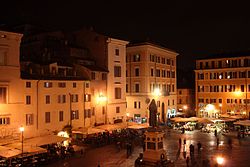
Given a heart for exploration, Testaccio is the place to wander for after-dinner partying on the weekends. Head down there around 23:00 (take metro Line B and get off at Piramide station) and listen for music. There are usually loads of people simply walking through the streets or looking for parking. Be brave, walk in, meet some wonderful Romans. This area is best in the winter. In the summer, the dancing moves to Ostia and Fregene, 45 minutes by car from Rome, at the seaside. Many clubs in Rome close in the summer months.
Many visitors like to go on Roman pub crawls. The Colosseum Pub Crawl for example, has been throwing parties since 1999.
To the east of Termini Station , and near the first University of Rome "La Sapienza", is the San Lorenzo district, where you will find many pubs and clubs where university students and young Romans in their twenties spend their nights. On Saturday night the streets are crowded with people moving from one pub to another. On the city side of the railway, near Santa Maria Maggiore Cathedral, are some great Irish pubs, i.e. the Fiddler's Elbow , the oldest in Rome, where many English-speaking residents and Italian customers like to sip their pints. It's a good place to meet Romans who speak English. Also nearby are the Druid's Den and the Druid's Rock .
On Via Nazionale there's a huge and beautiful pub called The Flann o'Brien [dead link] , one of the biggest in Rome. On the same street near Piazza Venezia there is another cluster of pubs including The Nag's Head Scottish Pub . After 22.00 it's very expensive as it becomes more like a disco. Entrance with first drink costs €13 and drinks cost €8. Before midnight they sometimes host live music concerts. In the same area, at the beginning of Via Vittorio Emanuele II you can find The Scholar's Lounge Irish pub with nice music. This is definitely worth a look but there is no room to dance. During winter American colleges students residents in Rome end up their highly alcoholic nights here. Also nearby there's the Trinity College Irish Pub . Drinks are quite expensive there.
Also on Via Vittorio Emanuele, near Piazza Navona , there's the Bulldog's Inn English pub . DJs play very good music there and there's room to dance, although few do. Nearby in Campo dei fiori there are several crowded pubs. Beware, there have been huge and serious fights there. In the narrow streets behind Piazza Navona there are also many places to go. Try Jonathan's Angels in Via del Fico. Also the Abbey Theatre Irish pub is a good place in Via del Governo Vecchio.
On the other side of the River Tiber (Tevere) is Trastevere district where there are many places to eat and drink. This is also a good place where to enjoy a walk in crowded streets at night. In summer time on Isola Tiberina , the island in the Tiber, temporary bar are built and there are all sorts of things to do.
Far from the centre there are some other good places. The Palacavicchi in a small suburban town called Ciampino is a multi-dance room area where they play different kinds of music, mostly Latin American. You definitely need to get a cab to get there and it won't cost less than €20. South of Ciampino Airport there is The Ice Club for ice skating, and the Kirby's [dead link] and the Geronimo pubs. All of them are nice places. At the Geronimo pub before midnight there usually are live music concerts with many bands covering different genres. On Friday and Saturday nights after the concert they play disco music. Entrance is free and you may drink and eat as you feel. Very cool place and for every budget. Unfortunately you need a cab to get there.
Those Romans who speak fluent English usually have a great deal of confidence with tourists, so just offer them a beer and they will be glad to share with you their tip & tricks about night life in Rome.
Discos: There are many beautiful discos. Unfortunately the city is huge and it's not very easy to find them, unless you have a very good guide.
The best way to start is from the most established ones: Piper, Gilda, Alien, all of them run by the Midra Srl [dead link] . Their website is nothing to write home about but can be used to discover telephone numbers and addresses. Gilda is near the Spanish Steps, and the others not too far from Termini station. During summer they close to move to the seaside of Fregene (north of Fiumicino and Ostia) where Gilda on the Beach can be found.
A pint of beer in pubs usually costs around €6, entrance in discos around €20 with first drink included. Drinks in discos cost around €10.
Gay travellers [ edit ]
One of the places to be on Friday nights is Giardino delle Rose in via Casilina Vecchia 1 (rather central but reachable only by taxi): a luxurious garden with open-air bars and tables. Two large discos are Mucca Assassina in via del Gazometro and Classico in via Ostiense. During the week the main meeting place after dinner is Coming Out (a bar right in front of the Colosseum) where crowds of gay Romans and tourists gather in and outside, all year round but overwhelmingly crowded during the summer or late-night clubs such as Hangar in Via in Selci (Metro Line A, get off at Manzoni station). The best sauna (open 24 hours during week ends) is Europa Multiclub in via Aureliana (behind Piazza Esedra, Metro Line A Repubblica station). A meeting spot for gays day and (especially) night is Monte Caprino , the park on the Palatine hill behind the City Hall (Piazza Venezia) with spectacular views over the temples and ruins of ancient Rome.
Sleep [ edit ]

The area to the southwest of Termini railway station has numerous large hotels; these are used in particular by groups and coach parties. On the other side of the station are many smaller, fairly inexpensive, hotels that are popular with individual travellers. Perhaps the best choice for a first-time visitor is to stay right downtown, (such as near the Pantheon ). Most attractions are walking distance from there, and you will save much transportation time and leave more for enjoying the city. Hotels in the downtown area are costly, but a good apartment is a decent alternative, especially for couples and if you don't mind cooking yourself from time to time: it will save even more of your budget.
Offering of short term apartment rentals is enormous. Many apartments can be booked directly through the owner, but most owners make arrangements via rental agencies, both large and small. When looking for a hotel or an apartment in Rome, take note that the price of accommodations varies significantly from month to month, depending on the typical number of tourists. Always check prices at your accommodation for your specific dates.
Being as it is one of the world's most popular tourist destinations, there are many choices as to where to stay, and you will have the choice of whatever type of accommodation you wish.
Rome's city council levies an accommodation tax. This is €2 per night per person for campsites up to three-star hotels and €6 a night for four- and five-star hotels. This fee can only be paid in cash, and is supposed to be for the restoration of Rome's crumbling ruins.
Hotel listings can be found in the appropriate districts , and should be added there. Please do not add listings here.
Camping [ edit ]
There are at least two campsites near Rome, they are:
- Camping Tiber , Via Tiberina Km. 14, Prima Porta ( On Rome's ringroad, take exit No 6 Via Flaminia, if arriving by public transport, take the ground-level Roma-Nord Subway leaving from Piazza Flaminia towards Prima Porta, from there there is a free shuttle service to the Camp Site ), ☏ +39 06 33610733 , fax : +39 06 33612314 . On the bank of the river from which it draws its name. To the north of the city. There's a minimarket, a pool, a restaurant and a bar.
- Happy Valley ( In the hills north of the city at Via Prato della Corte 1915, Prima Porta-Cassia Bis, Roma. Take exit no 5 from Rome's ring road and head towards Cassia-Veientana. If you take public transport, take the ground-level Roma-Nord Subway leaving from Piazza Flaminia towards Prima Porta and wait for the free shuttle bus service. ), ☏ +39 06-33626401 , fax : +39 06-33613800 . It has a pool, a bar, a restaurant and a minimarket.
Connect [ edit ]
As of Sept 2021, Rome has 5G from all Italian carriers. Wifi is widely available in public places.
- Via del Corso, Largo Goldoni , ☏ +39 06 68136061 .
- Castel Sant'Angelo, Piazza Pia , ☏ +39 06 68809707 .
- Fori Imperiali, Piazza Tempio della Pace , ☏ +39 06 69924307 .
- Piazza Navona, Piazza delle Cinque Lune , ☏ +39 06 68809240 .
- Via Nazionale, Piazza delle Esposizioni , ☏ +39 06 47824525 .
- Trastevere, Piazza San Sonnino , ☏ +39 06 58333457 .
- San Giovanni in Laterano, Piazza San Giovanni , ☏ +39 06 77203535 .
- Santa Maria Maggiore, Via dell_OLmata , ☏ +39 06 4740995 .
- Termini (arrivals), Piazza dei Cinquecenti , ☏ +39 06 47825194 .
- Termini, Galleria Gommata, Terminal 4 , ☏ +39 06 48906300 .
- Fontana di Trevi, Via Marco Mingehtti , ☏ +39 06 3782988 .
Respect [ edit ]
Romans regularly interact with foreigners and tourists; it shouldn't be hard to find friendly help provided you know some Italian. As for most every place in Italy, just be polite and you won't have much trouble.
If you hit someone with your luggage or shoulder while walking on a street, say "sorry" ( Mi scusi ): despite being very busy, Rome is not London or New York and going ahead is considered bad behaviour, while a little apology will be satisfactory.
In buses or trains, let older people have your seat if there's no space available. The gesture will be appreciated. Romans, and Italians as well, are very chaotic while in a queue, and often "clump" without any particular order: It's considered impolite, but they do it anyway. Be careful while driving, as Romans often drive frantically and bend the rules to cope with the heavy traffic.
Stay safe [ edit ]

Rome is generally a safe place, even for women traveling alone. However, there have been rape cases around the Roma Termini train station, so be careful especially at night time. There is very little violent crime, but plenty of scams and pickpocketing that target tourists. As in any other big city, it is better if you don't look like a tourist : don't exhibit your camera to all and sundry, and keep your money in a safe place. Consciousness and vigilance are your best insurances for avoiding becoming a victim of a crime in Rome. Remember, if you are pickpocketed or victim of another scam, don't be afraid to shout, "Aiuto, al ladro!" ( Help, Thief! ) Romans will not be nice to the thief.
Members of the Italian public are likely to be sympathetic if you are a crime victim. Police are also generally friendly if not always helpful. Carabinieri (black uniform, red striped trousers) are military police, and Polizia (blue and grey uniform) are civilians, but they both do essentially the same thing and are equally good, or bad. If you are robbed, try to find a police station and report it. This is essential to establishing a secure insurance claim and to replace documents: the chances of it resulting in the return of your possessions are, however, fairly remote.
Rome is home to two rival Serie A football (soccer) clubs, A.S. Roma and S.S. Lazio, and there is a history of conflict, and even rioting, between the two. Never wear anything that shows that you support either of them, especially during the Rome Derby (when the two clubs play each other, known in Italian as the Derby della Capitale ): avoid even wandering into groups of supporters of the other club, or you may be subject to heckling or even confrontation. Play it safe and refrain from openly supporting either club unless you are very familiar with the rivalry. If you are a fan of a foreign team that is playing in Rome, be very careful as a number of supporters have been stabbed over the past few years.
Rome has its fair share of odd people: talkative panhandlers, crazy taxi drivers, lonely people wanting to just have a chat with strangers, people trying to sell you things, and so on. If you don't want to acknowledge anyone, do what most Italian people do: completely ignore them, shoo them off, or simply say you don't have anything to give to them or you are not interested.
Pickpocketing [ edit ]
Since Rome is incredibly popular as a tourist destination, a great deal of pickpocketing and bag or purse snatching takes place, especially in crowded locations, and pickpocketers in Rome can get pretty crafty. A 2010 study found that Rome was second only to Barcelona for pickpocketing of tourists. As a rule, you should pretty much never carry anything very valuable in any outside pocket , especially the front pocket of your pants is one of the easiest and most common targets. Keeping your wallet in your front pocket or in your bag is far from safe. You should consider using a money belt and carry only the cash for the day in your pocket. Pickpocketing on the Metro is rife in the form of gangs of young girls (8 to 12 years old) who jump on the trains just as they are about to leave. They buffet you and have bags to hide where their hands are. You have been warned!
Also, beware of thieves—one popular technique that they use is to ride by you on a moped, slice the strap of a handbag with a knife, and ride off. They might also try to cut the bottom of your bag open and pick your wallet from the ground. Others will use the old trick of one person trying to distract you (asking for a cigarette or doing a strange dance) while another thief picks your pockets from behind. Bands of beggar kids will sometimes crowd you and reach for your pockets under the cover of newspapers or cardboard sheets. It is generally a good idea to be extremely wary of any strange person who gets too close to you, even in a crowd. If someone is in your personal space, shove the person away. As one frequent traveller put it, "Don't be afraid to be a dick in Rome." It is better to be rude than to be stolen from.
Termini (the main railway station), Esquilino, bus line 64 (Termini to San Pietro), and the Trevi fountain are well known for pickpockets, so take extra care in these areas. On the Metro especially, pickpockets are extremely skilled. Remember that hotel rooms are not safe places for valuables; if your room has no safe, give your valuables to the hotel staff for safekeeping. Even if it does have a safe, hotels normally warn that they have no liability unless items are deposited in the main safe. Be wary while boarding or getting off the metro/train, especially if doors are about to close/closing. Thieves pretend to be helpful by pressing the 'door open' button for you, and while you gratefully squeeze into the train and catch your breath, they'll sidle up to you and pick your pocket or dip into your handbag or purse. Be aware of the danger and take the usual precautions and you should be all right.
Tourist scams [ edit ]
Being one of the most visited cities in the world, tourist scams are rampant in Rome. Many of the more well-aware Italians are quite ashamed of this. As obvious as it may sound, do not acknowledge people you don't know, and more importantly, do not tell them about who you are; you don't know what they're capable of doing.
A particular scam is when some plainclothes police will approach you, asking to look for "drug money," or ask to see your passport. This is a scam to take your money. You can scare them by asking for their ID. Guardia di Finanza (the grey uniformed ones) do customs work.
Another scam involves men working near the Spanish Steps, around Piazza Navona, and outside of the Colosseum. They approach you, asking where you are from, and begin to tie bracelets around your wrists. When they are done they will try to charge you upwards of €20 for each bracelet. If anyone makes any attempt to reach for your hand, retract quickly. If you get trapped, you can refuse to pay, but this may not be wise if there are not many people around. Carry small bills or just change, in your wallet, so if you find yourself in cornered to pay for the bracelet, you can convince them that €1 or €2 is all you have.
When taking a taxi , be sure to remember license number written on the card door. In seconds, people have had a taxi bill risen by €10 or even more. When giving money to taxi driver, be careful.
Be careful of con-men who may approach you at tourist sights such as the Colosseum or Circus Maximus. A car may pull up next to you, and the driver asks you for directions to the Vatican. He will strike up a conversation with you while he sits in his car and tell you he is a sales representative for a large French fashion house. He will then tell that you he likes you and he would like to give you a gift of a coat worth several thousand euros. As you reach inside his car to take the bag the coat is in, he will ask you for €200 for gas, as his car is nearly empty. Around tourist sites like the Trevi Fountain, Colosseum and the Spanish Steps there are groups mostly of men trying to sell cheap souvenirs. They may also carry roses and say they are giving you a gift because they like you, but the minute you take their 'gift' they demand money. They are often very insistent and often the only way to get rid of them is to be plain rude. Do the best you can to not take their "gifts" as they will follow you around asking for money. Simply saying "no" or "go away" will get them off your back until the next vendor comes up to you.
Be wary of ticket touts outside popular tourist attractions such as the Colosseum. A large bulk of ticket touts hail from South Asia and some of them even claim to be working as "staff members". A genuine staff member at an attraction you are visiting will never ask you to pay heaps of money just to skip the crowd, tell you inaccurate information about the place you are visiting, and so on. These touts are simply looking for ways to waste your time and fleece your money. Be warned that some of them can be quite pushy, so don't feel the need to be polite if you are being pestered by a tout. As a general rule, only buy tickets from official venues and always check the website (if they have one) of the place you intend to visit. As a tourist, you can do your part in making Rome an even better place by reporting these touts to the right authorities.
Be careful and wary of people who sell you fake products on the streets. Quite ever so often you may run into people (usually recent immigrants from South Asia and Africa ) selling fake products (purses, toys, and the like) on the streets. Under Italian law, it is illegal to purchase counterfeit goods and you can incur heavy fines for doing so. The people who sell you these fake products know it is illegal to sell fake products, but they do it anyways to make a living. Only buy from reputed stores.
Be wary of places to change currency. Read ALL signs before changing money. Oftentimes places set up just for currency exchange will add as much as a 20% service fee on all money being traded. The shops near the Vatican have especially high service fees, whereas places near the Trevi Fountain will be more reasonable. The best bet is to change enough money before you leave your home country. There are few places around the city that are under the table and are just interested in American money. These places charge no service fee.
Emergencies [ edit ]
In an emergency, call 112 (Carabinieri), 113 (Police), 118 (medical first aid) or 115 (firemen). Carry the address of your embassy or consulate.
On anything else you may need for your Rome holiday, you can contact the official help line of the Minister of Tourism 039.039.039. From Monday to Sunday, from 9.00 to 22.00, in seven languages seven days a week.
Cope [ edit ]
- Police . To report theft you should generally go to the Carabinieri station nearest where the theft occurred. Ask people at the scene of the crime where to go.
- Left Luggage Termini . You can leave luggage at Termini but they have a lot of security and only one X-ray machine so there can be a +100 people queue. It costs about €4 per bag (of any size) for the first 5 hours, €0.80 per bag for each hour thereafter. There's a sign limiting bags to 20 kg each, but no facility for weighing them, so it's probably not enforced.
- Splashnet laundry, internet, left luggage , Via Varesi 33, 100 m west of Termini. €2 per luggage left (and 15 min of internet included).
Embassies [ edit ]
Consulates [ edit ], go next [ edit ].
- The Etruscan site of Cerveteri
- Head to Frascati , one of the historic hill towns to the South East of Rome known as the Castelli Romani . This town has been a popular destination for centuries away from the hustle and bustle of the capital, and this is still true today. Famous worldwide for its white wine, Frascati is a relaxed hill town with a slower pace of life. Just 21 km (13 mi) from Rome, Frascati is accessible by bus or train. Trains run from Roma Termini approximately every hour, take about 30 minutes, and cost around €2. Also in the Castelli is Castel Gandolfo , the summer residence of the Pope. The town overlooks Lake Albano, a popular weekend trip for Romans in the summer. Also accessible by bus and train but there are several interesting towns and villages in the Castelli so hiring a car for the day would be well-rewarded.
- Head to Ostia Antica , the ancient harbor and military colony of Rome. It is accessible by Metro every 30 minutes from Stazione Piramide (near the Pyramid). It is a monumental area a bit like the Colosseum district, but in Ostia Antica you can get an impression how a Roman city really looked.
- Consider a day trip to Tivoli to see the Villa d'Este with its famous and glorious fountains. Check out the Emperor Hadrian's Villa while you are out there. Hourly trains from Tiburtina; fewer on Sundays.
- Understand the Second World War in Italy by visiting the Anzio beachhead area, the landing museum at Anzio and Monte Cassino .
- Canterano , a picturesque village with strange legends just a few km away.
- Civitavecchia , the port of Rome, is the point of arrival and departure of hundreds of ships, cruises, and ferries travelling all around the Mediterranean. From here it is possible to reach Sardinia , Corsica , Sicily , Spain , France , some other small islands, and even north Africa . A good transportation system links the port to the Eternal City, e.g., see "Get in" "By train" above.
- Explore the Etruscan sites of Tarquinia and Vulci .
- Discover the papal city of Viterbo , well-known medieval and thermal destination (about 1 and half hours from Rome)
- Palestrina is a centre 40 km (25 mi) from Rome, rich in archaeological remains from the Roman time. Among the things to see: the Pagan Temple of the Goddess " Fortuna " , the National Archaeological Museum (housed in the Renaissance Palazzo Barberini), the Roman Forum and the Nilotic Mosaic .
- Visit Naples and the famed islands in its gulf, Capri , Ischia and Procida . Naples is 1 hour away by high speed train.
- Especially if you have a rail pass, making Pompeii a day trip, while it is a very full day, is very doable. To reach Pompeii from Rome will take about 3 hours.
By air [ edit ]
Rome has ultra-low-cost flights to destinations in Italy, to several European countries and to Egypt , Georgia , Israel , Armenia , Jordan and Morocco . (updated May 2022)
- UNESCO World Heritage Sites
- UNESCO tag to be fixed
- UNESCO Creative Cities
- Has custom banner
- Huge city articles
- Huge cities with more than 10 districts
- Has mapframe
- Maps with non-default alignment
- Maps with non-default size
- Airport listing
- Has map markers
- Articles with dead external links
- Do listing with no coordinates
- Buy listing with no coordinates
- Sleep listing with no coordinates
- Has routebox
- Usable cities
- Usable articles
- City articles
- Cities with categories
- Metropolitan Rome
- All destination articles
- Has Geo parameter
- Articles with districts discussion
- Pages with maps
Navigation menu
- Search Please fill out this field.
- Manage Your Subscription
- Give a Gift Subscription
- Newsletters
- Sweepstakes
- Travel Destinations A-Z
How to Live La Dolce Vita in Rome
:max_bytes(150000):strip_icc():format(webp)/jbbyline-Julia-Buckley-2000-ac2faf7b46fb4cf389229416af8f7c8e.jpeg)
Best Time to Go
Things to know, how to get around, best hotels, best restaurants, things to do, best shopping, neighborhoods to know, apps to download.
It famously straddles seven hills, but Rome often feels like several cities. There's the ancient one, of course – the Rome of emperors and amphitheaters, still visible today. Then there's grand, baroque Rome, a city of immense squares, florid churches and fountains, each more spectacular than the next. There's the Dolce Vita vibe, still, in elegant boutiques, bars, and restaurants, and landmark hotels still on Via Veneto. But Rome is also modern, with formerly residential neighborhoods such as Testaccio, Monti, and Ostiense now as attractive to tourists for their nightlife as the classic areas.
It all swirls together into one timeless gumbo. In the space of a day you can go from a Roman emperor's home to a hipster market; you can peel away the layers simply by stepping down into the basement of a church. Of course, all this excess needs some restraint. You should find that in the Vatican; but instead, you'll find Michelangelo's Sistine Chapel there. So when it all gets too much, there are the parks: the Giardino degli Aranci with its sublime views of the dome of St Peter's; the Villa Borghese, whose sprawling grounds contain several museums; and the Via Appia Antica, a Roman road strewn with mausoleums, catacombs, and ancient aqueducts. Even out in nature, Rome can't help but go over the top.
Central European Standard Time
Fall is famously stunning in Rome, known for soft-lit afternoons and a warming sun. To avoid the crowds, go in early-to-mid December — the religious visitors start piling in for the Pope's Christmas address after that — or in January and February.
Currency: Euro (Check the current exchange rate )
Language: Italian I don't speak Italian: Non parlo italiano I'm lost: Mi sono perso/a How much is...: Quanto costa... I would like…: Vorrei… How do I get to…: Per andare a... Learn more Italian phrases
Calling Code: +39
Capital City: Rome
Trains : Roma Termini is one of the biggest railway stations in the country, perfectly placed on the high-speed lines for fast access to Naples, Florence, Milan, and beyond. Fast direct trains to Fiumicino airport also leave from here.
Buses : Rome has a decent bus network although there's not much coverage in the historic center. It's easy to get out to places just beyond the city walls, such as Testaccio, Piramide, and the Via Appia Antica however. The metro system skims the city center.
Taxis : Taxis are plentiful, with stands at major sites — you can also use the FREE NOW hailing app. Fixed rates are in place for rides from airports Fiumicino and Ciampino, with prices clearly marked on doors.
Car service : Most hotels can arrange transfers; those to and from Fiumicino are normally good value, with prices only a little higher, but with no risk of arguments over fares and supplements at the end.
Rooms of Rome
Address: Via S. Remo, 3/int C3, 00182 Roma RM, Italy Phone: +39 345 178 1615 Book Now
Alda Fendi paused her fashion career to launch an art foundation; this hotel, which doubles as a gallery, is the next step. Below the Palatine Hill and near the Bocca della Verità (immortalized in Roman Holiday ) it's an 18th-century palazzo stripped to the brick bone and rebuilt by Jean Nouvel. There are mind blowing Palatine views from the terrace, while guests have out-of-hours access to exhibitions located in the hotel.
Palazzo Manfredi
Address: Via Labicana, 125, 00184 Roma RM, Italy Phone: +39 06 7759 1380 Book Now
No hotel in the city can claim such a jaw-dropping view as this modern, tranquil retreat which sits plum opposite the Colosseum. Enjoy the panoramas from the rooftop restaurant; or book a front-facing room to see one of the world's most famous buildings from your bed. This is one place that's worth splashing out for a fabled room with a view.
Inn at the Roman Forum
Address: Via degli Ibernesi, 30, 00184 Roma RM, Italy Phone: +39 06 6919 0970 Book Now
History lovers, this one's for you. After breakfast, take a look at the underground level, where archeologists have dug down to find Roman ruins – part of Trajan's Forum, just around the corner. Then head to the roof terrace, where the views of the Eternal City are endlessly spectacular. Rooms mix the grandiose with the contemporary.
Residenza Ruspoli Bonaparte
Address: Via della Fontanella di Borghese, 56, 00187 Roma RM, Italy Phone: +39 342 886 1007 Book Now
Looking for a hotel fit for royalty? This is the place for you – the childhood home of Napoleon Bonaparte III, former French emperor. The staircase is a marble architectural marvel, the ceilings are coffered and the walls are clad in silken damasks. The apartment-sized suites are more modern – so you don't feel like you're sleeping in a museum.
Il Campo Marzio
Address: Via di Campo Marzio, 46, 00184 Roma RM, Italy Phone: +39 06 8115 7571 Book Now
Within the grand Palazzo Magnani, an 18th-century mansion in the super-central Campo Marzio area, is this intimate, 13-room hotel. With most rooms holding two double beds, it's a great pick for friends and family. Leave room in your suitcase for a few bottles from the in-house liquor store which sells exclusively Italian-brewed booze.
Gigli d'Oro Suite
Address: Via dei Gigli d'Oro, 12, 00186 Roma RM, Italy Phone: +39 06 6880 3579 Book Now
One of the mini hotels that Rome does so well, this former family home now holds six rooms that bring a startling contemporary feel to the cobbled street behind Piazza Navona. 'Floating' beds hover under ancient beams; stark white chairs sit beside a carved fireplace. The tiny breakfast room doubles as a bar.
Address: Piazza della Trinità dei Monti, 6, 00187 Roma RM, Italy Phone: +39 06 699340 Book Now
Everyone from Tom Cruise to Princess Diana have been welcomed to the Hassler by owner Roberto Wirth — incredibly, this world-famous grande dame, perched at the top of the Spanish Steps, is still family-owned and run hands-on. It's a sumptuous, marble-drenched affair as you'd expect from one of Rome's fanciest five stars — its slogan, "stairway to heaven," is no mere PR puff. The seventh-floor, guests-only terrace has once-in-a-lifetime 270-degree views of the Eternal City — with the dome of St Peter's straight ahead, the Spanish Steps unfurling beneath, and seagulls swooping overhead.
Villa Spalletti Trivelli
Address: Via Piacenza, 4, 00184 Roma RM, Italy Phone: +39 06 4890 7934 Book Now
If it feels like you're staying at the home of Roman aristocracy, that's because you are – the Spalletti family opened their home to guests in 2004, and you'll still find their family photos dotted about. Rooms are super-comfy and traditional, but it's the public areas that are the real draw, from the stately drawing rooms to the garden outside and the spectacular hot-tubbed rooftop.
Baglioni Hotel Regina
Address: Via Vittorio Veneto, 72, 00187 Roma RM, Italy Phone: +39 06 421111 Book Now
Lady Gaga is rumored to have stayed here in 2021; back in the day, the buzzing Via Veneto was the heart of the Dolce Vita scene. It may be an art deco grande dame but it's thoroughly modern, with slick décor and neutral palettes. Perched above the city, you'll get panoramic views of Rome from the terrace.
Hotel Locarno
Address: Via della Penna, 22, 00186 Roma RM, Italy Phone: +39 06 361 0841 Book Now
Everyone from Federico Fellini to Rupert Everett has spent time at the art deco Locarno, near the Tiber at the Villa Borghese level. Not that you'll want to venture far from the opulent rooms, with their damask walls, sensual heavy drapes and retro herringbone parquet. Stay in for cocktails at the bar to catch some dolce vita.
Fifteen Keys
Address: Via Urbana, 6, 00184 Roma RM, Italy Phone: +39 06 4891 3446 Book Now
A converted townhouse in hipster Monti offers 15 guest rooms surrounding a pretty courtyard. The look's contemporary-meets-urban, with exposed stone walls, creams-on-creams and pops of color from the modern art.
Villa Laetitia
Address: Lungotevere delle Armi, 22/23, 00195 Roma RM, Italy Phone: +39 06 322 6776 Book Now
Another hotel owned by fashion royalty, this Tiber-side retreat belongs to Anna Fendi. Past the swarthy naked giants on the door, you're through to a chic retreat of dogtooth floors and painted ceilings, all wrapped in an art nouveau palazzo. Pick from a room in the villa itself or the Garden House – an easy stagger from the Michelin-starred restaurant.
Address: Piazza della Trinità dei Monti, 6, 00187 Roma RM, Italy Phone: +39 06 06 6993 4726 Website
This extraordinary Michelin-starred restaurant sprawls over the sixth floor of the iconic Hassler Hotel at the top of the Spanish Steps. The views of the city are incomparable; and the food, by 29-year-old wunderkind Andrea Antonini, matches it. The six-course tasting menu (with multiple amuse bouches) is a stunningly inventive take on traditional Roman and Italian food, from pumpkin flowers stuffed with prawns and spaghetti with mint, pecorino and sea urchin, to a sublime take on Italy's famous rabbit dish, coniglio al cacciatore. Reservations recommended.
Address: Via Urbana, 47, 00184 Roma RM, Italy Phone: +39 06 4788 4006 Website
This is in hipster Monti, and it doesn't disappoint. Locally sourced food with an extra zing – like three types of pepper on the cacio e pepe pasta – it also does take-out pasta (or freshly rolled, if you're staying in an apartment). Reservations recommended.
Address: Via Monte dè Cenci, 9, 00186 Roma RM, Italy Phone: +39 06 6880 6629 Website
Family-owned since 1860, this stalwart of the Jewish Quarter — which dates back over 2,000 years and was behind many of the city's most famous dishes — serves some of Rome's most memorable meals from rich-sauced pasta to the city's famous carciofi alla giuda artichokes. Eat outside on the pedestrianized, cobbled square. Reservations recommended.
Address: Via Labicana, 125, 00184 Roma RM, Italy Phone: +39 06 9761 5109 Website
It's all about the view at Aroma, the rooftop restaurant of Palazzo Manfredi hotel, which looks square onto the Colosseum. It has a retractable roof and glass doors that open up, leaving you to watch circling seagulls in the Colosseum's spotlights. Executive chef Giuseppe di Iorio's tasting menus take you through Roman classics, jazzing them up with modern touches.
Address: Vicolo del Malpasso, 9, 00186 Roma RM, Italy Phone: +39 06 687 7365 Website
Chef Giulio Terrinoni has won a Michelin star for the "striking originality" at his restaurant, 'For Me.' Go for the full 10-course tasting menu at dinner to get a handle on his work; for something more informal, try lunch, where he makes tapas-style "tappi." Reservations recommended.
Agustarello A Testaccio
Address: Via Giovanni Branca, 100, 00153 Roma RM, Italy Phone: +39 06 574 6585 Website
The Testaccio has long been known for its hearty restaurants. This laidback osteria is one of the best – and serves one of the best cacio e pepe in Rome. Don't miss the rosetta ripiena : bread rolls stuffed with pancetta, pecorino and mozzarella.
SantoPalato
Address: Piazza Tarquinia, 4 a/b, 00183 Roma RM, Italy Phone: +39 06 7720 7354 Website
Young chef Sara Cicolini has created an ultra-modern take on the "quinto quarto" – the 'fifth quarter,' or Rome's beloved offal. Unlike more traditional places, here it's jazzed up, so you'll get dishes like a frittata poached around a heart of chicken offal; wagyu heart tartare; and oxtail meatballs with a sauce of peanut and cocoa powder.
Address: Via Guglielmo Calderini, 64, 00196 Roma RM, Italy Phone: +39 06 323 5531 Website
Stanley Tucci raves about the cacio e pepe at this restaurant, run by Japanese chef Kotaro Noda, who's won a Michelin star for his imaginative takes on classic Roman dishes. It's much cheaper than your average high-class restaurant, though; his five-course tasting menus start at just €50 ($60). Reservations recommended.
Roscioli Salumeria con Cucina
Address: Via dei Giubbonari, 21, 00186 Roma RM, Italy Phone: +39 06 687 5287 Website
This is a true Roman institution – a deli-restaurant hybrid using top-quality ingredients. Sit at the counter to watch platters of everything from cold cuts to anchovies being prepared, and try the pizza rossa , straight from the Roscioli family's own bakery. Reservations recommended.
Address: Corso Vittorio Emanuele II, 250, 00186 Roma RM, Italy Phone: +39 06 6813 9022 Website
Ciro Scarmadella is the young chef at the helm of this super-sophisticated Michelin-starred restaurant, but maître d' and host Alessandro Pipero is the one whose name it bears. Try the innovative seven-course Carta Bianca ('carte blanche') tasting menu, or stick with the more traditional à la carte. Reservations recommended.
Flavio al Velavevodetto
Address: Via di Monte Testaccio, 97, 00153 Roma RM, Italy Phone: +39 06 574 4194 Website
This Testaccio restaurant does a mean gricia , cacio e pepe, and amatriciana ; but you're not really here for the food. This is one place you'll want to eat inside, since it's dug into the side of the Monte Testaccio: a grassy hill formed by a Roman rubbish dumb of terracotta amphorae – which you can see through a glass wall in the main room.
Armando Al Pantheon
Address: Salita de' Crescenzi, 31, 00186 Roma RM, Italy Phone: +39 06 6880 3034 Website
Forget the touristy location, right by the Pantheon; this is the real, Roman deal, going back three generations. In a tiny, wood-lined room, and on tables outside, the Bib Gourmand holder serves classic Roman pasta dishes, seared pajata, and the signature dessert – a sour cherry tart. Reservations recommended.
Il Goccetto
Address: Via dei Banchi Vecchi, 14, 00186 Roma RM, Italy Phone: +39 06 9944 8583 Website
There are hundreds of wines (literally – over 800 at the last count) to choose from at this gorgeous, old-timey bar in a building dating back to the 16th century. There's a rotating selection by the glass; pair yours with their extremely elevated bar snacks.
Daniel Gorostieta/Travel + Leisure
Address: Piazza del Colosseo, 1, 00184 Roma RM, Italy Phone: +39 06 3996 7700 Website
All roads famously lead to Rome – and once you get there, sometimes it feels like all roads in Rome go past the Colosseum. The great amphitheater is every bit as spectacular as you imagine – book a ticket that includes a guided tour of the underground area, to see the gateways and holding pens for the animals and gladiators before they were sent out to fight.
Address: Via della Salara Vecchia, 5/6, 00186 Roma RM, Italy Phone: +39 06 3996 7700 Website
The sprawling Roman Forum has several entrances, but start from the one behind Piazza Venezia for the most spectacular route, walking through the grand Arch of Titus and through the ancient city, the Colosseum looming at the other end.
Vatican City
Address: Viale Vaticano Phone: +39 06 6988 4676 Website
A jurisdiction of its own in the middle of Italy, the Vatican dominates Rome. Visit St Peter's basilica — the largest church in the world — to see Michelangelo's "Pietà," a heartrending tribute to motherhood, as well as his giant dome. Leave the best part of a day to explore the Vatican Museums, home to masterpieces such as the ancient sculpture group Laocoön, Raphael's frescoes and, of course, the Sistine Chapel.
Trevi Fountain and Quirinal Hill
Address: Piazza di Trevi, 00187 Roma RM, Italy
Early mornings and late nights are the best time to see the Trevi Fountain, the city's most outrageous monument to the baroque age. While you're there, head up the nearby Quirinal Hill – the highest of the seven – to the grand piazza outside the presidential palace, for superb views.
Villa Borghese
Address: Piazzale Napoleone I, 00197 Roma RM, Italy Phone: +39 06 841 3979 Website
Set within the Villa Borghese gardens – with some of the loveliest grounds in Rome – is this superb art gallery which occupies a grand 17th-century villa. The marble-clad interiors are glorious, but even they're outshone by the contents: a room full of Caravaggios and the hall of lifelike Bernini sculptures for starters.
Mausoleo di Augusto
Address: Piazza Augusto Imperatore, 00186 Roma RM, Italy Website
The mausoleum of Rome's first emperor, Augustus, was once the grandest, highest building in the city. Over the centuries it lost its marble cladding, its roof and much of its elegance, but following a 13-year restoration it reopened to the public in 2021 – ancient Rome's newest site.
Walk the Tiber
The Tiber has one of Europe's loveliest riversides, studded with historical remains and buildings and shaded by trees. The stretch from the Foro Boario – where two ancient temples sit opposite the Bocca della Verità – up to the marble Ponte Sisto, is lovely, passing the grand synagogue and the mid-river island, Isola Tiberina. Or go from the grand Piazza del Popolo, past the Mausoleo di Augusto and the ancient Ara Pacis monument, across the Roman bridge to the Castel Sant'Angelo – the castle-like mausoleum of the emperor Hadrian, which then became the Pope's fortress.
Basilica di San Clemente
Address: Via Labicana, 95, 00184 Roma RM, Italy Phone: + 39 06 774 0021 Website
This church not far from the Colosseum is a prime example of Rome's layered history – and here you'll get to peel back time, tier by tier. The current church is medieval; underneath is an early Christian basilica from the fourth century; and below that is a mithraeum (an ancient Roman temple) and a Roman house.
Baths of Caracalla
Address: Viale delle Terme di Caracalla, 00153 Roma RM, Italy Website
It's just off the tourist map (literally), beyond the Circus Maximus, which means this jaw-dropping Roman bath complex is rarely visited. Wander the sprawling complex to see mosaics still in situ, hulking walls and arches, and – if it's having a special opening – the underground mithraeum.
Le Domus Romane di Palazzo Valentini
Address: Foro Traiano, 85, 00186 Roma RM, Italy Phone: +39 06 2276 1280 Website
This lesser known site has a fantastic sound-and-light show taking you straight back to ancient Rome. Ruined Roman houses in the bowels of a grand palazzo have not only been excavated – so you walk above them on glass floors – but projectors show you how it would have been 2,000 years ago.
Cripta dei Cappuccini
Address: Via Vittorio Veneto, 27, 00187 Roma RM, Italy Phone: +39 06 8880 3695 Website
A memento mori warning to the Dolce Vita set, this church crypt on the famous Via Veneto houses the remains of 3,700 bodies – assumed to be capuchin monks. But it isn't gruesome – the bones and skulls have been arranged artistically, into altarpieces, chandeliers, and even a Grim Reaper skeleton brandishing a scythe.
Giardino degli Aranci
Address: Piazza Pietro D'Illiria, 00153 Roma RM, Italy Phone: +39 06 6710 5457
Follow the avenue of skinny pine trees to watch the sun set over St Peter's. This lovely little park atop the Aventine hill has prime views of the city skyline – and points straight towards Michelangelo's famous dome.
Via Condotti
Address: Via dei Condotti
This street – the flashiest in Rome – offers world-class window-shopping. Most designers have branches on Via Condotti (technically Via dei Condotti, though it's never referred to as such) and its cobbled side streets.
Laura Bosetti Tonatto
Address: Via dei Coronari, 57, 00186 Roma RM, Italy Phone: +39 06 686 4224 Website
Italy's best known 'nose' and parfumier to the great and good including the Queen of England, Laura has created dozens of exclusive perfumes and scents at her laboratory on trendy Via dei Coronari.
Ape Camiceria Artigianale
Address: Via di Pallacorda, 1, 00186 Roma RM, Italy Phone: +39 06 689 2401 Website
Master tailor Piero Albertelli made elegant clothes for royals and celebrities across the globe. Although he passed away in 2018, his team continues, making made-to-measure shirts, coats and sweaters. There's a ready-to-wear collection, too.
Address: Via dei Coronari, 197, 00186 Roma RM, Italy Phone: +39 06 6871645 Website
Lisa Corti was born and brought up in Ethiopia, and she pays homage to her upbringing with her bright, highly patterned textiles. You'll find everything from throws and curtains to tablecloths and bed covers; as well as interiors there's also a collection of kaftans and kurtas.
Mondelliani
Address: Via dei Prefetti, 11, 00186 Roma RM, Italy Phone: +39 06 679 3481 Website
This eyeglass brand has been going strong since 1961, and it shows in the retro designs. You'll find bright colors, the odd leopard print and even octagonal frames – they're design objects in themselves.
Ferdinando Codognotto
Address: Via dei Pianellari, 14, 00186 Roma RM, Italy Phone: +39 335 824 0400 Website
Artists and artisans tend to have been squeezed out of the city center in recent years. Wood sculptor Ferdinando Codognotto is one of those who remains – his extraordinary works of art can be seen around the city, while his workshop is on a cobbled street behind Piazza Navona.
Address: Via dei Chiavari, 39, 00186 Roma RM, Italy Phone: +39 06 6830 7297 Website
Elisa Nepi handcrafts brightly colored bags, made from vegetable-dyed Tuscan leather (which she personally selects). Try her two-tone satchels, over-shoulder bags and wallets.
La Grotta Dipinta
Address: Via dei Chiavari, 73, 00186 Roma RM, Italy Phone : +39 339 272 5780 Website
Step back in time into this mosaic workshop, where pots of tesserae line the shelves and ancient designs are propped up against the walls. Artisans Tiziana Ferraresi and Francesca Nicosia split the large tesserae over a spiked tree stump – just as the ancient Romans used to do. They teach mosaic classes, too.
Address: Via di S. Pantaleo, 68-69, 00186 Roma RM, Italy Phone: +39 06 6880 2547 Website
'Strategic Business Unit' isn't the most authentically Italian-sounding name, but these slick jeans, button-downs and t-shirts bear all the hallmarks of Bel Paese fashion. The ultra-soft denim comes from Japan, though it's tailored in Italy.
Address: Le Tartarughe Eat & Drink, Piazza Mattei, 00186 Roma RM, Italy Phone: +39 392 413 2158 Website
Rita Salvadori grows 80,000 chili pepper plants on her biodynamic Tuscan farm, including some of the spiciest strains on the planet. They're sold here, at this great little café and deli – try her chilli-laced salt and jam.
Trastevere : On the Vatican side of the Tiber – the Ponte Sisto bridge is the entrance point – Trastevere is one of the center's trendiest neighborhoods, with exceptional restaurants and buzzing bars alongside quiet lanes and cobblestone streets that feel far from a city. This has always been an area of artists and artisans, and there's still a boho feel to the air.
Testaccio : A port of ancient Rome, this Tiber-side district south of the city center used to be best known as the location for the city's slaughterhouse. Today, that slaughterhouse hosts modern art exhibitions, and there's a slew of trendy bars straddling this and Ostiense, the district next door. As a working class area, its restaurants have always been top-notch.
Monti : Hipsters love Monti, the former down-at-heel neighborhood sitting between Termini railway station and the Colosseum. Back in ancient times, this was the Suburra (slums); more recently it was the Red Light district. But in the last couple of decades, its cobblestone streets have been transformed by artisans, bars, and boutique stores, making it Rome's nightlife capital, spiraling off from Piazza della Madonna dei Monti.
Vatican City : This is of course the seat of the Catholic faith, and life revolves around the church here in the Vatican, an independent city stage within Rome. You're here for the museums and St Peter's Basilica of course, but there are other finds, such as the Auditorium Conciliazione concert hall and its chic Chorus Caffe.
Campitelli : If you're here for all things ancient, this is where you'll spend most of your time. Campitelli is home to the most famous parts of ancient Rome, including the Forum, the Palatine, and the Campidoglio; the Colosseum skims its edge.
Campo Marzio : If you're looking to splash some cash, you'll want Campo Marzio. One of the most ancient areas of Rome, it pairs sites such as the Mausoleo di Augusto and the Ara Pacis with the chic shopping streets around Via Condotti and the Spanish Steps, and finishes at Via del Corso, where you'll find the high-street stores.
Fall in Rome is spectacular – so much so that there's a name for the city's warm and sunny October days: ottobrata , where temperatures can hit the 70s in the sun. Winters are mild, although January temperatures can plummet to the 40s, and it can rain. Spring, like fall, is a beautiful time to go, with trees in blossom and temperatures in the 60s. Summer is hot and humid – so much so that most Romans abandon the city for the month of August.
Scooterino : Ride-sharing app to beat Rome's notorious traffic – on a Vespa iOs | Android
FREE NOW (was MyTaxi) : Taxi-hailing app iOs | Android
Street Art Roma : Maps out Rome's street art iOs only
Probus Rome : Bus schedules, routes, live updates iOs | Android
Related Articles

© Cristina Gottardi

A heady mix of haunting ruins, awe-inspiring art and vibrant street life, Italy's hot-blooded capital is one of the world's most romantic and charismatic cities.
Best Time to Visit
Best things to do, leave the planning to a local expert.
Experience the real Rome. Let a local expert handle the planning for you.
Attractions
Must-see attractions.
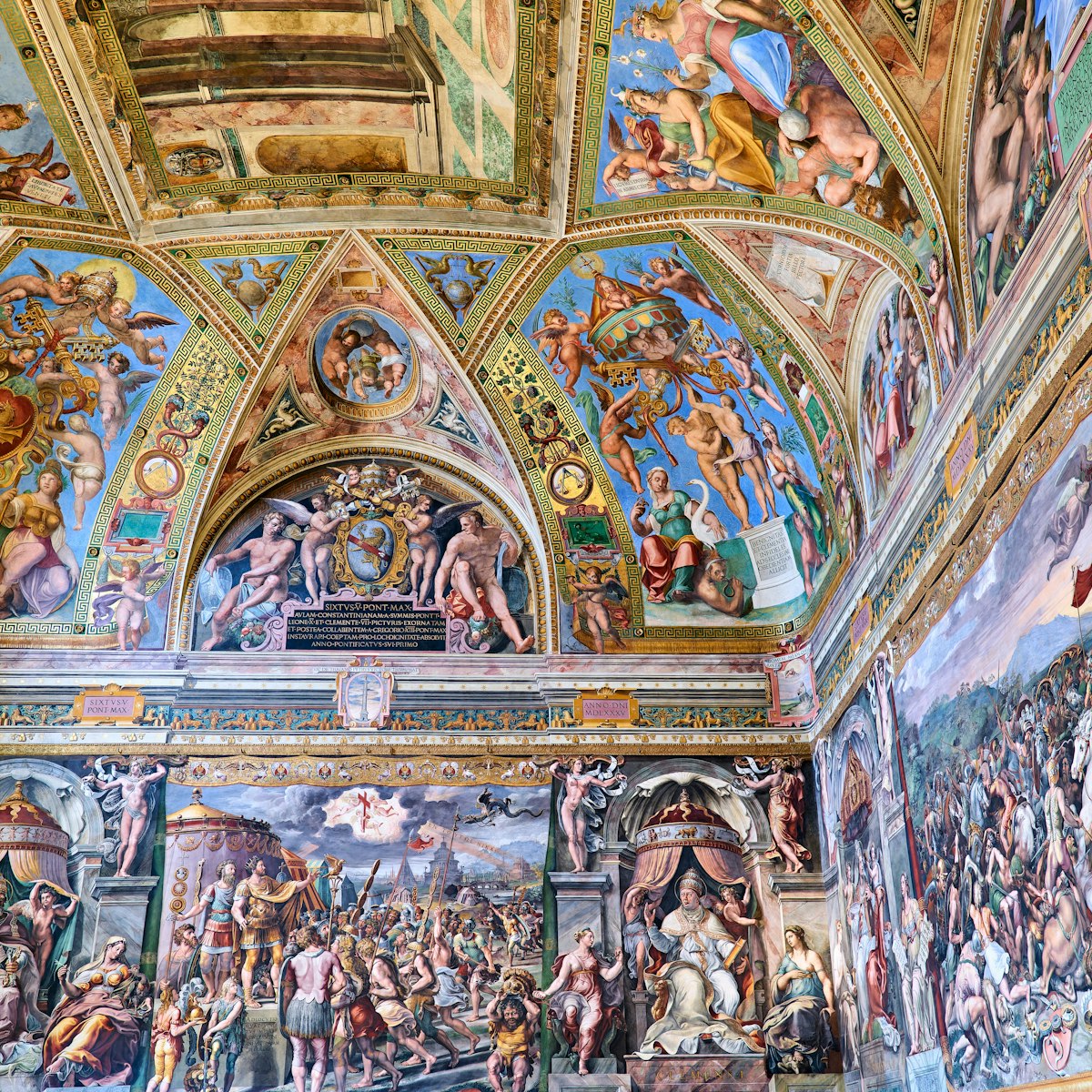
Vatican Museums
Vatican City, Borgo & Prati
Founded by Pope Julius II in the early 16th century and enlarged by successive pontiffs, the Vatican Museums boast one of the world's greatest art…
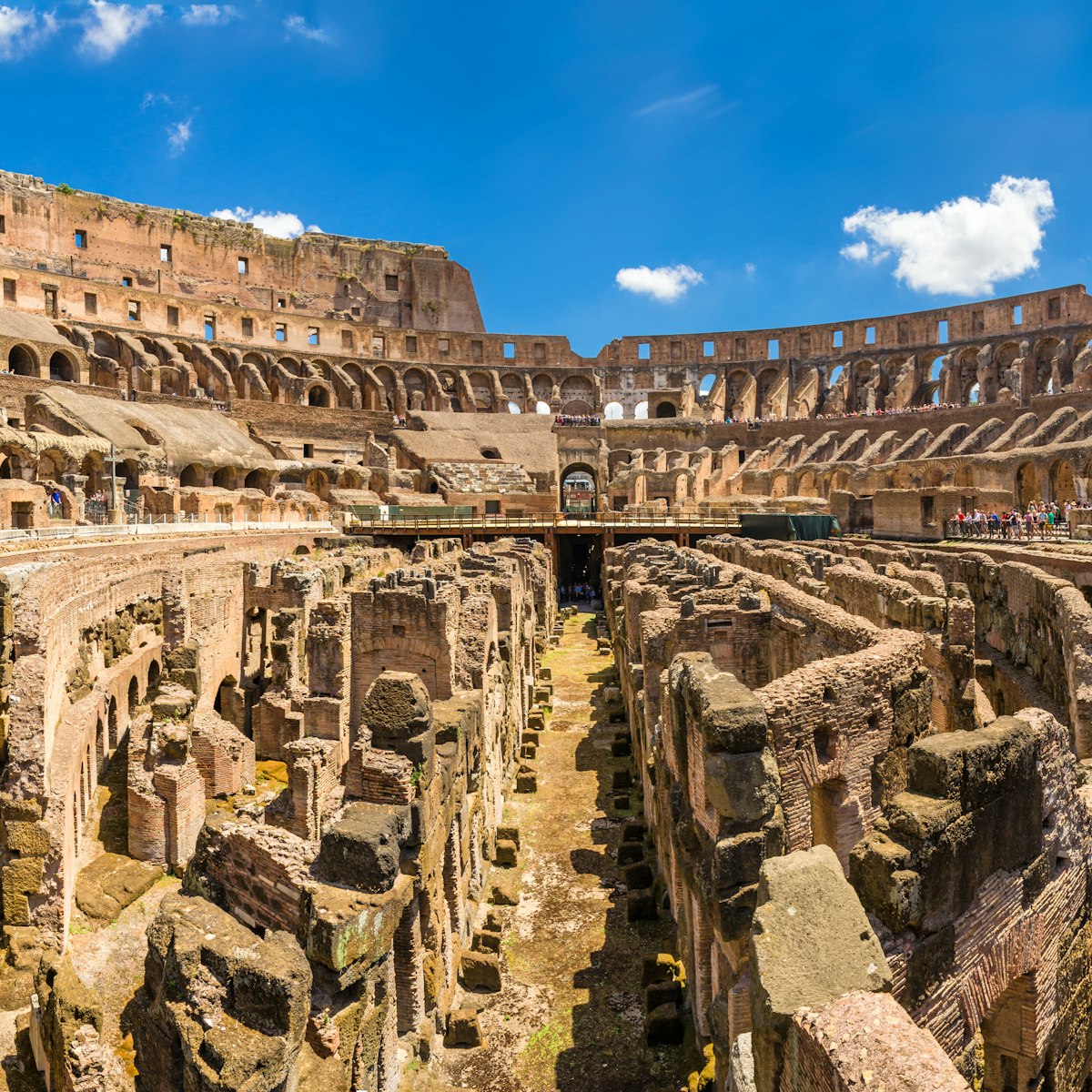
Ancient Rome
Everyone wants to see the Colosseum, and it doesn’t disappoint, especially if accompanied by tales of armored gladiators and hungry lions. More than any…
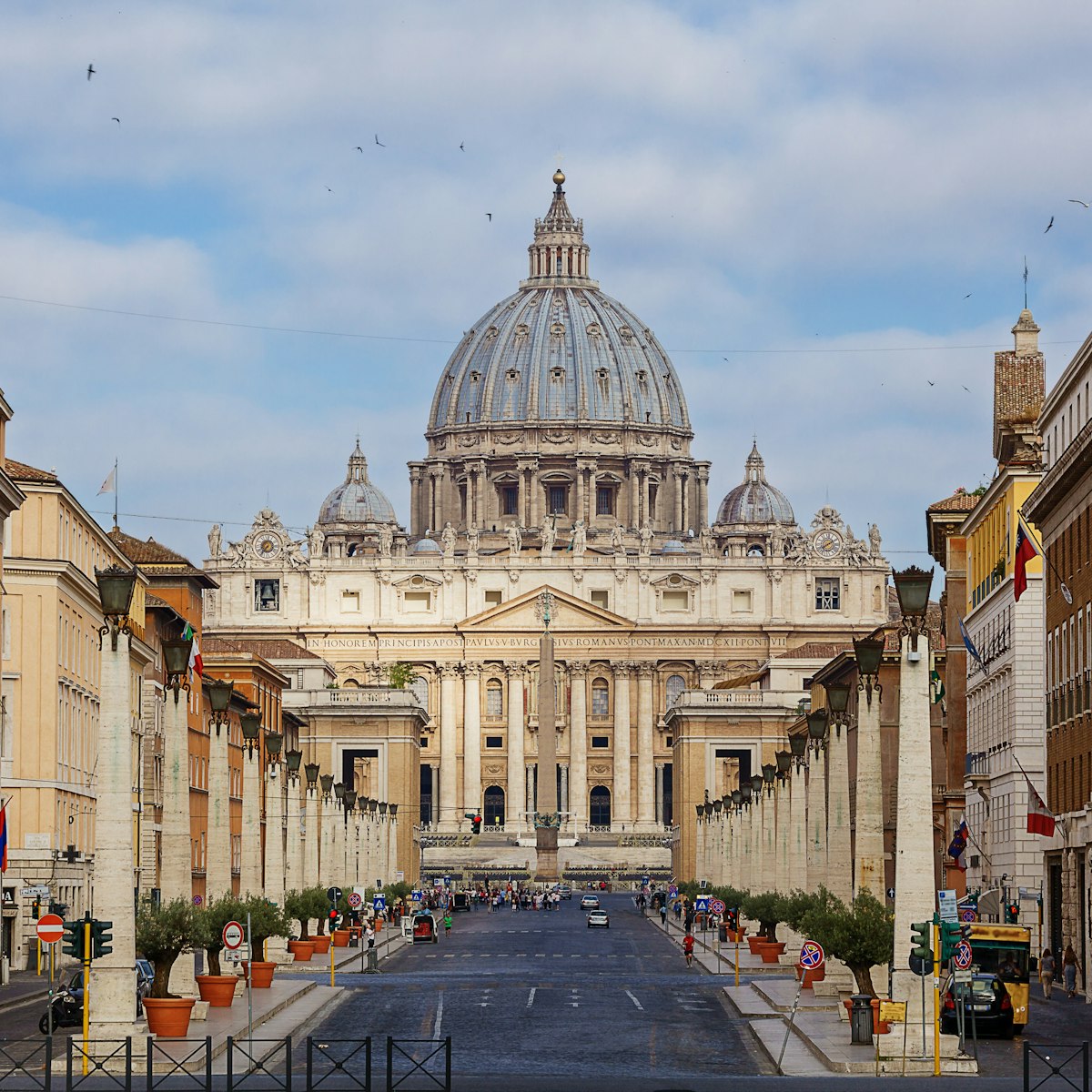
St Peter's Basilica
In the city of outstanding churches, none can hold a candle to St Peter's, Italy’s largest, richest and most spectacular basilica. Built atop a 4th…
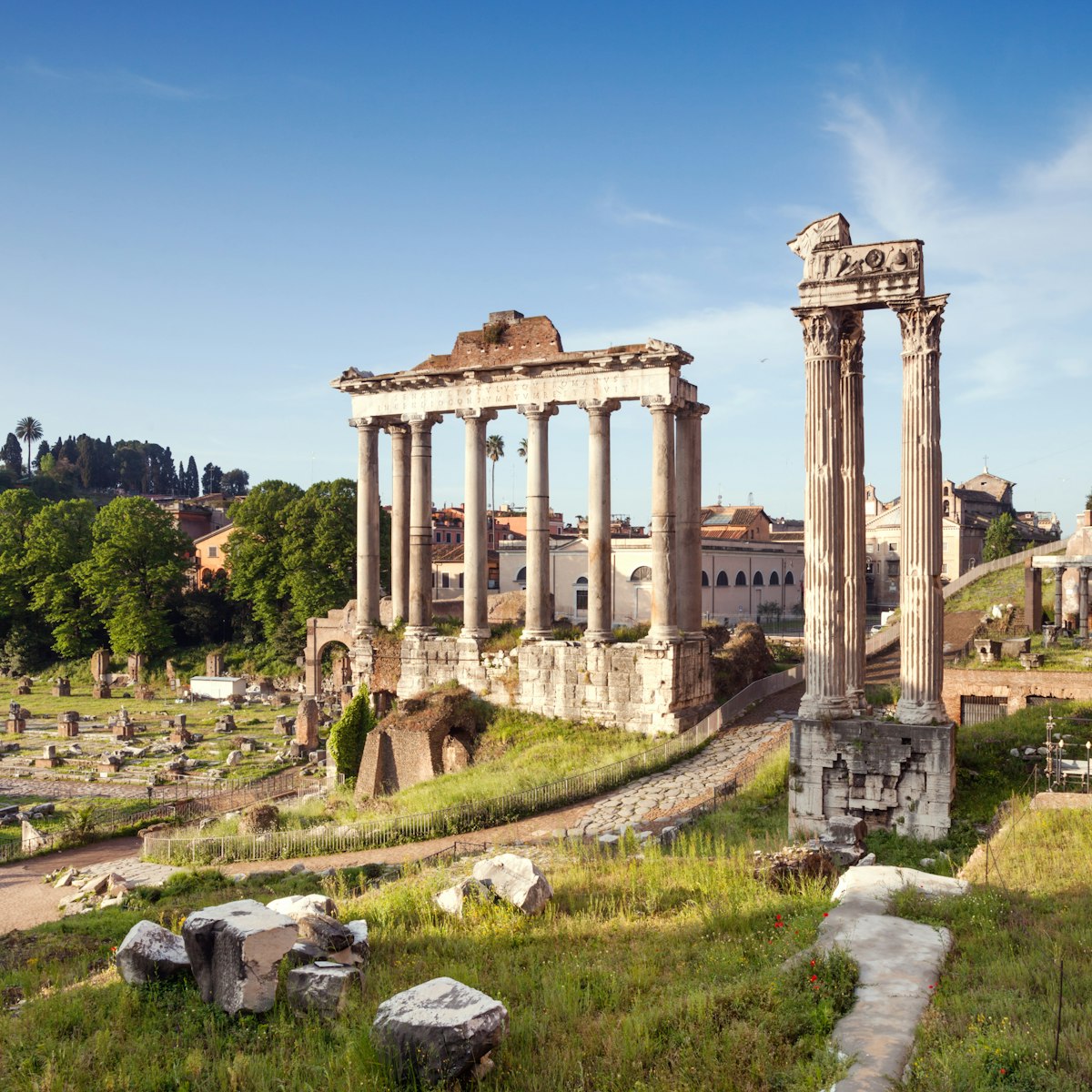
Roman Forum
An impressive – if rather confusing – sprawl of ruins, the Roman Forum was ancient Rome's showpiece center, a grandiose district of temples...

Sandwiched between the Roman Forum and the Circo Massimo, the Palatino (Palatine Hill) is one of Rome's most spectacular sights. It's a beautiful,…
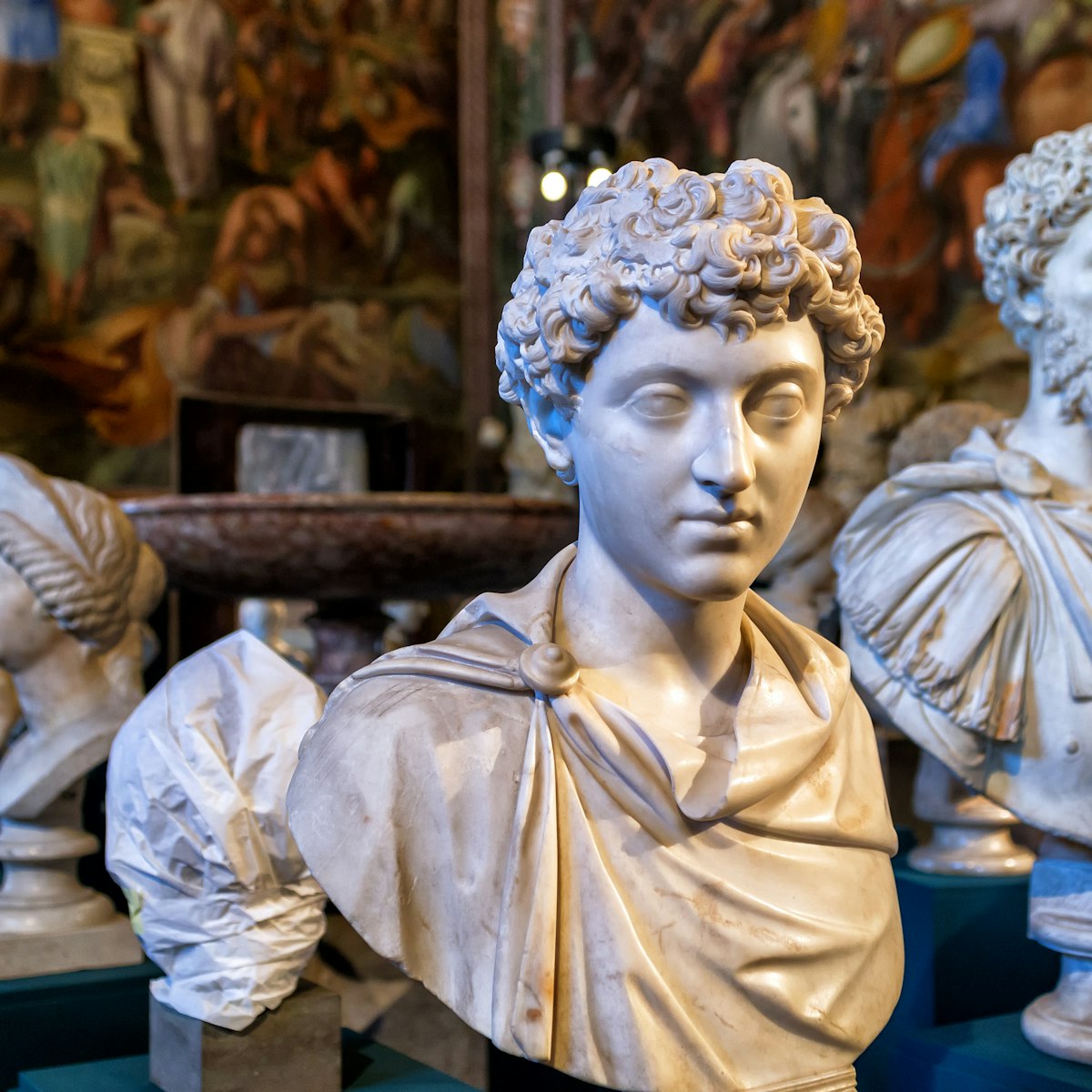
Capitoline Museums
Dating from 1471, the Capitoline Museums are the world's oldest public museums, with a fine collection of classical sculpture.
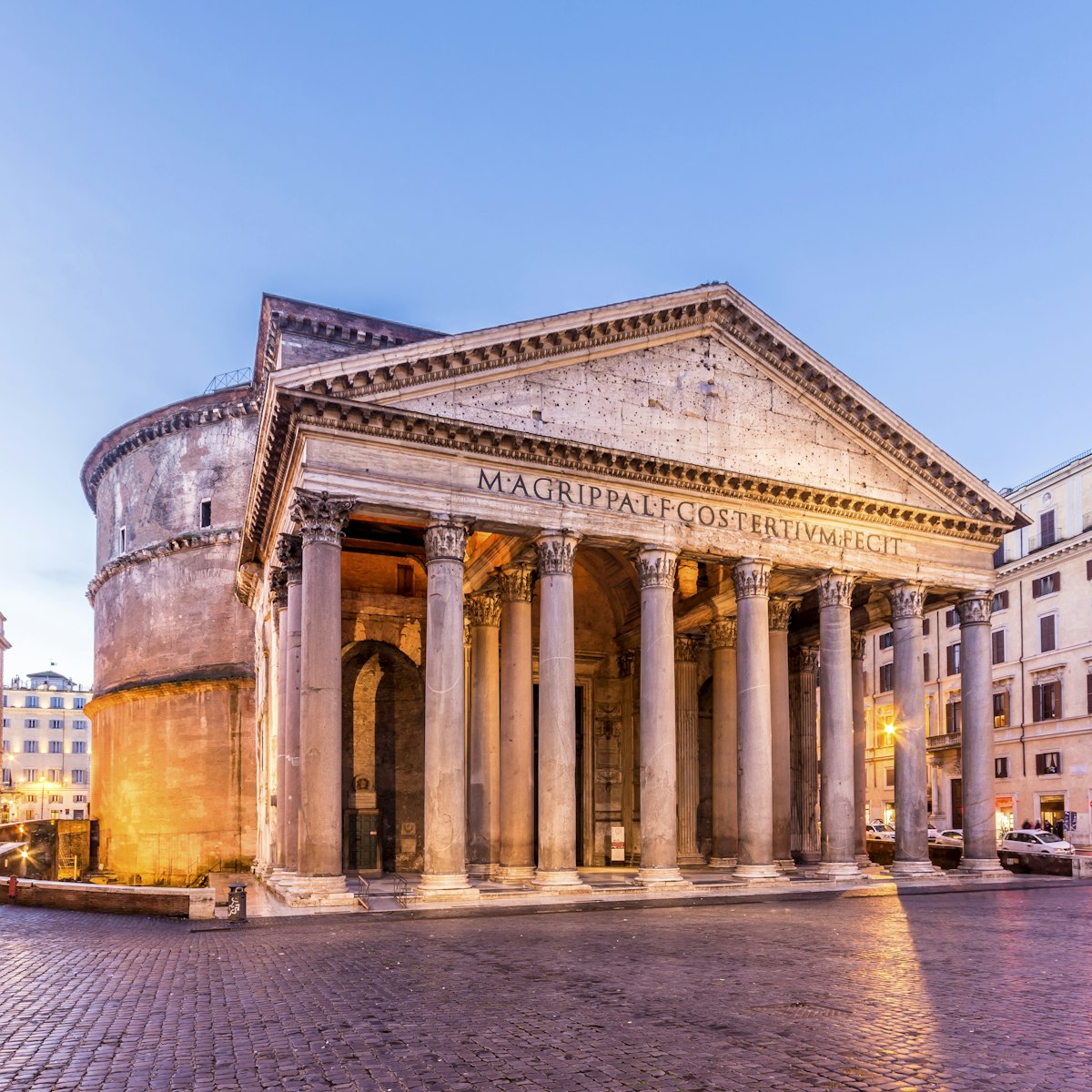
Centro Storico
With its revolutionary design, this awe-inspiring temple has served as an architectural blueprint for millennia.
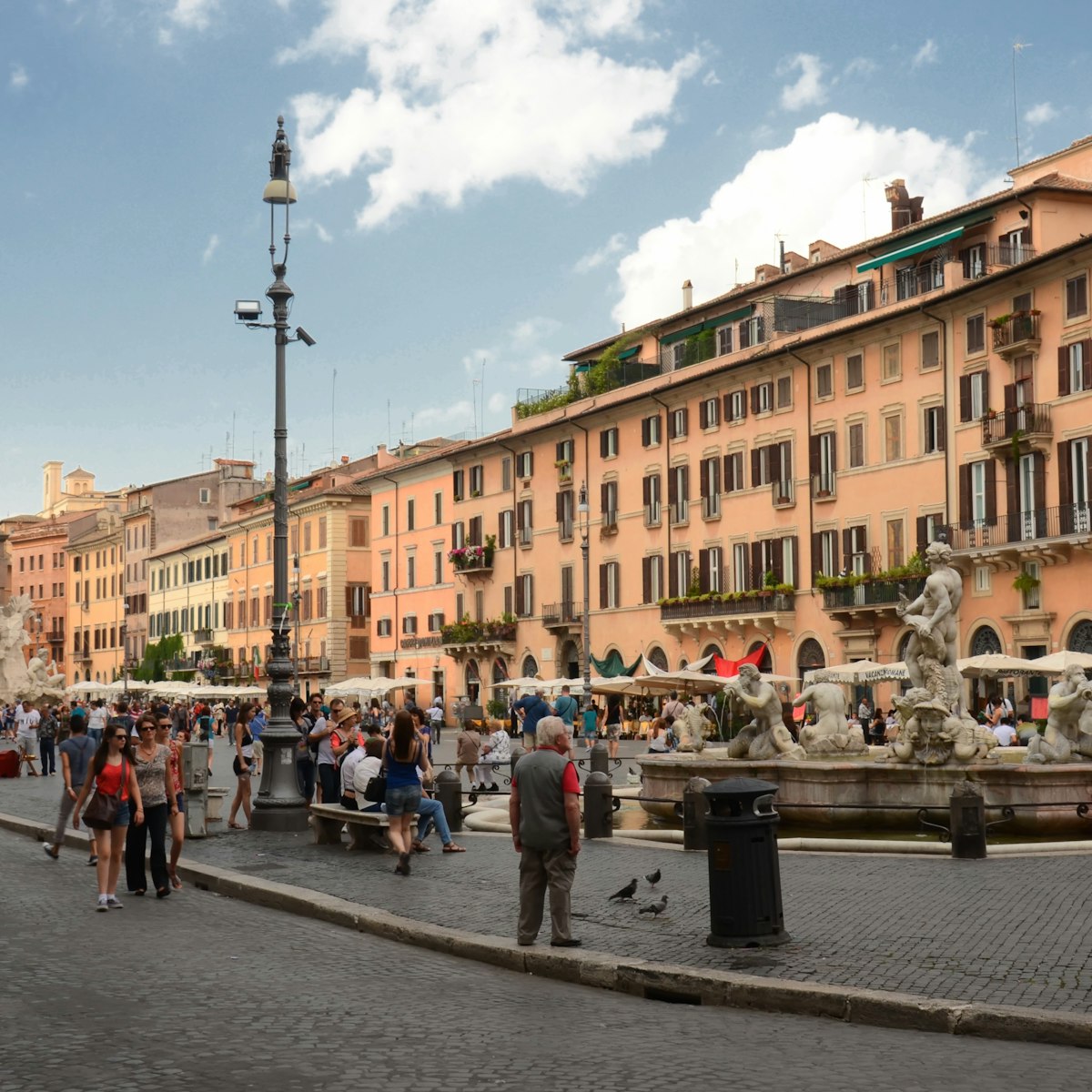
Piazza Navona
With its showy fountains, baroque palazzi and colorful cast of street artists, hawkers and tourists, Piazza Navona is central Rome’s elegant showcase…
Top picks from our travel experts
10 top things to do in rome in 2024.
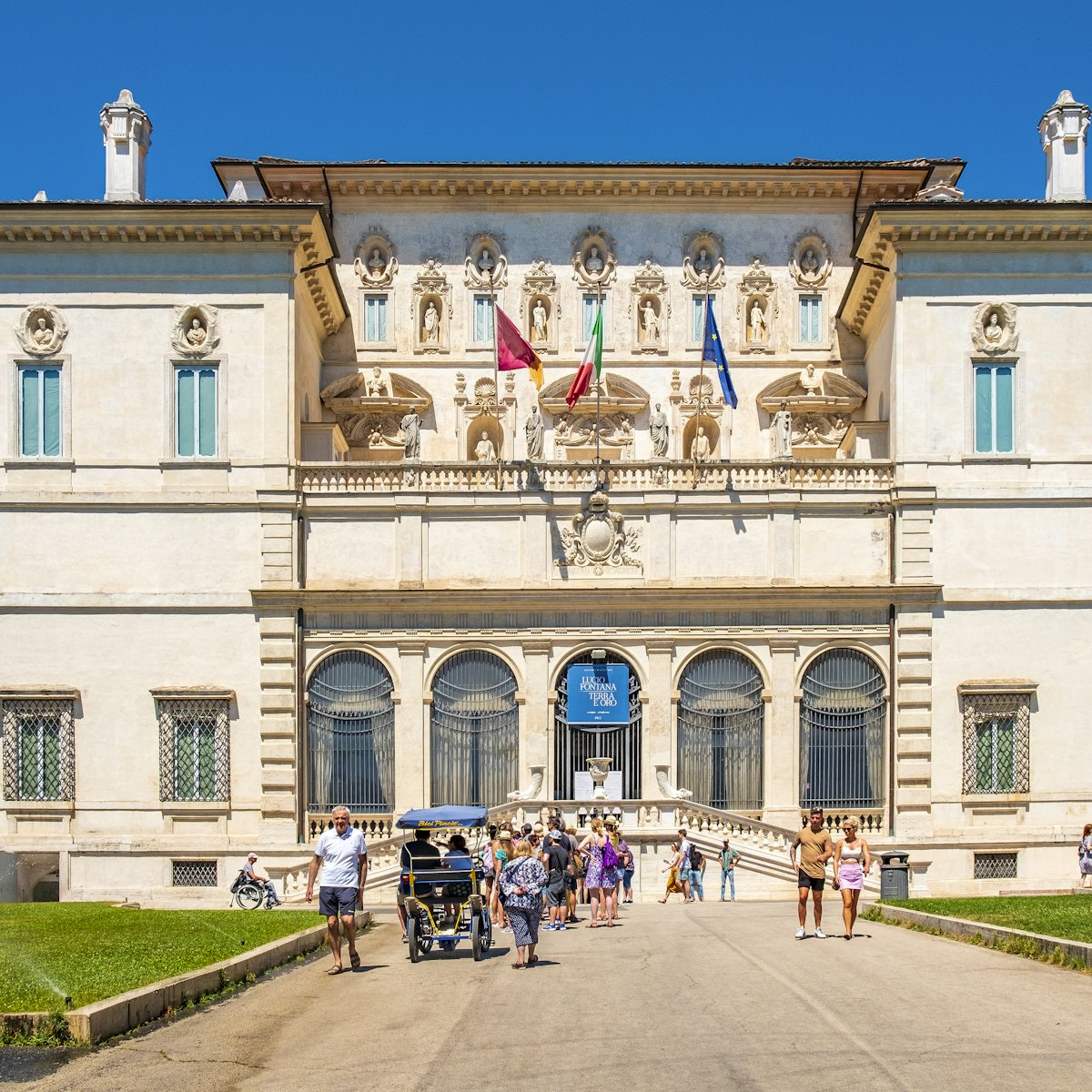
Museo e Galleria Borghese
If you only have time for one art gallery in Rome, make it the Museo e Galleria Borghese.

Circo Massimo
Now a huge basin of dusty grass, Circo Massimo was ancient Rome’s largest chariot racetrack, a 250,000-seater capable of holding up to a quarter of the…
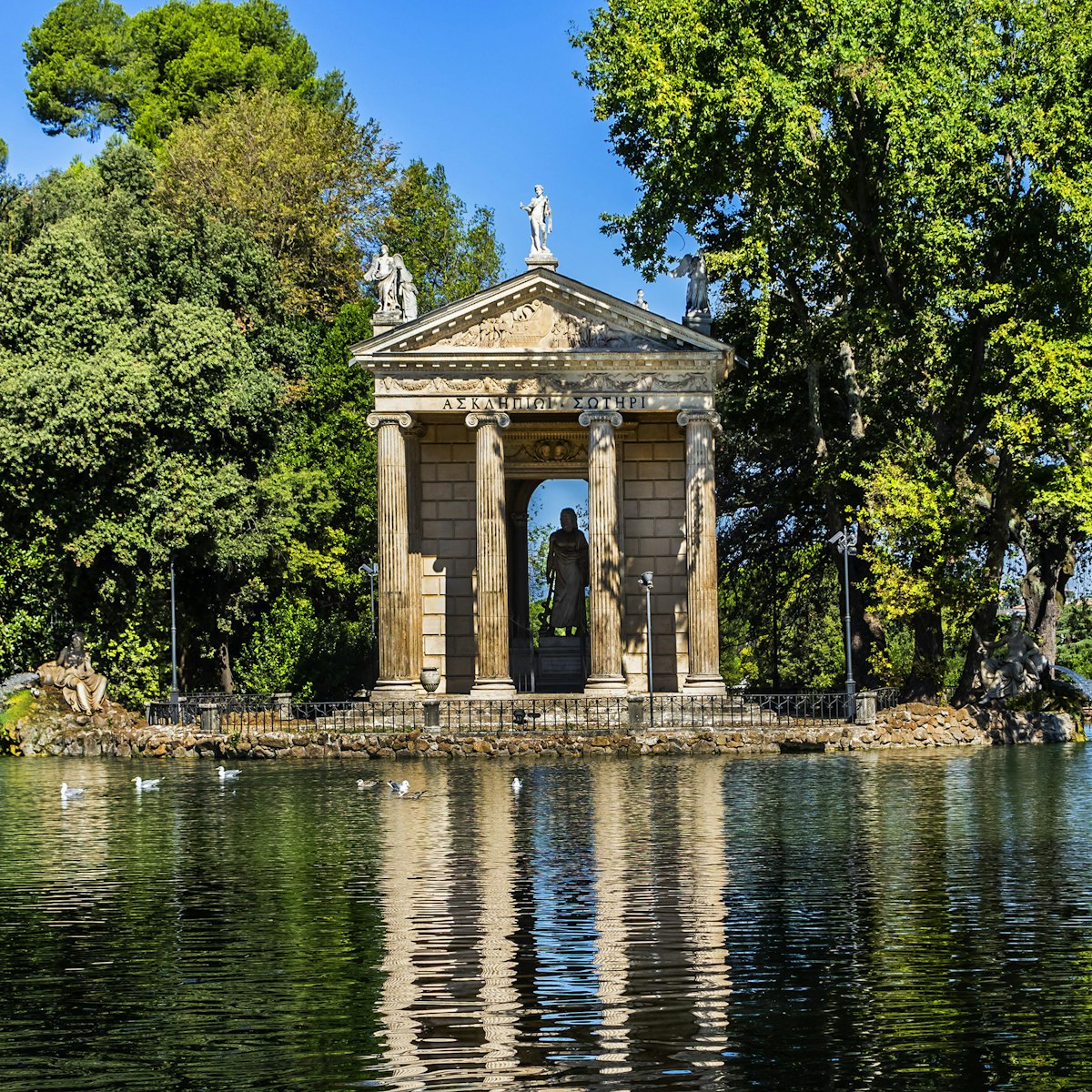
Villa Borghese
No one can resist the lure of Rome's most celebrated park, full of wooded glades, gardens and grassy banks.

Domus Aurea
Monti, Esquilino & San Lorenzo
Nero had his Domus Aurea constructed after the fire of AD 64 (which he is rumoured to have started to clear the area). Named after the gold that lined its…
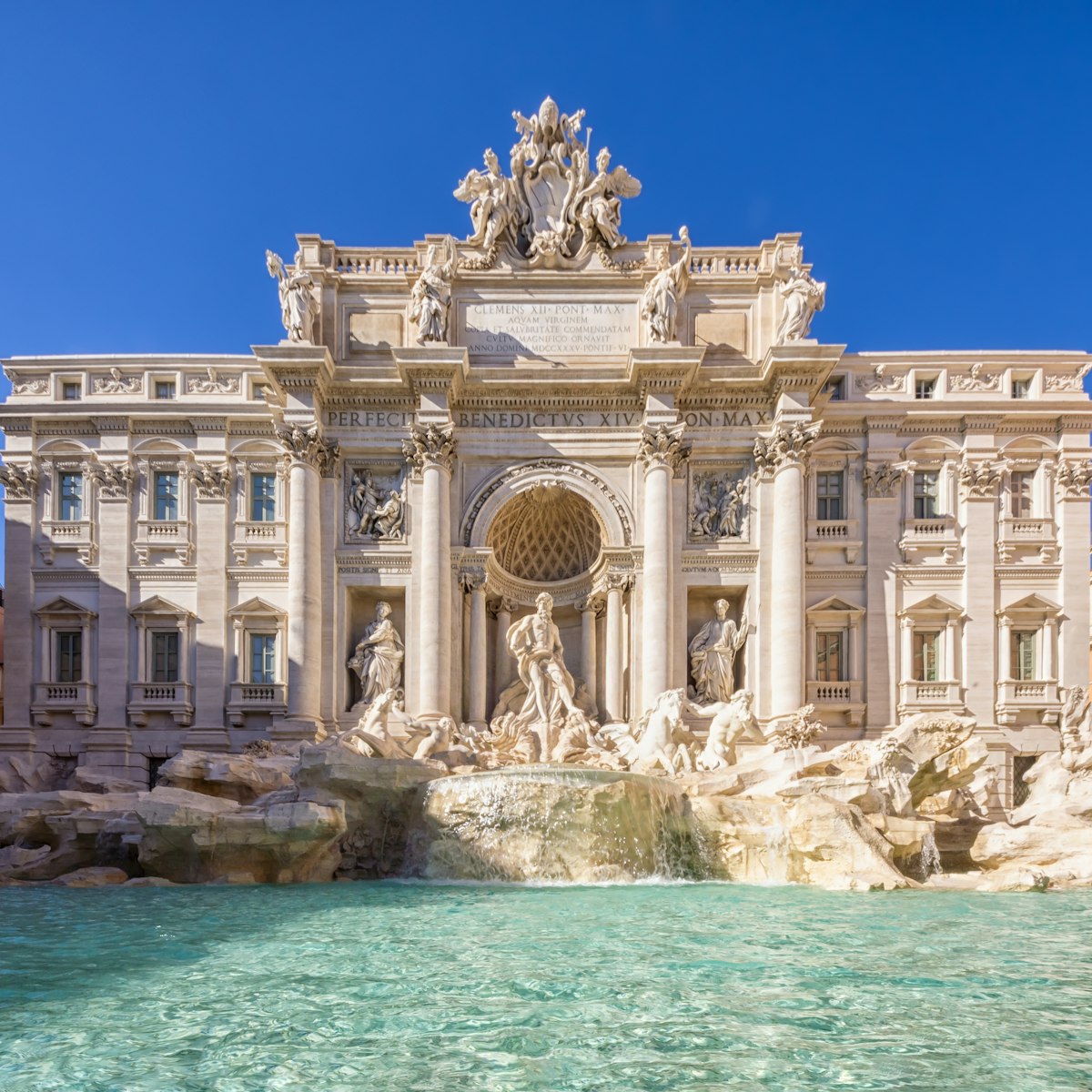
Trevi Fountain
Tridente, Trevi & the Quirinale
Don't miss a visit to Rome's iconic Fontana di Trevi, or Trevi Fountain.
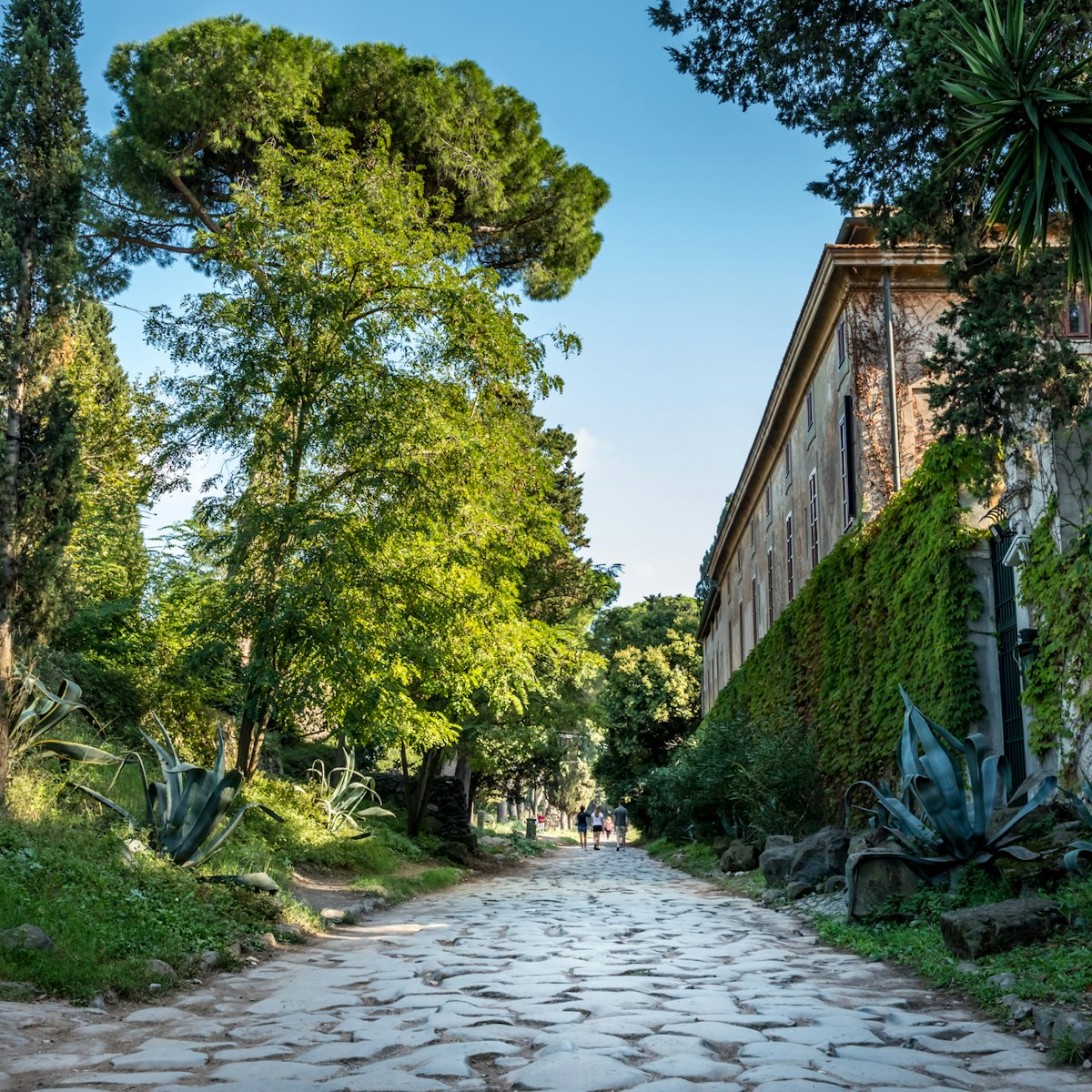
Via Appia Antica
Southern Rome
Via Appia Antica is a beautiful cobbled thoroughfare flanked by grassy fields, ancient Roman structures and towering pine trees.

Palazzo Colonna
The guided tours of this opulent palace are among the city's best, introducing visitors to the residence and art collection of the patrician Colonna…
24 free things to do in Rome
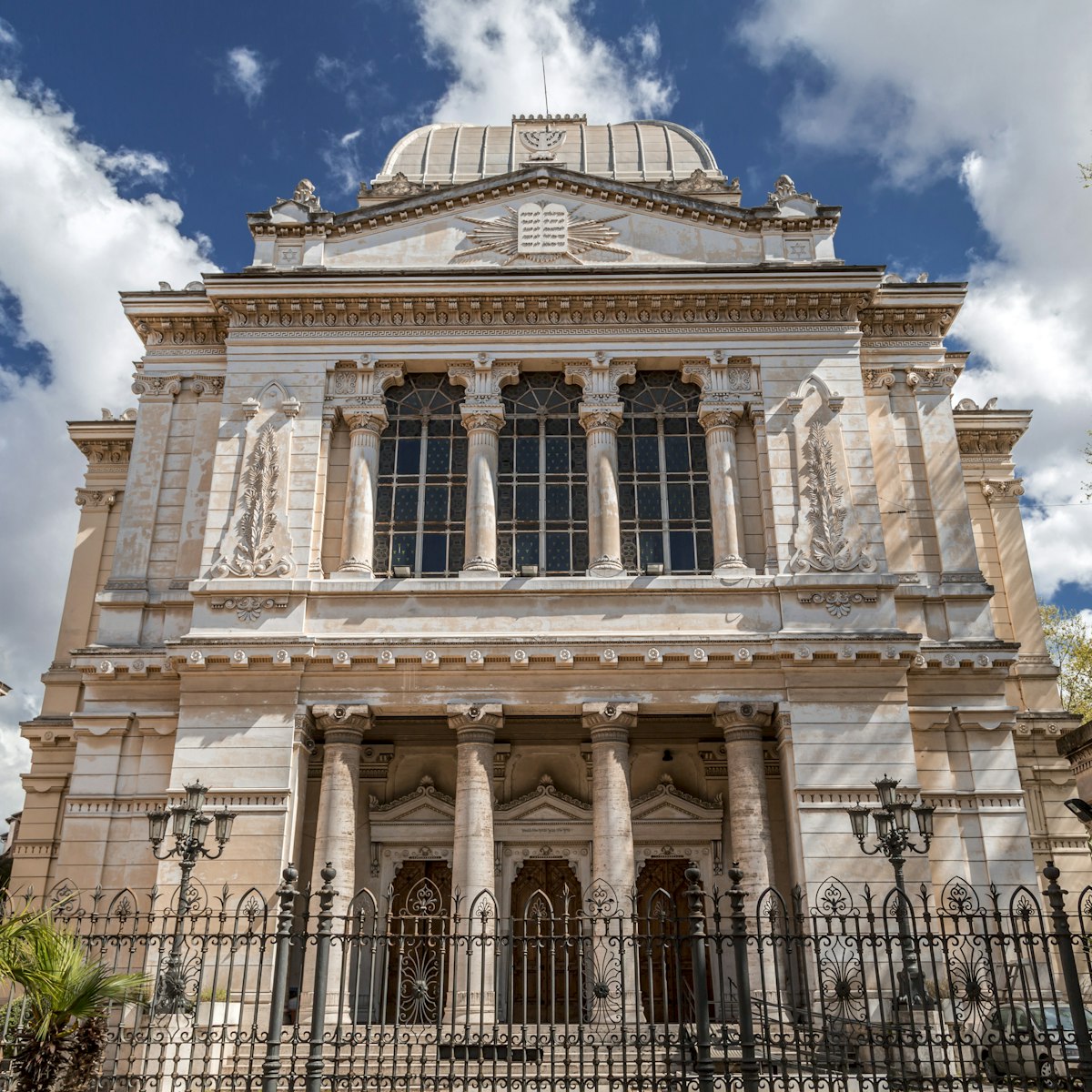
Jewish Ghetto
Visit the atmospheric Jewish Ghetto neighborhood for art studios, kosher food and Rome's main synagogue.

Piazza del Campidoglio
This hilltop piazza, designed by Michelangelo in 1538, is one of Rome's most beautiful squares. There are several approaches but the most dramatic is the…
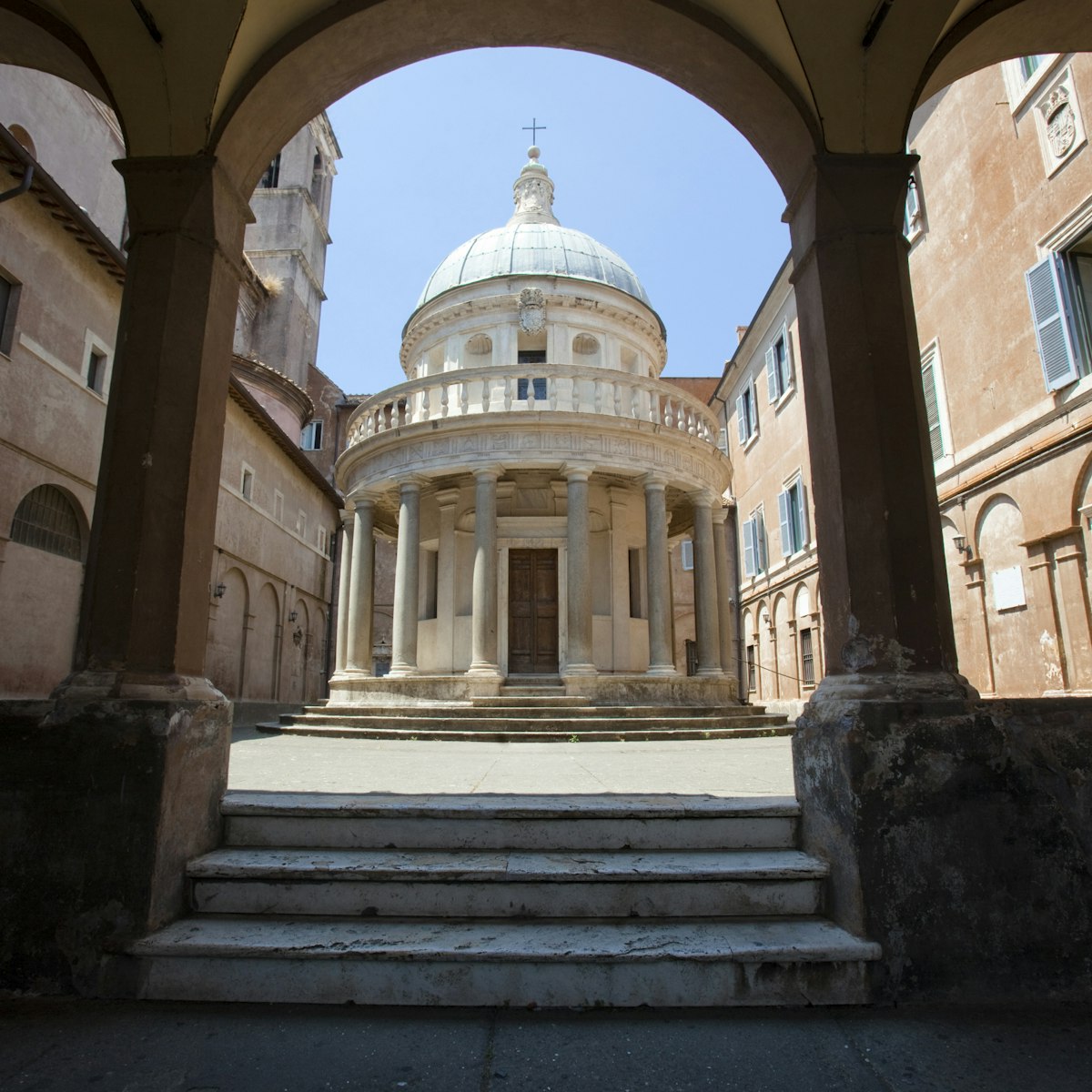
Tempietto di Bramante & Chiesa di San Pietro in Montorio
Trastevere & Gianicolo
Bramante’s sublime tempietto (Little Temple) is a perfect surprise in the courtyard of the Chiesa di San Pietro in Montorio.

Chiesa di San Luigi dei Francesi
This opulent baroque church is home to a celebrated trio of Caravaggio paintings.

Pincio Hill Gardens
One of Rome's best viewpoints, Pincio Hill is worth the climb.
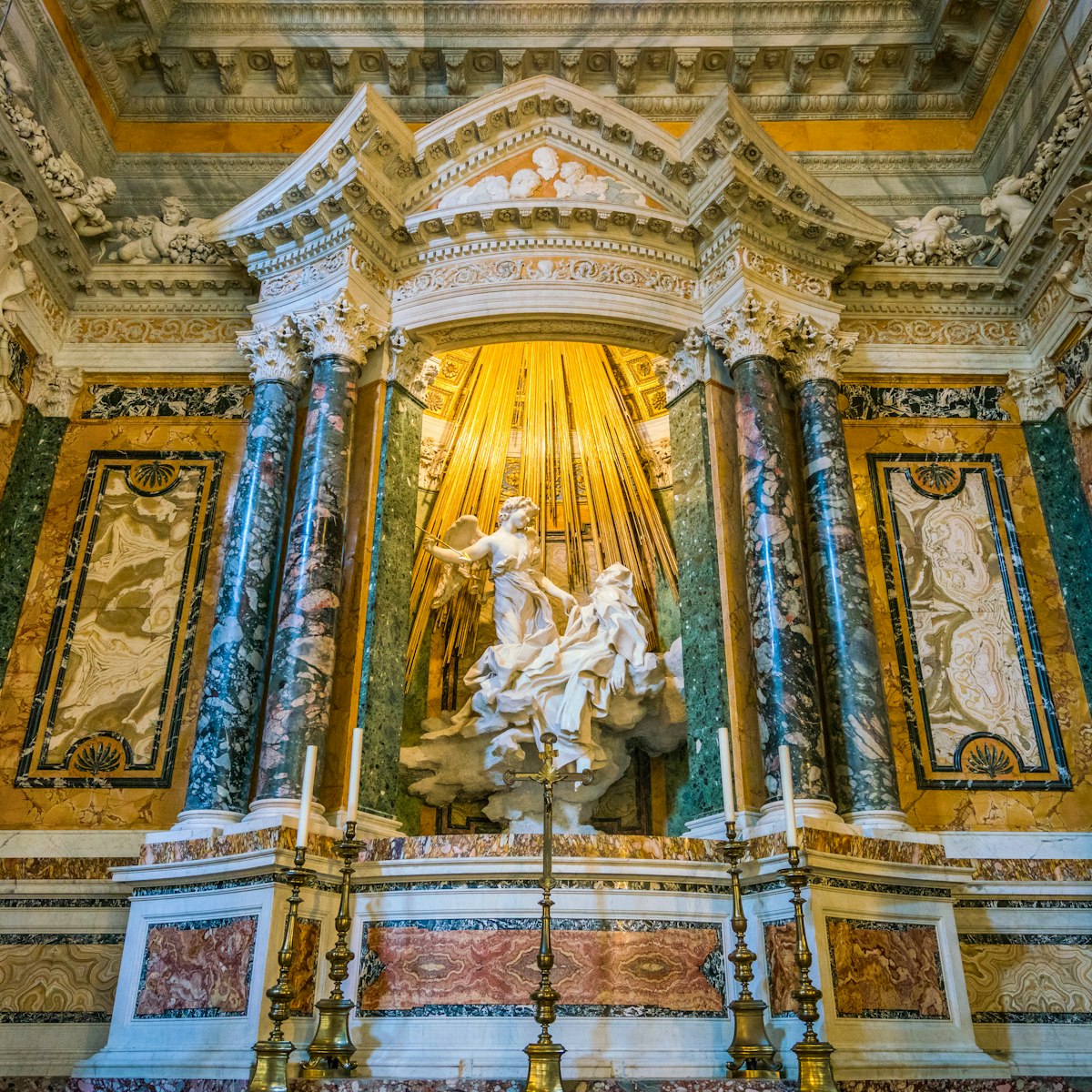
Chiesa di Santa Maria della Vittoria
This modest church is an unlikely setting for an extraordinary work of art – Bernini’s extravagant sculpture, the Ecstacy of St Teresa.
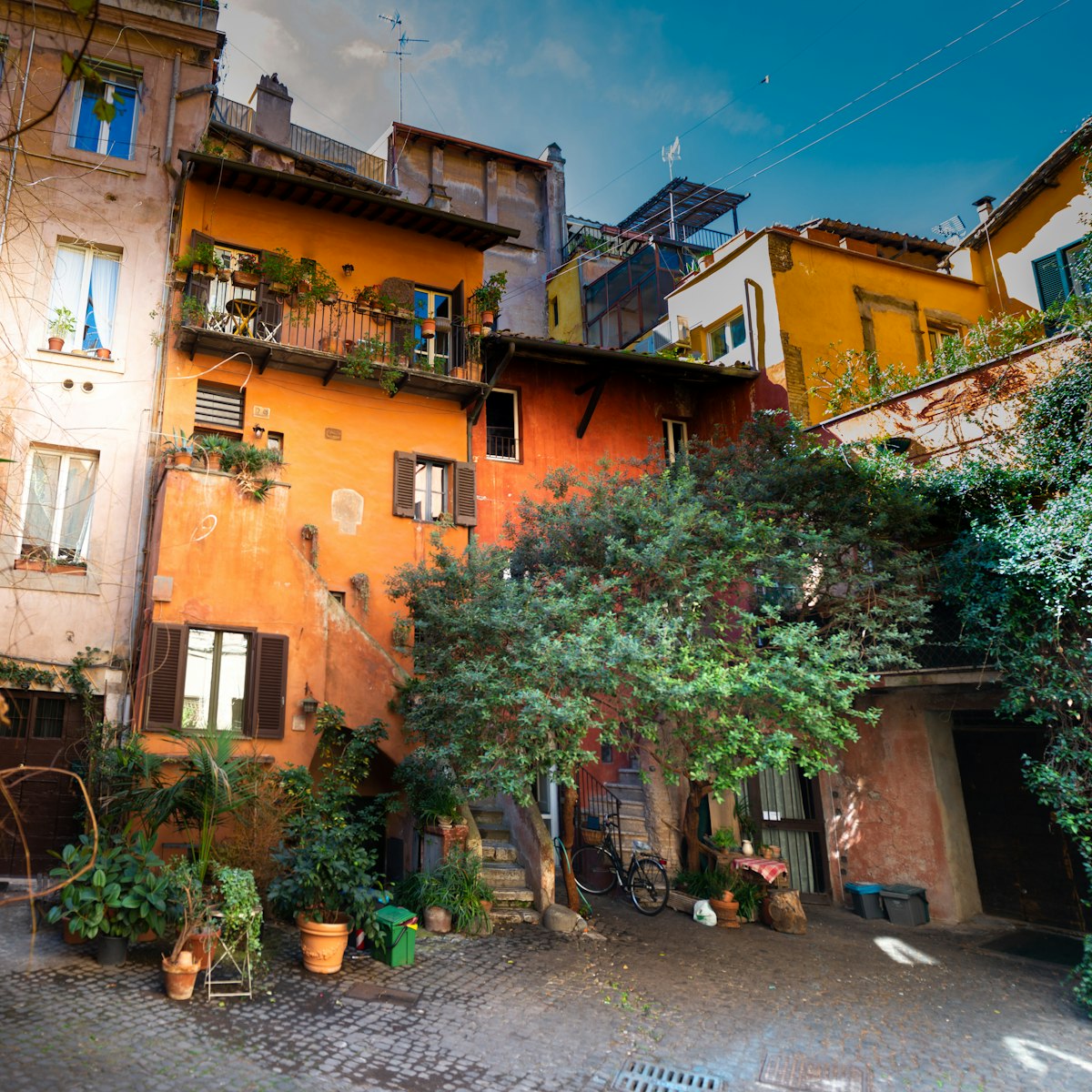
Arco degli Acetari
For one of Rome’s most picture-perfect scenes, head to this dark archway just off Campo de’ Fiori. The arch in itself isn’t especially memorable...

Giardino del Lago
Designed and laid out in the late 18th century, this leafy area is centred on a small, romantic lake where you can hire a rowing boat. The highlight,…
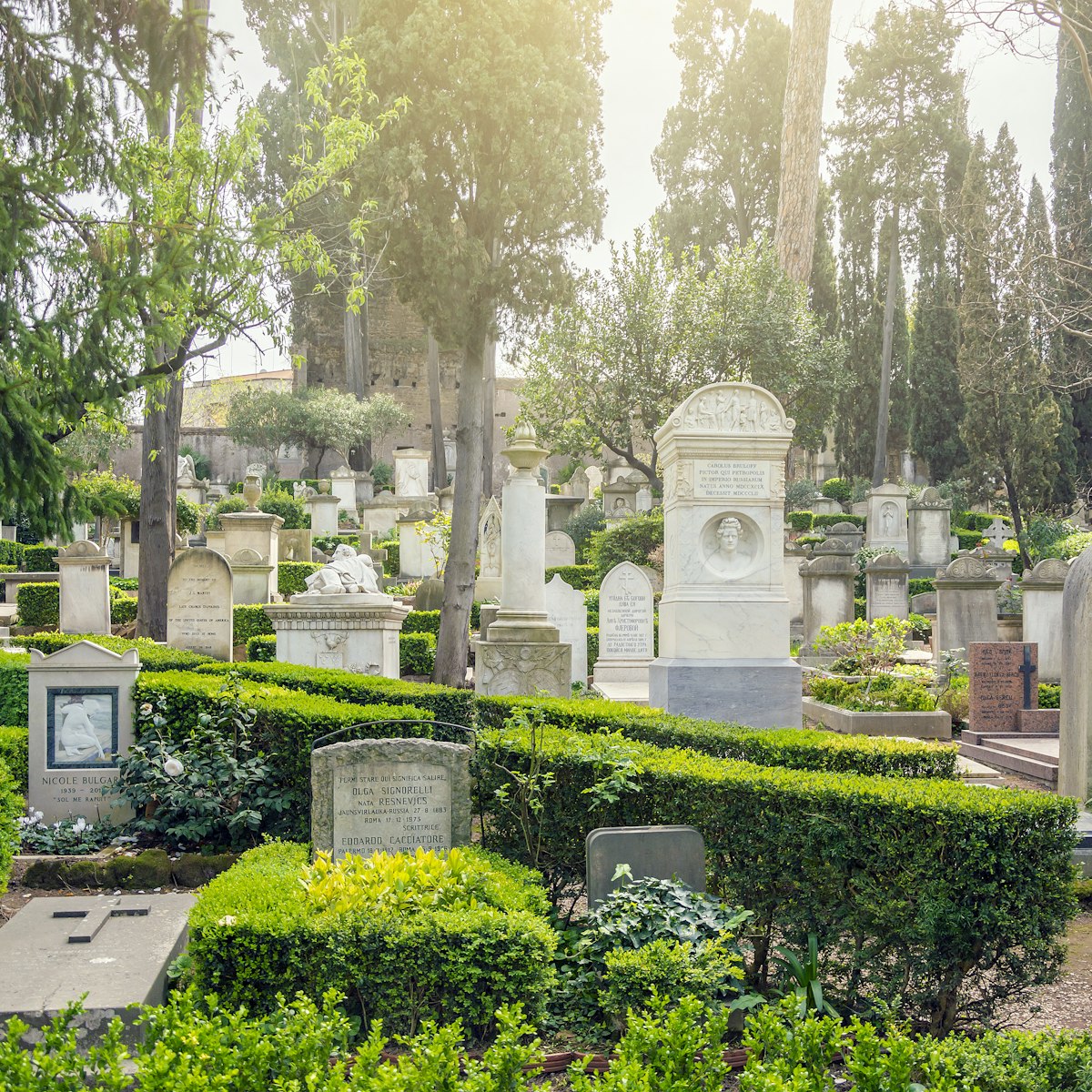
Cimitero Acattolico per gli Stranieri
San Giovanni & Testaccio
Despite the roads that surround it, Rome’s 'non-Catholic' cemetery is a verdant oasis of peace. An air of Grand Tour romance hangs over the site where up…
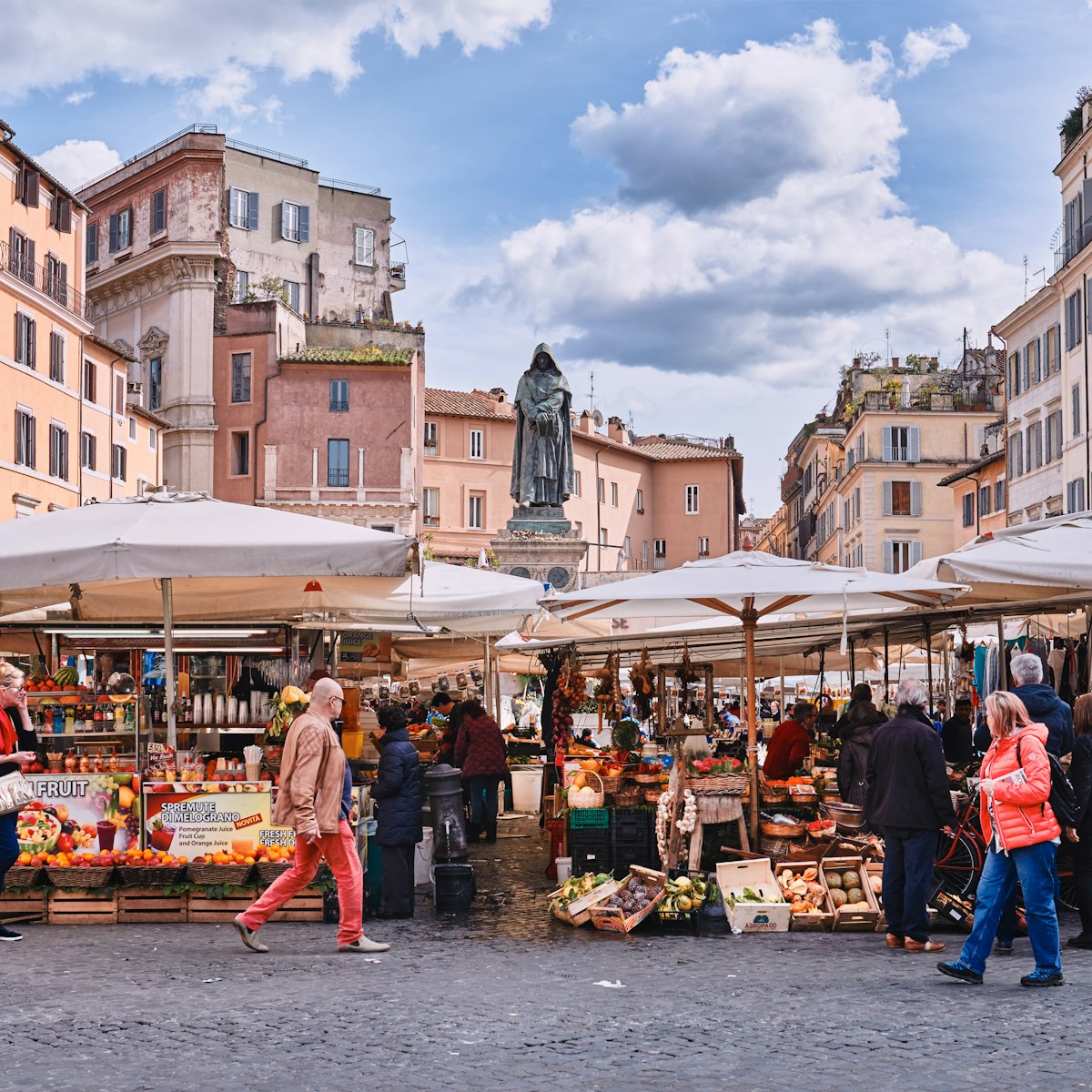
Campo de' Fiori
Il Campo is a major focus of Roman life: by day it hosts one of the city's best-known markets; by night, people come for its lively bars and restaurants.
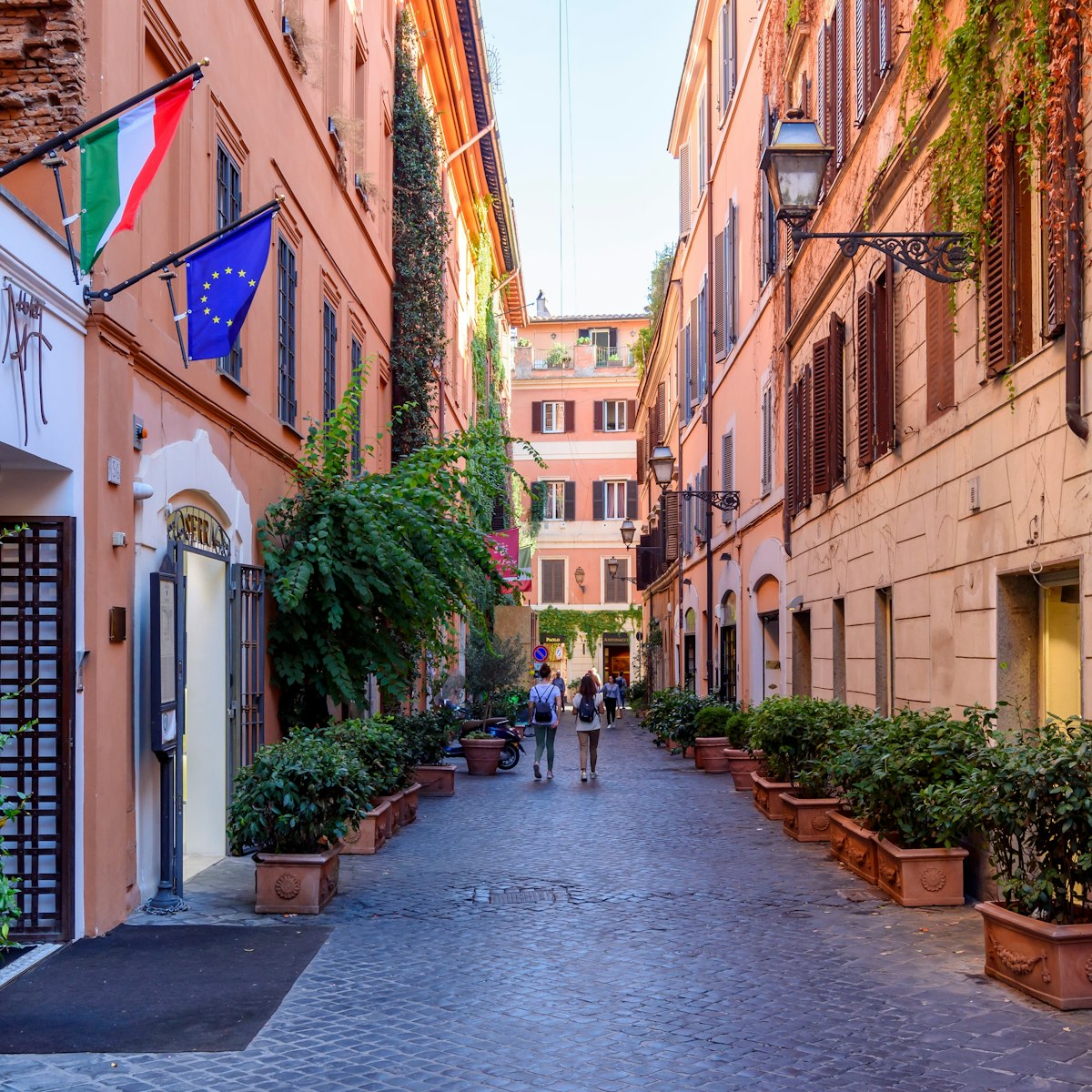
Via Margutta
Visit the antique shops, commercial art galleries and artisanal boutiques of Via Margutta, one of Rome's prettiest pedestrian cobbled lanes.
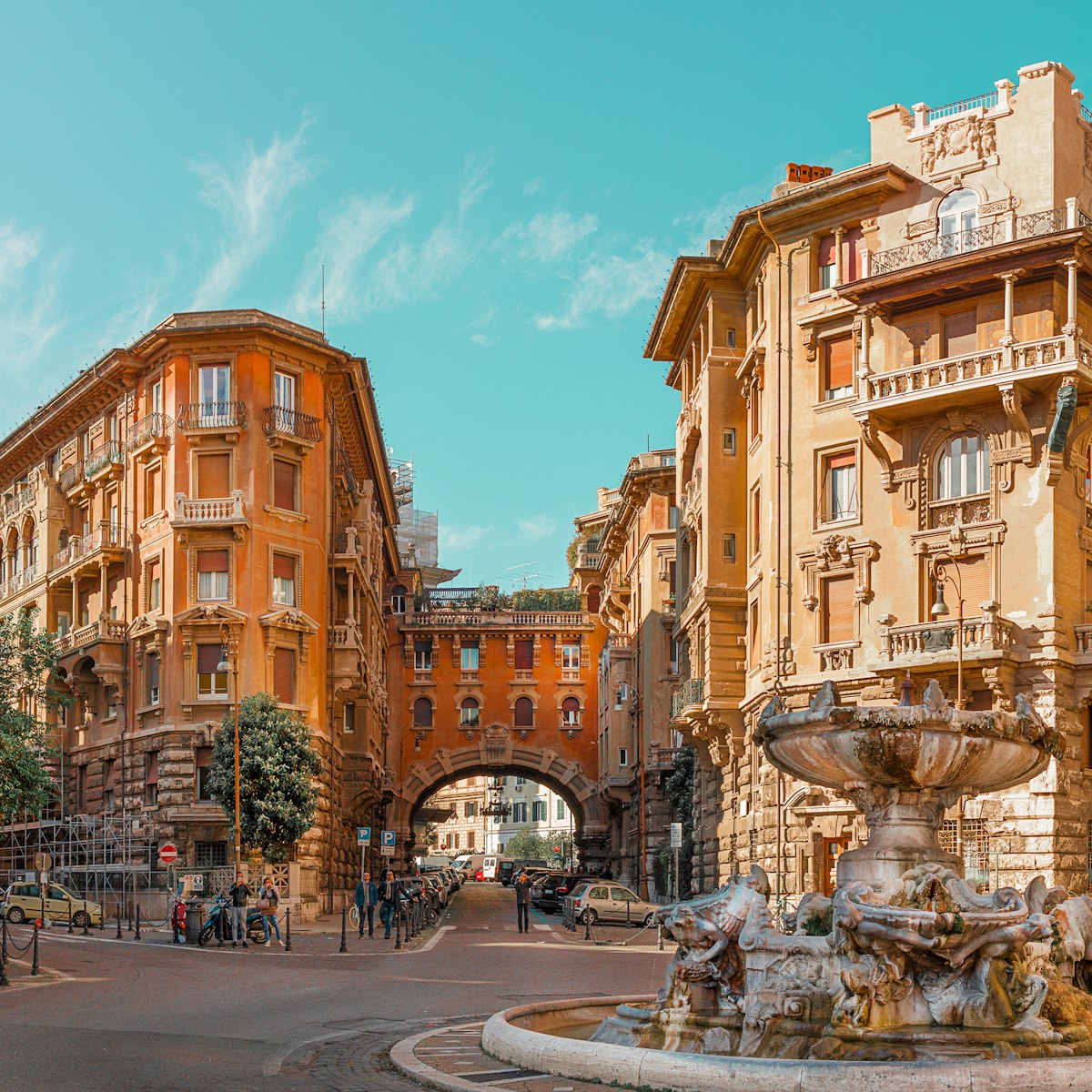
Quartiere Coppedè
The compact Quartiere Coppedè, centering around the magnificent Piazza Mincio, is one of Rome's most extraordinary neighbourhoods. Conceived and built by…
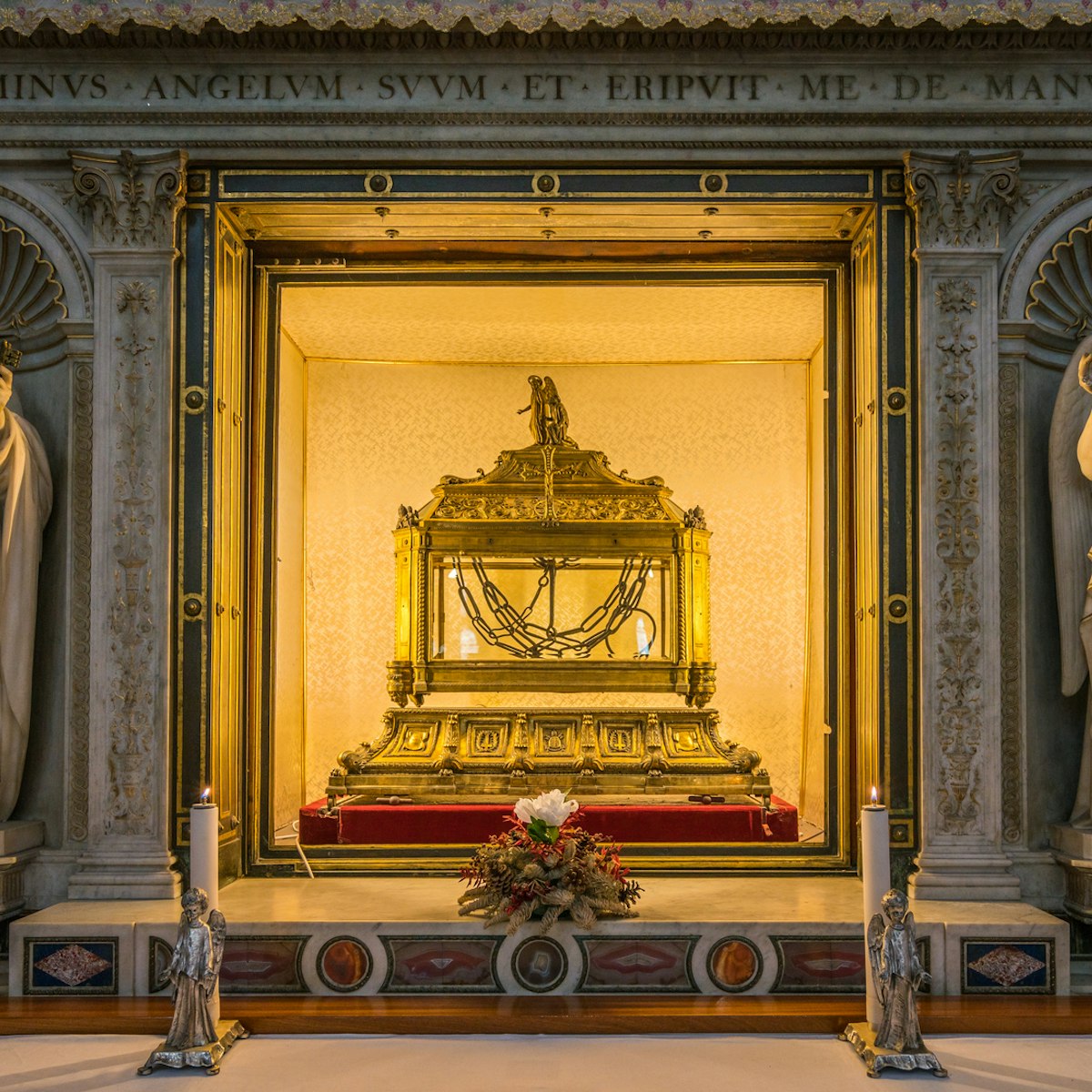
Basilica di San Pietro in Vincoli
This 5th-century basilica draws pilgrims and art lovers to marvel at its treasures.
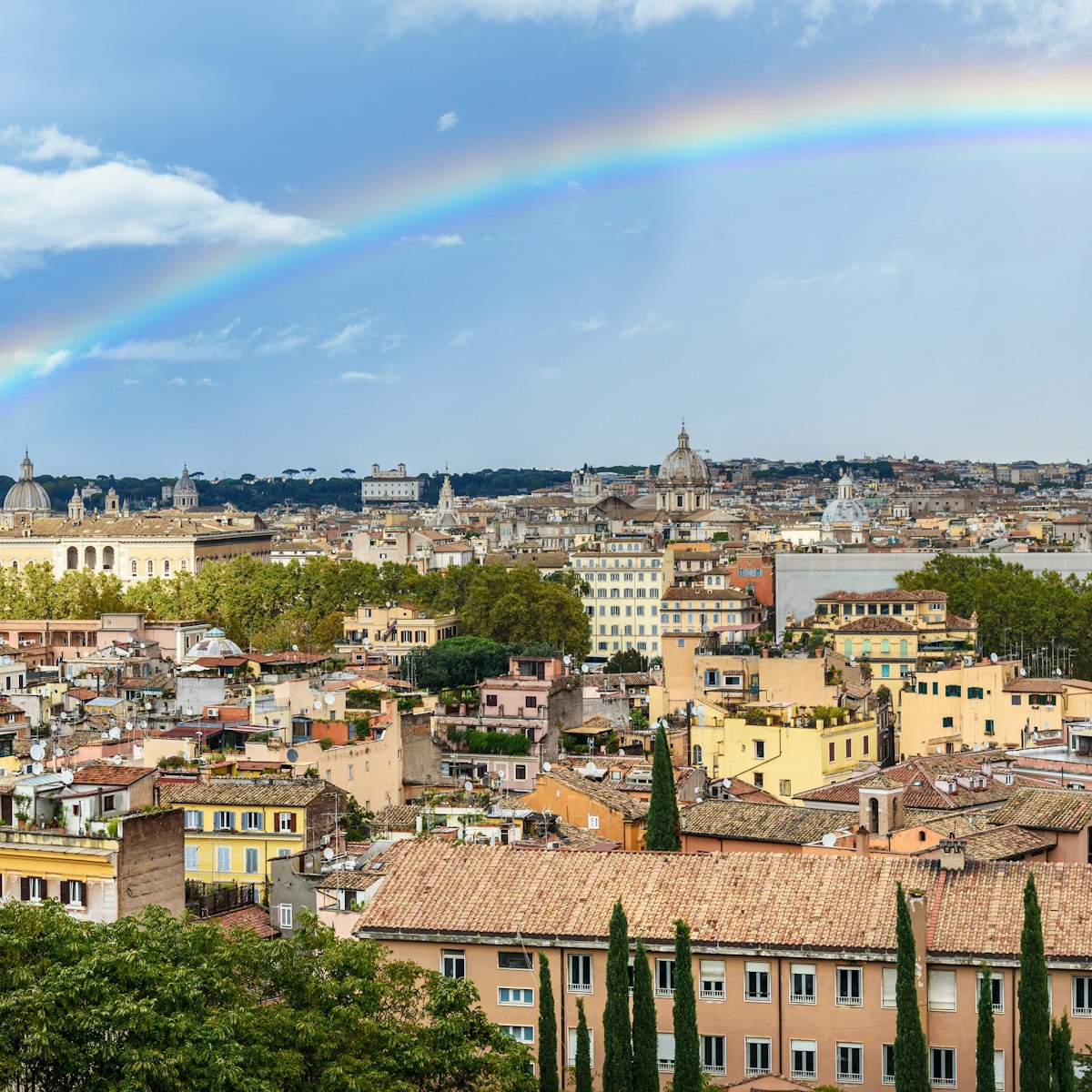
Explore monuments, fountains and gardens on the verdant hill of Gianicolo (or Janiculum).
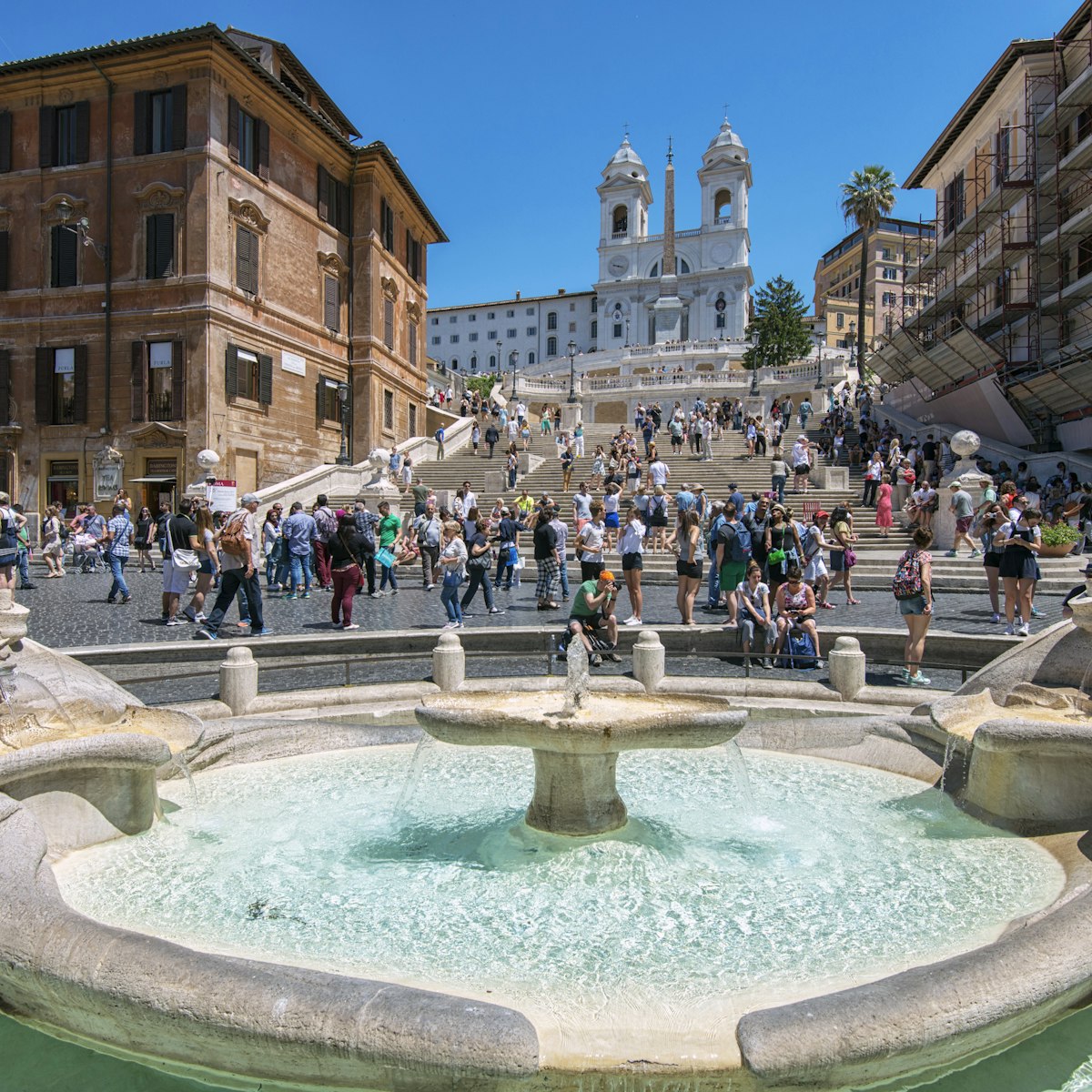
Piazza di Spagna & the Spanish Steps
The Spanish Steps are the perfect place for some people watching and great views over Rome.

Fontana dei Quattro Fiumi
Piazza Navona's flamboyant centrepiece, Gian Lorenzo Bernini’s Fontana dei Quattro Fiumi is an ornate, showy work. Completed in 1651, it features a…

The most dramatic approach to Piazza del Campidoglio is via this graceful staircase from Piazza d'Aracoeli. Designed by Michelangelo, it was built with…

Villa del Priorato di Malta
Fronting an ornate cypress-shaded piazza, the Roman headquarters of the Sovereign Order of Malta, aka the Cavalieri di Malta (Knights of Malta), boasts…

Chiesa della Trinità dei Monti
Sitting in majesty above the Spanish Steps, this landmark church was commissioned by King Louis XII of France and consecrated in 1585. Apart from the…

Imperial Forums
The forums of Trajan, Augustus, Nerva and Caesar are known collectively as the Imperial Forums. They were largely buried when Mussolini bulldozed Via dei…
Planning Tools
Expert guidance to help you plan your trip.
Things to Know
Rome is a sensory overload in the best way but that can also make it overwhelming for first-time visitors. Here's what you need to know before you go.
Best Neighborhoods
A trip to Rome is as much about lapping up the dolce vita lifestyle as gorging on art and culture. Here's a look at the city's top neighborhoods.
From Rome's surrounding Lazio region to Florence, Naples and Pompeii, amazing sights are all within day-trip range of Italy’s capital.
Money and Costs
There’s no need for the Eternal City to leave you eternally broke. The city offers myriad ways to visit in style while saving money.
Transportation
Find your way around in Rome with this guide to transportation and tickets.
Free Things to Do
Visiting Rome on a budget? These are the best free experiences in Italy's capital city.
Traveling with Kids
From the Colosseum to the catacombs, and sprawling parks to virtual time travel, Rome promises a memorable trip for the whole family.
Discover architectural jewelry, local design, vintage finds, and tiny treasures in Rome's independent shops and markets.
Plan with a local
Experience the real Italy
Let a local expert craft your dream trip.

Latest stories from Rome
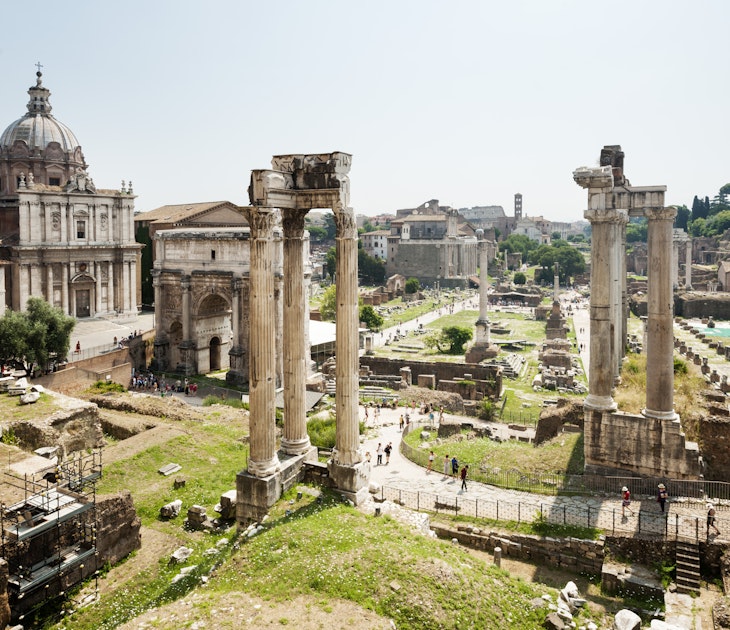
Apr 19, 2024 • 4 min read
A new walkway will make it easier to navigate Rome's ancient sites. But what does it mean for the locals?
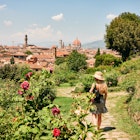
Mar 27, 2024 • 5 min read

Mar 15, 2024 • 10 min read
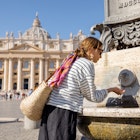
Feb 29, 2024 • 13 min read

Feb 27, 2024 • 9 min read
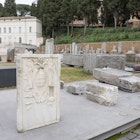
Jan 15, 2024 • 3 min read
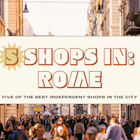
Jan 3, 2024 • 4 min read
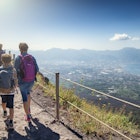
Dec 13, 2023 • 10 min read
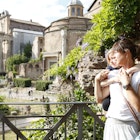
Oct 18, 2023 • 9 min read
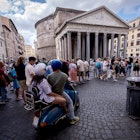
Jul 7, 2023 • 2 min read
in partnership with getyourguide
Book popular activities in Rome
Purchase our award-winning guidebooks.
Get to the heart of Rome with one of our in-depth, award-winning guidebooks, covering maps, itineraries, and expert guidance.
Rome and beyond
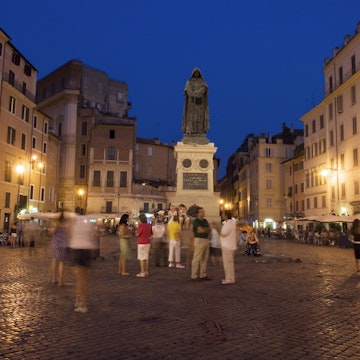

Rome was called the “ Eternal City ” by the ancient Romans because they believed that no matter what happened in the rest of the world, the city of Rome would always remain standing . Exploring the city center by foot surrounded by glorious monuments and colossal remains takes you back in time to the “glory that was Rome”.
Rome Travel Guide
- General Information
- Top Attractions
- Getting to Rome
- Public Transport
- Money-saving tips
- Where to Eat
- Where to Stay
- 3-Day Itinerary
Why visit Rome?
With its unparalleled history, Rome is the third most visited city in Europe and the fourteenth worldwide. It attracts visitors from all over the world who are impatient to discover the city’s impressive monuments and archaeological sites ; not to mention its renowned cuisine and its lively atmosphere.
When exploring the Colosseum , visitors will easily imagine how the gladiators fought for their lives in the arena, cheered by the crowd. In the Circus Maximus , travelers will picture the chariots crashing into each other in order to be first in the race, and in the Roman Forum visualize what the Roman public life was like.
Looking for accommodation?
If you haven’t booked your accommodation yet, we suggest visiting our search engine , where you’ll find all types of hotels, hostels, and apartments with the best rates guaranteed . You can get up to a 75% discount and pay once you get to your destination.
- Accommodation in Rome - find the best deals
top activities
Vatican Museums & Sistine Chapel Guided Tour Skip the endless queues for the Vatican Museums and the Sistine Chapel—explore the most iconic landmarks in the Vatican City accompanied by an expert guide .
Colosseum Tour + Gladiator's Entrance When in Rome, don’t miss the eternal Colosseum! Access the arena through the Gladiator’s Gate, the entrance used by the ancient Roman fighters.
Sistine Chapel, Vatican Museums + St Peter's Basilica On this tour, you'll get access to the Sistine Chapel first thing in the morning, avoiding all the crowds . We'll also visit St Peter's Basilica .
Colosseum, Roman Forum & Palatine Hill Tour Travel back in time to Ancient Rome and discover the Colosseum, the Roman Forum, and Palatine Hill on this guided tour with priority access !
Pompeii & Naples Day Trip Set off on a full day trip and discover the ruins of Pompeii , followed by a panoramic tour of Naples , one of the world's oldest constantly populated cities.
Rome Ciampino Airport Shuttle Bus With this shuttle service between Ciampino Airport and Rome, you'll be in the centre of the Italian capital in less than an hour. The eternal city awaits you!
Audience With Pope Francis An audience with Pope Francis is a unique spiritual experience . Your guide will take care of everything, so you can go relaxed.
St Peter's Basilica Guided Tour + Dome Climb Enjoy the best views of Rome by climbing the 320 steps leading up to the dome of St. Peter's . We'll also visit the interior of the Basilica!
Trastevere Food Tour Feast your eyes and stomach during a 3-hour food tour in Trastevere, one of Rome’s most bohemian neighborhoods and sample the delicious Italian gastronomy.
Borghese Gallery Guided Tour Discover the extraordinary collection of paintings and sculptures housed in the Borghese Gallery , one of Rome's must-see art museums .
Day Trip to Venice by High Speed Train Experience a day trip from Rome to Venice on a high-speed train and explore its beautiful canals and historic centre at your own pace.
Rome Catacombs Tour & Appian Way Visit the catacombs of Rome with an expert English-speaking guide during a 3-hour half day-trip, also discovering the fascinating Villa di Massenzio.
Rome Fiumicino Airport Shuttle Bus Are you travelling to Rome? Book this shuttle bus between Fiumicino Airport and Rome so you can get into the city centre comfortably and quickly.
Florence & Pisa Day Trip Discover two incredible jewels in Tuscany on our Florence & Pisa Day Trip from Rome. You'll see the Duomo , the Ponte Vecchio and the Leaning Tower .
Ostia Antica Half-Day Tour from Rome Discover the legacy of the Imperial City on a guided tour of Ostia Antica, an ancient harbor town only 30 km from Rome. Travel back in time with this tour!
Papal Audience & Vatican Museums Tour Enjoy this unique experience of the Holy See with this combination tour which includes an audience with Pope Francis and a visit to the Vatican Museums .
Visit the largest Roman amphitheater in the world on this guided tour of the Colosseum. An absolute must if you're in the Italian capital!
Rome Bike Tour Tour the Italian capital on two wheels whilst you enjoy an electric bike tour of the Colosseum, the Pantheon, the Roman Forum and much more .
Rome Sightseeing Cruise on the Tiber River Take a sightseeing cruise along the Tiber River and enjoy spectacular 360º views of Rome from the water. You can hop on and off as many times as you want!
The Three Tenors Concert The church of St. Paul's Within the Walls in Rome opens its doors to you to offer you the show The Three Tenors. Enjoy an unforgettable opera concerto.
This tourist bus is the perfect way to discover Rome . You can choose different routes with numerous stops and hop on and off as many times as you want!
Set off on a day trip from Rome across the Italian countryside to discover the birthplace of St Francis in the charming town of Assisi .
The Four Seasons by Antonio Vivaldi With this classical music concert, you'll experience all Four Seasons of the famous Antonio Vivaldi . An unforgettable concert in an incomparable setting!
Castel Sant'Angelo Tour + Terrace Access A refuge for popes and an ancient Roman mausoleum , Castel Sant'Angelo harbours great secrets. On this guided tour we'll unveil its most hidden mysteries.
Welcome to Rome Tickets Immerse yourself in Rome's thrilling history when you buy a ticket for the fascinating Welcome to Rome multimedia experience .
Castel Sant'Angelo Ticket + Audio Guide Explore the intriguing history of Castel Sant'Angelo with this admission ticket + audio guide. Uncover the mysteries of one of Rome's most cryptic monuments !
Italian Pizza Workshop Visit Rome and enjoy a delicious pizza made with your own hands . Try this Italian Pizza Workshop and learn how to make one of the country's most famous dishes.
Lake Albano Kayak Tour If you're in Rome and want to escape from the hustle and bustle of the big city , join us on this kayak tour on Lake Albano .
Italian Pasta & Tiramisu Workshop If you love Italian cuisine, then don't miss out on this Italian Pasta and Tiramisu Workshop . You'll learn how to make some staple Italian dishes!
Rome Night Tour On this night tour of Rome , we'll visit the most iconic piazzas , streets and monuments of the Italian capital when the city comes to life at dusk.
Palazzo Santa Chiara Opera Concert Treat yourself to a unique experience during your stay in Rome when you attend a fantastic opera concert at the Palazzo Santa Chiara .
La Traviata with Ballet Entrance Ticket Enjoy one of the most famous operas of all time in the magical setting of the St Paul's Within the Walls Church with this La Traviata Ballet Entrance Ticket.
Private Walking Tour of Rome Explore the Eternal City's most iconic sights accompanied by an expert guide just for you and your partner, family or friends. Discover the best of Rome !
Rome Mysteries & Legends Free Tour Wandering ghosts and enigmas in Caravaggio's works ... Discover the hidden side of the city with this free tour of Rome's mysteries and legends.
Rome Squares and Fountains Guided Tour Set off on a walking guided tour of Rome and discover some of its iconic landmarks, such as the Fontana di Trevi, Piazza di Spagna, and Piazza Navona .
Mostra di Leonardo Ticket Discover some of the most amazing inventions by the Italian genius Leonardo da Vinci with this ticket to the Mostra di Leonardo museum.
Trastevere and Jewish Ghetto Tour Enjoy a walking guided tour of Trastevere and the Jewish Ghetto and soak up the neighborhood’s bohemian atmosphere with numerous landmarks to visit.
OMNIA Rome & Vatican Card The OMNIA Card is a sightseeing pass that includes priority access to Rome’s main attractions like the Colosseum, Roman Forum, and Vatican City .
Go City: Rome Explorer Pass The Go City: Roma Explorer Pass tourist card gives you access to the main attractions in the Italian capital, such as the Sistine Chapel and the Colosseum.
The impressive dome of the Pantheon of Agrippa has fascinated the whole world for centuries. Discover it with this guided tour of Ancient Rome .
St. Peter's Basilica Tickets: Dome Access + Audioguide Secure your ticket to St. Peter's Basilica for an experience that includes access to its magnificent dome and a self-guided tour with an English audio guide .
Baths of Caracalla & Circus Maximus Guided Tour Go back in time on this walking tour of the Bath of Caracalla, the most luxurious thermae of the Roman Empire . Then marvel at the remains of the Circus Maximus.
Capitoline Museum Guided Tour Marvel at one of Rome’s most important museums , the Capitoline Museums, followed by a visit to Piazza del Campidoglio on top of the Capitoline Hill.
Day Trip to Siena, San Gimignano and Chianti On this tour to Siena, San Gimignano and Chianti , we'll discover the beautiful region of Tuscany - including medieval towns, and a visit to a wine cellar!
Basilicas Tour and Secret Underground Catacombs Discover some of the most symbolic sites in Christian history: the Catacombs and two of the world's most important Basilicas on this tour of the Eternal City.
Rome Tuk Tuk Tour Tour Rome in the most comfortable way on this tuk tuk tour. We'll explore its seven hills and learn tons of historical fun facts about the eternal city.
Rome Photo Tour Discover the most Instagrammable locations in the Italian capital and show off your trip with this Rome Photo Tour. Benvenuti a Roma !
Tiber River Cruise with Appetizer Discover Rome from a privileged perspective as you relax with this Tiber River Cruise with Appetizer. You'll see symbolic places such as the Umberto I Bridge.
Rome Private Tour with Driver Fall in love with Rome with this private tour with driver. Choose your route, and enjoy a comfortable tour solely for you and your travel companions.
Hadrian's Villa and Villa d'Este Day Trip Visit the two treasures of Tivoli on this day trip: Hadrian's Villa, Roman Emperor's retreat, and Villa d'Este, a Renaissance mansion with magnificent gardens.
Rome Hard Rock Cafe Come to the Rome Hard Rock Cafe and enjoy an exquisite menu of American food in an emblematic place where the rhythm of rock is felt in every corner.
Rome Fascist History Tour discover the architecture designed in Rome at the time of Benito Mussolini's fascist dictatorship with this Rome Fascist History Tour.
Wine Tasting in Rome Italy is world-renowned for its tradition of wine-making. Indulge your senses on this wine tasting tour of Rome with an expert sommelier!
Bioparco di Roma Ticket With your ticket to the Bioparco of Rome you will discover this zoo located in the heart of the city, inside Villa Borghese, an ideal plan for families!
Janiculum, Trastevere and Jewish Quarter Guided Tour On this fascinating tour of the Gianicolo , Trastevere and the Jewish Quarter in Rome, we'll gain a truly unique perspective of the Italian capital.
Rome Street Art Tour Discover secrets and the most interesting glimpses throughout the most colourful district with this Rome Street Art Tour. Explore the captivating capital city!
Entrance to IKONO Rome Looking for a unique plan in the Italian capital? With a ticket to IKONO Rome , you'll get to explore this creative space and become a part of the art!
Roma World Entrance Ticket Don't miss out on your ticket to Roma World , a theme park in which you'll travel back in time to the ancient and powerful Roman Empire .
Cinecittà World Ticket With this entrance ticket to Cinecittà World you can visit real film sets and travel to the imaginary worlds of movies and TV series .
Rome Private Day Trips Explore the beautiful Italian cities of Naples, Pompeii, Ostia or Assisi with these Rome Private Day Trips. You'll have an exclusive guide just for your group.
Rome Layover Tour Take advantage of your time at Rome airport to explore the Italian capital with this Rome Layover Tour. You'll discover the charm of the beautiful Eternal City.
Private Photoshoot outside of the Colosseum Remember your trip to Rome forever with this private photoshoot outside the Colosseum - we'll make sure you look your best beside the iconic monument!
Florence Excursion by High Speed Train Known as the "City of Art", Florence is one of the most beautiful cities in the world. On this day trip, we'll tour its historic centre and the Uffizi Gallery.
Rome Pub Crawl Are you ready to discover the vibrant nightlife of the Italian capital ? Join us on this pub crawl through Rome and experience it for yourself!
Trevi Fountain and its Underground World On this tour of the Trevi Fountain and its underground world , we'll reveal the hidden treasures and history of the most fountain in Rome .
Ischia 5-Day Tour Are you in Rome? Join us to visit the most beautiful islands in the Napolitan archipelago on this 5-day tour of Ischia . You'll love it!
Private Tuk-Tuk Tour of Rome Would you like to see the Eternal City in the most comfortable way ? On this private tuk-tuk tour of Rome , we'll tour the capital of Italy in an exclusive group.
Rome Electric Tuk Tuk Tour Explore the Eternal City through an eco-conscious lens with our electric tuk tuk tour of Rome and roam the Italian capital's streets in a zero-emission vehicle!
Naples to Capri Tour: 2/3 Days Relax in southern Italy with this Naples to Capri Tour lasting 2/3 days. Discover Pompeii's incredible history, Sorrento's cuisine and Capri's beauty .
Roam the underbelly of Rome on this tour of its underground system . Walk the Appian Way and Caffarella and dive into the lesser-known side of the Eternal City !
5 Day Tour: The Best of Italy The best of Italy in just 5 days! Asisi, Siena, Florence, Bologna, Padua, Venice and Montepulciano are the cities we take in on the tour.
Rome: Angels and Demons, the Illuminati Adventure Quest Impersonate Robert Langdon himself for a day in this puzzle hunt in Rome: Angels and Demons , the Illuminati Hunt. The best way to explore the city!
Pompeii & Minori Tour: 3 Days Discover the impressive ruins of Pompeii , explore the Almafi Coast & enjoy 2 nights in Minori on this incredible 3-day tour.
Free Walking Tour of Rome The city of the Caesars, of Baroque and, of course, The Eternal City. Discover Rome with this free walking tour of the Italian capital .
Colosseum Guided Night Visit Visit one of Rome's most iconic monuments all lit up at the most magical time of day on our Colosseum Guided Night Visit at dusk .
Capri Tour: 2/3 Days Be captivated by the glamour of the Italian island with this Capri Tour lasting 2 or 3 days. Explore the fascinating Mediterranean cave, the Blue Grotto.
Pontifical Villas of Castel Gandolfo Day Trip From Pope Alexander VII to Benedict XVI , numerous popes have spent the holidays at the Pontifical Villas of Castel Gandolfo . Explore its links with the Vatican!
Vatican Gardens + Vatican Museums & Sistine Chapel Ticket Discover the green lung of Vatican City on this tour of its gardens. You'll also visit the Sistine Chapel and take a self-guided tour of the Vatican Museums.
Capri Day Trip Like the writers and artists before you, you'll fall in love with Capri on this unmissable tour. Discover the island's myths, legends and Blue Grotto .
Ponza Island Day Trip Enjoy a day trip from Rome to Ponza Island . Cruise along the waters, feel the breeze in your hair and cool off with a dip in the Tyrrhenian Sea!
Colosseum Private Tour Discover the World Heritage Site and one of the Seven Wonders of the World with this Colosseum Private Tour . Explore the Roman site with an exclusive guide.
Vatican Museums Private Tour Step into the legacy of the Italian city-state on this Vatican Private Tour. Visit the Vatican Museums and the Sistine Chapel with just your family or friends!
The most complete guide of Rome
This guide has been written by travelers like yourself and it's designed to help you plan your stay in Rome, so that you get the most out of the city as possible, whether you're staying for 2 days or a month. Find out what the top attractions and the best places to eat are, which museums are worthwhile, and where to stay in Rome. If you’re traveling on a budget, we have also an article on how to save money while visiting this fascinating city, and the daily costs , so that you're prepared before getting to Italy.
The information provided in this guide was updated in January 2023 . If you find a mistake or would like to make a suggestion, please do not hesitate to contact us .

Our travel guides
- top attractions
- where to stay
- and much more
Rome Travel Guide
Book your individual trip , stress-free with local travel experts
- roughguides.com
- Travel guide
- Itineraries
- Local Experts
- Travel Advice
- Accommodation
Plan your tailor-made trip with a local expert
Book securely with money-back guarantee
Travel stress-free with local assistance and 24/7 support
Carlo DeSando
Wonderful Time in Italy We were covered from the moment we landed in Rome. The drivers were great, the connections were flawless, and it was well-planned a...
Rome is the most fascinating city in Italy. You could easily spend a month here and still only scratch the surface. It’s an ancient place packed with the relics of over 2,000 years of inhabitation, yet it’s so much more than an open-air museum: its culture, its food, its people make up a modern, vibrant city that would be worthy of a visit irrespective of its past. As a historic centre, it is special enough; as a contemporary European capital, it is utterly unique.
The best travel tips for visiting Rome
Best things to do in rome, best areas to stay in rome, best restaurants and bars, how to get around, what is the best time to visit rome, how many days do you need in rome, how to get here, tailor-made travel itineraries for italy, created by local experts.

8 days / from 2622 USD
Experience the hit TV show 'The White Lotus' in Sicily
Stay in beautiful Taormina with gorgeous views of Mount Etna and discover Sicily, including famous filming locations. Go on exclusive wine tastings, discover the Greek theater in Taormina with a private guide, visit other Sicilian towns and enjoy the crystal clear water on this week-long trip.

8 days / from 3258 USD
Enchanting Italian Lakes
Experience the picturesque lakes of Northern Italy, including Lake Garda, Como, Lugano and Maggiore; explore the charming Borromean Islands – former favourites of Ernest Hemingway – and stroll the romantic streets of Verona and Milan. All of this, and much more, with this self-drive trip!

16 days / from 3258 USD
From Venice to Florence: A Grand Tour of Northern Italy
From the atmospheric canals of Venice and the picturesque coastline of Cinque Terre, to the trendy designer boutiques of Milan and the Renaissance-infused streets of Florence, Northern Italy has plenty to offer. Experience it all with this comprehensive trip.
Once the heart of the mighty Roman Empire, and still the home of the papacy, Rome is made up of layers of history. It's the most visited city in Italy , and there's a reason for that.
There are its ancient Roman features, of course, but beyond these, there’s an almost uninterrupted sequence of monuments – from early Christian basilicas and Romanesque churches to Renaissance palaces and the fountains and churches of the Baroque period, which perhaps more than any other era has determined the look of the city today.
The modern epoch has left its mark too, from the ponderous Neoclassical architecture of the post-Unification period to prestige projects like Zaha Hadid’s MAXXI exhibition space. These various eras crowd in on one another to an almost overwhelming degree: medieval churches sit atop ancient basilicas above Roman palaces; houses and apartment blocks incorporate fragments of eroded Roman columns; and roads and piazzas follow the lines of ancient amphitheatres and stadiums.
You won’t enjoy Rome if you spend your time trying to tick off sights. However, there are some places that it would be a pity to miss, namely the Vatican and its incredible museums, the star attractions of the ancient city – the Forum and Palatine, the Colosseum – and the signature Baroque churches, fountains and art, in particular the works of Borromini and Bernini.
RoughGuides tip: browse our Italy itineraries and find the best option to suit your tastes.

Piazza Mincio, Quartiere Coppede, Rome © Vinicio Tullio/Shutterstock
From iconic landmarks like the Colosseum and the Vatican to hidden gems found in quaint neighbourhoods, Rome seamlessly blends its storied past with a vibrant present. Whether you're a history buff, an art enthusiast, a food lover, or simply a curious traveller, Rome's captivating charm is bound to leave an indelible mark on your heart.
These are the best things to do in Rome. For a more detailed version, please read our article about the best things to do in Rome.
#1 Marvel at the architectural feats of the Pantheon
The Pantheon is easily the most complete ancient structure in Rome and, along with the Colosseum, visually the most impressive. It was originally a temple that formed part of Marcus Agrippa’s redesign of the Campus Martius in around 27 BCE, but was entirely rebuilt by Emperor Hadrian in 125 AD.
It’s a formidable architectural achievement even now, with a diameter precisely equal to its height (43.3m). The oculus – from which shafts of sunlight illuminate the musty interior – is a full 8.7m across. Most impressively, there are no visible arches or vaults to hold the whole thing up; instead, they’re sunk into the walls.
In its heyday, it would have been richly decorated, the coffered ceiling heavily stuccoed and the niches filled with the statues of gods. Now, apart from its sheer size, the main points of interest are the tombs of two Italian kings and the tomb of Raphael.

Pantheon, Rome, Italy © Shutterstock
#2 Explore the heart of Ancient Rome
There are remnants of the Roman Empire all over the city, but the most concentrated grouping is the area that stretches southeast from the Capitoline Hill and hosts the Colosseum, Arch of Constantine, Forum and Palatine Hill.
Mussolini ploughed the Via dei Fori Imperiali road through here in the 1930s, with the intention of turning it into one giant archaeological park, and this to some extent is what it is. Although its glories are hard to glimpse now, the five or so acres that make up the Roman Forum have a symbolic allure that make it one of the most compelling sets of ruins anywhere in the world.
Rising above the Forum, the Palatine Hill is supposedly where the city of Rome was founded and is home to some of its most ancient remains. In a way, it’s a greener, more pleasant site to tour than the Forum.

Roman Forum and the Colosseum © Calin Stan/Shutterstock
#3 Explore Trastevere: where authentic Rome unfolds
Trastevere, a district nestled on the west bank of the Tiber River, beckons travellers seeking a genuine Roman experience. Its labyrinthine narrow streets, charming squares, and bohemian atmosphere make it a must-visit. Roam these picturesque lanes adorned with vibrant street art and stumble upon cosy trattorias serving time-honoured Roman dishes. As the sun sets, Trastevere transforms into a lively nocturnal hub.
#4 Visit the Roman Markets
Immerse yourself in the vibrant pulse of Rome by exploring its markets. Campo de' Fiori, a bustling square during the day, unveils a vibrant market scene offering fresh produce, fragrant flowers, and artisanal goods. But it's at night that Campo de' Fiori truly comes alive, becoming a focal point for dining and socializing.
#5 Visit The Colosseum for ancient grandeur
The Colosseum, an emblem of Rome's illustrious past, invites you to step back in time.
This colossal amphitheatre, once a stage for gladiatorial battles and grand spectacles, embodies the city's ancient magnificence. Traverse its corridors, and envision the roars of the crowd and the valour of gladiators. To delve deeper into its history, consider a guided tour that unravels the tales concealed within these mighty walls.
#6 Discover the Roman Catacombs
Beneath Rome's bustling streets lies a clandestine realm of history and spirituality – the Roman Catacombs. Here, intricate networks of burial chambers, tunnels, and crypts reveal the city's early Christian heritage. Among the most notable are the Catacombs of St. Callixtus and Catacombs of Domitilla, where you'll encounter not only sacred traditions but also the architectural marvels hidden beneath the surface.
#7 Strike a pose on the Spanish Steps
The Spanish Steps (Scalinata di Spagna) sweep down in a cascade of balustrades and balconies to Piazza di Spagna, whose distinctive boat-shaped Barcaccia fountain is the last work of Bernini’s father. At their top, the 16th-century, rose-coloured Trinità dei Monti church looks out over Rome.
In the nineteenth century, the steps were the hangout of young hopefuls waiting to be chosen as artists’ models, and nowadays they provide the venue for international posing and flirting late into the summer nights. The only Spanish thing about them, incidentally, is the fact that they lead down to the Spanish Embassy, which also gave the piazza its name.
Facing directly onto Piazza di Spagna, opposite the fountain, is the house where poet John Keats died in 1821. It now serves as the Keats-Shelley House, an archive of English-language literary and historical works and a museum of manuscripts and literary memorabilia relating to the Keats circle of the early 19th century.

Spanish Steps Piazza di Spagna, Rome © Shutterstock
#8 Throw a coin in the Trevi Fountain
It’s hard to miss the Fontana di Trevi: a Baroque gush of water over sprawling statues and rocks built onto the backside of a Renaissance palace.
There was once a more modest version around the corner, but in the 16th-century Urban VIII decided to upgrade it and employed Bernini, among others, to design an alternative. Work didn’t begin, however, until 1732, when Niccolò Salvi won a competition to design the fountain, and even then it took 30 years to finish. Salvi died in the process, his lungs destroyed by the dank waterworks of his construction.
The fountain was restored by the fashion house Fendi in 2015 at a cost of €2.2 million and is now a popular hangout and, of course, the place you come to chuck in a coin if you want to guarantee your return to Rome.
You might remember Anita Ekberg frolicking in it in La Dolce Vita, however, any attempt at re-creating the scene would be met with an immediate reaction by the police.

Night view over Fountain di Trevi in Rome © trabantos/Shutterstock
#9 Explore the galleries and museums of Villa Borghese
Some of the areas immediately north of Rome’s city centre are taken up by its most central park, Villa Borghese, which serves as valuable outdoor space for both Romans and tourists as well as hosting some of the city’s best museums.
The wonderful Galleria Borghese was built in the early 17th century by Cardinal Scipione Borghese and turned over to the state in 1902. Today it’s one of Rome’s great treasure houses of art and should not be missed; be sure to book in advance.
The Villa Borghese’s two other major museums are the Galleria Nazionale d’Arte Moderna and the Museo Nazionale Etrusco di Villa Giulia, which holds the world’s primary collection of Etruscan treasures.
#10 Discover modern Rome at MAXXI
A 10-minute tram journey north of Piazza del Popolo, MAXXI is a museum of 21st-century art and architecture. Opened to much fanfare in 2010 in a landmark building by the Anglo-Iraqi architect Zaha Hadid, it’s primarily a venue for temporary exhibitions of contemporary art and architecture (though it does have small collections of its own).
The building, a simultaneously jagged and curvy affair, is worth a visit in its own right, with its long, unravelling galleries and a towering lobby encompassing the inevitable café and bookstore.
#11 The Vatican and its museums
The Vatican City , the headquarters of the Catholic Church, was established as a sovereign state in 1929 and today has around 1,000 inhabitants.
The Basilica di San Pietro, better known to many as St Peter’s, was built here on the site of St Peter’s tomb. It was worked on by the greatest Italian architects of the 16th and 17th centuries. On entering, the first thing you see is Michelangelo’s graceful Pietà, completed when he was just 24.
Stretching north, the Renaissance papal palaces are now home to the Vatican Museums. So much booty from Rome’s history has ended up here, from both classical and later times, and so many of the Renaissance’s finest artists were in the employ of the pope, that it really is quite simply the largest, most compelling museum complex in the world.
There’s no point trying to see everything in one visit, but don’t miss the Raphael Rooms and the Sistine Chapel.

Vatican at night @ Shutterstock
#12 Eat your way through one of the world’s great food capitals
Roman cooking is traditionally dominated by the earthy cuisine of the working classes, with influence from the city’s Jewish population.
You’ll find all sorts of pasta, but spaghetti and the local speciality, bucatini, are the most common. The most famous local pasta dishes are cacio e pepe, alla carbonara, alla gricia and all’amatriciana.
Fish features most frequently as salt cod – baccalà – best eaten Jewish-style, deep-fried. Look out, too, for roasted milk-fed lamb, grilled lamb chops, and saltimbocca alla Romana, thin slices of veal cooked with a slice of prosciutto and sage on top. Offal is also key, and although it has been ousted from many of the more refined restaurants, you’ll still find it at more traditional places.
Artichokes are the quintessential Roman vegetable and fiori di zucca – batter-fried stuffed courgette blossom – is another unmissable side dish.
Roman pizza has a thin crust and is best when baked in a wood-fired oven, but you can also find lots of great pizza by the slice.

Italian pizza, Rome @ Shutterstock
#13 Enjoy gelato and a coffee
Indulge your taste buds in one of Italy's greatest pleasures. Treat yourself to authentic Italian gelato, a velvety delight that comes in a myriad of flavours. Pair it with a freshly brewed espresso or cappuccino for the perfect culinary experience. Rome's numerous gelaterias and quaint cafes provide the ideal backdrop for this sweet and caffeinated rendezvous.
#14 Bike along the Appian Way
Embark on a scenic adventure along the historic Appian Way, one of Rome's ancient roads. Rent a bicycle and pedal your way through picturesque countryside landscapes, passing by ancient ruins, catacombs, and Roman tombs.
Feel the echoes of history as you explore this well-preserved pathway that once connected Rome to the southern regions of Italy. It's a journey back in time like no other.
#13 Take a day trip
Escape the captivating chaos of Rome for a day and uncover the hidden treasures that surround the city. From the ancient ruins of Pompeii to the enchanting streets of Florence , a plethora of remarkable day trips awaits.
Delve into the mystique of history as you explore the ruins of Ostia Antica, or bask in the elegance of the Renaissance in Tivoli's Villa d'Este. The scenic Amalfi Coast beckons with its breathtaking coastline, while the medieval charm of Siena offers a glimpse into Tuscany's past.
Rough Guides tip: make sure to check all the day trips from Rome .

Santa Maria del Fiore Duomo in Florence @ Shutterstock
Whether you want to be at the centre of the action or prefer somewhere quieter, there will be a place to stay in Rome that meets your needs.
Centro storico and Campo de’Fiori
These central areas are within walking distance of many of Rome’s key sites, but while there’s plenty of moderately priced accommodation you’ll need to book well in advance to nab cheaper places.
This artsy neighbourhood near the Colosseum is known for great vintage and indie shopping, alfresco coffee spots and lively nightlife.
Located on the west bank of the Tiber River, Trastevere is away from the busy tourist areas but still within walking distance. The winding cobblestone streets, colourful buildings and flower-filled balconies make it one of Rome’s prettiest neighbourhoods. It can be noisy at night, particularly in summer, so look for the quieter streets.
Browse the best hotels in Rome.

Piazza di Santa Maria in Trastevere, Rome © Catarina Belova/Shutterstock
Rome is a great place to eat. Romans know a good deal about freshness and authenticity and can be demanding when it comes to the quality of the dishes they’re served.
There are lots of good restaurants in the centro storico, and it’s surprisingly easy to find places that are not tourist traps – prices in all but the really swanky restaurants remain pretty uniform throughout the city.
The small streets that surround Campo de’ Fiori square are filled with restaurants, wine bars and cafes while the square itself hosts a produce market.
The area around Via Cavour and Termini is packed with inexpensive places, but you’ll do even better heading to the nearby student area of San Lorenzo, where you can often eat superior food for the same money.
South of the centre, Testaccio is well endowed with good, inexpensive trattorias. The Testaccio Market is a major highlight but the whole neighbourhood is generally great for traditional Roman food.
The best way to get around the centre of Rome is to walk. However, the public transport system is cheap, reliable and as quick as the clogged streets allow.
The atac.roma.it website has information in English and a route planner; and the Muoversi a Roma website (and its free app, Roma Mobilità) have a journey planner that uses real-time data to find the quickest route.
Buses run till around midnight, when a network of night buses comes into service, accessing most parts of the city and operating until about 5.30 am.
The metro operates from 5.30 am to 11.30 pm (till 1.30 am on Fri and Sat). Its two main lines, A (red) and B (blue), crossing at Termini, only have a few stops in the city centre.
The most useful on metro line A are Ottaviano (for the Vatican), Flaminio (near Piazza del Popolo), Spagna (by the Spanish Steps), Barberini (at Piazza Barberini), Repubblica (at Piazza Repubblica) and San Giovanni (near the Basilica di San Giovanni in Laterano).
On line B, useful stops include Piramide (near Testaccio); Circo Massimo (by the Circus Maximus and Palatine Hill); Colosseo (by the Colosseum) and Cavour (near the Monti district).
A new line, C, some of which is still under construction, crosses line A at San Giovanni, and – archaeological finds permitting, will have stations at Piazza Venezia and the Colosseum.
The easiest way to get a taxi is to find the nearest taxi rank (fermata dei taxi) – central ones include Termini, Piazza Venezia, Largo Argentina, Piazza di Spagna, Piazza del Popolo and Piazza Barberini.
Alternatively, you can call a taxi, but bear in mind that this cost more – €3.50 for the call, plus the meter starts ticking the moment the taxi is dispatched to collect you.
Women travelling alone get a 10% discount between 10 pm and 6 am. All taxis carry a rate card in English giving the current tariff.
Renting a bike or scooter is an efficient way of nipping around Rome’s clogged streets. You’ll need to have a full driving licence.

Rome Metro sign © Shutterstock
Rome is busy all year round, but generally, the best times to visit are just before or just after the peak summer months: between Easter and June, and September to November.
Christmas is also a special time in Rome, especially if you’re able to wrangle your way into Vatican City on Christmas Day when the atmosphere is rather carnival-like.
Avoid July and August: the summer heat is at its fiercest, the streets are most congested and many Romans will be taking their holidays elsewhere.
Find out more about the best time to visit Italy .
The number of days you should spend in Rome depends on your interests, the pace at which you prefer to explore, and how much you'd like to see. Generally, to experience the major highlights of Rome without feeling rushed, a recommended itinerary might look like this:
2 to 3 days
With 3 days in Rome , you can cover the iconic attractions like the Colosseum, Roman Forum, Vatican City (including St. Peter's Basilica and the Vatican Museums), Trevi Fountain, Pantheon, and Piazza Navona. You'll have a chance to immerse yourself in the history, art, and architecture that Rome is renowned for.
4 to 5 days
4 to 5 days in Roma gives you a bit more flexibility to explore at a leisurely pace. You can delve deeper into the above-mentioned sites, perhaps taking guided tours to gain richer insights. Additionally, you can explore some of the city's charming neighbourhoods, visit more museums and galleries, and enjoy more leisurely meals at local trattorias.
6 to 7 days
With a week in Rome, you can truly immerse yourself in the city's culture and lifestyle. You can consider day trips to nearby attractions like Ostia Antica or Tivoli's Villa d'Este and Hadrian's Villa. This extended stay also allows for more spontaneous exploration and relaxation, wandering through different districts, and taking in the local ambience.

Piazza Navona during Christmas time © Shutterstock
Rome has two airports: Leonardo da Vinci, better known as Fiumicino, which handles the majority of scheduled flights, including easyJet’s; and Ciampino, where you’ll arrive if you’re travelling with Ryanair.
Fiumicino airport is linked to the centre of Rome by a direct train, the Leonardo Express, which takes 32min to get to Termini. Services begin at 6.23 am, leaving every 15–30min until 11.23 pm.
From Ciampino airport there are buses roughly every 30min–1hr to Termini and the journey takes 30–45 min. Alternatively, the cheapest way is Atral’s Ciampino Airlink comprising a bus to Ciampino train station and a train into Termini.
Travelling by train from most places in Italy, or indeed Europe, you arrive at Termini station, centrally placed for all parts of the city and meeting point of the two metro lines and many city bus routes.
Selected routes around Lazio are handled by the Regionali platforms of Termini station (a 5min walk beyond the end of the regular platforms).
The main station for buses from outside the Rome area is Tiburtina; from here, take metro line B to Termini for buses, trains and metro line A.
Coming into the city by car can be confusing and isn’t advisable unless you’re used to driving in Italy and know where you are going to park.
If you are coming from the north on the A1 autostrada take the exit “Roma Nord”; from the south, take the “Roma Est” exit. Both lead to the Grande Raccordo Anulare (GRA), which circles the city and is connected with all of its major arteries.
Find out the best ways to get to Italy .
Discover more places in Italy

The Rough Guides to Italy and related travel guides
In-depth, easy-to-use travel guides filled with expert advice.

Find even more inspiration here

Planning your own trip? Prepare for your trip
Use Rough Guides' trusted partners for great rates
written by Rough Guides Editors
updated 17.07.2023
Ready to travel and discover Italy?
Get support from our local experts for stress-free planning & worry-free travels.
- Where to stay
- Travel advice
- Skip to main content
- Skip to primary sidebar
- Skip to footer

Italy Travel Experts Tours and Vacations
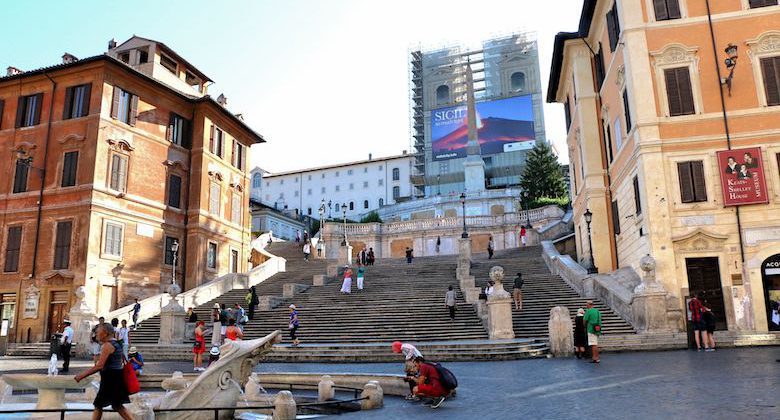
The Complete Guide To Planning Your Trip To Rome: Tips, Restaurants, and More
Sean Finelli Last Updated: August 29, 2023
Traveling to Rome for the first time? Nobody wants to pick a hotel in the wrong part of town or sit down at a bad restaurant. The good news is you’re reading this article, so you won’t have these problems! This guide will cover some of the Rome basics and links to a ton of great resources to make planning your trip to Rome easy and fun.
Pro Tip: Bookmark this post and other helpful articles, like where to stay in Rome in a trip folder on your browser so you can quickly find them when you need them. Rome is an expansive city worthy of a tour or two, explore our top-rated Rome tours and experiences . Also, check out our other resources on planning your trip to Rome .
How To Plan Your Trip To Rome: A Complete Guide
In this guide, you’ll find everything you need to know to plan a memorable vacation in the Eternal City, with plenty of additional resources to explore. From the logistics of where to stay and how to get around the city to the finer details of how to get your coffee, basic Italian phrases, and top things to do, we’ll help you prepare for your dream trip in Rome.
- Airports and Public Transport (Metro)
- Where To Stay
- Things To Do
- Food Culture
- Credit Cards, Tipping, and Communicating
When To Travel To Rome and What To Pack
Rome airports and public transport, rome airports.
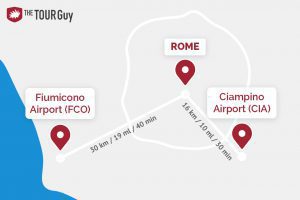
There are two main airports in Rome, Ciampino and Fiumicino, and they are both roughly the same distance from the city center.
Fiumicino (FCO)
In short, to get from Fiumicino Airport (FCO) to Rome’s city center, the train is the most popular means of transport, taxi is the most convenient, and the bus is the least popular.
By far, the most popular way to get from Fiumicino airport to the city center is by train. For €15, you can get the Fiumicino Express from FCO to Termini station (main station).
A taxi is the most convenient way to get to the center. There are regulated rates from the airport to the city center that fall between €45 – €50, depending on a few difficult-to-explain criteria, such as what type of license the taxi has. If you’re staying outside the historic center of Rome, you may also have to pay more or less. You can normally pay with a credit card in taxis but always ask.
Ciampino (CIA)
The bus is the most popular way to get from Ciampino Airport (CIA) to the city center. Buses tend to cost around €6 – €7, depending on the airport and the coach company. They run based on arrivals. Terravision has been around for a long time and is pretty cheap.
Taxi, again, is the most convenient. They cost between €35 – €45 depending on the same factors mentioned above, which are difficult to understand.

Rome Transportation Options
Rome has plenty of transportation options. How you decide to get around Rome on any given day on your trip will depend on your preferences, what you have planned to do, and where you’re going. We’ll go over all of them:
Walking in Rome
Rome is an extremely walkable city. If you’re in reasonably good shape and the weather isn’t overly hot, you can walk Rome’s historical center very well. However, the streets can sometimes be confusing. If you aren’t using a mobile map app, it could get tough.
The Colosseum is a 35-minute walk from the Piazza del Popolo and around a 60-minute walk from the Vatican Museums Entrance. However, it’s important to pick your battles. For example, you may not want to walk to the Vatican from the Colosseum, considering that you’ll be on your feet for at least three hours when visiting the Vatican Museums with a guided tour. Some of our top-rated Vatican tours last up to 5 hours to give visitors an enriched experience of the museums. In this case, it might be better to take the subway or even a taxi to conserve energy.
That said, be prepared to walk when you’re in Rome. If you aren’t already doing so, walk at least an hour each day to get your legs ready for your trip!
Rome Bus System
We have a great video on what you need to know to use the buses in Rome . It’s a little dated but fun to watch, and you’ll see exactly where to get bus tickets, how to ask for one, and how to conquer Rome’s bus system. There are three fundamentals that you need to know when using the buses:
- Buy a ticket before you get on and validate it when you’re on the bus.
- The bus signs are pretty confusing unless you know the city really well. So, download an app .
- The buses go literally everywhere. They’re a good option but get hot and crowded in the summer—just something to keep in mind.
Walking around Rome can get really tiring. Hopping on a bus for a kilometer or two can make all the difference. Save your energy for the highlights of your trip.
Rome Metro (Subway) System
The Roma metro system has two lines: the red A-line and the blue B-line. As a visitor, you’ll find yourself on the A-line the most. It goes from Termini past the Trevi Fountain, Spanish Steps, Piazza del Popolo, and most importantly, the Vatican.
The B-line will get you from Termini Station to the Colosseum and Circus Maximus. These are the most popular stops for visitors using the metro to get to Rome’s top attractions .
You can’t get to Trastevere by metro, but you can get close to Testaccio by getting off at Piramide. Both Trastevere and Testaccio are known for their lively nightlife and great food. Your hotel and most Airbnbs will have a metro map that you can keep handy.
Getting a Taxi in Rome
I use public transportation for short, direct rides to get from place to place. For example, going from the Vatican to the Spanish Steps or from Termini Station to the Colosseum. For anything complicated, I normally pony up and take a taxi. They’re relatively cheap if they don’t rip you off—which they will try to do.
A good workaround is to search for your destination in your phone’s map app, get directions from your current location, and hit go. Then, show that map to the taxi driver when they ask where you want to go. This way, they know you’re tracking. Otherwise, there’s really nothing you can do. Just don’t pre-negotiate the rate. There’s a meter in the vehicle that determines the cost.
Renting a Scooter in Rome
If I’m in Rome for more than a couple of days, I’ll rent a scooter. It’s a good option if you have scooter experience. If you don’t, I wouldn’t recommend it. It can be dangerous getting around an unknown city when you don’t even know how to drive the thing, let alone negotiate traffic and figure out where to go.
Where To Stay in Rome
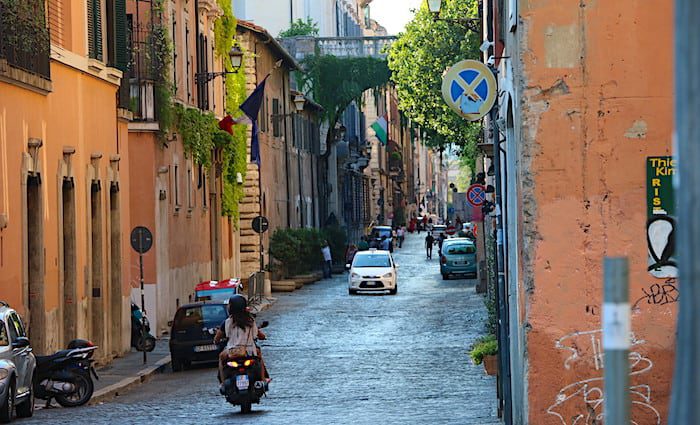
Rome is a large metropolitan city, but the area most visitors are interested in is the historical center or Centro Storico because it’s pretty condensed. You can walk from the Colosseum to the Vatican, almost on opposite sides of the historical center or “center” for short, in an hour.
The center is the place to be in Rome, and each neighborhood is really great. I prefer the northern sections like Piazza Navona and Spanish Steps. To me, they are classical Roman/Italian and super nice. Here are the best areas to consider with links to in-depth neighborhood guides:
- Spanish Steps
- Pantheon/Piazza Navona
- Prati (Vatican)
Again, I really like anything near the Spanish Steps, as I like being in the thick of it. It will come with a price tag, but savvy travelers find deals. Check out our in-depth guide on where to stay in Rome, covering the city’s best neighborhoods.
Top Things To Do in Rome
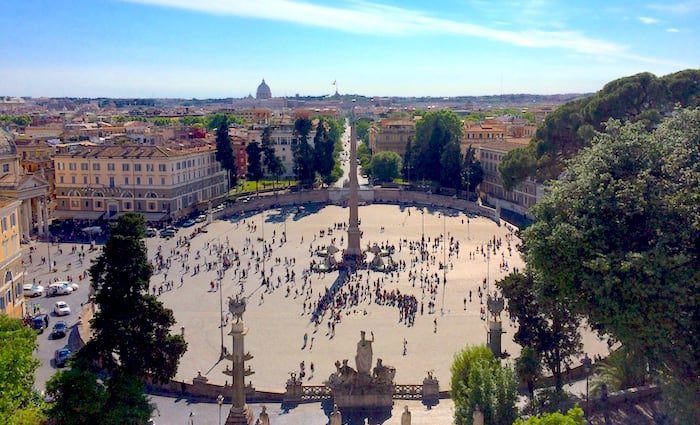
From visiting the Sistine Chapel to an underground apothecary run by priests, there are unlimited things to do in Rome. One of the best ways to see a city with this kind of history is to join local guides on fun tours with exclusive access and endless stories to tell. There are so many things to see and ways to see them. Check out all our Rome tours that include the top monuments and museums, plus incredible day trips.
This is a list of the top things to do while you’re in the Eternal City. Be sure to follow the links for more in-depth information on visiting each one of these monuments and museums.
Top Museums
Rome has over 60 incredible museums containing some of the world’s most important works of art. It may be difficult to decide which of them you’ll see. Check out our guide on the seven best museums to visit in Rome for details. Here’s a quick list:
- The Vatican Museums
- The Borghese Gallery
- The Capitoline Museum
- Palazzo Barberini
- Palazzo Altemps
- Palazzo Massimo alle Terme
- MAXXI Museum
Top Monuments
Rome is filled with historical monuments and attractions. Some of them you have likely heard. Others may be new to you. Here is a list of what you should see on your Rome trip. Check out this guide for the stories behind these top monuments and attractions in Rome .
- The Colosseum
- The Basilica of St. Peter
- The Catacombs of Domitilla
- The Roman Forum
- The Pantheon
- The Palatine Hill
- The Trevi Fountain
- Piazza Navona
- The Spanish Steps
- Belevedere of Gianicolo Hill
- The Tiber Island
- The Mouth of Truth
- Trajan’s Column
- Il Pincio and Piazza del Popolo
Must-See Gardens and Parks
If you love beautiful manicured gardens and green spaces, this is for you. There are a number of must-see gardens and parks in Rome . The Villa Borghese and Vatican Gardens are the more well-known among them, but you may also want to visit some of these:
- Villa Doria Pamphili
- Villa Borghese
- Park of the Acquedotti
- Giardino degli Aranci
- Vatican Gardens
- Villa Ada Savoia
- Villa Sciarra
Absolutely Free Things To Do
You may be surprised by the cool free things you can do in Rome . Some of the city’s most well-known sites are completely free to explore. Check out this list:
Food Culture in Rome
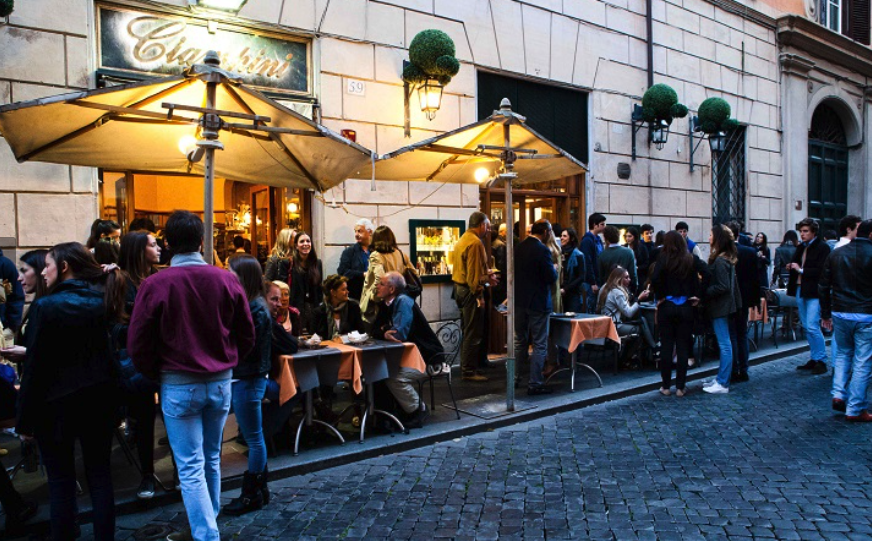
Where to start with Italian food? It’s often one of the top reasons why tourists come to Italy, and for good reason. Every region serves amazing, fresh, handmade delicacies.
A traditional Italian meal will go like this: antipasto (starter), primo (pasta), secondo (meat and vegetables), dolci (dessert), followed by coffee and liquors. Do Italians eat like this every day?
Fortunately for those of us who live here, no! But these are typically the headings that you’ll see on a menu, so it’s best to have an idea of what they mean. There’s a lot to cover in this section, here’s a breakdown:
- How to Find Local Restaurants
Types of Restaurants
Rome meal times.
- Coffee Culture
- Drinking Fountains
How To Find Local Restaurants in Rome
Rome is a very touristy city, but that doesn’t mean that there aren’t good places to eat in the city center. Check out our Rome restaurant master list that we regularly update . From there, you can navigate and see our restaurant recommendations near every major Roman attraction.
In general, avoid restaurants within sight of a tourist attraction, particularly if they have pictures of the food on the menu or people standing outside trying to hustle you in. Even in the most authentic restaurants, don’t expect particularly friendly service.
Some of the best food is often flung at you without so much as a “hello,” but it’s guaranteed to be worth it. Areas a little more off the beaten track are where you’re more likely to have an authentic experience. For example, the area of Testaccio is well-known for being a classic Roman foodie area, packed with local restaurants.
A really great way to experience a wide variety of Roman cuisine in good restaurants is to join a food tour. They’re a trendy and fun way to get to know the local food scene. Check out our top-rated Trastevere food tour in Rome .
In Italy, there are stereotypical classifications for almost anything, including restaurants. When you’re in Rome, you’ll notice restaurants don’t just have a name, like “Tony’s,” but also a classification, such as “Trattoria.” Each one means something specific, and it lets you know what kind of food and experience to expect. Unfortunately, very few visitors to Italy know the difference between an osteria and a trattoria . We’ll solve that for you right here.
Imagine waking up at 6:30 am, rolling over to your significant other, and saying, “Want to head to the bar?” This is what happens almost every morning to millions of Italians.
No, they are not alcoholics. You can get alcohol at an Italian Bar, but you normally don’t. It’s where you get breakfast. You’ll see the “Bar” sign all over Italy, and when you walk in, you’ll find espresso drinks, cornetto, and panini. You can also get freshly squeezed orange juice or vegetable juice. I highly recommend it!
Unlike the bar, you definitely shouldn’t wake up at 7 a.m. asking you’re significant other to go to the enoteca . This is where you go for an alcoholic drink like a glass of wine or a beer.
A good enoteca will serve tons of wine by the glass in many different price ranges. They’ll often also serve cured meat plates for a snack or even warm meals at times. I definitely recommend stopping by one of these on your travels in Italy and Rome.
Tavola Calda
One of my favorite types of places to eat lunch is a tavola calda . They are normally unassuming and serve many different types of dishes, from cooked vegetables to lasagna and pasta dishes. The dishes normally change from day to day based on what is in season and other factors.
For example, gnocchi in Rome is only served on Thursdays. If you see it on the menu seven days a week, you may be in a tourist trap. Authentic Roman restaurants only serve this dish on giovedí. You have been warned.
These are pretty cool little sandwich shops. Dotted all over Rome, they range in quality. Don’t refer to your sandwich as a “panini” unless you get more than one. The “i” makes it plural. Italian’s order a panino.
Check out 200 Gradi by the Vatican. It’s an awesome place. Campo dei Fiori also has an awesome drive-up stand open for lunch that serves porchetta.
Osterie are pretty cool if you can find one. They are basically super cheap and simple places to eat. A true osteria would have communal-style tables and serve very cheap meals. Back in the day, when Italy was extremely impoverished, they’d even allow you to bring your own food and just drink there. Imagine that today?
You can find restaurants with the title “Osteria” in Italy, but you shouldn’t bring your own food or normally expect to eat with strangers. There is a place in Florence, Da Mario , which says it is a trattoria, but it feels more like what a traditional osteria would have been like.
Expect a warm and cheap meal if you happen to go inside an osteria in Rome, and even more so in the Italian countryside. The menu will either be non-existent or small. In the countryside or in small towns, they can be really cool. The waiter may rock up to your table and say, “Today, we are serving pasta with clams. Would you like fettucini or spaghetti with that?” Enjoy!
The trattoria of Rome sits somewhere between osteria and ristorante . Almost all Italian restaurants are family-run, bu t trattories are quintessentially family-run. They are normally inexpensive but have a larger menu than an osteria.
Expect traditional regional cuisine at a trattoria. If you go to two different ones, you may find the exact same things on the menu. This is because they offer their family’s version of that regional dish.
This is basically the Italian equivalent of a more formal restaurant. They’ll have a menu with all the Italian courses, and you’ll be expected to eat each course. You should definitely find a top-rated ristorante in Rome and budget 3 hours for your meal. Really indulge in the food, wine, and desserts.
Pasticceria
This is an Italian bakery serving all types of delightful local treats. They are probably the best places to go for breakfast as they’ll make their cornettos fresh and supply them to all the bars.
You should be able to get a coffee here, too, but that isn’t a given. If you’re staying in an Airbnb or apartment rental, find a pasticceria close by and pick up a bunch of cornetti for your group. You’ll be everyone’s favorite person!
Rosticceria
You won’t find this is in Rome, but it’s worth mentioning. A rosticceria is a place you can go to find pre-cooked meals like roasted meats and high-quality products. If you do find one and you’re renting an apartment, consider doing take-out one night from a rosticceria.

Taverna or Rifugio
You’ll find restaurants in Rome with taverna in their names, but this is more a colorful play on words. Taverne are secluded restaurants in the Italian mountains where you could get a hearty meal, something to drink, and possibly a warm bed to sleep in.
Today, you can still find a few dotted in the landscape, but you’re more likely to find an agriturismo, which is more of a B&B. A taverna in Rome is most likely going to decorate its interior in a rustic countryside style and have hearty meals on its menu. It’s kind of like going to a seafood restaurant that’s decorated in a nautical theme but nowhere near an ocean.
One of the biggest cultural differences is that Romans tend to eat much later than basically everyone except the Spanish. In fact, many of the best restaurants won’t open until at least 7:30 p.m.
Lunch: 12:30 pm – 2:30 pm
Dinner: 7:30 pm – 11 pm
To avoid eating in an empty restaurant and to really make the most of your evenings in Rome, try and fit in with them and eat a bit later. Around 8 pm is a good time to sit down.
Coffee Culture in Rome
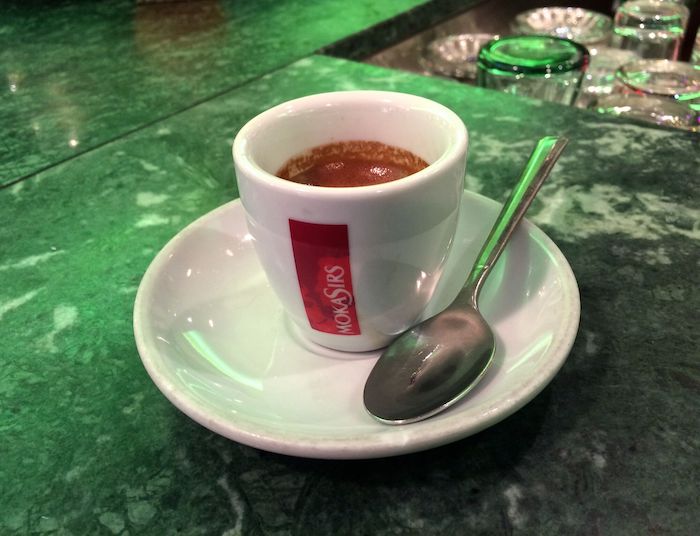
Italians take their coffee culture very seriously, and there are almost as many rules about coffee as there are for food. Here’s what you need to know to get your coffee fix in Rome:
Espresso “un Café”: A very small shot of coffee. Unless you’ve been to Italy, it’s never been this small.
Café Doppio: Double shot of espresso.
Café Macchiato: Basically a mini cappuccino. Imagine an espresso and foamed milk all in a tiny espresso cup. Normally, men order these in the morning.
Cappuccino: This is espresso and foamed milk in a small cup. It’s larger than a macchiato, but nowhere near that tall cappuccino you are used to. You won’t find a larger size.
Café Americano: Espresso with hot water. The name is from WWII, when American troops would ask Italians to put hot water in the espresso.
Latte: A cup of milk—don’t order this if you want caffeine.
Café Latte: Warm, non-foamy milk with espresso.
The Coffee Rules (Yes, there are rules)
- No cappuccino or milk-based espresso after 11 a.m. You can do it, obviously, but it’s not really the culture.
- No cappuccino or milk-based espresso with meals. Don’t do this.
- It is cheap when you stand up at the bar (€1 – €2), expensive when you sit down. Same for everyone, not just tourists.
Rome Water Fountains
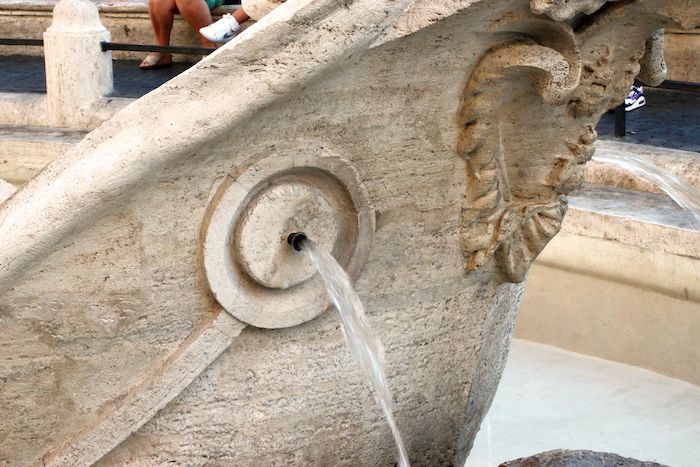
One of the best things to know about Rome is that there’s no need to buy plastic bottles of water when you get thirsty—there are tons of fountains dotted around the city, and Romans are very proud of them.
Bring a refillable water bottle, and fill it up whenever you see one. There’s also an app to help you find them called I Nasoni di Roma. If you’re going in the heat of summer, you’ll find this tip invaluable!
People are always surprised that you can drink from these fountains, which is crazy if you think about it. Their original purpose was to provide running water to each neighborhood since most houses didn’t have running water. Today, we forget that fact and are astonished by this basic concept due to our many creature comforts.
Credit Cards, Tipping, and Communicating in Rome
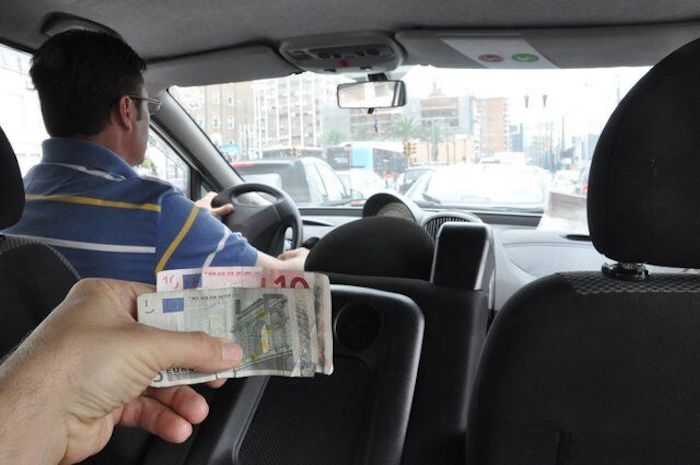
Cash or Credit?
The currency in Italy is the euro. An important thing to remember about Italy is that cash is still king. It’s necessary to carry a reasonable amount of cash around with you at all times to avoid getting stuck.
In general, most restaurants will allow you to pay on a card, as will large shops and tourist attractions. But for drinks, coffee, transport tickets, and small items, cards often aren’t accepted. There may even be a €10 minimum on card payments.
Rule of Thumb: If it’s less than €10, pay cash. It’s more than €10, and you can probably pay credit as long as there isn’t a “Solo Cash” sign on the door.
The Good News: The Italian word for credit card is carta di credito . Any Italian shop owner will understand when you ask, “Credit Card?” They’ll also know to respond, “Cash” if they don’t accept credit cards. So, there’s no need to stress.
Tipping isn’t really expected in Italy. I’ve tried to convince visitors that you just need to leave some extra change, a euro per person, regardless of check size, but it normally falls on deaf ears. To simplify things, I have created different levels of tipping to help people understand:
Don Corleone: Leave 20%, and when you go back, the restaurant staff will celebrate your return as if you were the Godfather. You may get some sneers from other restaurant goers who can’t get your waiter’s attention.
Super Nice : Leave 10%. It’s less than you are used to but far more than anyone in Italy would expect.
Roman : Leave a euro or two extra per person. The wait staff will be very happy.
Nothing at All : Leave nothing and nobody will say anything. Your food will not be poisoned upon returning.
Communicating in English or Italian
One of my favorite things to watch is travelers trying to string together Italian words into sentences from a guidebook. I have been that traveler in many countries. The worst part, though, is when you actually make sense, and the person responds, much to your bewilderment.
Let’s not romanticize the key phrases part of a guidebook here and keep it simple. The phrases below will make you look like a pro because you’ll get simple responses such as si (yes) or a finger pointing to the bathrooms. Remember that c’s have a hard “ch” sound, unlike Spanish.
How much does this cost? Quanto costa?
Check, please. Il conto per favore.
Do you take credit cards? Posso pagare con la carte?
Where is the bathroom? Dov’è il bagno? Or simply, “bagno?”
Water? Acqua?
Table for two, please. Tavolo per due, per favore.
Can you order for me? Fai te?
The last recommendation is by far my favorite. If your waiter is Roman, they will accept the challenge and bring some tasty food. A key phrase is certo (pronounced cherto), which means “of course”. Romans use this all the time, so you may hear it instead of si .
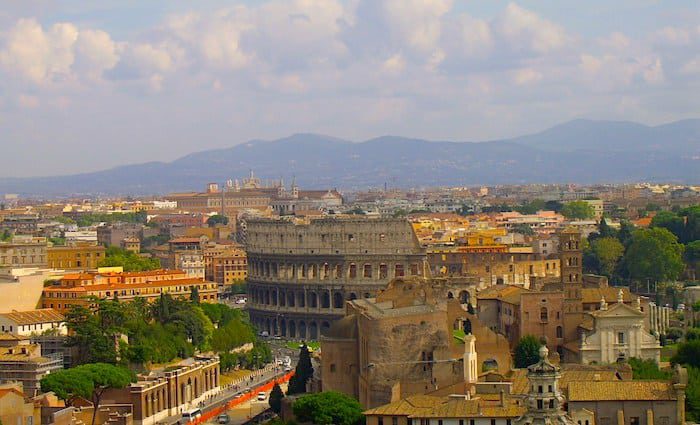
When To Travel
Part of the reason why people love Rome is the weather. It’s pretty much always nice, and bad weather is when it is too hot. That’s a good problem to have.
Temperature
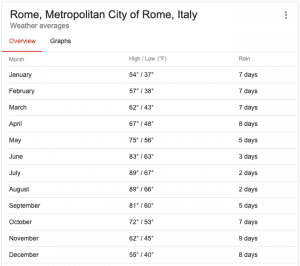
The average monthly temperature in Rome ranges from a low of 37 degrees Fahrenheit (F) to a high of 89 F. It snows once every 10 to 50 years, and people don’t know what to do when that happens—it’s the greatest.
To decide when you want to travel to Rome, you can use this equation to get a rough idea.
How much am I willing to spend / Am I ok with cooler weather = Daily budget
Cheapest Months:
- December (1st – 20th)
- Jan (7th – 31st)
- March (1st – 20th)
Mid-Range Months:
- March (21st – 31st)
- April (excluding 5 days on either side of Easter)
- October (although it can be higher in price early in the month)
Full-Price Months:
- Christmas to New Year
- Easter (5 days on either side)
What To Pack
Check out the infographic below on what to pack. While it’s very useful, the ideal amount to pack is one change of clothes and a mostly empty suitcase. Shopping in Italy is great, so the more space you can leave in your suitcase, the better.
You don’t need to pack an umbrella. As soon as it rains, hundreds of people will appear out of nowhere selling umbrellas. It’s magical. Also, you can’t wear heels in Rome. Let me clarify, you can wear flats and pack heels in your purse for when you are inside bars and restaurants. The cobblestones make wearing heels nearly impossible.
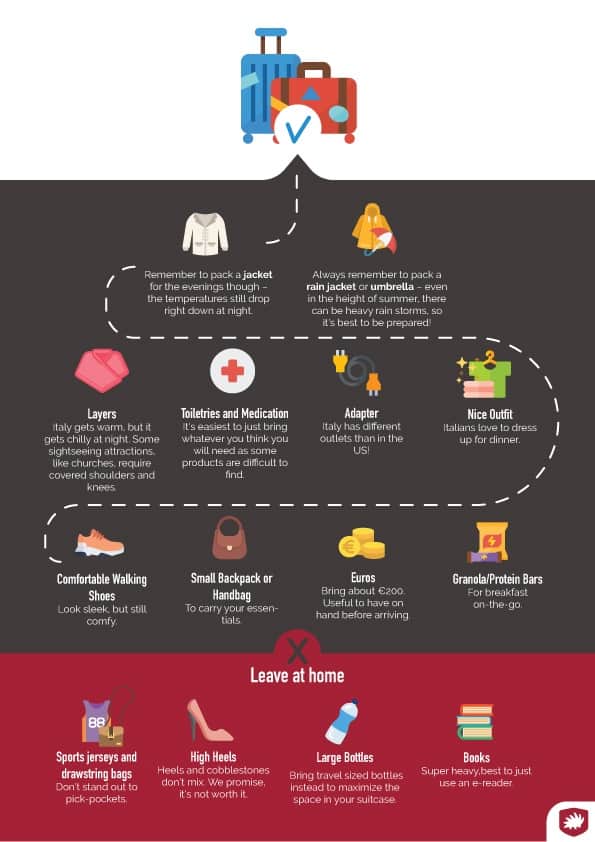
Rome has a rich cultural history and many iconic landmarks to explore. Plan where to stay in the magnificent Eternal City in the best neighborhoods.

Reader Interactions
Comments (12).
September 3, 2019
What a lovely description of Italy and Italians you have given to us! I love to read about the transport, food and most importantly the people. Awesome work done! Keep them coming!
September 4, 2019
Ciao Tanisha! What a lovely comment. We are so happy to provide you with helpful tips for your vacation!
October 24, 2019
A very informative article. Thank you so much for sharing these things.
October 28, 2019
Ciao! Thanks so much for reading our blog! It’s our mission to provide you with the most useful information possible for your trip.
November 19, 2019
Nice quality post. Thumbs Up from my side. Special thanks to theromanguy for sharing this valuable information. Once again appreciated!
January 6, 2020
Nice tips. I’d add the 48 euro fixed rate from the airport to the centre as the best option if there are at least 2 people. By the time you take the train then Metro or taxi from Termini it just about equals out.
January 21, 2020
Thanks for the tip, Gary!
May 15, 2020
Rome really such a beautiful city, wish more people will be able to experience it. Thanks for the insightful article.
June 9, 2020
It is nice you included few basic lines of Italian language everyone should know when visiting Italy or and other country. People are so friendlier to you if you can say “Hi” to them in their language.
July 21, 2020
Hey, thanks for sharing this, I enjoyed reading it looking forward to my next trip to Italy.
April 23, 2021
Admiring the time and energy you put into your blog and detailed information you provide.
September 27, 2022
thank you – very helpful and have taken notes for our trip 🙂
Leave a Comment Cancel reply
Your email address will not be published. Required fields are marked *
- In The Press
POLICY & TERMS
- Cancellation Policy
- Terms & Conditions
- Privacy Policy
Awesome, you're subscribed!
Thanks for subscribing! Look out for your first newsletter in your inbox soon!
The best things in life are free.
Sign up for our email to enjoy your city without spending a thing (as well as some options when you’re feeling flush).
Déjà vu! We already have this email. Try another?
By entering your email address you agree to our Terms of Use and Privacy Policy and consent to receive emails from Time Out about news, events, offers and partner promotions.
Love the mag?
Our newsletter hand-delivers the best bits to your inbox. Sign up to unlock our digital magazines and also receive the latest news, events, offers and partner promotions.
- Things to do
- Restaurants
- Los Angeles
Get us in your inbox
🙌 Awesome, you're subscribed!

20 travel tips every first-time Rome visitor should follow
Whether you are a Roman novice or expert, these travel trips for Rome should be followed at all times

Don’t get us wrong, Rome is a very friendly place. But it’s not always the easiest to navigate. And unless you want to find yourself waiting for a coffee for three hours or queueing for the Vatican for three hours, there are some things you should know before you go.
And don’t panic. Our local writer Livia Hengel has the inside scoop on every rule, custom and hack for the big city. If you want to absolutely smash a weekend in Rome, read this list (and read it before you go. Trust us). Here is every travel tip you’ll need to do Rome as the Romans do.
RECOMMENDED: 📍 The best things to do in Rome 🍝 The best restaurants in Rome 🏛️ Unmissable attractions in Rome 🛍️ Where to go shopping in Rome 🏨 The best hotels in Rome
Livia Hengel is a writer based in Rome. At Time Out, all of our travel guides are written by local writers who know their cities inside out. For more about how we curate, see our editorial guidelines .
An email you’ll actually love
Travel tips for visiting Rome

1. Don’t order a cappuccino after noon
You may or may not have seen this one crop up on TikTok from time to time. But basically, don’t you dare order a cappuccino after noon. Cappuccinos are thought of as heavy drinks more suitable for breakfast, and paired with a cornetto. If you’re craving one in the afternoon, order a caffè macchiato instead.

2. …But gelato is acceptable any time, any season
Great news for gelato lovers. You can order one of these bad boys anywhere, anytime. Before lunch, after lunch, whatever you desire. The gelato world is your oyster in Rome, and their flavours change seasonally, so you’ll never get bored. Think ciccolato fondente (dark chocolate), pistacchio and mandorla (almonds). Delicious.

3. Buy Vatican tickets online to skip the line
Housing one of the world’s greatest collections, the Vatican Museums are one of Italy’s most popular attractions, visited by over 5 million people annually. Though you’ll inevitably face a crowd, you can skip the long lines by purchasing your museum tickets on the Vatican website. The extra Euros for booking online are well worth the time you’ll save by not waiting in line.

4. Free museums on first Sundays
Rome’s state-owned museums, galleries, archaeological sites, parks and gardens are free on the first Sunday of each month, so be sure to drop by and soak in some art if you’re in town these days. Lines quickly form outside the main attractions, so plan to show up early or visit a lesser-known destination (warning: you’ll still need to pay a fee to browse through special exhibitions).

5. Note museum closures
Many of Rome’s city and state-owned museums, like Galleria Borghese and Palazzo Barberini, are closed on Mondays, so plan your schedule accordingly. The Vatican Museums are closed on Sundays instead, so they’re very crowded on Saturdays and Mondays; if you can, try to visit Tuesday through Friday.

6. Order coffee at the bar
Have you guessed the Italians are quite particular about their coffee yet? Coffee etiquette actually makes up a fair few of the biggest culinary crimes you can commit in the capital. You might notice people in Rome tend to order an espresso and drink it standing up, before even leaving the bar. That’s the way things are done. Italians don’t order coffee from the table and have it brought to them, and in fact, that’ll likely slap you with service charge and almost double your bill. Do as the Romans do, and neck that espresso before you go anywhere.

7. Buy bus tickets ahead of time
Rome’s public transportation leaves much to be desired, but if you need to take a bus in the city centre, stock up on bus tickets ahead of time because you can’t buy them on the bus. You can buy tickets at any tabaccheria in the city, little convenient shops that are designated with a large T. Tickets are €1.50 each, or opt for a 24-hour, 48-hour or weekly ticket for a discounted price. Tickets are valid for all forms of public transportation in Rome (bus, metro, tram and local train).

8. Take your bus ticket straight to the beach
Speaking of public transportation, your €1.50 ticket is also valid on the local commuter trains in Rome, including a line that goes straight to the beach. You can catch a train at the Piramide Metro Station that will take you directly to Ostia Lido, Rome’s local beach. Although it’s not the most glamorous beach near Rome, Ostia is perfect for an inexpensive day trip, with some sunshine and fresh seafood.

9. Dress modestly in church
Rome has over 900 churches that house some of the city’s most beautiful works of art, so don’t miss stepping inside to marvel at their treasures, whether you’re devout or not. Just be sure to dress appropriately to enter these holy spaces: women’s shoulders should be covered, and skirts should hit at or below the knee, while men should wear pants or shorts that extend to the knees. Linen pants are a great option for the summer, and a scarf is a perfect last-minute cover-up if you’re wearing a tank top.

10. Watch your bags
Always be mindful of your bags on public transportation and around key tourist attractions. The city is safe, but petty crime is rampant, especially on crowded buses and metros. Thieves in Rome are stealthy, so always keep your bags zipped and held in front of you; wallets should ideally be tucked in your inner jacket pockets. Some thieves also snatch bags, so keep them in close reach at all times.
[image] [title]
Discover Time Out original video
- Press office
- Investor relations
- Work for Time Out
- Editorial guidelines
- Privacy notice
- Do not sell my information
- Cookie policy
- Accessibility statement
- Terms of use
- Modern slavery statement
- Manage cookies
- Advertising
- Time Out Market
Time Out products
- Time Out Worldwide
- Android app
Advertiser Disclosure
Many of the credit card offers that appear on this site are from credit card companies from which we receive financial compensation. This compensation may impact how and where products appear on this site (including, for example, the order in which they appear). However, the credit card information that we publish has been written and evaluated by experts who know these products inside out. We only recommend products we either use ourselves or endorse. This site does not include all credit card companies or all available credit card offers that are on the market. See our advertising policy here where we list advertisers that we work with, and how we make money. You can also review our credit card rating methodology .
The Ultimate Travel Guide to Rome – Best Things To Do, See & Enjoy!
Amar Hussain
Senior Content Contributor
782 Published Articles
Countries Visited: 63 U.S. States Visited: 9
Keri Stooksbury
Editor-in-Chief
34 Published Articles 3166 Edited Articles
Countries Visited: 47 U.S. States Visited: 28
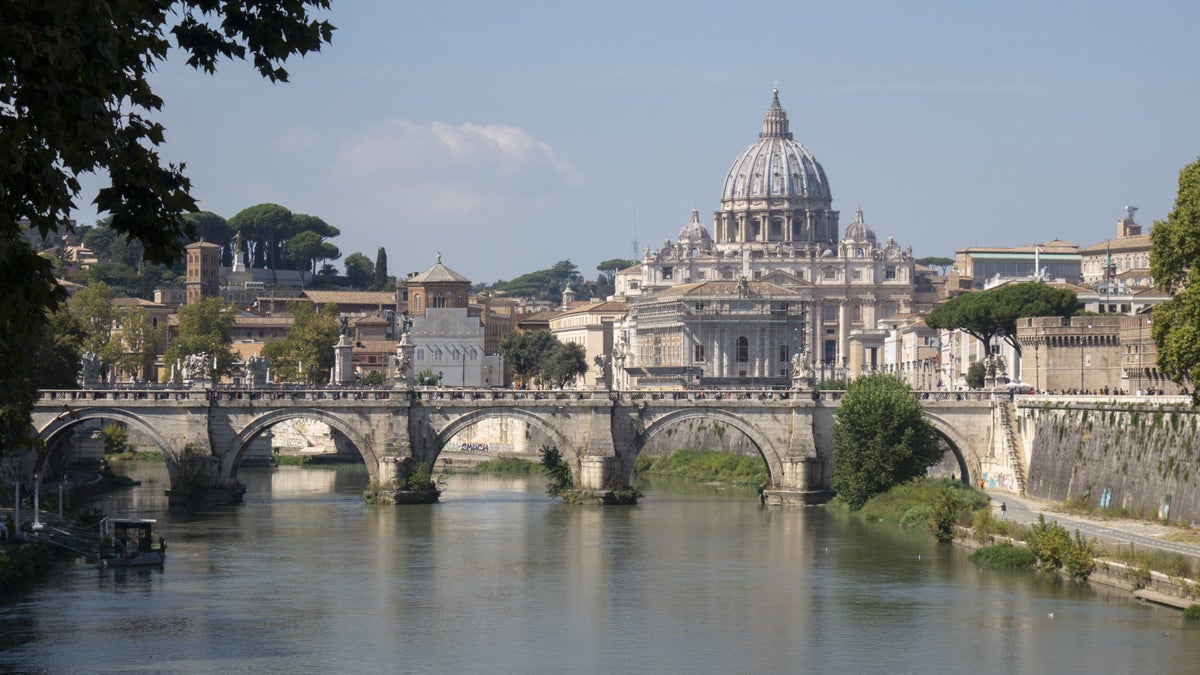
A Brief History of Rome
Fact file , getting around rome, san giovanni, centro storico, san lorenzo.
- Roman Forum
St. Peter’ s Square and Basilica
The pantheon, the spanish steps.
- Trevi Fountain
The Vatican and Sistine Chapel
Piazza navona, galleria borghese, castel sant’ angelo, pyramid of cestius, street art in ostiense, house of owls, largo di torre argentina, teatro marcello, capuchin crypt, the appian way, circo maximus, vintage fiat 500 tour, villa borghese, villa doria pamphili, botanical garden, vatican garden, orange trees garden, villa torlonia, parco degli acquedotti, palazzo venezia, villa celimontana, rose garden, basilica of santa maria del popolo, santa maria in trastevere, basilica of santa maria maggiore, santa maria in aracoeli, san giovanni in laterano, santa maria sopra minerva, basilica di san pietro in vincoli, santa maria in cosmedin, san clemente, saint paolo fuori le mura basilica, via condotti, via del corso, via cola di rienzo, porta portese, via del babuino, v ia del governo vecchio, flaminio market, fontanella borghese market, 15 rome travel tips & hacks, romulus and remus, the trevi fountain, you can drink the water, there are lots and lots of fountains, no cappuccino after 11:00 a.m., the aventine keyhole, secret passageway to the vatican, there are a lot of cats that live here, shop ‘til you drop, the pasta museum.
- Ostia Antica
Hadrian’s Villa in Tivoli
Beware of pickpockets, keep your valuables out of sight, avoid some areas at night, keep electronic copies of your documents, know who to call in an emergency, don’t look too much like a tourist, take advantage of the hotel safe, final thoughts.
We may be compensated when you click on product links, such as credit cards, from one or more of our advertising partners. Terms apply to the offers below. See our Advertising Policy for more about our partners, how we make money, and our rating methodology. Opinions and recommendations are ours alone.
The capital city of Italy is one of the most romantic and historic places in the world. Rome has a lot for you to explore and discover with its plethora of cobbled streets, beautiful architecture, Ancient ruins, and relics dating back over 2000 years.
Rome is packed with cultural experiences around every corner and is the home to some of the most awe-inspiring historical artwork in the world, including Michelangelo’s masterpieces in the Sistine Chapel. Affectionately known as the Eternal City, Rome is situated within the 7 hills on the banks of the Tiber River.
Many visitors return to Rome time and time again as there is more to do than you could fit in 1 trip. When it comes to downtime, you’ll be spoiled for choice with quaint restaurants and cafes serving delicious traditional Italian food and high-quality wines. If you want to dance the night away, Rome has a truly Mediterranean party scene that will suit all tastes.
Legend has it that the city was founded by twin brothers Romulus and Remus in 753 B.C. Raised by a she-wolf, the brothers fought over who should be ruler, and Romulus eventually killed Remus and named the city after himself. In the centuries that followed, Roman civilization shifted from a monarchy to a republic and then an empire.
The very first headquarters of the Roman Empire was based in the city of Rome itself, and the Roman Catholic Church was also founded here. Julius Caesar, the famous dictator of the Roman Empire, became Rome’s first emperor (in everything but name) and one of the city’s most historically important residents.
It is not just Italy that has felt the powerful force of Rome either, as the city has at times ruled over other countries such as Greece, and during the reign of Napoleon, it was officially part of France. Rome became the capital of the newly reclaimed Italian Republic in 1870 and is today considered to have been one of the most influential cities in history.
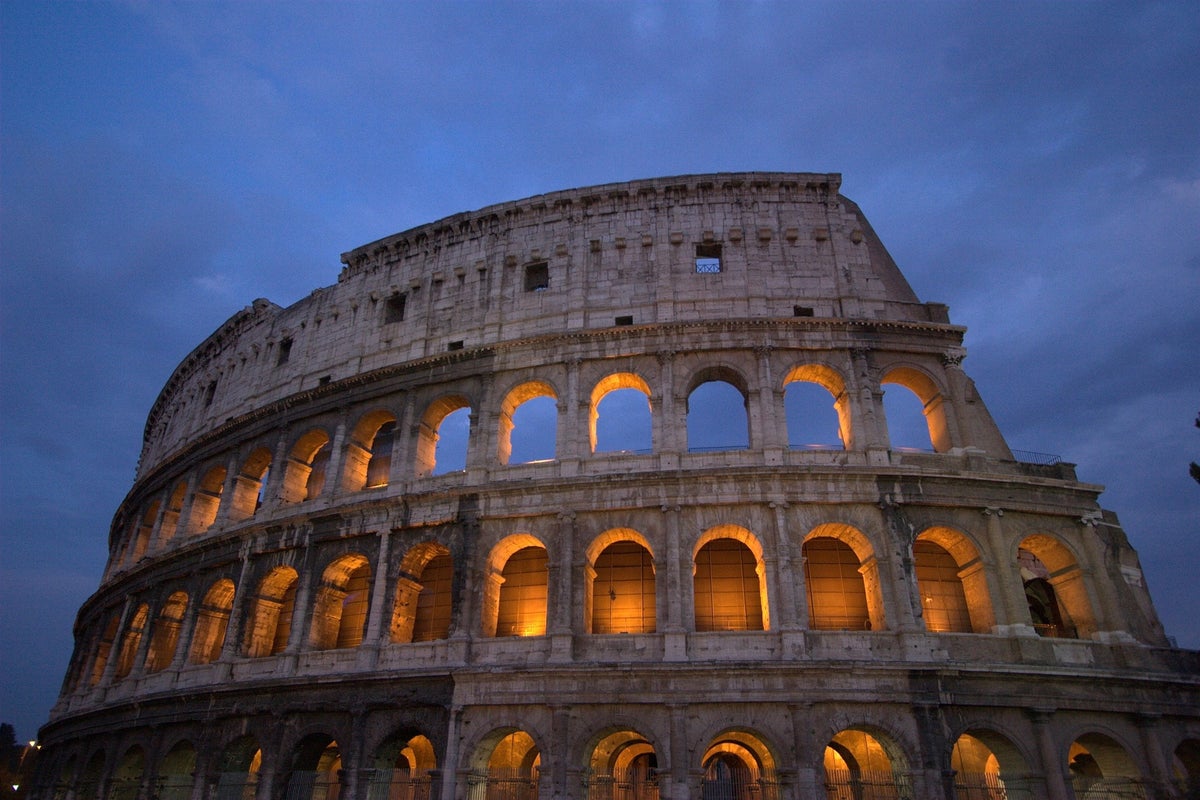
Rome has been the capital city of Italy since 1870 and is located within the center of the Italian Peninsula. Rome is around 15 miles inland from the Tyrrhenian Sea and sits along the Tiber River.
Population : 2.7 million
Population Density : 2.1 per km²
Area : 1285 km²
Official language : Italian
Rome has residents originating from many other countries, so a diverse range of other languages can be heard in the city including French, Greek, German, Sardinian, Albanian, Croatian, and Slovene.
Religion : The main religions in Rome are Roman Catholic and Christianity.
Current President : Sergio Mattarella
Patron Saints : Saint Peter and Saint Paul
Weather : Mediterranean climate with warm, dry summers (peak temperatures in August are around 82°F/27°C) and cold, humid winters (average of 37°F/3°C in January).
Time Zone : CEST + 2hrs UTC (Central European Summer Time)
Currency : Euro
Country Dialing Prefix Code : +39
Emergency Numbers : 113 for Police, 115 for Fire Department, 118 for Medical Emergencies
Green Spaces : Parks and gardens make up 3% of Rome
Churches : There are over 900 churches in Rome!
Getting There and Getting Around
Rome has 2 airports, Leonardo da Vinci Airport (FCO) and Ciampino Airport (CIA).
Leonardo da Vinci Airport, also known as Fiumicino Airport , handles mostly scheduled flights and is connected to the city via a direct train service, The Leonardo Express train. This train is a non-stop service which takes approximately 30 minutes from Fiumicino Airport into the central station in the city, Rome Termini, and costs around $16 (€14).
Alternatively, you can get a shuttle bus service from Fiumicino Airport into Rome’s city center. These buses take on average 1 hour and tickets are available from $8 (€7). If you prefer to travel by private taxi, they are available outside Fiumicino Airport and charge approximately $49 (€44) to take you the half-hour journey into the center of Rome.
Hot Tip: See our in-depth guide on the best ways to fly to Italy, using points and miles.
Ciampino Airport mainly receives chartered flights and those from the budget European airlines. To get from Ciampino airport to Rome’s city center, you can get a bus into Ciampino town center and then a regional train to Rome. In total this would only cost you around $3 (€2.50).
Alternatively, you can get the SITBus Shuttle service, which is a direct route from $6 (€5). Ciampino Airport is only 9 miles from Rome city center, and taxis are waiting outside the airport to take you privately for around $28 (€25).
Once you are in Rome itself, your best travel options are to walk, use the ATAC buses, or the Metro.
Many visitors choose to travel around the city on foot so that they can appreciate everything on offer. Many of the winding streets are cobbled, though, so be sure to pack proper shoes if you are planning to head from 1 attraction to another.
The bus service in the city is very reliable and offers excellent value for money with stops at almost all the major points of interest. There are also night bus services which will run to 5 a.m. The average single bus journey costs around $2 (€1.50) and bus tickets can easily be purchased from any Metro station, newsstand, and many convenience stores.
If you are planning to take several bus journeys during your stay, then you may wish to purchase a travel card which will save you money. There are also 3-day, weekly, or monthly tourist cards on sale for this bus network.
The metro is a useful way for tourists to travel around the city as it is predominately set up for commuters to travel in and out of the city. The metro system crosses the city in a big ‘X’ and has stops near most of the main attractions. From Termini, you can travel to some of the main attractions with train stations, such as the Colosseum, Piazza Barberini, and the Spanish Steps.
The metro runs from 5:30 a.m. to 11.30 p.m. and tickets can be purchased from metro stations, newsstands, or convenience stores. You will be able to save money by purchasing a travel card if you are planning to travel by train for more than a couple of journeys.
Although private taxis are available to take you around the city center, these are not very popular with tourists as they are notorious for over-charging. If you plan to take a taxi, then it is advisable to discuss the cost of the fare with the driver before getting into the cab.
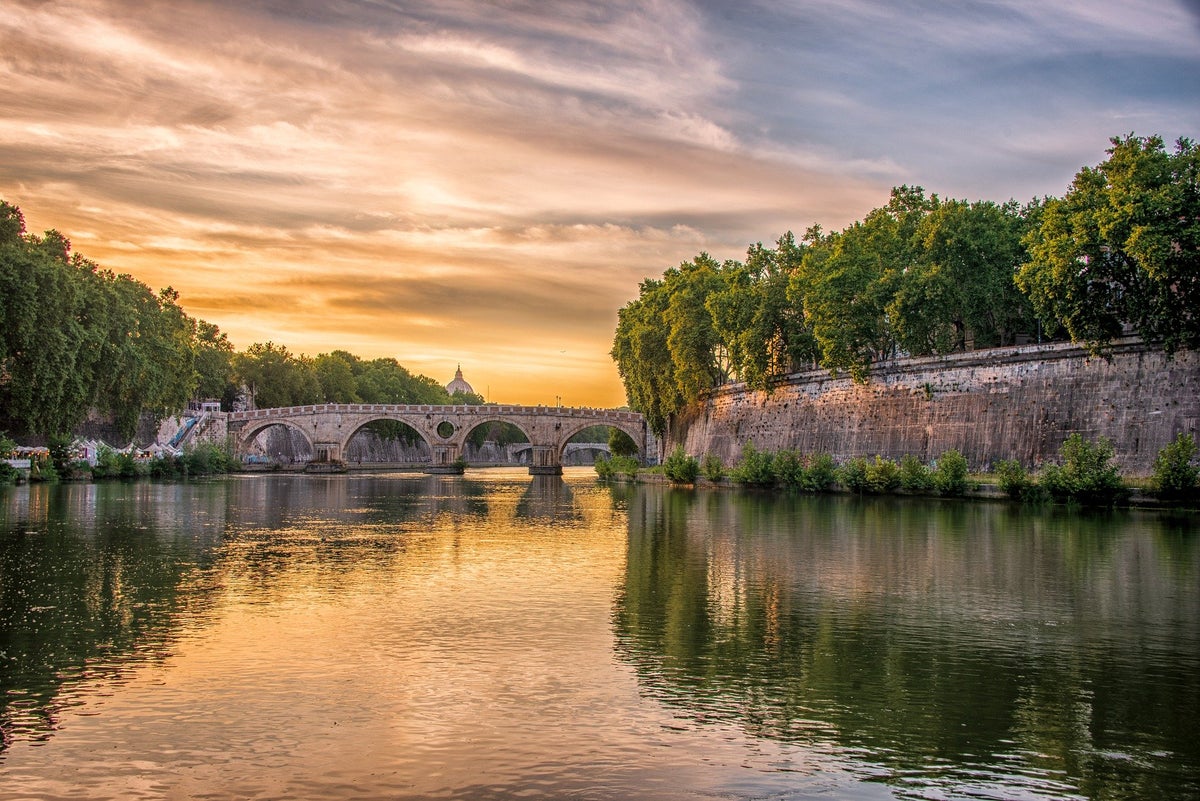
Top 10 Neighborhoods to Visit in Rome
Rome is a city that is spread across 22 different districts (known as “rioni”) and made up of 35 urban quarters (known as “quartieri urbani”), each with a diverse community atmosphere.
Some are set just within the walls of the city and some just outside. The following is an outline of these 10 areas — some are well known on the traditional tourist routes, and others are more up and coming.
Sitting just across from the Tiber River is the area known as Trastevere (which means “across the Tevere”). This area has a trendy, student vibe with an array of restaurants, trendy shops, and lively bars. From Trastevere, you can access river walkways to the historic center that meet and cross at Ponte Sisto and Ponte Garibaldi.
The historic center has a main square which is home to Piazza di Santa, one of the oldest churches in Rome. Trastevere as an area is situated at the bottom of Gianicolo Hill (also known as Janiculum Hill), and from here you can take spectacular walks and hikes until you eventually reach Rome’s largest park, Villa Pamphili.
Hot Tip: Along the way, you can see the 17 th -century marble fountain Fontana dell’Acqua Paola, as well as breath-taking views of the Capitoline and Palatine hills, the imposing Vittorio Emmanuele II monument, and Pantheon’s dome.
San Giovanni is overflowing with beautiful Renaissance buildings and elaborately decorated cathedrals. Unlike other areas of Rome which have the cobbled streets and narrow winding pathways, San Giovanni is made up of modern avenues and is home to many of Rome’s residents.
Although there are local restaurants, the majority of food is sold via community markets, and people sit in the parks for entertainment rather than bars. San Giovanni has brilliant public transport links and is also within walking distance of the Colosseum.
In this quiet, residential area of Rome stands the city’s oldest major Christian basilica, intertwined with modern high street shops and department stores, as well as the popular bimonthly second-hand market.
Despite having a modern vibe, San Giovanni is still a great choice for visitors interested in ancient ruins, cultural city walks, and historic fountains.
Monti gives you a taste of an authentic classic Roman neighborhood. Nestled between the Roman Forum and Basilica of Santa Maria Maggiore, it has a relaxed, lived-in vibe where you can meet the locals and admire the stunning scenery. The beautiful hillside landscape is scattered with pretty historic buildings set in cobblestoned paths and streets.
There is a wide variety of hip restaurants and trendy cafes, and from the southwest side of the neighborhood, you can see across to the Colosseum. Many tourists love visiting Monti where they can sit back and enjoy chilling out around the fountain in the main square known as Piazza della Madonna dei Monti.
Monti was historically an impoverished slum that has evolved to become a picturesque area bursting at the seams with character, attracting young bohemian-type residents and travelers.
Aventino is located on one of Rome’s 7 ancient hills and is a beautiful, green area within the city. Wealthy Roman families own imposing villas in this area, and a wander along the prestigious tree-lined avenues is an experience in itself.
While you are in Aventino, be sure to visit the Bocca della Verita, the chariot track at Circus Maximus, and the historic ruins at the Baths of Caracalla. There are fantastic views of the Tiber River to be had from the hillside of Aventino, and many tourists choose to sit in the orange garden to soak up the stunning vista.
Hot Tip: If you get the chance to visit the Magistral Villa of the Knights of Malta, you will get the opportunity to view St. Peter’s dome from a totally different perspective through the keyhole on the gate.
The streets that make up Centro Storico are some of the most historic parts of Rome where tourists flock to see the Campo de’ Fiori, the Piazza Navona, and the Pantheon. These areas are brimming with the charming narrow streets and ancient architecture that Rome is so famous for. In Centro Storico you will see some spectacular examples of classical Roman- and Baroque-style buildings.
The main square is busy every night and has a plethora of lively restaurants and bars, all of which serve up good quality Italian dishes and fine wines. The famous food and flower market at Campo de’ Fiori is not to be missed and should be on every tourist’s experience list.
Bottom Line: Centro Storico’s location makes this a popular neighborhood, so be prepared for the crowds.
San Lorenzo is situated outside of the city walls and sits between Termini and Tiburtina stations. This area was traditionally a working-class industrial center whose roots remain today with plenty of warehouse buildings and factory-style architecture on every corner.
San Lorenzo has a young, hipster, and student vibe and is close to Sapienza University. As you wander around San Lorenzo you will be able to admire the creative and artistic murals dotted on the side of buildings.
The progressive alternative music scene attracts free-spirited hipsters to the many live music events which take place in the vibrant bars. There are also plenty of opportunities in San Lorenzo to purchase some of the best street food in the city.
Testaccio was historically a slaughterhouse and butchers’ district up until the 1970s. These traditions are still active today, and many tourists enjoy a visit to the Testaccio Market to purchase gourmet street food and fresh meats.
Testaccio is an area is situated along the Tiber River, just south of Aventine Hill. The main attraction in Testaccio is the Pyramide of Cestia, which is the Protestant Cemetery where non-Catholics were buried.
Even though Testaccio is a trip away from Rome’s center, many visitors report that it is well worth the journey. It is considered to be one of the prettiest areas in the city and is within walking distance of the Pirimide metro station and the Colosseum.
Bottom Line: Testaccio is a quaint and quiet area as it is off the tourist path, but has great restaurants and cafes for a relaxing day away from the main drag.
Tridente is in the northern part of central Rome and gets its name from the fact it is made up of 3 main streets. These 3 streets (Via di Ripetta, Via del Corso, and Via del Babuino) all filter off from the Piazza del Popolo. This area is one of the most sophisticated parts of Rome and is home to designer boutiques, fine dining restaurants, and magnificent 5-star hotels.
In Tridente you can visit wonderful attractions such as the Spanish Steps, the Trevi Fountain, and the flagship Fendi store. This area is an iconic and popular destination for tourists and is usually on people’s must-see tick list.
Tridente is a bustling area and one where you can experience the posh, high-end Italian lifestyle during your visit to Rome.
Pigneto is a diverse and artistic area of Rome where many locals live. The former working-class neighborhood on the outskirts of the city is now considered to be a trendy, up and coming area that attracts creative and free-thinking residents and visitors.
There’s a plethora of trendy cafes, ethnically diverse shops, and vibrant bars, as well as an abundance of street art for you to admire as you wander around this unique neighborhood.
Pigneto has a market each morning in Via del Pigneto which is a pedestrian-only street with its own metro station. In this shopping part of Pigneto you have the chance to buy original artwork, street food, and cruelty-free, vegan-friendly clothing.
Bottom Line: Hipsters congregate in this area to enjoy the live music and art scenes which the colorful Pigneto has to offer.
Prati is the Italian word for “meadows” and is a charming, historic area of Rome on the west side of Tiber River. Here you can wander alongside elegant buildings in a quieter and calmer part of Rome. It is here in Prati that you can visit the elaborate Palace of Justice which has an expansive bronze sculpture on the rooftop of a chariot being drawn by 4 beautiful horses.
Other must-see things in Prati are the charming Piazza Cavour and Via Cola di Rienzo, which is one of Rome’s most famous streets for high-end, designer shopping. Prati borders the north of the Vatican State, providing easy access to the Vatican Museum, St. Peter’s Square, Vatican City itself, and Castel Sant’Angelo.
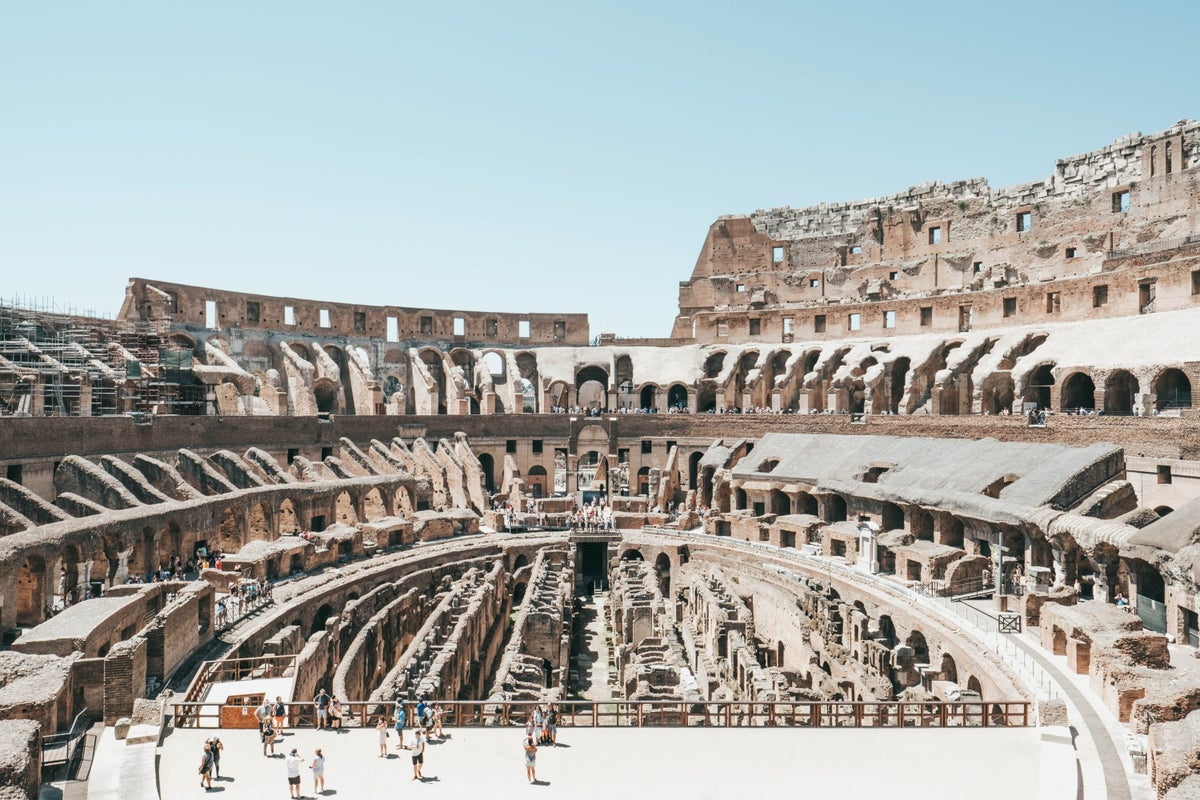
Top 10 Rome Attractions
Here are 10 of the best attractions to visit in Rome.
The Colosseum is usually the top of all tourists’ must-see tick list. It is the largest amphitheater ever built and is situated in the center of Rome. This oval amphitheater is an imposing 157 feet (48 meters) high and is open from 8:30 a.m. – 7:00 p.m. every day. For a standard admission ticket costing $13 (€12), you can walk freely between the Colosseum, the Roman Forum, and Palatine Hill.
The nearest metro station is Colosseo on Line B.
The Roman Forum is the central rectangular space surrounded by the ancient ruins of Rome’s government buildings. This popular tourist attraction is open from 8:30 a.m. – 7:15 p.m. daily, and the admission cost is $13 (€12). However, this is the same ticket as the Colosseum, so if used on the same day, you can access both attractions for 1 ticket price. This is easily achievable as the entrance gate is very close to the Colosseum.
St. Peter’s Basilica is one of the most iconic landmarks in all of Rome. The Italian Renaissance church is situated in an expansive square in Vatican City that dates back to 1506. Tourists can visit St. Peter’s Square and Basilica from 7:00 a.m. – 6:00 p.m. every day except Wednesday. Entrance is free, but if you wish to go to the dome at the top, it’s $11 (€10) by elevator or $9 (€8) on foot.
Take Line A on the metro and San Giovanni station is only a 5-minute walk from St. Peter’s Square.
The Pantheon is now a church but was historically a Roman temple dedicated to all the ancient gods of pagan Rome. Admission to the Pantheon is daily from 8:30 a.m. – 7:30 p.m., except Sundays when the opening times are 9:00 a.m. – 6:00 p.m.
This is a public site that is free to visit and within walking distance of Barberini on Line A of the metro.
The Spanish Steps were initially built to link the Trinità dei Monti church with the Spanish Square beneath in Piazza di Spagna. It is free to visit the Spanish Steps, and it is well worth the climb to view the spectacular church at the top.
You can use Line A of the metro and get off at Spagna station close to Trinità dei Monti church. From there you can take the steps down to the Spanish Square.
The Trevi Fountain is possibly one of the most famous fountains in the world. It is Rome’s largest Baroque fountain, and legend has it that you throw 1 coin into the fountain to ensure another trip to Rome, 2 coins for love, and 3 coins for wedding bells. It is free to visit Trevi Fountain, and it only a 10-minute walk to the Spanish Steps if you are looking to combine sightseeing experiences.
Alternatively, the nearest metro station is Barberini.
The Sistine Chapel in Vatican City is the official residence of the Pope and is a must-see for all tourists when they are in Rome. The chapel dates back to 1473 and hosts the amazing artwork of Michelangelo on the ceiling. The opening hours are 9:00 a.m. – 4:00 p.m. every day except Sundays when the chapel is closed and is only around 5 minutes’ walk from Spagna metro station.
It costs $16 (€14) to enter and visitors should allow 3-4 hours to wander around the rooms.
Piazza Navona is a square that was first built in the 1 st century A.D. and is considered to be one of the largest and most beautiful piazzas in Rome. This is a very popular free tourist attraction with 3 stunning fountains, including la Fontana dei Quattro Fiumi and its imposing central obelisk.
The nearest metro station is Spagna which is just a 5-minute walk away from Piazza Navona.
Galleria Borghese is a famous art gallery which is open between 9:00 a.m. and 7:00 p.m. every day except Mondays and costs $14 (€13) for a ticket. During your visit to Galleria Borghese, you will be able to see beautifully preserved sculptures, ancient mosaics, and paintings that date back to the 15 th -18 th centuries. The museum is set within the Villa Galleria gardens which are free to enter.
The easiest way to travel to Galleria Borghese is by bus which stops within walking distance.
Castel Sant’Angelo was originally built as a mausoleum for the Roman Emperor Hadrian and his family in 135 A.D. It has since been used as a fortress and castle by different popes over the years, but nowadays it is open as a museum. You can visit this amazing example of Ancient Roman architecture every day between 9:00 a.m. and 7:30 p.m., and admission costs $16 (€14).
The easiest public transport for this attraction is a bus from the main center of Rome or metro Line A to Lepanto.
Hot Tip: Looking for more tour and tour information? Explore our guide to the best tours in Rome .
10 Unique and Quirky Things to Do in Rome
Outside of the usual tourist attractions, there are some unique things to see and do. Here are 10 to add to your list.
The Pyramid of Cestius was built in 12 B.C. as a tomb for Gaius Cestius. This pyramid was sealed when built but has since had one of the entrances plundered. The Pyramid of Cestius is open to the public on Saturdays between 10 a.m. and 12 p.m. and only costs $6 (€5.50) to go inside.
The nearest station is Piramide, which is only a 2 minutes stroll from the pyramid — the only attraction of its kind in Rome.
The Ostiense district of Rome is located just to the south of the city center. Here you can view some impressively creative street art across a plethora of urban contemporary artwork and spectacular murals. There are lots to see so allow plenty of time when visiting Ostiense if you want to stroll and appreciate the street art in this area.
The easiest way to travel to Ostiense is by metro and walk from Piramide station.
The Little House of Owls is a quirky museum that some visitors describe as the hidden gem of Rome. Nestled within the ground of Villa Torlonia is this little fairy-tale looking house dedicated to owls. The house is away from the usual touristy sightseeing lists but is well worth the entrance fee of $13 (€12).
The Little House of Owls, also known as Casina delle Civette, is open between 9:00 a.m. and 7:00 p.m. every day except Mondays, and can easily be reached by bus from the city center.
Largo di Torre Argentina is a square which includes 4 Roman Republican temples as well as the famous ruins of Pompey’s Theatre. The excavation work is ongoing and is an inspiring discovery since the 20 th century. It is within Pompey’s Theatre in this square where Julius Caesar was thought to have been assassinated.
This is a public site that is free to visit. Although you can’t directly access the ruins, you can closely view them from the street. There is no metro station nearby, but this attraction is within walking distance of bus stops which run from all main areas.
These ancient underground burial places , or catacombs, can be viewed for only $9 (€8) and there are around 40 catacombs to experience. Some of them were only discovered a few decades ago. Ancient Roman law stated that the dead must be buried outside the walls of the city and these catacombs were built so that Christians could be buried as Christian symbols could be used underground.
The nearest station to the Catacombs is Appia Pignatelli.
Teatro Marcello is a stunning open-air theater which was built in 13 B.C. for Julius Caesar and Marcus Marcellus. In the summer, concerts are held within the ancient theater, and it is a truly magnificent setting which many visitors report to find as breathtaking as the Colosseum.
Ticket prices vary depending on the concerts being held. It is free to walk the perimeter of Teatro Marcello to experience the historic Roman site, which is 85 years older than the Colosseum.
This theater is only a 1-minute walk from Teatro station.
The Capuchin Crypt is a collection of tiny chapels that sit beneath the Santa Maria della Concesione dei Cappuccini church. Here is where the bodies of Capuchin monks were buried, and their skeletal remains are still held. The Capuchin Crypt is open every day between 9:00 a.m. and 6:30 p.m. and the admission fee is about $9 (€8.50).
The nearest station for visiting this attraction is Barberini.
The Appian Way is a historic Roman road built in 312 B.C. Today this is one of the most famous ancient Roman roads where you can walk or cycle (bike hire is available at the site). On average, tourists spend around 6 hours traveling the length of the Appian Way and generally find it to be a peaceful experience just outside the city walls.
It is easy to travel to the Appian Way by bus from Piramide station.
Circo Maximus is an ancient chariot-racing stadium which would have been a major entertainment venue in its day. Situated between Aventine and Palatine Hills, this attraction is becoming ever more popular with tourists visiting Rome.
The remains of this inspiring Ancient Roman architecture form the archaeological site which stands today after fire and flood damage. Circo Maximus is open every day except Mondays and pre-booking is essential as it is for organized tour groups only.
Use Line B of the metro and get off at Piramide station for this attraction.
This is a fantastic way to tour around the historic sites of Rome! These vintage Fiat 500 cars set off in convoy, and you will spend 3 hours driving around Rome. You’ll travel where some larger tour buses cannot access and cruise along the Tiber River. For just $142 (€128) you can be seated inside one of these iconic open-top vintage cars. Tours start from just outside the Colosseum.
Hot Tip: Need a great place to stay? Check out these 15 great hotels in Rome.
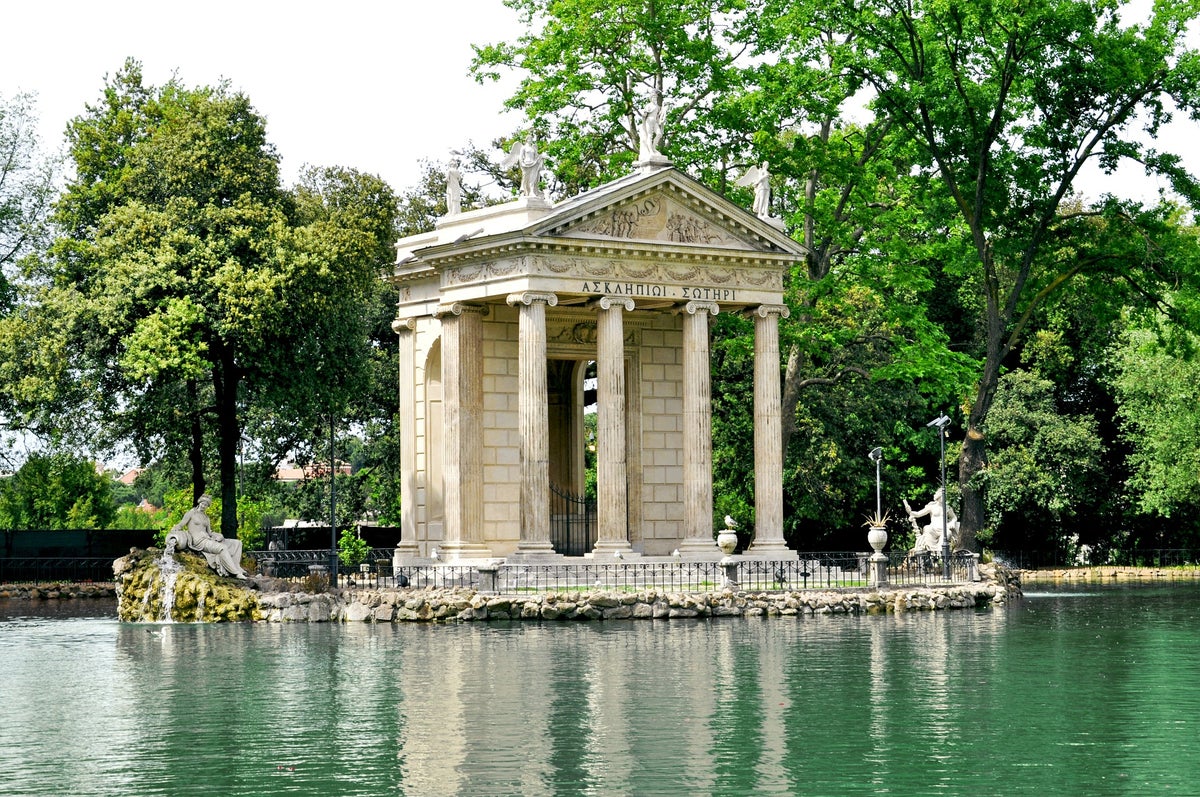
10 Green Spaces and Gardens in Rome
It’s not just about the architecture in Rome. The city is also home to some beautiful green spaces and gardens. Here are 10 of the best.
Villa Borghese is the third largest park area in Rome. It is a landscaped area with English-style manicured gardens. Villa Borghese is open 24 hours a day and is free to explore. This park is situated on Pincian Hill, close to the Spanish Steps, and is known by locals as the “green lung” of Rome. It can be accessed from Spagna or Flaminio stations.
Villa Doria Pamphili is Rome’s largest and most impressive park which was built around a 17 th -century villa, now the sole location for the Italian government. This stunning landscaped park is free to visit and nearby to Termini station. Villa Doria Pamphili is thought to be one of the best places for walking in Rome.
The Botanical Garden, Orto Botanico, is situated in the Trastevere neighborhood. Visitors to these gardens can see over 3,500 species of plants. There is also a rock garden, bamboo grove, “Scent & Touch” visually impaired sensory garden, greenhouses, and the Japanese gardens.
A day spent strolling around Orto Botanico is definitely time well spent. This attraction is open daily from 9:30 a.m. to 6:00 p.m., the admission fee is only $9 (€8), and the nearest metro station is Piramide.
The Gardens of Vatican City are owned by the Pope, and there is public access from 9:00 a.m. – 6:00 p.m. every day except Wednesdays and Sundays. These beautifully manicured gardens can be toured by bus for $36 (€32). This may sound expensive until you realize that the admission ticket also allows you access to the Vatican Museum and Sistine Chapel.
You can take the train to Ottaviano-S. Pietro to access the gardens.
Savello Park, also known as the Orange Trees Garden, is on Aventine Hill, and from this garden, you have the most wonderful views of the city. You can wait in line to peek through the keyhole on the gate of Magistral Villa of the Knights of Malta and view St. Peter’s dome from above. These gated gardens are free to visit and are open from 7:00 a.m. to 6:00 p.m. in winter and 7:00 a.m. to 8:00 p.m. in summer.
Piramide metro station is the closest to the garden gates.
Villa Torlonia and its surrounding grounds are a hidden gem in Rome. You can see magnificent neoclassical architecture set within English-style manicured gardens. Villa Torlonia is open daily from 9:00 a.m. – 7:00 p.m. and admission tickets cost $11 (€10).
Guidubaldo Del Monte is the nearest station to the park.
Parco degli Acquedotti is a beautiful, expansive park within the Appian Way area on the outskirts of Rome. In this park, you can see the ancient ruins of 2 massive Roman aqueducts. This public park is open 24 hours a day, and entrance is free.
Capannelle is the nearest station.
Formerly the Palace of St. Mark, Palazzo Venezia is a spectacular example of Renaissance architecture. The gardens are pretty and open from 8:30 a.m. – 7:30 p.m. every day except Mondays. Admission is $9 (€8.50) and it’s only a 10-minute walk from Termini station.
The grounds of Villa Celimontana are considered by some visitors to be the prettiest hidden gardens of the city. Stroll through these immaculate gardens, which were once a vineyard, and discover the obelisk dating back to the mid-16 th century. This free public park is located just above the Colosseum and is open from 7:00 a.m. until sunset.
Rome’s Rose Garden was formerly a Jewish cemetery that has been constructed in the shape of a menorah. This public park on Aventine Hill is open to the public from April to June, and there’s no admission fee. Allow plenty of time when visiting these gardens as there’s a huge area to cover.
The gardens are just a short walk from Termini station.
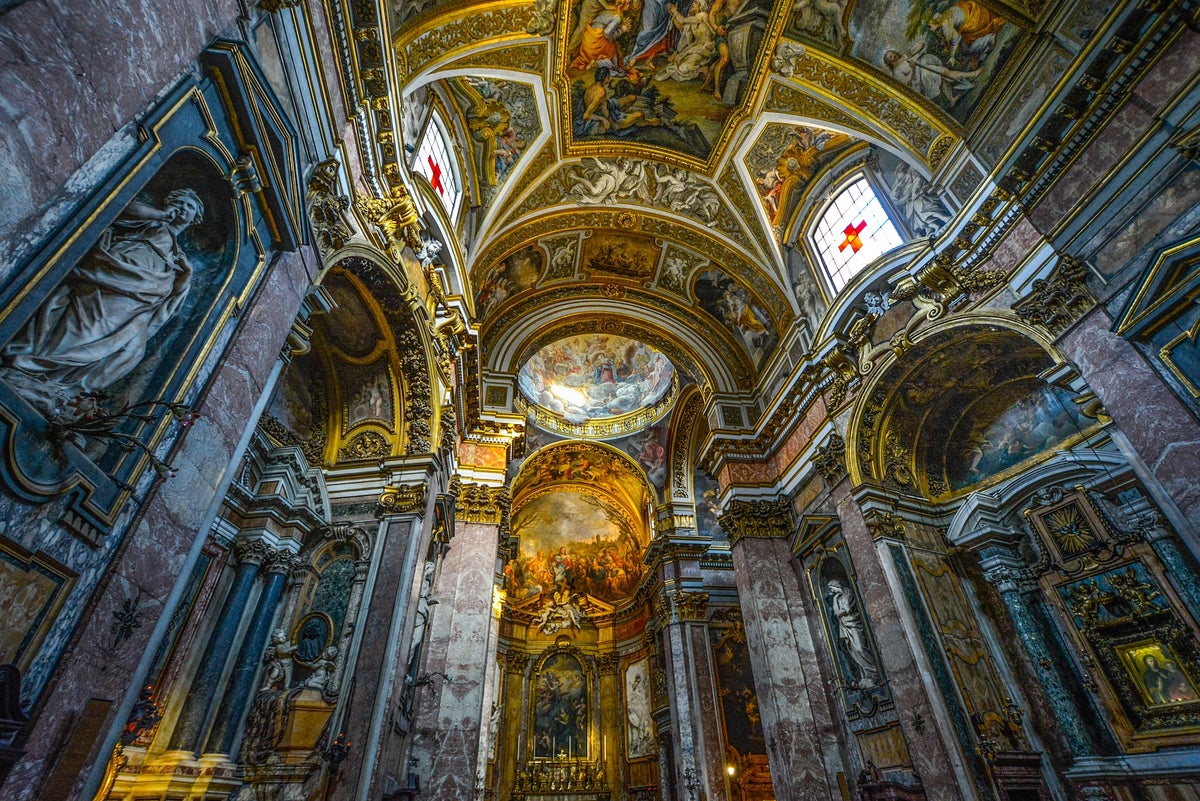
10 Churches You Should Visit in Rome
Rome is home to over 900 churches, so it is a challenge to choose a top 10. Nevertheless, we gave it a go and here are our top picks.
Basilica of Santa Maria del Popolo is a 15 th -century church which sits within Rome’s famous square Piazza del Popolo. Visitors report that this tiny temple is unlike any other church in Rome, with its delightful Renaissance decoration inside. Basilica of Santa Maria del Popolo is open every morning from 7:15 a.m. – 12:30 p.m., then every afternoon from 4:00 p.m. – 7:00 p.m.
The nearest station to the Basilica of Santa Maria del Popolo is Civitavecchia.
Santa Maria in Trastevere (Our Lady of Trastevere) is one of the oldest churches in Rome. There are beautiful mosaics on the exterior, and it is a dazzling sight to behold at night when the tower is illuminated. The church is open to the public from 7:30 a.m. to 9:00 p.m. daily and admission is free.
Santa Maria in Trastevere is only a few minutes’ walk from Mameli station.
Basilica of Santa Maria Maggiore is the largest Catholic Marian church in Rome dedicated to the Virgin Mary. It is breathtaking with a 15 th -century wooden ceiling, a hidden spiral staircase, gorgeous mosaics, and a display of part of Jesus’ crib brought from Bethlehem. It’s open from 7:00 a.m. – 7:00 p.m. daily except Sundays and bank holidays when it is closed in the afternoon.
Basilica of Santa Maria Maggiore is only a short walk from Termini station and admission is free.
Santa Maria in Aracoeli was built in the 6 th century and is still today the designated church of Rome’s city council. It’s a popular church, particularly at Christmas, as inside there is a wooden baby Jesus which is thought to have healing powers. The entrance is free, and the church is open from 7:00 a.m. – 7:00 p.m. daily.
Ara Coeli station is less than 3 minutes’ walk away.
San Giovanni in Laterano is open to the public from 7:00 a.m. – 6:30 p.m. daily. This impressive monumental church was the most influential building within the Christian faith for over a thousand years. Visitors always report that they are amazed by the rich history, art, and architecture of this church.
Use Lines A and C of Rome’s metro for the nearest station, San Giovanni.
Santa Maria Sopra Minerva is a popular church for tourists to visit to take in the heady blend of Gothic and Medieval architecture. It is still one of the major churches in Rome’s Catholic Order of Preachers and this 13 th -century attraction is open from 7:30 a.m. to 7:00 p.m. daily with free admission.
Santa Maria Sopra Minerva is a 20-minute walk from Termini and around the corner from the Pantheon.
Basilica di San Pietro in Vincoli is a Renaissance-style church and basilica that is famous for being home to Michelangelo’s statue of Moses. This Roman Catholic church is open in the mornings from 8:00 a.m. – 12:30 p.m., and then in the afternoons from 3:00 p.m. – 7:00 p.m.
Entrance is free, and this is only a short walk from the Colosseum for tourists wishing to combine experiences.
Santa Maria in Cosmedin is a minor basilica built in the Middle Ages which attracts visitors wanting to see the “mouth of truth” inside the porch. There is also plenty of medieval art to admire throughout the church. The church is open from 9:30 a.m. to 6:00 p.m. daily.
Bocca Della Verita’ station is only 1 minute away and admission is free.
San Clemente is a minor basilica dedicated to Pope Clemente I. This church is considered significant among religious scholars as it outlines the history of Christianity right from the beginning of the faith through to the Middle Ages. This temple is decorated internally with old mosaics and is open to the public from 9:00 a.m. – 12:30 p.m. and then 3:00 p.m. – 6:00 pm.
The church is a short walk from either Colosseo or Manzoni stations.
Saint Paolo Fuori le Mura Basilica is one of Rome’s 4 major basilicas and is located outside the city walls. This 9 th -century church with Neoclassical architecture is a popular year-round tourist attraction. Saint Paolo Fuori le Mura Basilica is open daily from 7:00 a.m. – 6:30 p.m.
Saint Paolo Fuori le Mura Basilica is easily reached via the bus network service.
10 Shopping Areas & Markets in Rome
Rome is a fashionista’s dream, but it’s not all high-end fashion. The city is home to some great markets, too. Here are 10 of the best places to shop.
Packed full of beautiful designer big name brands including Gucci, Dior, and Dolce & Gabbana, Via Condotti is the place to be for the largest selection of designer outlet shopping in all of Rome. It is an absolute must for lovers of designer Italian leather handbags and upscale fashion and accessories. The pedestrian walkway is also dotted with cafes and restaurants for regular shopping breaks.
This retail heaven can be found close to the Spagna metro station.
As one of the most popular shopping spots in the city of Rome, the Via del Corso is home to designer dresses and big brand fashion. Offering affordable fashion at its finest, you will find some of the most highly regarded names in Europe here including H&M, Zara, and Sephora.
You can easily walk to Via del Corso from the Spagna Metro station, or bus lines 170 and 175 both stop close by.
The Via Cola di Rienzo is the main thoroughfare that cuts through Rome’s Prati neighborhood. It is also one of the very best destinations in the city for laid-back, leisurely shopping with fewer crowds than some of the more upmarket areas. The Via Cola di Rienzo offers an impressive blend of international brands like Coin, Tiffany’s, Kiko, and Diesel, as well as a wide variety of bars, cafes, and restaurants.
Close to the Cola Di Rienzo/Terenzio subway stations, the Via Cola di Rienzo is a great place to explore after visiting the Vatican.
Porta Portese is the biggest flea market in Rome and is the perfect place to enjoy a lazy Roman Sunday strolling through the ancient streets of the Trastevere district. Cheerful vendors offer a wide selection of secondhand clothing, antiques, brand name knockoffs, bric-a-brac, household products, vinyl records, and much more. The market is just as popular with the locals giving it a truly continental feel.
The nearest station is Porta Portese.
Tucked away behind the city gates close to the cathedral of San Giovanni in Laterano lies this enchanting outdoor market that is perfect for those who are happy to rummage for bargains. Vendors show their wares on old tables and tatty looking stalls, but for those who have the patience to sift through the piles of stock, the rewards can be incredible. Secondhand and vintage designer gear by the bucketload is here — you just need to find it first.
Surrounded by super cool cafes and record shops, the nearest subway is San Giovanni.
Via del Babuino is a historic cobbled street that connects Piazza di Spagna and Piazza del Popolo. Chock full of beautiful old buildings, it is also one of the city’s premier upmarket shopping districts. This elegant pedestrianized thoroughfare is dotted with luxury brands including the likes of Armani Jeans, Tiffany, Tory Burch, Gente, Maison Margiela, and Valentino.
This is a great place to have a latte while enjoying a spot of people-watching; the nearest station is Spagna.
Via Giulia has some of the city’s finest examples of authentic Roman architecture and is an utterly enchanting place to spend the day. Via Giulia is also a residential area for rich Romans, meaning that there are plenty of fantastic independent shops that line the cobbled street. These include art galleries, antique shops, and quirky homeware stores, as well as fashion boutiques, bars, and cafes.
You can reach this part of town using the Circo Massimo station.
Just off the Piazza Navona, the Via del Governo Vecchio offers something for everyone. From the super cute secondhand book stores and biggest vintage clothes shops in the city to the modern-day fashion boutiques and grocery stores, this a popular part of town with a great atmosphere. Take a stroll along the cobbled street until something takes your fancy, then sit back and relax in one of the many coffee shops and bars.
The nearest subway station is Chiesa Nuova.
Set at the heart of the Piazza del Popolo, Flaminio Market is packed full of cool market traders selling pre-owned and vintage clothing, accessories, and jewelry. This is one of those flea markets similar to those you find in many European cities, but this being Rome, you are likely to come away with a pair of pre-loved Gucci sunglasses or a Fendi bag.
Set in a bus station, there is an entrance fee of $2 (€1.60), and you can get there using the 88, 204, or 231 buses or trams 2 and 19.
Nestled between the Tiber and the Via del Corso, the Fontanella Borghese Market is a gorgeous piazza market that offers a selection of bijou box shops. These sell a variety of small antiques including antique maps, etchings, posters, books, photographs, and even cameras. The area is always popular with tourists, as the wares on sale are usually just the right size to bring home.
The nearest station to the market is Spagna.
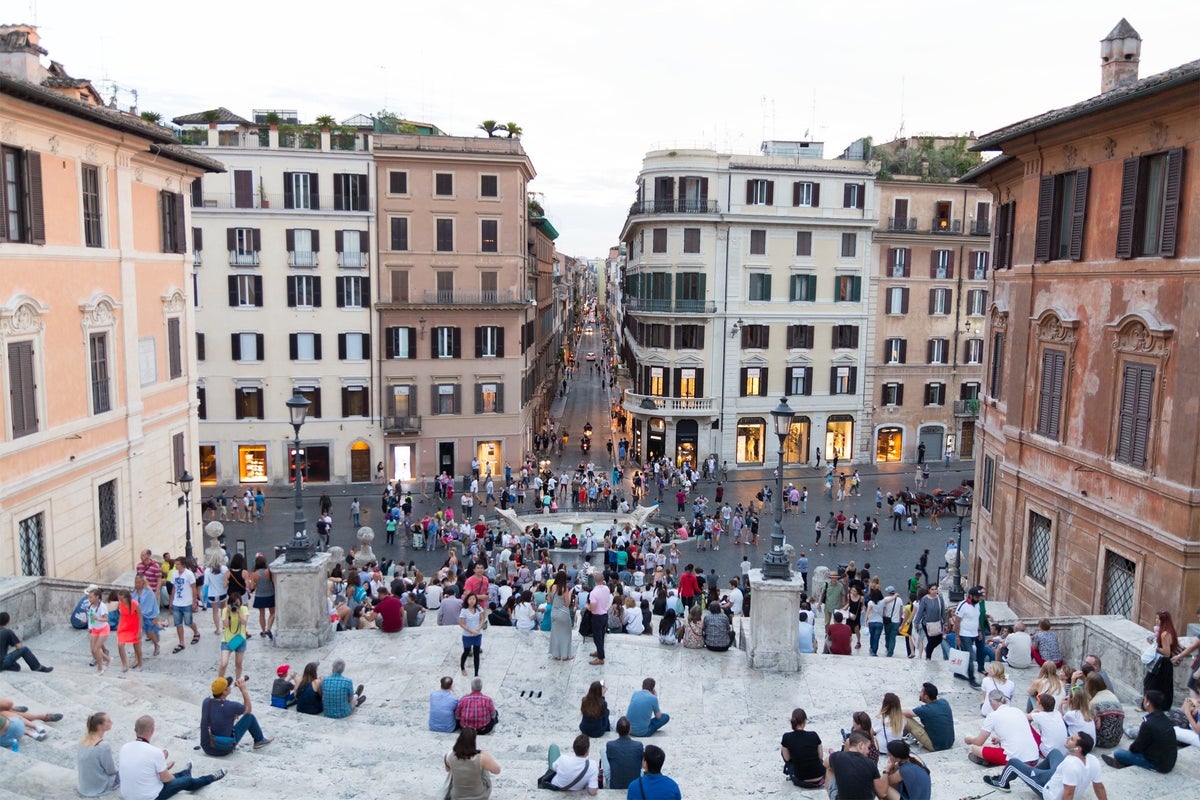
House Wine is the Best Wine
When in Rome, drink like the Romans. In a city that appreciates fine wine, the house bottle or “vino della casa” is often as good as, if not better, than more expensive brands. Buy it by the glass or share a carafe or 2 with friends old and new.
Experience the Culture for Free
On the first Sunday of each month, some of the best museums and archaeological sites can be enjoyed for free. If you are on a tight budget, plan your dates accordingly, and visit world-famous sites like the Colosseum, the Roman Forum, and the Galleria Borghese for free. Read our comprehensive guide to discover some of the best museums in Rome .
Be Travel Savvy With Taxi Drivers
The city of Rome operates and enforces set fees for most taxi journeys to, from, and within the city walls. Taxis registered outside of the city are not bound by the same rules but can travel the same routes. This makes it easy for unsuspected tourists to be stung with huge fares. Always check your taxi fares before you begin your journey.
Imparare a Parlare Italiano (Learn to Speak Italian)
Learning a few key phrases and common words will not only help you in everyday situations, but it will also help to ingratiate you with the locals. Learn a little before you leave, and take a phrasebook with you.
Go C ontinental
Much like the French, the Italians are famous for their love of late-night meal times. 8:00 p.m. is a good starting point for eating your evening meal, but be prepared to enjoy long, laid-back affairs that last well into the small hours.
Travel Light
When wandering around the city, leave your super-size backpack back at the hotel. European cities tend to get very crowded, and most tourist attractions will ask you to check bulky bags in the cloakroom. Keep your money, phone, camera, and other essentials close at hand with a fanny pack , sling backpack , or mini backpack instead.
To Tip or Not to Tip?
Most restaurants in Italy will automatically apply a “service charge” to your bill. If you are in a smaller cafe or independent restaurant, you may like to leave a few euros for your waiter as you leave. The same rules apply to taxi drivers and bartenders, too. Tipping is not necessary, but of course, no one will complain if you do.
Cash is King
Rome is a city with plenty of ancients wonders to see, and in some places, this even extends to your payment options. To avoid being caught out, be sure to carry enough cash on you to pay for your entry tickets to attractions, as well as food, drinks, and any travel while you are away from your hotel.
Look Out for Fake Gelato
Even here in Italy, not all gelato is created equal. Being one of the most refreshing and delicious national dishes you will ever taste, it is important that you find an authentic scoop or 2. The brightly colored, fluffy looking ice cream served across town is often packed with artificial colors and sweeteners.
Real gelato, however, takes its color and flavor from the ingredients within it. As a rule of thumb, compare your frozen treat with how it would appear if the ingredients were blended.
Enjoy a Drink at the Bar
Italians have a unique way of enjoying their coffee, and they see it simply as fuel to keep them going. If you would prefer to sit down and relax with a hot coffee and a good book, you are welcome to by all means, but be prepared to pay extra for the privilege.
Take the Day Off
Monday is considered a day of rest in Rome, and many of the city’s main attractions and restaurants will be closed to the public. When planning your next trip, be sure to make the most of the weekend, and save Monday for shopping or visiting local parks and open spaces.
Drink from the Water Fountains
Usually, when you go overseas, you are advised not to drink the water, but here in Rome, the “nasoni” fountains provide thirsty travelers with fresh drinking water that flows from the aqueducts. Stay hydrated for free by topping up your water bottle as you go.
Avoid the Busiest Times
The Vatican Museums are the most popular in all of Italy, and they get very busy from the moment they open. Ignore the advice of those who tell you to get there early, and instead, wait for the rush to die down before visiting. On a Friday the museums are open late, so why not enjoy a late afternoon or evening tour instead?
Keep Covered Up
In most of the ancient churches and buildings in the city, including St. Peter’s Basilica, the Vatican Museums, and the Sistine Chapel, you will need to be covered up to be allowed entry. Although it can get super hot outside, carry a shawl or scarf with you to cover your knees and shoulders when you need to.
Finally, Bring Your Own Toilet Paper
Roman toilets aren’t great. Often they will be without toilet seats, and toilet paper will be in short supply. Sometimes you will even have to pay for the privilege of using these less than perfect facilities. Keep a stash of toilet paper or wipes in your bag at all times — just in case.
10 Fun Facts About Rome
The Eternal City receives millions of tourists every year, many of whom come to see some of the most iconic and religiously important landmarks in the world. But aside from the stunning architecture, the fantastic food, and amazing Italian weather, there are lots of interesting facts about Rome that you may not know about:
Legend has it that the ancient city of Rome was founded by 2 twin brothers, who fought over who should be the rightful ruler. Believed to be the sons of a mortal priestess, Rhea Silvia, and the Roman god of war, Mars, they were always destined for battle. In a moment of fury, Romulus killed his brother and gave the name Rome to his beloved city.
Millions of visitors come and throw their coins into the Trevi Fountain every day. It is believed that if you throw your coin over your left shoulder using your right hand, you will return to Rome in the future. Other legends also claim that you should throw 3 coins into the fountain. Over the course of a day, around 3,000 euros are thrown in.
Thanks to the aqueducts beneath the city, Rome is full of fountains that offer potable water. Called “nasone” fountains, there are between 2,500-2,800 nasoni in Rome, and they supply citizens and tourists alike with free drinking water throughout the city.
If you love fountains, you certainly won’t be disappointed in Rome. There are 50 named monumental fountains and hundreds of smaller fountains dotted across the city. There are believed to be over 2,000 fountains, which is way more than any other city in the world.
Italy is home to some of the most delicious coffee in the world. But did you know that in the city of Rome, local tradition dictates that you should never drink cappuccino either after 11:00 a.m. or after a meal? This is because the Romans believed that milk impairs the digestion and therefore should only be used sparingly.
Tucked away at the Knight of the Malta gate on Aventine Hill, there is a tiny door that you wouldn’t even notice unless you were looking for it. Rumor has it that if you peek through the keyhole, you will see the Vatican perfectly in line with the garden beyond. From this also unassuming viewpoint, you can gaze across 3 entirely different countries all at once — Malta, Italy, and the Vatican City.
Just outside the Vatican lies the Castel Sant’Angelo. This pretty looking castle is chock full of beautiful rooms and elegant frescoes, but buried deep in the castle walls is a secret passageway that runs all the way into the Vatican. Popes used the secret tunnel when they felt they were in danger.
Rome is home to hundreds of wild cats that sit on the walls of the Colosseum and sleep among the ancient ruins of the Forum. There is also a dedicated cat sanctuary housed among the ruins of 4 Republican temples at Largo de Torre de Argentina. The feline population is so dense because there is a law in the city that allows cats to live without disruption in the place where they were born.
Rome is home to one of the earliest shopping malls in the world. Between 107 and 110 A.D., Emperor Trajan built the Mercati di Traiano (Trajan’s Market), where a wide range of grocery items was sold across different levels. Modern-day Rome is still home to some of the very best shopping districts and flea markets in the world.
Rome is home to a dedicated pasta museum that is devoted to the history, production, and nutritional values of Italy’s favorite foodstuff. Visitors can learn everything from optimum cooking times and recipe advice through to pasta-related artwork and exhibits on pasta-making techniques throughout the ages.
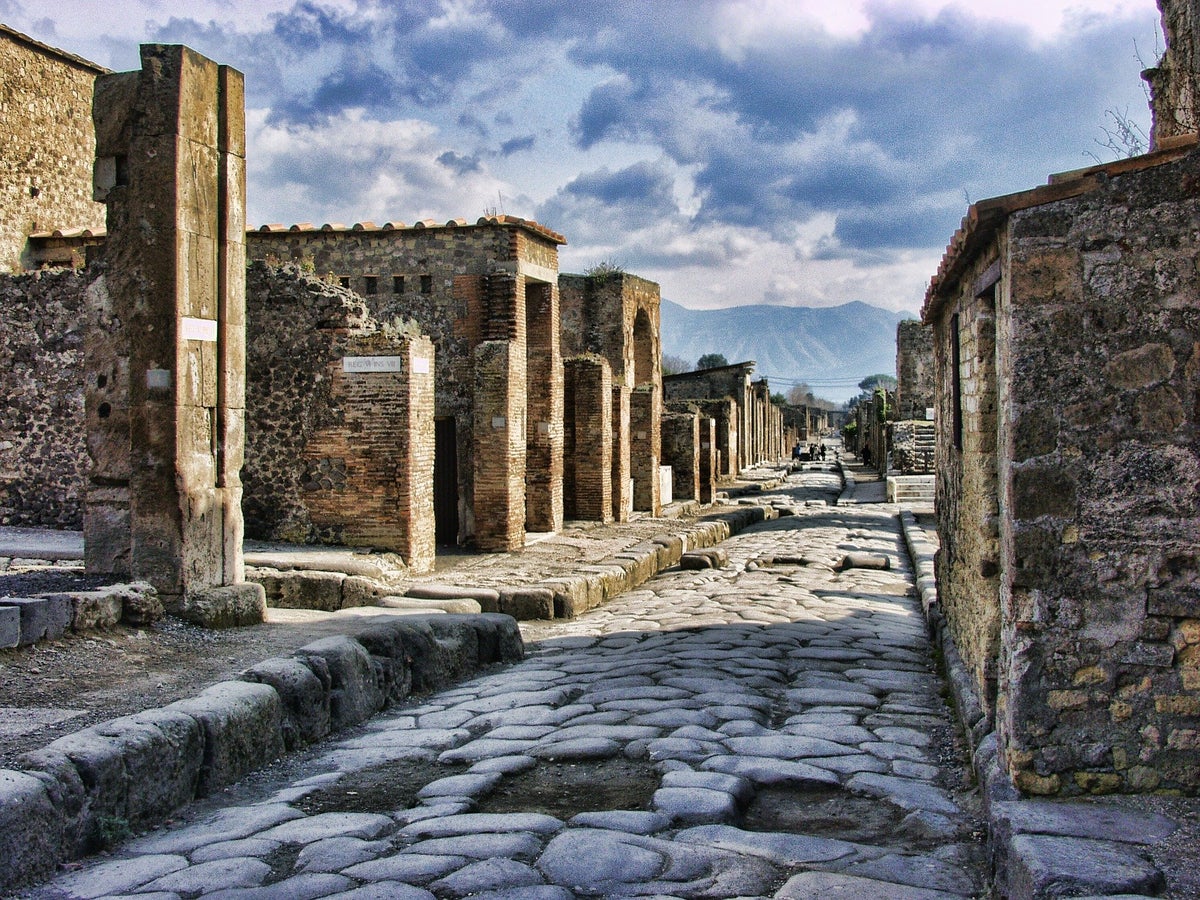
Top 5 Day Trips From Rome
What was once the most important harbor city in Ancient Rome is now an important archeological site and popular tourist destination. Located just 19 miles west of Rome, Ostia’s main arterial street is home to a street show of houses, shops, baths, and taverns. The city is also home to a Jewish synagogue, a Christian Basilica, and a wealth of Persian temples.
You can get to the ancient harbor city by taking the 20-minute journey from the metro Line B station of Piramide to Ostia Antica using the Roma Lido commuter train. The Roma Lido line runs from around 5:30 a.m. until 11:30 p.m., and you can reach Ostia using a travel card costing from as little as $2 (€1.50), depending on the time and duration of your visit.
The ancient city of Pompeii was famously buried by the 79 A.D. eruption of Mount Vesuvius. Visitors come from all over the world to see the perfect example of ancient Roman communities anywhere in Italy . Ruins include the Antiquarium, the Forum, the Terme Stabiane, the House of Menander, the Amphitheater, and the Nuovi Scavi (New Excavations), among others.
Pompeii is 133 miles from Rome, and the train journey from the city takes around 1 hour and 50 minutes. You can reach Pompeii Scavi-Villa dei Misteri station using the Circumvesuviana line that departs from the main Roma Termini station. Ticket prices start from as little as $19 (€17) depending on the time of travel.
Hadrian’s Villa is a UNESCO World Heritage Site and an impressive archaeological complex located in Tivoli, 18 miles east of Rome. Considered to be the most remarkable and extravagant example of an ancient Roman Villa , it was built for Emperor Hadrian when he decided that he no longer wanted to reside in the city of Rome itself.
The giant structure contains a variety of interesting structures including the Nymph Stadium, the Poecile, the Camopus, the Philosophers’ Room, Piazza d’oro, the Grandi Terme, and the Piccole Terme.
You can reach the Villa by taking the Trenitalia line from Tiburtina Station (also on the metro B line) and enjoy a 40-minute ride on the Avezzano bound line. Get off at Tivoli Station to visit the Villa and surrounding attractions. Tickets cost from around $6 (€5).
The pretty, hilltop town of Orvieto is one of the most ancient cities in Italy, and home to some of the most important vineyards in the country . Visitors make the journey from Rome out into the Umbrian countryside to admire the impressive Piazze del Duomo, explore the grottos and rock formation of underground Orvieto, peek into the well at Pozzo di San Patrizio, relax by the fountains at Fortezza dell’Albornoz, and sample the fantastic wines at Decugnano dei Barbi.
The train journey from the city of Rome to Orvieto takes around 1 hour 30 minutes, and you can pick up the Trentitalia Line from Roma Termini. Tickets start from around $8 (€7) for a single journey.
Naples is a UNESCO World Heritage site that dates back as far as 470 B.C. It is also home to 3 amazing castles: Ovo Castle with its imposing fortress, Castel Nuovo with its Medieval towers and Renaissance arch, and the Castel Sant’Elmo with its former prison. Visitors also come to see the Royal Palace of Naples, the Palazzo Reale, and a wealth of historic churches and cathedrals.
Naples is around 140 miles from Rome, so expect a 2-3 hour train journey to reach the city from Rome. The Frecciarossa Express runs from Roma Termini to Napoli Centrale every 20 minutes at peak times, and ticket prices start from $26 (€23), one-way.
How to Stay Safe in Rome
Rome is an enchanting city that can reel you in from the moment you take your first steps out on to the cobbled streets. Whether you are enjoying a drink in one of the many piazzas, taking in the incredible architecture, or simply enjoying some retail therapy, it can be easy to get carried away here.
While Rome is not necessarily any more or less dangerous for tourists than any other European city, it can be easy to become distracted. Follow our advice on how to stay safe in The Eternal City, and breathe it all in without worrying about your belongings.
Rome does have a high number of pickpockets operating in the main tourist areas during the high season. Roman pickpockets are very skilled and have numerous tricks to help relieve you of your belongings. Be aware of distraction techniques such as flower sellers, gangs of children, and even ladies in distress, and be sure to keep your bag in front of you at all times.
This is common sense for any large town or city, and it is just as important here as it is anywhere else. Keep your wallet, phone, and cards locked safely away in your purse, fanny pack, or shoulder bag, and do not flaunt them when you need to use them. Better still, use a money belt or body pouch for days out in the city, to help you keep your belongings safely by your side at all times.
Urban spaces, riverbanks, and deserted piazzas may look romantic in the daylight, but they can become menacing and oppressive when the night falls. Some streets around Termini and Piazza Vittorio, in particular, are not safe for strolling tourists after dark. Likewise, some stretches of the river are not as safe at night as they would be during the day.
If your plane ticket, passport, personal ID, or other important document goes astray while you travel, it can make things extremely difficult for you. If you are able to make and store electronic copies of all of your important documents, either by email or your smartphone camera, you will always have a back up should you need them.
Should the worst happen, you will probably want to call the police. Make a note of the following telephone numbers and keep them safely with you while you travel:
- General Emergency: 113
- Police (Carabinieri): 112
- Fire (Vigili del fuoco): 115
We aren’t telling you how to dress with this one, simply suggesting that you keep your maps, travel cameras , and large amounts of cash out of sight while you are on the road. This will make you look more like a local and less like a tourist.
Most hotels will offer a safe facility in their guest rooms. These are important because it means your belongings are safe and sound and you don’t need to take all of your stuff with you.
Rome is perhaps one of the most beautiful and romantic cities in the world. With so much history right on your doorstep, it can be challenging to take it all in the first time you visit.
From the historic architecture and works of art to modern-day fine dining and upscale shopping, Rome really is a city that has it all.
Frequently Asked Questions
Is rome safe.
Rome is as safe as any European city but you should be extra vigilant of pickpockets in tourist areas. Avoid carrying your valuables on your back, consider using a money belt, or better yet, only take the bare minimum out with you and leave the rest in your hotel safe.
Can you do Rome in 3 days?
There is a lot to see and do in Rome but you can certainly see the highlights over a weekend. Luckily most major sights and attractions are quite close together. While it comes down to personal preference the following are not to be missed:
- Spanish Steps
- St. Peter’s Basilica
- Vatican City
What are the best day trips from Rome?
There are quite a few places that are within easy reach of Rome and if you’re willing to travel an hour or 2 each way, these can be visited within a day.
- Hadrian’s Villa
Was this page helpful?
About Amar Hussain
Amar is an avid traveler and tester of products. He has spent the last 13 years traveling all 7 continents and has put the products to the test on each of them. He has contributed to publications including Forbes, the Huffington Post, and more.
INSIDERS ONLY: UP PULSE ™

Get the latest travel tips, crucial news, flight & hotel deal alerts...
Plus — expert strategies to maximize your points & miles by joining our (free) newsletter.
We respect your privacy . This site is protected by reCAPTCHA. Google's privacy policy and terms of service apply.
Related Posts
![wiki travel rome The Ultimate Guide to Buying the Best Travel Insurance [For You]](https://upgradedpoints.com/wp-content/uploads/2018/09/Travel-insurance-tag-on-luggage.jpg?auto=webp&disable=upscale&width=1200)
UP's Bonus Valuation
This bonus value is an estimated valuation calculated by UP after analyzing redemption options, transfer partners, award availability and how much UP would pay to buy these points.

Complete Rome Travel Guide: A Local’s Way To Discover Rome
With thousands of years of history, Rome has a huge amount of things to do whether it’s your first time or you have already been and would like to discover more and go beyond the touristy. Known as the eternal city for some 2000 years, Rome is famous for its well-preserved archaeological sites, Renaissance art and architecture, beautiful churches, and fantastic food.
Whether you should book a private Rome tour or explore the city on your own, it’s totally up to you. With this Rome travel guide, I’m aiming to give you all the tools you need to travel independently, to decide what is best to see and do within the time you have at your disposal, to get around if you have a baby or entertain your toddler, to know where to eat and how to use the public transport.
Too much information altogether? It is, but it’s all packed in a way that you have all the essential bits and pieces you need to kick off your trip planning. Of course, throughout the website, you will find everything in more detail. Planning a trip to Rome is an exciting thought but it can also be overwhelming for all the things to do and remember. We don’t leave you alone, our Rome travel guide will help you all along the way!
Table of Contents
All you need to know before visiting Rome: The ultimate Rome travel guide
Where is rome.
The capital of Italy since 1870, after the unification, and of the Latium region, Rome lies in the center of the country on the western coast of the “boot” lapped by the Tyrrhenian Sea. It takes an hour and a half to reach Florence by high-speed train, an hour and 15 minutes to reach Naples, three hours and 40 minutes for Milan and four hours to Venice.
If you are traveling around Europe by train and are including Italy in your itinerary, you can consider a handy Eurail pass to reach Rome and many other cities. Check out this complete guide on how to use Eurail Pass .
If you have rented a car, you can make easy day trips in the Lazio region as well as get to the Tuscany countryside or less touristy regions like Umbria or Abruzzo.
What is Rome famous for?
Depending on your passions, the first thing that comes to a traveler’s mind when hearing about Rome might be the Colosseum or its hearty culinary traditions. If you are a foodie, you are already inquiring what are the most popular Roman dishes and where to eat them. If you are a history buff, you have probably already booked your ticket to the city’s archaeological parks or the Vatican Museums.
To pin down what Rome is famous for in only a paragraph is pretty challenging. Think aristocratic Renaissance palaces, narrow winding alleys, all-natural artisan gelato, the Pope, designer shopping streets, the Spanish Steps , gorgeous piazzas , and fountains such as Fontana di Trevi , ancient Basilicas and so much more.
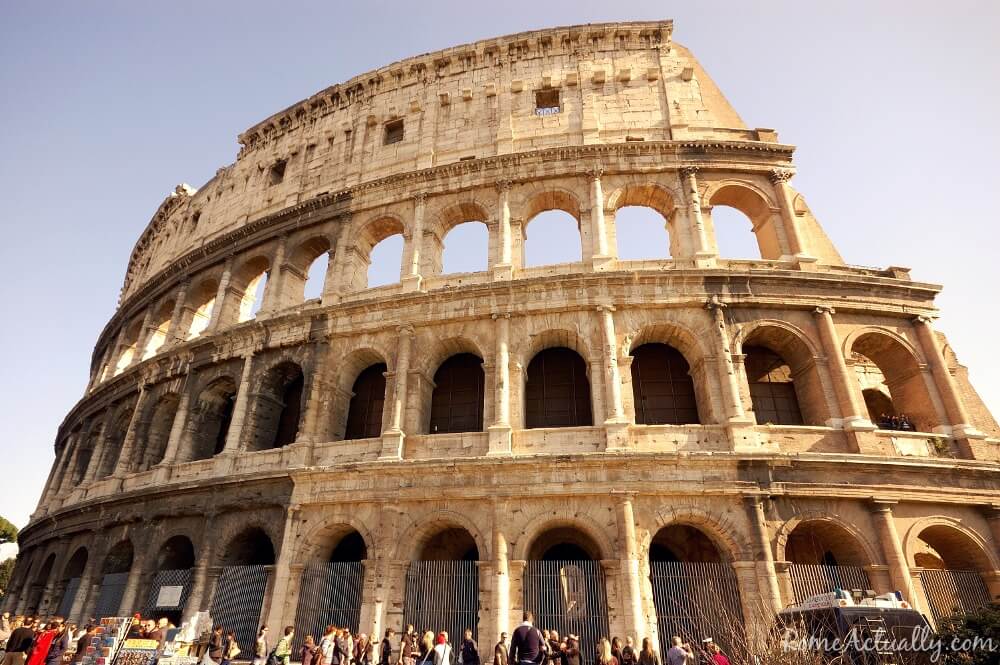
Why is Rome called the Eternal City?
Oftentimes, Rome’s eternal city moniker is assigned to the 2nd-century emperor Hadrian who would have said: “other Romes will come, whose forms I see but dimly, but whom I shall have helped to mold. When I was visiting ancient cities, sacred but wholly dead, and without present value for the human race, I promised myself to save this Rome of mine from the petrification of a Thebes, a Babylon, or a Tyre. She would no longer be bound by her body of stone, but would compose for herself from the words State, citizenry, and republic a surer immortality. […] She would endure to the end of the last city built by man.”
However, this is not what the emperor said in reality but a passage from Marguerite Yourcenar’s famous book “Memoirs of Hadrian”. In fact, the term eternal city applied to Rome had been already in use for centuries.
The first time we know Rome was referred to as the eternal city was by Latin poet Albius Tibullus (born c. 55 bc—died c. 19 bc) in his second book of elegiacs, and after that, so many have used the term that it became famous and somehow Rome’s own title, even though also other cities have been called this way, including Jerusalem and Kyoto.
When is the best time to visit Rome?
In our Rome travel guide, we are also going to suggest when to visit. Italy has four seasons and each of them is good to visit Rome. Usually, the summer months are the hottest and count the biggest crowds of tourists lined up to enter the city’s landmarks.
This is obviously because most people have their holidays in July and August, but if you can, the Springtime between April and June is probably the most pleasant to wander around, with the cold temperatures just gone and the blazing heat not yet here. If you are traveling in spring, check out our detailed guides to visiting Rome in March , April , and May .
When you are out sightseeing in Rome, a good amount of walking is involved, and doing it under a scorching sun can prove pretty challenging.
Fall, from September to around mid-November, is also a nice time to visit Rome, even though you can expect some showers and the first post-summer thunderstorms.
Don’t miss our tips on what to wear in Rome in November !
What Rome airport to fly into and from?
Rome has two airports, Leonardo Da Vinci International Airport in Fiumicino and the military airport in Ciampino. Which Rome airport is closer to the city? Probably Ciampino is slightly closer to Rome, but Fiumicino is very well connected, so the transfer time is really not much of an issue when booking your flight to Rome.
Ciampino is mainly the airport used by low-cost airlines such as Ryanair, but now these land in Fiumicino, too. While Ciampino is a small airport with limited options of shops and places to eat, Fiumicino airport is huge and features all types of stores, from technology to clothes to accessories, as well as a diverse restaurant scene that really accommodates every taste and preference.
How to reach Rome from the airport?
From Fiumicino’s airport, you can train either the train (faster and slightly more expensive) and the coach (cheaper and slower). There are two different trains you can take in Fiumicino to reach Rome.
Leonardo Express is the direct train to Termini, it doesn’t stop anywhere else, it reaches in half an hour and costs 14€. The regional train stops at every station, including Trastevere, Ostiense and Tiburtina, it takes 27 minutes to reach Trastevere, 31 to Ostiense, 47 to reach Tiburtina, and it costs 8€.
Coaches are cheaper and take longer as they drive through the traffic. In the GRA, the ring road around Rome, there isn’t always much traffic, but once inside the city, it can get pretty crazy depending on the hour.
Single tickets are around 5€ but every company has different fares and timetables, so it’s better to check directly on their website. Some of the most popular companies are Cotral , Schiaffini and Terravision . If you are flying with Ryanair, you can purchase your Terravision ticket on board.
Ciampino is a smaller airport and it can be reached only by bus, so it takes a bit longer. The companies are also Terravision and Schiaffini. From Ciampino, you can also take Atac urban bus to reach the metro station Anagnina
What to pack for Rome?
Italy has four seasons, so depending on when you are traveling, you will pack for Rome differently. Traveling to Rome for Christmas ? Definitely pack warm clothes, an umbrella, a winter jacket, and warm shoes or boots. On the other hand, if you need to pack for Rome in summer , don’t forget your swimsuit for a nearby beach or the pool of your hotel, sunscreen, light t-shirts, and shorts or light long trousers that you might need when on a tour in the Vatican .
In Rome, you can find pretty much everything, but if there are things you know you are going to need as soon as you arrive and don’t have time to look for a shop, I say pack a small version of it and then buy it in Italy when you run out.
What to wear in Rome?
There is no particular dress code in Italy, so in Rome, you can wear pretty much what you fancy and what you usually wear at home.
If you are visiting the Vatican or other churches, however, you will be asked to wear modest clothes, which will mean long trousers, light if it’s summer, long skirts, and t-shirts that cover the shoulders, so no sleeveless shirts even if outside it’s stifling hot. In case you are wearing a sleeveless t-shirt, when you enter a church, it will suffice to cover your shoulders with a shawl. Inside, it’s usually pretty fresh so don’t worry about feeling too hot.
Usually, there is no dress code to go to a restaurant or club, although some might prefer you to avoid flip flops, Bermuda shorts or sleeveless t-shirts for men. If there is a specific occasion where a dress code is required, organizers will make it clear, but usually, a smart outfit gives you access in most places.
Where to stay in Rome?
When looking for the best area to stay in Rome , you should keep in mind the purpose of your trip. Are you coming for a sightseeing holiday? Book your hotel in central Rome or Monti area to reach all the main landmarks easily. Do you like to experience traditional Rome and lively nightlife or bars and pubs? An accommodation in Trastevere is probably your solution.
Districts like Ostiense , Garbatella , or Trionfale/Monte Mario will probably have cheaper rates and are well connected to the city center, so if you are in Rome for more than three days and can take the time to use the public transport, it might be worth saving some money.
While most of the best hotels in Rome are probably around the historic center, in other areas you can find cozy places to stay that can meet your budget and needs. Even some accommodation options around the Vatican contemplate some pretty nice apartments and are close to public transport and handy shops and grocery stores/markets.
Public transport or car rental in Rome?
If you decided to book your hotel room or apartment slightly away from the city center, you can either take a daily walk or, if it’s really too far from your destination, rely on Rome’s public transport system . Consisting of buses, trams, trains, and metro, the local system is quite widespread and efficient, especially when connecting to central neighborhoods.
If you prefer to drive in Rome , you need to pay attention to the large ZTL, limited traffic zone, because fines are pretty hefty. If you are only staying in Rome, probably it’s not convenient, but if you are thinking about visiting also other regions and straying far from the big cities to enjoy some countryside, renting a car is your best bet.
In Rome, you can book a hotel that is not in the city center so you won’t be entering the ZTL and you will also have the chance to find better parking if your hotel doesn’t provide one. Staying in an area that is not in the immediate city center might also increase your chance to find much cheaper Rome accommodation .
What to eat in Rome?
Roman traditional dishes are hearty and don’t make for a light meal. Pretty meat-centric, you can also find delicious fish and seafood recipes as well as delicious side dishes such as sautéed chicory with garlic and chilli pepper, ( carciofi alla giudìa or alla romana) Roman-style artichokes and the fresh “puntarelle” (a very crunchy form of chicory) when in season.
If you are not a vegetarian or want to try the local dishes, you can start with some pasta options such as bucatini all’amatriciana , tonnarelli cacio e pepe , or spaghetti alla carbonara. As the main course, you will often find coda alla vaccinara (oxtail stew), saltimbocca alla romana (veal cutlet topped with cured meat and sage), filetti di baccalà (dried and salted codfish pan-fried). Sometimes also quinto quarto , which can be considered more of an ingredient as it’s made with the offal of a butchered beef or sheep.
If you want to stay traditional but give the meat a break, you can order the delicious fettuccine ai funghi porcini (egg pasta with porcini mushrooms) or the above-mentioned tonnarelli pasta with cacio cheese and black pepper.

Where to eat in Rome?
Our Rome travel guide couldn’t miss suggesting great places to eat. Of course, we have our favorite restaurants in Rome that we’ve been to over and over again, but there are many that we are still waiting to try.
Some of the places we have enjoyed many times and don’t hesitate to recommend are Felice A Testaccio near the Cestia Pyramid and the non-Catholic cemetery , Ginger Sapori e Salute in one of their restaurants either near the Pantheon or Via del Corso, Il Margutta vegetarian restaurant in Via Margutta, Trattoria Pennestri, delicious restaurant in the Ostiense area .
When I want to eat strictly plant-based, Romeow Cat Bistrot in Ostiense is my go-to and one of my very favorite vegan restaurants in Rome together with Ma Va?, also a vegan restaurant but in the Prati area, a neighborhood I always like to visit and where I used to live.
If you are a fan of street food, Rome offers this too in the form of supplì, pizza by the slice and the famous Trapizzino , which you can find in a few neighborhoods including Testaccio and Trastevere .
Pizza by the slice can either be a quick morning or afternoon snack or even an easy lunch on the go, and some of the best places for pizza in Rome include Pinsere in the Trieste neighborhood and the fantastic Pizzarium by Bonci in Prati near the Vatican Museums.
Where to find the best gelato in Rome?
Not to be confused with the fatter American cousin “ice-cream”, Italian gelato is a whole different deal. Creamy just enough and flavourful, it’s been quite a while that Romans have been demanding always more quality when it comes to their scoops.
So now, when you buy your gelato in Rome , you can (and should) expect an all-natural, chemical-free, additive-free sweet goodness in many flavors from all types of fruits to nuts in the most original combinations.
I would stay clear from chains showcasing unnatural, fluffy wells of ice cream and would really stick to the most recommended places, otherwise, you are just going to find an average industrial ice cream that does no justice to the real product.
Some of my favorites? Fatamorgana in Trastevere, Via del Corso and Prati, Fiordiluna and Otaleg in Trastevere, Gunther Gelato Italiano in Piazza Sant’Eustachio behind the Pantheon.

Where can I have the best coffee in Rome?
Coffee is something Italians rarely give up on. The smell of coffee is what defines an Italian home when everybody wakes up in the morning, so it’s only normal that you want to find the best coffee in Rome. Let’s start by saying that what Italians have is an espresso “shot” that you can order by simply asking for a “caffè”.
If you are more into larger cups, you need to order an American coffee, “caffè americano”. If you order your coffee “lungo” (long), you will just get the same tiny cup with the same espresso shot a little more diluted with the addition of more water.
Just as an example, I take my “caffè” simple as it is, so a single espresso. I can have a “lungo” sometimes because I know it’s still strong and velvety, but I would never be able to have American coffee.
This being said, in Rome, you can find great coffee in just about every bar, even the small one in the suburbs, where you can enter, order your coffee and have it at the counter like many Italians or at the table.
If you want a longer and more enjoyable experience with different types, styles and additions, some fantastic places are Sant’Eustachio Il Caffè in the namesake Piazza Sant’Eustachio, where they roast their coffee in-house, Castroni, a fantastic deli with several shops in locations like Via Cola di Rienzo, Via Ottaviano, Via Frattina and Piazza della Balduina, and also Pergamino Caffè in Piazza Risorgimento with the view of the Vatican Walls.

What to do in Rome?
This is a million-dollar question. It’s quite impossible to answer in a single paragraph, or article, or book, for that matter. We have even written our master guide with 95+ things to do in Rome but yet, it’s not enough either as constantly new discoveries are made and old landmarks are being restored and opened to the public.
A day or even half a day touring the Vatican is a must whether you are religious or not. Getting lost in the maze of alleys of the historic center eventually stopping to enjoy immortal masterpieces like the Pantheon, Piazza Navona for some masterpieces of Bernini , or Saint Louis of the French if you wish to view some Caravaggio paintings in Rome .
Book a tour to the Colosseum that usually includes also the Roman Forum to explore some of the most important and well-kept archaeological ruins, or stroll around Trastevere for a taste of gentrified former working-class vibe.
It’s not your first time in Rome and you don’t want to spend your day in the city center ? Venture to some of the most fascinating hidden gems or lesser-visited neighborhoods like Ostiense to know more about Rome’s industrial archaeology or street art . Are you a foodie? Embark on a themed itinerary and explore the city through its top local restaurants.
Check out our eBook for five daily itineraries for foodies in Rome

What can I do in Rome with my kids?
Plenty of things! First of all, there is hardly any kid who doesn’t want to feel gladiator for a day, so the Colosseum is a great starting point to introduce Rome to your children. Rome has also beautiful parks where your kids can run free, play in the devoted playgrounds, see the local wildlife and as well as the beautiful fountains, sculptures and lakes that are pretty much in every park in Rome.
For kids of all ages up to around 12 years old, close to Piazzale Flaminio and Piazza del Popolo is Explora , the museum where children can play and engage in plenty of interactive games.
Apart from the activities specifically organized for kids, you can ask your hotel if they know of any kids-friendly and family tours and just take your children to see Rome’s attractions, and buy them plenty of gelato and pastries!
What to do in Rome for free?
One of my favorite things to do in Rome consists of wandering around the historical streets of its neighborhoods, so it’s obviously free and really what I suggest anyone does for a first, insightful introduction to the city.
Among the most famous landmarks you can visit for free in Rome are the Spanish Steps, Piazza Navona, the Pantheon, St. Peter’s Basilica and all the other churches, including the important Saint Paul Outside the Walls , San Giovanni in Laterano, San Pietro in Vincoli , Santa Maria Maggiore and the two Trastevere basilicas Santa Maria and Santa Cecilia .

Visiting Rome’s parks is also free and doesn’t only involve a stroll in the green. Rome’s urban gardens are historical places because they all were former residences of local noble families.
So inside, you can visit palaces, museums, themed gardens, and lakes as well as see local wildlife and a variety of plant species. Villa Borghese , Villa Pamphilj, Villa Ada, and Villa Torlonia were all aristocratic residences, with Villa Ada being the residence of the Savoy royal family and Villa Torlonia where Benito Mussolini used to live.
But this is really only the tip of the iceberg because every neighborhood in Rome has its own personality and the free things to do in Rome are potentially never-ending!
Make sure you read our full guide to the free things to do in Rome .
What if I come to Rome with my baby?
I’d say to pack wisely and pick the right hotel in the right neighborhood ! While these are essential steps, exploring Rome with a baby does require some attention. First of all, if you are traveling with a stroller, you need to be careful because Rome’s streets are often connected with staircases and not all metro and train stations have (functioning) elevators.
So you might have to carry your stroller up and down the stairs. This is why, if your baby is small enough, a baby carrier is probably the best solution.
Also, food-wise, many restaurants in Rome serve dishes that your smaller ones can eat, but not all, so probably you might want to carry some prepared food on a thermos.
Obviously, this is possible only if you have rented an apartment rather than a hotel and can make your own food, otherwise, you should prefer the baby-friendly restaurants that we have tried and tested.
Should I book a guided tour of Rome or explore it independently?
As I mentioned at the very beginning of this guide, this is entirely up to you. Some of the questions you should ask yourself when deciding are: Do I have enough time to explore everything on my own? Will I be able to explore the place deeply and thoroughly by myself? Will I be able to find lesser-known local restaurants without booking a Rome food tour with a local guide?
Booking a tour has many advantages, skipping long lines being one of the main ones. But it also gives you the chance to dig deeper into the local culture and lifestyle, as well as find the best restaurants and dishes to try.
However, while joining a tour might be more insightful, it can also be more expensive than traveling on your own. If you are an independent traveler, you can choose cheaper hotels, and eat street food on the go.
You can also skip some landmarks that require an entrance fee, do more walking around the neighborhoods rather than entering museums and other sites, and enjoy the many free things you can do in the city. Rome is pretty easy to navigate, so if you are traveling on a budget, you can still love your trip.
Where to go shopping in Rome?
Rome is packed with all types of shops and stores, it all depends on what type of shopping you need to do. For food and grocery shopping, I would suggest heading to one of its beautiful local markets, while if you are looking for clothes, shoes, and accessories, there is no better place than famous shopping streets like Via del Corso, Via Cola di Rienzo, and the very exclusive Via dei Condotti and surrounding alleys.
Another cool place for shopping in Rome is the Designer Outlet Castel Romano McArthurGlen, a large pedestrian area built like a proper village of outlet stores of the biggest brands. If you have the time and are serious about shopping, you can spend there the whole day as there are a few restaurants, bars and cafes, as well as clean restrooms and toilets well-equipped also with baby changing units.
Among the 150 brands you can find for a fraction of the original price are Roberto Cavalli, Moschino, Nike, Falconeri, Burberry, Coccinelle, Ermenegildo Zegna, Samsonite, Calvin Klein, as well as homeware names like Bialetti and Caleffi. This outlet village is located south of Rome quite far from the city center, so to reach, you will have to rent a car or take a taxi.
Cool day trips from Rome
While Rome is a bottomless resource of things to see, do and experience, a day out of the city is a great alternative to the hustle. There are many day trips you can take from Rome , each of them exploring a place with their own personality and beauty. Some of the trips that I suggest are to Ostia Antica, the ruins of an ancient Roman city that archaeologists are still digging and making new discoveries, to Tivoli to see the two UNESCO heritage sites Villa of Hadrian and Villa d’Este, to Bracciano medieval town famous for its large lake, to the beautiful Viterbo, ancient papal city, and to the scenic Castel Gandolfo .
About The Author: Angela Corrias

Visiting Rome in May – All You Need To Know (2024 Edition)
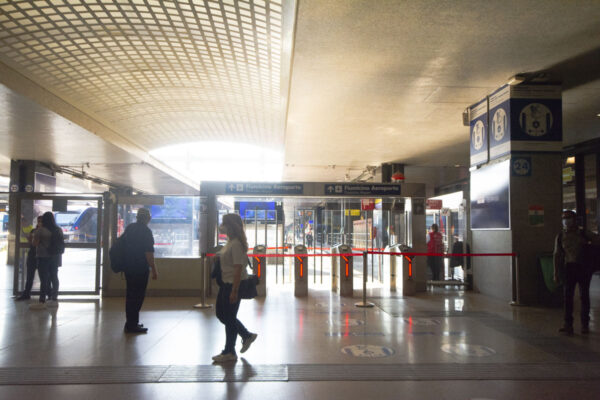
Traveling from Rome Termini to Fiumicino Airport – All You Need to Know
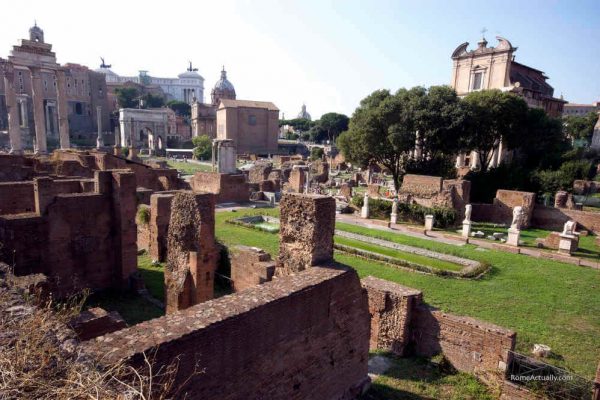
Birthday of Rome, All You Need to Know About the 21st of April in Rome (2024)
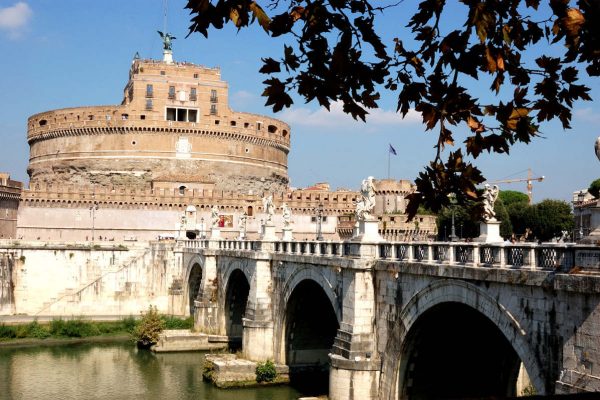
Rome in 2 Days: How to Make the Best of a Weekend in Rome
Leave a Comment Cancel reply
This site uses Akismet to reduce spam. Learn how your comment data is processed .
Privacy Overview
- 2024 TRAVEL UPDATE
- Work with us
- Beyond Bologna
- Regions of Italy
- Travel books
- Best group tours
- Itineraries
- Accommodation guide
- Italian phrases for travel
- Rocket Italian review: 2024 update
- Ultimate Italy Travel Planner
- City Planners
- Essential Guides
- Italy themed gift ideas
- Trip planning services
Rome travel guide
Introduction to rome travel.
The Eternal city is one of the greatest on earth. Founded more than 2,500 years ago, the city is one of the most important places on our planet. Home to the Roman Empire, Catholic church and Renaissance seat of power, it is no wonder all roads lead to Rome. In our opinion, all first journeys to Italy should include some time in Rome.Explore the highlights, majesty, chaos and vibrant street life of the city and stand in awe of this enduring metropolis. As you wander the streets, centuries old ruins of palaces and temples await you around every corner. Fountains bubble and cascade in splendour in the middle of cobbled piazzas. In the neighborhoods close by, the hustle and bustle of a modern city continues always acknowledging its historic and glorious past.
What to see in Rome
From ancient Roman sites crumbling but still magnificent, to glorious Renaissance masterpieces and tiny churches packed with art, you could easily fill a lifetime exploring Rome.
ST PETERS BASILICA
Vatican museums, roman forum, piazza navona, trevi fountain, spanish steps, untold rome.
Once you have seen the classic sights, it’s time to explore the lesser known secrets of Rome. Just beyond the major piazzas, small nooks and hidden treasures await. Read more about hidden secrets in Rome and visit the Borghese Gallery , one of the city’s gems.
Rome ACCOMMODATION guide
Choose the best area and hotel for your trip with our guide to the best accommodation and hotels in Rome. Whether you want to stay in the historic center, close to the Colosseum or soak up the atmosphere of beautiful Trastevere, there is a perfect hotel to suit your trip.
hotels near pantheon
Hotels near the vatican, hotels near the colosseum, hotels in trastevere, rome tours and tickets.
Information on skip the line tickets to the major attractions, the best tours of the city and unique activities that are sure to make your trip memorable.
colosseum tickets and tours
Vatican tickets and tours, best rome tickets and tours, rome food tours.
Looking for Rome airport arrivals information? Click here
Need itinerary ideas for Rome?
Read our 3 day itinerary or 5 day itinerary for Rome with ideas on how to see the Colosseum, Vatican, historic center and lesser known sites
DISCOVER: Get off the beaten path with Rome’s Hidden Gems
Want to visit pompeii from Rome?
Read our guide to visiting Pompeii on a day trip from Rome – includes best guided tours and DIY options
ROME PODCAST EPISODES
Episode #003: highlights of rome, episode #017: secrets of rome with erica firpo, episode #005: andiamo getting around with taxis in rome, more city guides.
- EXPLORE Random Article
How to Travel in Rome
Last Updated: December 14, 2021 References
This article was co-authored by wikiHow Staff . Our trained team of editors and researchers validate articles for accuracy and comprehensiveness. wikiHow's Content Management Team carefully monitors the work from our editorial staff to ensure that each article is backed by trusted research and meets our high quality standards. There are 7 references cited in this article, which can be found at the bottom of the page. This article has been viewed 2,799 times.
Traveling the sprawling streets of Rome may appear intimidating at first glance, but you'll soon find navigating Rome less complex than it first appears. The first thing you should know is that most public transit centers around Rome's Termini, the main rail station, and hub to the bus and subway system as well. You will need to get to Termini in order to access any of the other travel lines. Taxis are an efficient way to get around, but make sure you only accept rides from official blue and white taxis. You can also download a taxi app like MyTaxi, or download Scooterino and get picked up by a vespa driver for a truly Italian experience.
Travelling to or from the Airport

- The Leonardo Express runs directly from Leonardo Da Vinci airport at Fiumicino to Termini, so it really makes for an easy trip.
- The ride takes about 30 minutes, and the train departs from the station every half-hour on all 7 days of the week.
- The ticket will cost you about €14 and children under 12 are free with a paying adult.

- The FR-1 will stop at the Tiburtina, Tuscolana, and Ostiense stations. From those stations, you can get off and take the Metro to your destinations.
- The FR-1 runs about every 15 minutes, so you should be able to catch a ride fairly quickly.
- The ticket costs about €8.

- The trip itself will take about twice as long than if you rode the train, but at only €5, it's a hard price to beat.
- You can purchase your ticket directly on the bus.

- It's important that you take an official taxi that is run by the city to avoid being overcharged by scammers.
- Expect to pay a fixed rate of €48, which includes a ride and luggage transport for up to 4 people.

- Note that you cannot use a transportation ticket to ride the Leonardo Express back to the airport. If you want to ride it, you must purchase the ticket separately. [5] X Research source

- it Taxi and MyTaxi are popular taxi apps that work well in Rome.
- For a truly modern Italian experience, consider downloading Scooterino, the vespa app. It works exactly like a taxi app, except that the driver will pick you up on a vespa instead of a car.
Using Public Transit to Explore the City

- The BIT is the standard ticket (€1.50) , and it is valid for one Metro ride or 100 minutes on all buses, including transfers.
- The BIG ticket (€7) is good for unlimited metro, bus, and train travel within Rome for 24 hours after you validate it.
- The BTI, or tourist, ticket (€18) is good for unlimited metro, bus, and train travel within Rome for 72 hours after you validate it.
- The CIS ticket (€24) is good for unlimited metro, bus, and train travel within Rome for 7 days after you validate it.

- This doesn't mean the ticket can be used for either-or. It means that if you wanted, you could ride a bus to a stop, get off, get on the Metro, get off, then get on a tram.

- The ticket machine will stamp your ticket with the time you activated it and the time it expires, based on which option you purchased.
- Keep your ticket with you at all times in case you are asked to show it to the controller.

- Be especially careful during busy times when the transit is crowded.
Deciding Which Way to Travel

- 40: Termini - Piazza Venezia - Argentina - Piazza Pia (for St Peter's/Vatican)
- 64: Termini - Piazza Venezia - Argentina - Vatican
- 62: Repubblica - Spanish Steps - Piazza Venezia - Argentina - Vatican
- 81:Vatican Museums - Piazza Imperatore (Spanish Steps) - Piazza Colonna (Trevi Fountain) - Piazza Venezia - Circo Massimo - Colosseum
- 60: Termini - Piazza Venezia - Colosseum - Circo Massimo
- H:Termini - Piazza Venezia - Argentina - Trastevere
- Note that most routes run from 5:30am to midnight, with only the main routes running throughout the night.

- Ottaviano (line A) - Vatican Museums, St Peter's
- Spagna (line A) - Spanish Steps
- Colosseo (line B) - Colosseum, Roman Forum
- Single-use tickets are valid for 100 minutes after validation, and cost about €1.50 each.

- The tram routes are listed on the same map as the bus routes.

- Riding the taxi can also be a good idea if you are travelling at night after the public transit options have slowed.
- Pay attention to the meter while you are in the taxi to be sure you are being charged accurately and fairly.
Expert Q&A
You might also like.

- ↑ http://www.trenitalia.com/tcom-en/Services/Fiumicino-Airport
- ↑ https://www.italylogue.com/featured-articles/getting-from-rome-fiumicino-airport-to-rome.html
- ↑ https://www.rometoolkit.com/airport/fiumicino_airport_train.htm
- ↑ https://theculturetrip.com/europe/italy/articles/10-must-have-apps-for-living-in-rome/
- ↑ https://www.italylogue.com/planning-a-trip/rome-transportation-101.html
- ↑ https://www.rometoolkit.com/transport/rome_travel_pass.htm
- ↑ https://www.rometoolkit.com/transport/rome_bus.htm
About this article

Did this article help you?

- About wikiHow
- Terms of Use
- Privacy Policy
- Do Not Sell or Share My Info
- Not Selling Info
Nomadic Matt's Travel Site
Travel Better, Cheaper, Longer
Rome Travel Guide
Last Updated: September 13, 2023
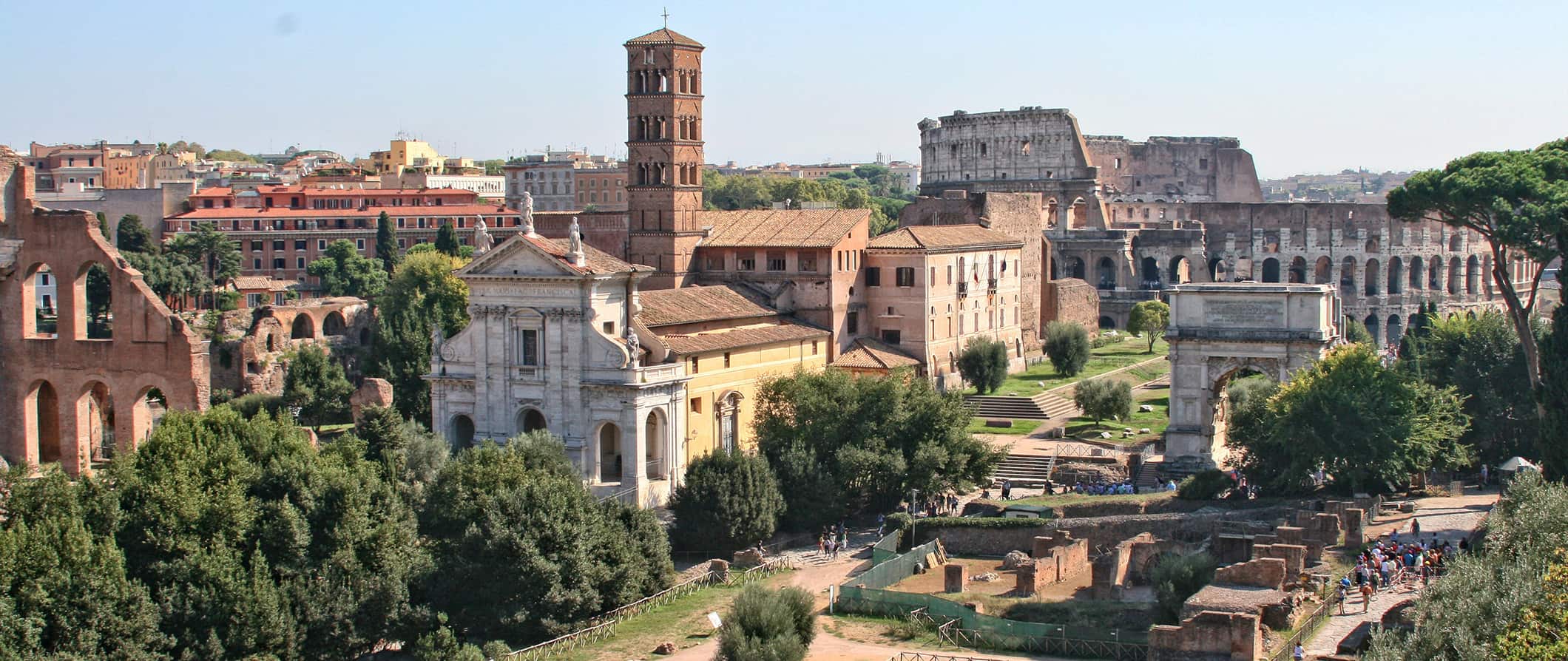
Considered the center of the western world for centuries, Rome is the birthplace of Caesar and home to the Catholic Church. It’s also bursting at the seams with ancient historic ruins and tons of delicious restaurants (I particularly love Trastevere for food), bars, and world-class shopping.
Here you walk down the street and see modern buildings next to ruins dating back thousands of years.
It’s a city filled with life, beauty, and charm that appeals to travelers of all stripes. Backpacking here is popular with budget travelers on Eurotrips, history buffs come to explore the ruins, couples visit Rome on honeymoons, and the jet-set splash out on the city’s upscale dining and nightlife.
No matter your interests, Rome has you covered.
This budget travel guide to Rome can help you plan your trip, navigate the endless amount of sites and attractions, learn how to get around in the chaos, and save money in one of the most expensive cities in Italy !
Table of Contents
- Things to See and Do
- Typical Costs
- Suggested Budget
- Money-Saving Tips
- Where to Stay
- How to Get Around
- How to Stay Safe
- Best Places to Book Your Trip
- Related Blogs on Rome
Top 5 Things to See and Do in Rome
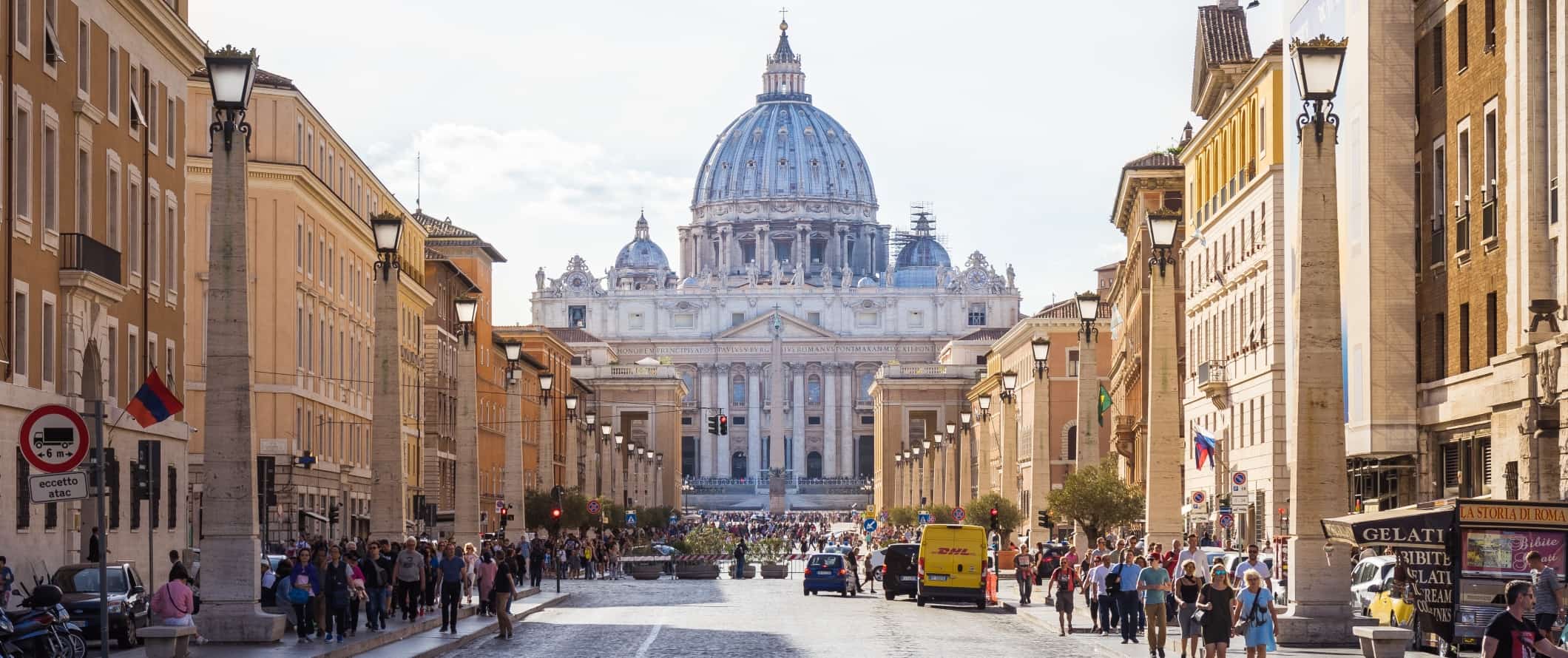
1. Explore the Colosseum
Even though the line of tourists can seem endless, the Colosseum is not to be missed. Built in the 1st century CE, it is nearly 2,000 years old and was the largest amphitheater in the entire Roman Empire (it could hold 50,000-80,000 people). During the Roman Empire, it was used for gladiatorial contests and other public events including animal hunts, dramatic plays, executions, and military re-enactments. From the Middle Ages onwards, it was repurposed into workshops, housing, and even a Christian shrine. Admission is 16 EUR for a ticket that offers 24-hour access to the Colosseum, Palatine Hill, and the Roman Forum (though not the Colosseum’s arena). A two-day ticket with access to all areas (including the arena) is 22 EUR.
For an in-depth tour with special access to the arena floor, book a tour with Walks of Italy . They run the best tours in the city and use expert local guides who ensure you have fun and learn a ton. I always take their tours when I’m in Rome.
2. See the Forum and Palatine Hill
The Roman Forum was the seat of Ancient Rome. It was the center of Roman public life and the place from which Rome administered its empire. Today, the forum is a two-hectare (five-acre) site filled with ruins of countless important buildings amongst which you can wander around. Next to the Forum is Palatine Hill, where the Roman aristocracy lived. Admission to both is 16 EUR or 22 EUR (depending on which combination ticket you purchase). It is also worth getting a guide to give you context and bring the ruins to life. You can book a tour with priority skip-the-line access for 64 EUR.
3. Tour Vatican City
Vatican City is an independent city-state surrounded by the city of Rome. It gained its full independence from Italy in 1929 and is the smallest city-state in the world. Don’t leave Rome without spending some time here to see the home of the Pope, St. Peter’s Basilica, the Sistine Chapel, and all of the wonderful museums. (Please dress modestly as the Basilica has a strict dress code). Tickets are 17 EUR while skip the line tickets cost around 27 EUR. Keep in mind that tickets sell out weeks in advance (especially in the high season, so you’ll want to plan this one in advance).
If you want a behind-the-scenes tour with VIP access, book the Key Master’s Tour of the Vatican . You’ll get to help unlock the chapel in the morning, giving you access to the Vatican before all the other tourists enter. It’s an amazing, unique opportunity with limited space so be sure to sign up in advance!
4. Admire the Trevi Fountain
The 18th-century Trevi Fountain was built at the ending point of the aqueduct that supplied ancient Rome with water from the surrounding countryside. Designed by Roman architect Nicola Salvi and composed largely of stone from a quarry just 35 kilometers (22 miles) from the city, the Baroque fountain is a true emblem of Rome and has been featured in numerous films. It is always crowded, especially at night when couples come for a romantic picture. The best time to see this beautiful fountain is before breakfast when the crowds are thin. Tradition says that if you throw a coin over your left shoulder into the fountain, you’ll find your way back to Rome. (The thousands of euros thrown into the fountain each day are donated to charity).
5. Eat your way around Trastevere
Other things to see and do in rome, 1. take a free walking tour.
Walking tours are a wonderful way to learn about a city. I recommend Rome’s Ultimate Free Walking Tour or New Rome Free Tours. Their tours cover all the highlights and can introduce you to the city on a budget. Just be sure to tip your guide at the end!
If you’re looking for a paid guided tour that goes above and beyond, check out Walks of Italy . They have expert guides and can get you behind the scenes at the city’s best attractions. They’re my go-to walking tour company!
2. See the churches
Rome has a ton of churches so don’t hesitate to wander into them as you pass by to take in the art, sculptures, decorations, and stained glass. The Basilica di Santa Maria Maggiore, dating back to 440 CE, is one of the most impressive. It’s covered in 5th-century mosaics which display 36 scenes from the Old Testament. Other noteworthy churches include the Santa Maria Sopra Minerva, one of the few Gothic churches in Rome and known for its deep blue vaulted ceiling; and San Giovanni in Laterano, the official cathedral of Rome which apparently is home to the heads of St. Peter and St. Paul.
3. Explore Ostia Antica
The ruins of the ancient Rome port of Ostia Antica are well worth a visit. About 2,000 years ago, this place was a bustling commercial center and home to 60,000 people. Now you can wander the ruins of the docks, apartments, mansions, baths, and warehouses. You should plan at least a half-day for this trip. Entry is 12 EUR. City Wonders runs half-day tours for around 58 EUR.
4. Tour the Pantheon
The Pantheon looks today much like it did nearly 2,000 years ago before it became a church (it was originally a Roman temple). Hadrian built it over Agrippa’s earlier temple, and it has been around since 125 CE. As soon as you walk through the heavy bronze doors and across the marble floors, you can look up and marvel at the largest unreinforced dome ever built. It’s by far one of the best-preserved buildings in the world, as its been in use continuously since its construction. Entry is free.
5. See the Spanish Steps
The Spanish Steps, built in the 1720s, are a long and grand staircase in Rome with the Piazza di Spagna at its base and Trinità dei Monti looming at the top. While the Spanish Steps were once a social hub on which you could hang out and people watch, sitting on the steps is no longer allowed. This is part of new preservation measures enacted in 2019, intended to ensure that the monument will be around for generations to come. While you can’t linger on the steps, visiting this iconic sight is a must, and you can still climb them to get to the top.
6. Check out the art museums
If you enjoy art museums, Rome will not disappoint. There are a ton of great ones here, several of which are some of the highest-ranking in the world. The Galleria Nazionale d’Arte Moderna is a good starting point as it is home to several Italian masterpieces. The Galleria Borghese is also excellent as it boasts a garden villa filled with Bernini sculptures and artwork from Caravaggio, Raphael, Titian, and other masters. Cardinal Scipione Borghese originally commissioned this collection. For something different, check out MAXXI, Rome’s first national museum devoted entirely to contemporary art.
7. Partake in La Settimana dei Beni Culturali
This is a 10-day event that occurs every May. During this cultural heritage week, all governmentally owned and operated landmarks, museums, and archeological sites offer free admission. There aren’t any other deals better than this! Be forewarned, these sites get really crowded so arrive early.
8. See a show
Aside from beautiful auditorium complexes, Rome often hosts world-class operas and concerts performed by international musicians. The Olympic Stadium is a hotspot for summer concerts and the Auditorium in Viale Pietro de Coubertin and at Parco della Musica holds events year-round. Ticket prices vary but expect to pay at least 25 EUR.
9. Visit Castel Sant’Angelo
This structure was built as a mausoleum for Emperor Hadrian at the end of the 1st-century. During the course of history, it has also served as a papal residence and a prison. As you may know from The Da Vinci Code , there’s a passageway here that runs into the Vatican. It was designed as an escape passage for the Pope in case of an emergency, and it was actually used in 1527 by Pope Clement VII. You can visit the castle and look around the exhibits; there are seven levels in total. The Terrace of the Angel has some amazing city views. Admission is 14 EUR while Get Your Guide offers reserved tickets for 23 EUR.
10. Explore the Catacombs
Rome has three major sets of catacombs that are open to the public – the Catacombs of Praetextatus, the Catacombs of San Sebastiano, and the Catacombs of San Callisto. Some of the underground crypts are adorned with sculptures and frescoes. San Callisto is the most popular, with a labyrinth of galleries extending about 19 kilometers (12 miles) long and 20 meters deep. Admission to each catacomb is 8 EUR.
11. Take a cooking class
If you’re a foodie, taking a cooking class in Rome is a must. I like Walks of Italy as they offer some my favorite cooking classes, including a pasta making class. Their classes are around 3 hours each and are super insightful. You’ll not only have fun but you’ll learn a lot too. Prices vary but expect to spend around 50-90 EUR. Eat and Walk Italy runs tours for around 60 EUR.
12. See the Roman Appian Way
This ancient road connects Rome all the way to Brindisi. It was finished in 312 BCE and it’s so well preserved you can see the ruts in the stones left by chariots. There are lots of interesting highlights along the way, including the Catacombs of San Callisto and a huge mausoleum for Cecilia Metell, a Roman noblewoman. A lot of people rent a bike to pedal the path, but I think walking is the best way to go. You’ll be following in the footsteps of the ancient Romans! If you’d prefer a tour, Walks of Italy runs an Ancient Rome walking tour that covers the Appian Way (as well as the Park of the Aqueducts below — and much more!).
13. Hang out in the Park of the Aqueducts
This large, green park is part of the Roman Appian Way and home to some of the ancient aqueducts that once carried millions of tons of water into the city from the mountains. Although the park is located on the outskirts of the city, it’s a really great place to go and just hang out with the locals. Pack a lunch and a bottle of wine, and enjoy a lazy afternoon in the shade of some 2,000-year-old monuments.
14. Visit Piazza Navona
This is one of the most beautiful public spaces in Rome. It’s home to Bernini’s Fontana dei Quattro Fiumi, with its stunning statues representing the great rivers of the world. The entire oval-shaped piazza is lined with restaurants, gelaterias, shops, and the Museo di Roma. Nearby, you’ll find Via della Pace, one of the city’s most photogenic streets. Pull up a chair at a sidewalk cafe and take it all in.
15. Wander around Centro Storico
Spending an afternoon getting lost in the maze of cobblestone streets in Centro Storico is one of the best free things you can do in Rome. Wind your way through the narrow alleyways and streets, admire the churches filled with Baroque art, pause for a coffee, and do some shopping at the many boutiques.
16. Climb Gianicolo
Gianicolo (or Janiculum) Hill offers the best views over Rome. It’s a famous spot for young lovers and tourists and from here you can see some of the city’s best attractions, including Palazzo Venezia and the Spanish Steps. It’s beautiful at dusk, but if you come in during the day, prepare for the cannon firing at noon (it has been happening daily since 1904).
17. Take a food tour
To learn more about the history and culture behind Rome’s cuisine, take a food tour. It’s the best way to eat your way around the city sampling the best eats Rome has to offer while learning what makes the cuisine unique. Devour Tours runs in-depth food tours led by expert local guides that will introduce you to the food culture and its history. If you’re a foodie like me who wants to learn more about the history and culture behind each dish, this tour is for you! Tours from 69 EUR.
For more information on other cities in Italy, check out these guides:
- Cinque Terre Travel Guide
- Florence Travel Guide
- Milan Travel Guide
- Naples Travel Guide
- Pisa Travel Guide
- Sorrento Travel Guide
- Venice Travel Guide
Rome Travel Costs

Hostel prices – For a bed in a dorm with 6-8 beds, expect to pay 33-49 EUR per night during peak season and 17-35 EUR off-peak. Private rooms go for 80-120 EUR per night during peak season and 55-75 EUR off-peak. Free Wi-Fi and self-catering facilities are standard and many hostels also include free breakfast.
Budget hotel prices – Two-star budget hotels start at 60-100 EUR per night. Prices are about 10-20 EUR cheaper per night in the off-season. Expect basic amenities like free Wi-Fi, TV, AC, and a coffee/tea maker. There are a number of bed and breakfasts that include breakfast in the room rate.
On Airbnb, you can find private rooms starting around 40-60 EUR per night and entire apartments for 80-125 EUR per night. Expect to pay double (or more) if you don’t book early.
Average cost of food – Italian cuisine is beloved around the world, though every region in Italy offers its own distinct flavor. Tomatoes, pasta, olives, and olive oil form the backbone of most meals, with meat and fish and various cheeses rounding out the menu. Gelato is a must also. You can find dishes from across the country in Rome, as well as tons of international fare; it’s the best foodie city in the country.
Most casual restaurant meals with wine cost around 15-20 EUR. In tourist hot spots, add another 10 EUR to that.
Quick eats like pizza, paninis, and sandwiches cost 4-8 EUR. Fast food (think McDonald’s) is around 8 EUR for a combo meal. Chinese takeout costs 5-10 EUR for a main dish.
If you want to splash out, a three-course meal at a mid-range restaurant starts at 30 EUR.
Beer costs around 4-5 EUR while a glass of wine costs 3-5 EUR. For non-alcoholic drinks, a latte/cappuccino is around 1.50 EUR and bottled water is less than 1 EUR.
Most restaurants will also add a 2.50-3 EUR coperta (cover charge) to your bill. No way to get around it.
If you plan on cooking your own food, expect to spend around 55-65 EUR per week on groceries. This gets you basic staples like rice, pasta, seasonal produce, and some meat.
Backpacking Rome Suggested Budgets
On a backpacker’s budget in Rome, you’ll spend about 60 EUR per day. This assumes you’re staying in a hostel, cooking all of your meals, limiting your drinking, taking public transportation to get around, and doing mostly free activities like free walking tours and visiting free sights like the Parthenon and Spanish Steps. If you plan on drinking, add another 10 EUR to your daily budget.
On a mid-range budget of 160 EUR per day, you can stay in a private Airbnb, eat out for most meals, enjoy a few drinks, take the occasional taxi to get around, and do more paid activities like touring the Colosseum and visiting the Vatican.
On a “luxury” budget of 275 EUR or more per day, you can stay in a hotel, eat out for all your meals, drink as much as you want, take more taxis, and do whatever tours and activities you want. This is just the ground floor for luxury though. The sky is the limit!
You can use the chart below to get some idea of how much you need to budget daily, depending on your travel style. Keep in mind these are daily averages – some days you’ll spend more, some days you’ll spend less (you might spend less every day). We just want to give you a general idea of how to make your budget. Prices are in EUR.
Rome Travel Guide: Money-Saving Tips
It’s easy to blow a lot of money in Rome as it’s one of the most expensive cities in Europe. Luckily, there are plenty of ways to cut your costs. Here are some of the best ways to save money in Rome:
- Stay outside the center – If you are open to staying on the outskirts of Rome, you can save a lot of money on accommodation. Food outside of the city is much cheaper as well, and it’s easy to take the train to Rome for your sightseeing.
- Eat cheap – When eating in Rome, opt for sandwich and pizza places as opposed to touristy restaurants. For really good, inexpensive food, visit Trastevere across the river.
- Cook your own meals – If you’re on a tight budget, skip eating out and cook your own meals. If you have access to a kitchen, you’ll be able to save a fortune.
- Get a tourist card – If you are going to see a lot of museums, consider buying one of Rome’s many budget cards such as the Roma Pass, the Omnia Card (for Rome and the Vatican), or the Colosseum Full Experience ticket (which grants access not only to the Colosseum but several other iconic sites). You pay one flat fee for all the attractions and can save a good amount of money in the process.
- Pass on the bread – Some restaurants charge you extra for bread they leave on the table — but they won’t tell you about it until the bill arrives. Send it back if you don’t want to be tempted.
- Drink the tap water – When eating out, ask for tap water or you will automatically get expensive bottled water included on your bill.
- Buy your wine at supermarkets – You can buy a great bottle of wine for 6-10 EUR at the store. It’s much cheaper than the bar.
- Stay with a local – Use Couchsurfing to stay with locals who have extra beds or couches for free. It’s the best way to save money while connecting with a local who can share their insider tips and advice.
- Go on a free walking tour – This is a great way to learn the history behind the places you are seeing and get your bearings. Rome Free Walking Tour has a few tours that can show you what the city has to offer. Just don’t forget to tip your guide!
- Get a transportation pass – A 24-hour transportation pass for the metro, bus, and trams is just 7 EUR. It’s the best way to get around the city on a budget.
- Take advantage of free museums – On the first Sunday of the month, dozens of museums and galleries around the city have free entry, including the Colosseum, the Borghese, and the modern art museum (among many others). And on the last Sunday of the month, the Vatican Museums are free. Just expect crowds!
- Bring a water bottle – The tap water here is safe to drink so bring a reusable water bottle to save money and reduce your plastic use. LifeStraw is my go-to brand as their bottles have built-in filters to ensure your water is always clean and safe. You’ll find clean drinking fountains all over the city.
Where to Stay in Rome
Rome has tons of fun, affordable, and social hostels. My recommended places are:
- YellowSquare
- The Beehive
- Palladini Hostel
- Alessandro Palace Hostel and Bar
For more hostel suggestions, check out my list of the best hostels in Rome .
How to Get Around Rome

Public transportation – Rome has an extensive public transportation network consisting of buses, a subway (metro), trams, and trolleys.
The metro is the fastest way to get around the city. There are three lines and a single journey ticket that’s valid for 100 minutes is 1.50 EUR. You can pick up tickets from local tobacco shops, newsstands, and vending machines at the stations. You can also use contactless payment methods on the metro.
The bus can get you into the areas not covered by the metro system, but it’s a lot slower than the subway due to constant traffic jams. Tickets are 1.50 EUR.
You can purchase a one-day pass for unlimited travel for 7 EUR. A one-week pass costs 24 EUR.
If you’re going to be using the public transportation system a lot, the Roma Pass is your best bet as it includes free access to some museums, discounts on others, and unlimited public transportation. It’s 32 EUR for 48 hours and 53 EUR for 72 hours.
Taxis – Taxis are very expensive here so I don’t recommend taking them. The meter starts at 4 EUR and then goes up 1.20 EUR per kilometer. Avoid them at all costs!
Ridesharing – Uber is available in Rome and their prices are usually cheaper than taxis. That said, they’re still not super cheap so skip Uber too!
Bike rental – Bicycling around Rome may seem a little scary with the high volume of traffic (and the hills), but there are bike lanes around the city center that make it possible. Bike rentals start at 14-20 EUR per day.
When to Go to Rome
Peak season is during the summer, from June through August. You’ll be constantly competing for views at Rome’s main tourist attractions, but the weather is also fantastic during these months (although sometimes it’s unbearably hot and humid). Temperatures during this season average around 27°C (81°F), but in August, temperatures soar above 32°C (89°F) per day.
If visiting in the summer, wake up early to beat the heat and the crowds.
Personally, I recommend visiting during the shoulder season, which is from April-May and late September-October. It’s slightly less chaotic than the summer months, and the temperature is pleasant, hovering around 18°C (64°F). That said, post-COVID, tourism has grown so much that even those times of the year can still be pretty crowded.
Winter is from November to March. This is the off-season in Rome but the city is never quiet. Although there are fewer travelers around, you can still expect a bustle of activity everywhere you go. Temperatures during this time range from 4-15°C (39-59°F).
How to Stay Safe in Rome
Rome is a very safe place to backpack and travel — even if you’re traveling solo and even if you’re a solo female traveler. However, petty theft can be a problem here so keep your valuables secure and out of sight. Pickpockets are very active around Rome’s main attractions such as the Colosseum and St. Peter’s Square so stay vigilant.
It’s also not uncommon to get ripped off in this city. You should never buy tickets from unofficial ticket offices. If you are approached by someone selling skip-the-line tickets, ignore them. Also, always make sure your taxi driver is using the meter.
If you’re worried about getting scammed, you can read about common travel scams to avoid here.
Solo female travelers should generally feel safe here, however, the standard precautions apply (never leave your drink unattended at the bar, never walk home alone intoxicated, etc.).
If you experience an emergency, dial 113 for assistance.
Always trust your gut instinct. Make copies of your personal documents, including your passport and ID. Forward your itinerary along to loved ones so they’ll know where you are.
The most important piece of advice I can offer is to purchase good travel insurance. Travel insurance will protect you against illness, injury, theft, and cancellations. It’s comprehensive protection in case anything goes wrong. I never go on a trip without it as I’ve had to use it many times in the past. You can use the widget below to find the policy right for you:
Rome Travel Guide: The Best Booking Resources
These are my favorite companies to use when I travel. They consistently have the best deals, offer world-class customer service and great value, and overall, are better than their competitors. They are the companies I use the most and are always the starting point in my search for travel deals.
- Skyscanner – Skyscanner is my favorite flight search engine. They search small websites and budget airlines that larger search sites tend to miss. They are hands down the number one place to start.
- Hostelworld – This is the best hostel accommodation site out there with the largest inventory, best search interface, and widest availability.
- Booking.com – The best all around booking site that constantly provides the cheapest and lowest rates. They have the widest selection of budget accommodation. In all my tests, they’ve always had the cheapest rates out of all the booking websites.
- HostelPass – This new card gives you up to 20% off hostels throughout Europe. It’s a great way to save money. They’re constantly adding new hostels too. I’ve always wanted something like this and glad it finallt exists.
- Get Your Guide – Get Your Guide is a huge online marketplace for tours and excursions. They have tons of tour options available in cities all around the world, including everything from cooking classes, walking tours, street art lessons, and more!
- The Man in Seat 61 – This website is the ultimate guide to train travel anywhere in the world. They have the most comprehensive information on routes, times, prices, and train conditions. If you are planning a long train journey or some epic train trip, consult this site.
- Rome2Rio – This website allows you to see how to get from point A to point B the best and cheapest way possible. It will give you all the bus, train, plane, or boat routes that can get you there as well as how much they cost.
- FlixBus – Flixbus has routes between 20 European countries with prices starting as low 5 EUR! Their buses include WiFi, electrical outlets, a free checked bag.
- SafetyWing – Safety Wing offers convenient and affordable plans tailored to digital nomads and long-term travelers. They have cheap monthly plans, great customer service, and an easy-to-use claims process that makes it perfect for those on the road.
- LifeStraw – My go-to company for reusable water bottles with built-in filters so you can ensure your drinking water is always clean and safe.
- Unbound Merino – They make lightweight, durable, easy-to-clean travel clothing.
- Top Travel Credit Cards – Points are the best way to cut down travel expenses. Here’s my favorite point earning credit cards so you can get free travel!
- Walks of Italy – This walking tour company provides inside access to attractions and places you can’t get elsewhere. Their guides rock and they have some of the best and most insightful tours in all of Italy.
- BlaBlaCar – BlaBlaCar is a ridesharing website that lets you share rides with vetted local drivers by pitching in for gas. You simply request a seat, they approve, and off you go! It’s a cheaper and more interesting way to travel than by bus or train!
Rome Travel Guide: Related Articles
Want more info? Check out all the articles I’ve written on backpacking/traveling Italy and continue planning your trip:

The 6 Best Hotels in Florence
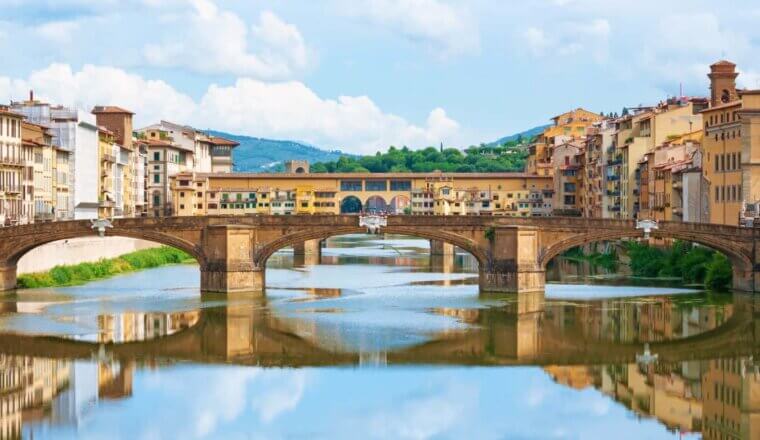
Where to Stay in Florence: The Best Neighborhoods For Your Visit
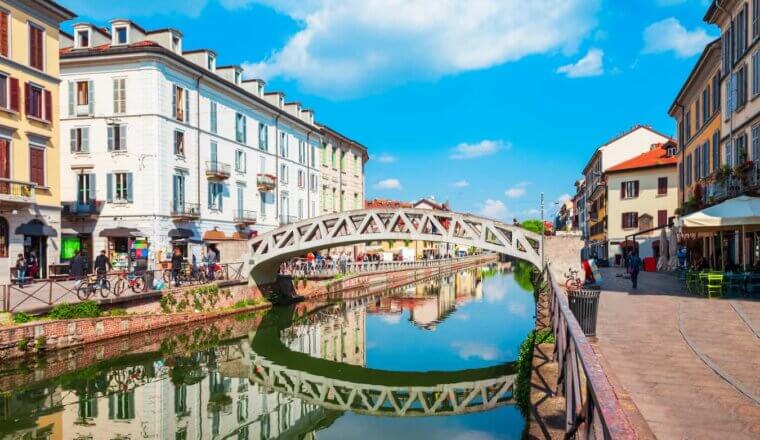
Where to Stay in Milan: The Best Neighborhoods for Your Visit
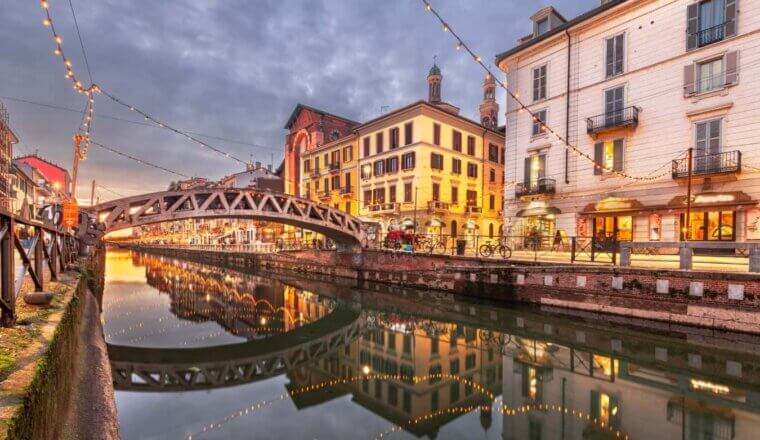
The 6 Best Hotels in Milan
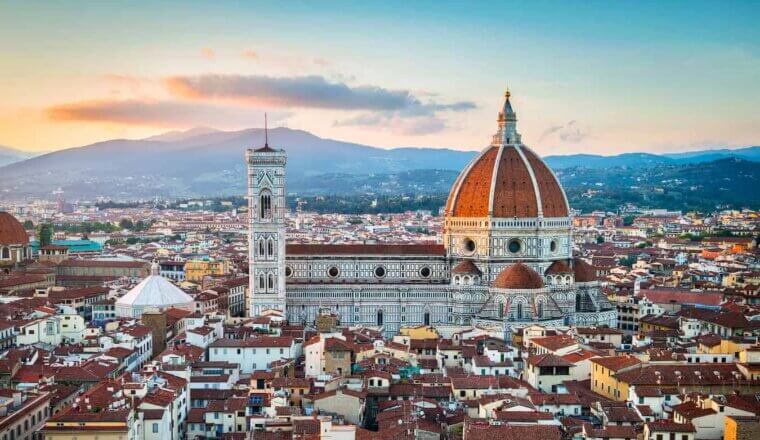
The Best Walking Tours in Florence
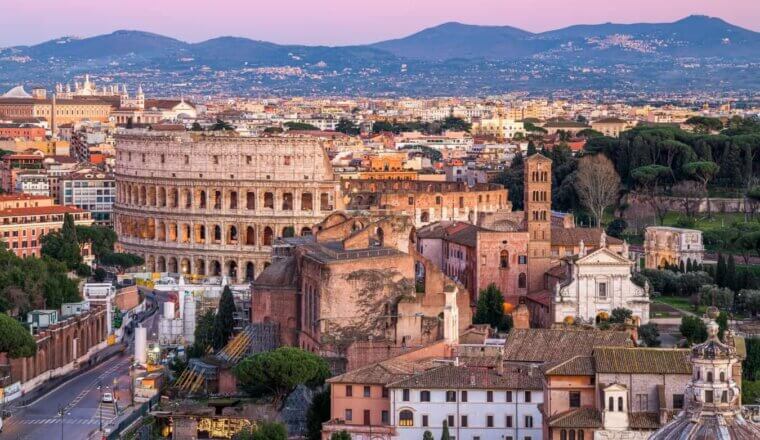
The 8 Best Hotels in Rome
Get my best stuff sent straight to you, pin it on pinterest.
- Where To Stay
- Transportation
- Booking Resources
- Related Blogs

- Destinations
Rome Travel Guide
Michelangelo masterpieces and centuries-old villas, palaces and temples framed with the vines of bygone times. With its mix of modern and ancient architecture, beautifully curated exhibitions, and the best wine bars, Rome will never give you the same experience twice. Between Vatican City, the Trevi Fountain, and the Pantheon, you may begin to wonder how many feats of architectural genius can be squeezed into one city. — Nicola Ferlei Brown
- Terms of Use
- Privacy Policy
- Your US State Privacy Rights
- Children's Online Privacy Policy
- Interest-Based Ads
- About Nielsen Measurement
- Do Not Sell or Share My Personal Information
- Nat Geo Home
- Attend a Live Event
- Book a Trip
- Inspire Your Kids
- Shop Nat Geo
- Visit the D.C. Museum
- Learn About Our Impact
- Support Our Mission
- Advertise With Us
- Customer Service
- Renew Subscription
- Manage Your Subscription
- Work at Nat Geo
- Sign Up for Our Newsletters
- Contribute to Protect the Planet
Copyright © 1996-2015 National Geographic Society Copyright © 2015-2024 National Geographic Partners, LLC. All rights reserved
Rome Travel Guide

Courtesy of joe daniel price | Getty Images

Why Go To Rome
Rome, the city of seven hills, enjoyed a mythic beginning. Romulus and Remus – twin brothers who were nursed by a she-wolf and fathered by a war god – reportedly founded the Eternal City. And although historians are a little skeptical about this epic entry into the world, most travelers are absolutely certain that there is something magical about Rome. Whether it's the mystery of nearby Vatican City or the ghosts of the Colosseum , an afternoon caffè on Piazza Navona or a piled-high plate of pasta at a trattoria, Rome is sure to enchant.
Italy's capital city, Rome is also known for a history that dates back to the eras of Octavian, Julius Caesar and Hadrian, among others. Left behind are structures like the Pantheon , the Roman Forum and dozens of churches, among other historic gems. Art enthusiasts will relish the trove of art housed at the Vatican Museums , and foodies will enjoy the splendid Italian fare, not to mention the gelato. And though its momentous past is the focus for many vacationers, Rome is also a fast-paced, modern and relevant city, with gleaming designer storefronts, sleek hotels and cutting-edge restaurants.
Find Flight and Hotel Deals
Navigate forward to interact with the calendar and select a date. Press the question mark key to get the keyboard shortcuts for changing dates.
Navigate backward to interact with the calendar and select a date. Press the question mark key to get the keyboard shortcuts for changing dates.
- # 1 in Best Places to Visit in Italy
- # 1 in Best Winter Vacations in Europe
- # 1 in Best Day Trips from Florence
See All 13 Rankings
Best of Rome
Best hotels in rome.
- # 1 in Hotel Hassler
- # 2 in Hotel de Russie, a Rocco Forte Hotel
- # 3 in Hotel Eden

Best Things to Do in Rome
- # 1 in Colosseum (Colosseo)
- # 2 in Vatican Museums and Sistine Chapel
- # 3 in St. Peter's Basilica (Basilica di San Pietro)
Popular Tours

Skip-the-Line Group Tour of the Vatican, Sistine Chapel & St. Peter's Basilica
(6325 reviews)
from $ 53.75

Vatican Museums, Sistine Chapel & St Peter’s Basilica Guided Tour
(32140 reviews)
from $ 86.65

Rome: Colosseum VIP Access with Arena and Ancient Rome Tour
(3438 reviews)
from $ 54.73
Rome Travel Tips
Best months to visit.
The best time to visit Rome is from October to April when most of the tourist crowds have dissipated and room rates are lower. Although you'll need a warm coat, weather this time of year hardly ever dips below freezing. For warmer weather – without throngs of tourists and the sweltering humidity – come in May or September. High average temperatures flit between the mid-70s and the lower 80s.
Weather in Rome
Data sourced from the National Climatic Data Center
What You Need to Know
Il conto, per favore If you need the bill at a restaurant, be persistent yet pleasant in asking. Life moves slower in Rome, so asking for your check once doesn't necessarily mean it's on the way.
Ditch the diet This is Rome, home of fettuccine, ravioli, bruschetta, cappuccino … enough said.
Speak Italiano When in Rome, do as the Romans do and at least try to speak a little Italian. "Hello" is ciao , "please" is per favore and "thank you" is grazie .
Take a tour Overwhelmed by the amount of things to see and do in Italy's capital? Consider taking a guided tour for a crash course in Roman life and culture.
How to Save Money in Rome
Buy the Roma Pass This money-saving pass gives you free or reduced admission to museums, discounts on certain exhibits, and free travel on public transportation for up to three days.
Church hop Many of Rome's little churches hold beautiful treasures – and many are free to visit.
Visit on Sunday The Vatican Museums are free to visit the last Sunday of the month, while state-run sights, such as Musei Capitolini and the Colosseum , offer free entry the first Sunday of the month.
Culture & Customs
Trying to look like a resident isn't difficult, especially if your own wardrobe is filled with high-end designer labels. Men wear immaculately cut suits. On the streets, snug jeans and fitted shirts are the norm for both men and women.
Rome's official currency is the euro. Since the euro to U.S. dollar exchange rate fluctuates, be sure to check what the current exchange rate is before you go. Major credit cards are accepted at most restaurants and shops.
The official language in Rome is Italian, and while it's advisable to learn a few phrases – ciao for hello; addio for goodbye; per favore for please, among others – most tourist-facing institutions, whether hotels or attractions , will have people that can communicate in English.
What to Eat
Rome is overflowing with restaurants, from trattorias that cook up family recipes spanning generations to fusion restaurants that plate up the latest culinary trend. Don't miss out on Roman specialties – such as artichokes, which are so beloved they have a protected status from the European Union. Try them at Rome's Nonna Betta . Cacio e Pepe is a simple pasta dish flavored with Pecorino Romano cheese and black pepper, and it originated in Rome. If you add smoked pork jowl and egg, you get another Roman pasta dish, carbonara.
Although the Lazio province – the region in which Rome sits – doesn't produce the world-renowned wines of other parts of the country, Rome nonetheless overflows with wine. Try a glass or two at popular wine bars, such as Enoteca il Goccetto, Cul De Sac or Trimani Enoteca – or with your meal at just about any of Roma's restaurants.
Coffee is an art in Rome, and to enjoy one of the best espresso drinks, try out the Caffe Sant'Eustachio , established in 1938, or the Antigua Tazza d'Oro near the Pantheon.
If you're looking to dine at Michelin-rated establishments, you'll have quite a few options. La Pergola , housed inside the luxe Rome Cavalieri Hotel, has three stars, while Il Pagliaccio, which serves up a modern twist on traditional Italian dishes, has two stars.
For a more rustic, homestyle (not to mention cheaper) dining experience, visitors might want to try out Casa Manco for pizza and Pane e Salame for sandwiches, among several thousand other establishments. If you have limited time in Rome and are interested in a culinary crash course, consider signing up for a food tour . Most tours last several hours and include tastings at a variety of local shops and restaurants. Popular operators include, Cook With Us in Rome , Eating Italy Food Tours and LivItaly Tours .
As always, visitors should use common sense when traveling and watch out for pickpockets on public transportation or in and around heavily touristed attractions. Due to an increased number of terrorist attacks in Europe in recent years, the U.S. State Department advises travelers to be on alert in tourist locations, transit hubs and markets.
Getting Around Rome
The best way to get around Rome is on foot. And because many of the best attractions are clustered together in traffic-free zones, walking makes the most sense. However, some places, like Vatican City, are pretty far from the central historic district, necessitating the use of the metro or a taxi. A nonstop express train (the Leonardo Express) can take you from the Leonardo da Vinci-Fiumicino Airport (FCO) to the Rome Termini railway station in a little more than 30 minutes; one-way tickets cost 14 euros (about $17). Buses are also available, but these aren't recommended because of crowded conditions aboard and heavy traffic outside. If you must bring a car to Rome, you should park it as soon as possible once you enter the city limits. Otherwise, you'll find heavy traffic, impatient drivers and pedestrian-only areas make driving around virtually impossible.
Entry & Exit Requirements
A passport with at least six months of remaining validity is required for United States citizens traveling outside the mainland by air or sea, as well as for U.S. citizens trying to re-enter the country. U.S. citizens do not need a visa unless they plan on staying longer than 90 days. Visit the U.S. State Department's website for the latest information on foreign exit and entry requirements.
Seek out vantage points for enchanting panoramic views of the Eternal City.
Explore More of Rome

Things To Do
Best hotels.

You might also like

# 2 in Best Honeymoons in Europe for 2024

Tuscany, Italy
# 1 in Best Wine Vacations

Amalfi Coast
# 1 in Best Honeymoons in Europe for 2024
If you make a purchase from our site, we may earn a commission. This does not affect the quality or independence of our editorial content.
Recommended
The 18 Best Napa Valley Wineries to Visit in 2024
Lyn Mettler|Sharael Kolberg April 23, 2024

The 25 Best Beaches on the East Coast for 2024
Timothy J. Forster|Sharael Kolberg April 19, 2024

The 50 Best Hotels in the USA 2024
Christina Maggitas February 6, 2024

The 32 Most Famous Landmarks in the World
Gwen Pratesi|Timothy J. Forster February 1, 2024

9 Top All-Inclusive Resorts in Florida for 2024
Gwen Pratesi|Amanda Norcross January 5, 2024

24 Top All-Inclusive Resorts in the U.S. for 2024
Erin Evans January 4, 2024

26 Top Adults-Only All-Inclusive Resorts for 2024
Zach Watson December 28, 2023

Solo Vacations: The 36 Best Places to Travel Alone in 2024
Lyn Mettler|Erin Vasta December 22, 2023

26 Cheap Beach Vacations for Travelers on a Budget
Kyle McCarthy|Sharael Kolberg December 4, 2023

The 50 Most Beautiful White Sand Beaches in the World
Holly Johnson December 1, 2023


IMAGES
VIDEO
COMMENTS
Rome is a huge city with several district articles containing sightseeing, restaurant, nightlife and accommodation listings — have a look at each of them.. Rome (Italian: Roma), the Eternal City, is the capital and largest city of Italy and of the Lazio region. It is famous for being the home of the ancient Roman Empire, the Seven Hills, La Dolce Vita (the sweet life), the Vatican City and ...
The Colosseum. Rome (Italian and Latin: Roma), the 'Eternal City', is the capital and largest city of Italy and of the Lazio region. It's the famed city of the Roman Empire, the Seven Hills, La Dolce Vita, the Vatican City and Three Coins in the Fountain.Rome, as a millennia-long centre of power, culture and religion, was the centre of one of the greatest civilisations ever, and has exerted a ...
The Colosseo district is the heart of ancient Rome. It has the Colosseum, the Forum, and the Capitoline Museum. ==Get in== Via dei Fori Imperiali cuts through the centre of the Rome/Colosseo district, connecting Piazza Venezia with the Colosseum. It is well served by buses, although if you are into serious sightseeing you are likely to want to walk instead as the Roman Forum is on your right ...
Address: Via dei Gigli d'Oro, 12, 00186 Roma RM, Italy. Phone: +39 06 6880 3579. Book Now. One of the mini hotels that Rome does so well, this former family home now holds six rooms that bring a ...
Rome. Lazio, Italy, Europe. A heady mix of haunting ruins, awe-inspiring art and vibrant street life, Italy's hot-blooded capital is one of the world's most romantic and charismatic cities. Best Time to Visit. Best Things to Do.
Why visit Rome? With its unparalleled history, Rome is the third most visited city in Europe and the fourteenth worldwide.It attracts visitors from all over the world who are impatient to discover the city's impressive monuments and archaeological sites; not to mention its renowned cuisine and its lively atmosphere.. When exploring the Colosseum, visitors will easily imagine how the ...
Rome is magnificent and overwhelming at the same time. It's a showcase of Western civilization, with astonishingly ancient sights and a modern vibrancy. As you peel through its fascinating and jumbled layers, you'll find the marble ruins of ancient times, tangled streets of the medieval world, early Christian churches, grand Renaissance buildings and statues, Baroque fountains and facades ...
This site is owned by Apa Digital AG, Bahnhofplatz 6, 8854 Siebnen, Switzerland. Rough Guides® is a trademark owned by Apa Group with its headquarters at 7 Bell Yard London WC2A 2JR, United Kingdom. Plan your visit to Rome with essential tips from Rough Guides editors. Read about itineraries, activities & places to stay in the best guide to Rome.
September's still warm, around 26.7°C. Come November, we're down to 15.9°C. Rain picks up, especially in November. ⛅ Winter's mild for Rome. December ranges from 12.7°C to 4.2°C. January's the coldest - highs of 11.9°C, lows at 3.1°C. December's pretty wet.
In fact, many of the best restaurants won't open until at least 7:30 p.m. Lunch: 12:30 pm - 2:30 pm. Dinner: 7:30 pm - 11 pm. To avoid eating in an empty restaurant and to really make the most of your evenings in Rome, try and fit in with them and eat a bit later. Around 8 pm is a good time to sit down.
Wander the cobblestone street with gelato in hand, spend some time people watching from the Spanish Steps, spend hours in the museums, and take in all of the stunning architecture the city has to offer. Rome is also a foodie's heaven, from the world-class cuisine to casual trattorias and takeaway pizzas. Here's my ultimate Rome travel guide!
Day 4. Side-trip to Ostia Antica (closed Mon). On the way there or back, stop for sightseeing in Testaccio (great market scene in the morning and for lunch; excellent restaurants for dinner). In the evening, you could repeat my guidebooks' "Heart of Rome" walk from Campo de' Fiori to the Spanish Steps to enjoy the after-dark scene.
8. Take your bus ticket straight to the beach. Speaking of public transportation, your €1.50 ticket is also valid on the local commuter trains in Rome, including a line that goes straight to the ...
Trevi Fountain. The Trevi Fountain is possibly one of the most famous fountains in the world. It is Rome's largest Baroque fountain, and legend has it that you throw 1 coin into the fountain to ensure another trip to Rome, 2 coins for love, and 3 coins for wedding bells.
All you need to know before visiting Rome: The ultimate Rome travel guide Where is Rome? The capital of Italy since 1870, after the unification, and of the Latium region, Rome lies in the center of the country on the western coast of the "boot" lapped by the Tyrrhenian Sea. It takes an hour and a half to reach Florence by high-speed train, an hour and 15 minutes to reach Naples, three ...
Founded more than 2,500 years ago, the city is one of the most important places on our planet. Home to the Roman Empire, Catholic church and Renaissance seat of power, it is no wonder all roads lead to Rome. In our opinion, all first journeys to Italy should include some time in Rome.Explore the highlights, majesty, chaos and vibrant street ...
A comprehensive travel guide and a collection of tips for visiting Rome from the experts at Condé Nast Traveler.
The BTI, or tourist, ticket (€18) is good for unlimited metro, bus, and train travel within Rome for 72 hours after you validate it. The CIS ticket (€24) is good for unlimited metro, bus, and train travel within Rome for 7 days after you validate it. 2. Use your transportation ticket to ride the bus, tram, or Metro.
Rome Travel Costs. Hostel prices - For a bed in a dorm with 6-8 beds, expect to pay 33-49 EUR per night during peak season and 17-35 EUR off-peak. Private rooms go for 80-120 EUR per night during peak season and 55-75 EUR off-peak.
Rome Travel Guide. Photograph by Dave Yoder, Nat Geo Image Collection. Why It's Worth It. Michelangelo masterpieces and centuries-old villas, palaces and temples framed with the vines of bygone ...
Rome, the city of seven hills, enjoyed a mythic beginning. Romulus and Remus - twin brothers who were nursed by a she-wolf and fathered by a war god - reportedly founded the Eternal City. And ...
Tourism in ancient Rome was limited to the Roman upper class due to its expense and long travel times. Travel was made increasingly difficult due to shipwrecks, storms, poor maps, and a lack of modern transportation methods.Common destinations for ancient Roman tourists were Greece, Egypt, and the coast of Campania.Roman tourists sought out sites in Greece of cultural and historical importance ...